Home Blog Business Conference Presentation Slides: A Guide for Success

Conference Presentation Slides: A Guide for Success
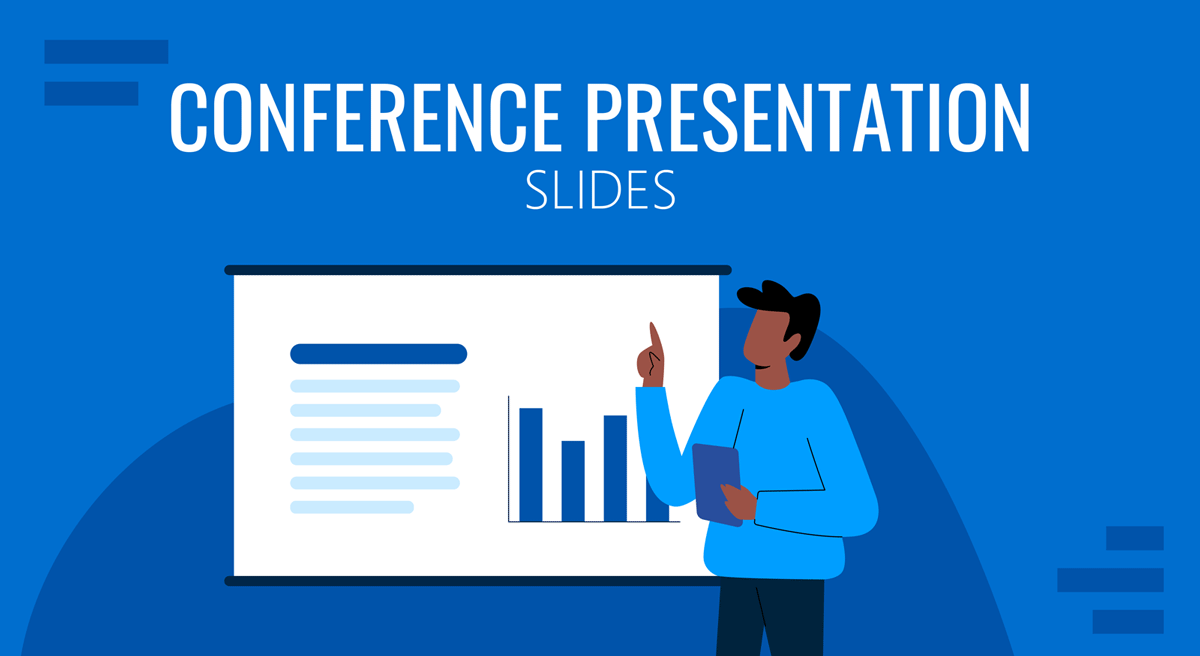
In our experience, a common error when preparing a conference presentation is using designs that heavily rely on bullet points and massive chunks of text. A potential reason behind this slide design mistake is aiming to include as much information as possible in just one slide. In the end, slides become a sort of teleprompter for the speaker, and the audience recalls boredom instead of an informative experience.
As part of our mission to help presenters deliver their message effectively, we have summarized what makes a good conference presentation slide, as well as tips on how to design a successful conference slide.
Table of Contents
What is a conference presentation
Common mistakes presenters make when creating conference presentation slides, how can a well-crafted conference presentation help your professional life, how to start a conference presentation, how to end a conference presentation, tailoring your message to different audiences, visualizing data effectively, engaging with your audience, designing for impact, mastering slide transitions and animation, handling time constraints, incorporating multimedia elements, post-presentation engagement, crisis management during presentations, sustainability and green presentations, measuring presentation success, 13 tips to create stellar conference presentations, final thoughts.
The Britannica Dictionary defines conferences as
A formal meeting in which many people gather in order to talk about ideas or problems related to a particular topic (such as medicine or business), usually for several days.
We can then define conference presentations as the combination of a speaker, a slide deck , and the required hardware to introduce an idea or topic in a conference setting. Some characteristics differentiate conference presentations from other formats.
Time-restricted
Conference presentations are bounded by a 15-30 minute time limit, which the event’s moderators establish. These restrictions are applied to allow a crowded agenda to be met on time, and it is common to count with over 10 speakers on the same day.
To that time limit, we have to add the time required for switching between speakers, which implies loading a new slide deck to the streaming platform, microphone testing, lighting effects, etc. Say it is around 10-15 minutes extra, so depending on the number of speakers per day during the event, the time available to deliver a presentation, plus the questions & answers time.
Delivery format
Conferences can be delivered in live event format or via webinars. Since this article is mainly intended to live event conferences, we will only mention that the requirements for webinars are as follows:
- Voice-over or, best, speaker layover the presentation slides so the speaker interacts with the audience.
- Quality graphics.
- Not abusing the amount of information to introduce per slide.
On the other hand, live event conferences will differ depending on the category under which they fall. Academic conferences have a structure in which there’s a previous poster session; then speakers start delivering their talks, then after 4-5 speakers, we have a coffee break. Those pauses help the AV crew to check the equipment, and they also become an opportunity for researchers to expand their network contacts.
Business conferences are usually more dynamic. Some presenters opt not to use slide decks, giving a powerful speech instead, as they feel much more comfortable that way. Other speakers at business conferences adopt videos to summarize their ideas and then proceed to speak.
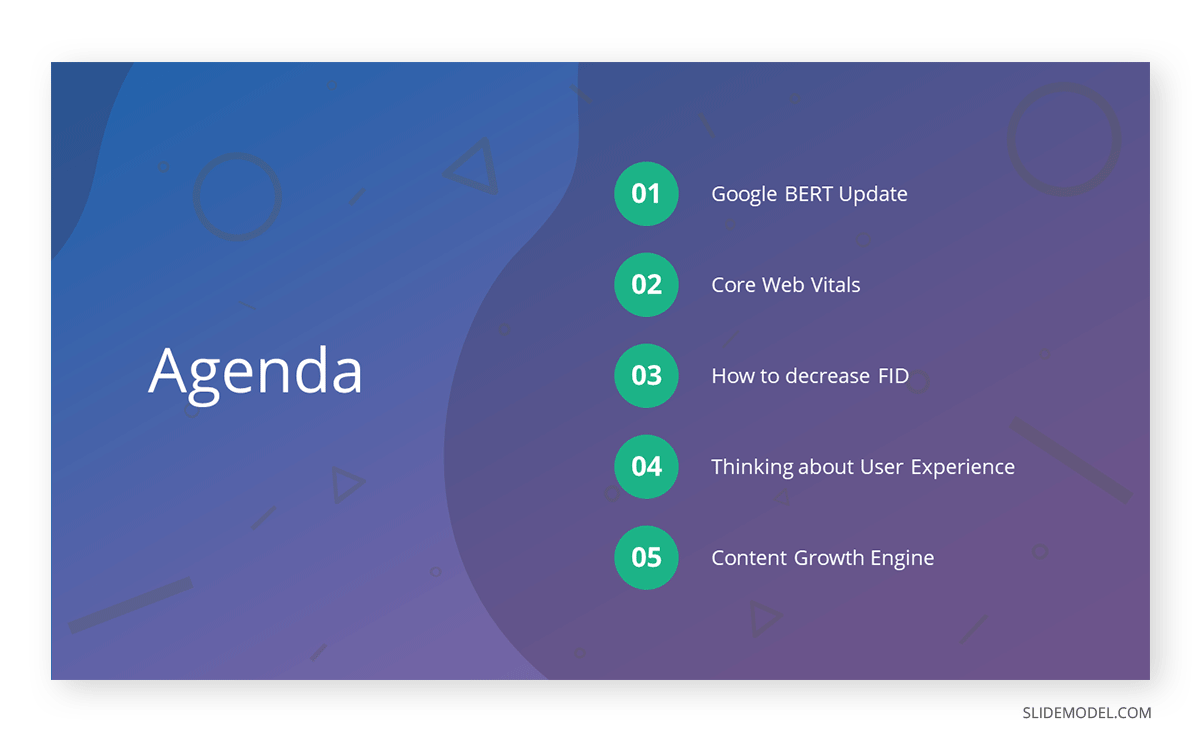
Overall, the format guidelines are sent to speakers before the event. Adapt your presentation style to meet the requirements of moderators so you can maximize the effect of your message.
The audience
Unlike other presentation settings, conferences gather a knowledgeable audience on the discussed topics. It is imperative to consider this, as tone, delivery format, information to include, and more depend on this sole factor. Moreover, the audience will participate in your presentation at the last minute, as it is a common practice to hold a Q&A session.
Mistake #1 – Massive chunks of text
Do you intend your audience to read your slides instead of being seduced by your presentation? Presenters often add large amounts of text to each slide since they need help deciding which data to exclude. Another excuse for this practice is so the audience remembers the content exposed.
Research indicates images are much better retained than words, a phenomenon known as the Picture Superiority Effect ; therefore, opt to avoid this tendency and work into creating compelling graphics.
Mistake #2 – Not creating contrast between data and graphics
Have you tried to read a slide from 4 rows behind the presenter and not get a single number? This can happen if the presenter is not careful to work with the appropriate contrast between the color of the typeface and the background. Particularly if serif fonts are used.
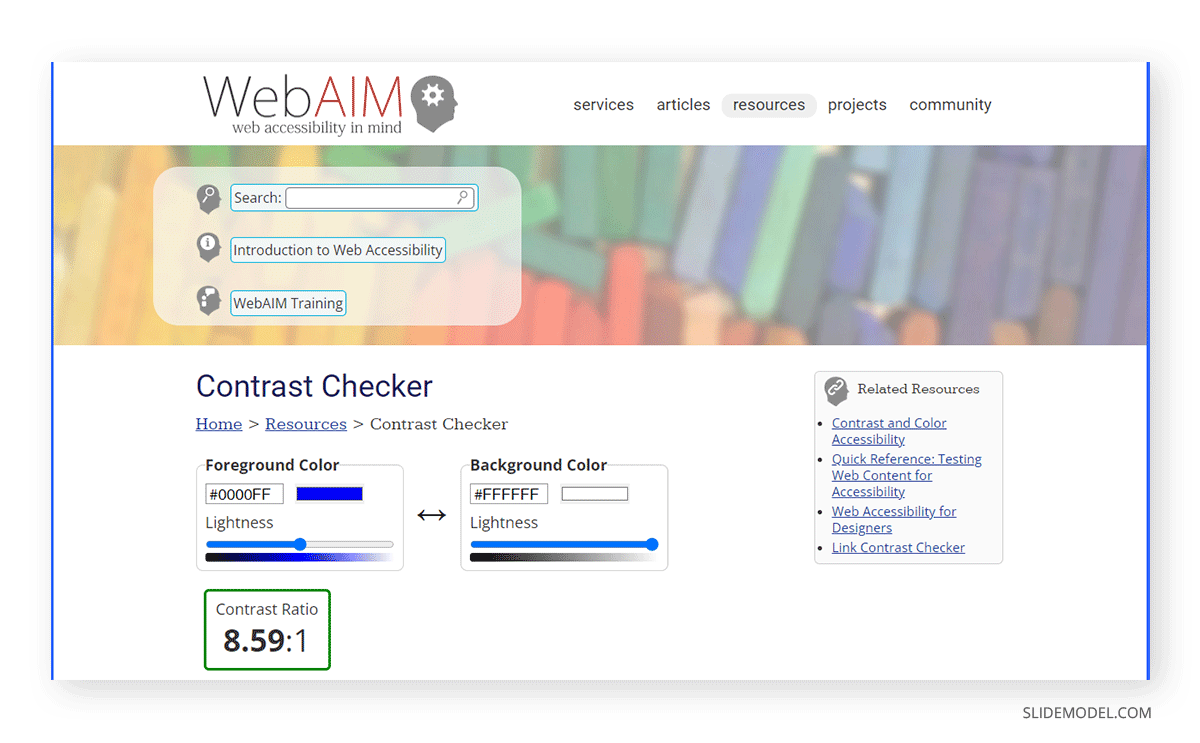
Use online tools such as WebAIM’s Contrast Checker to make your slides legible for your audience. Creating an overlay with a white or black transparent tint can also help when you place text above images.
Mistake #3 – Not rehearsing the presentation
This is a sin in conference presentations, as when you don’t practice the content you intend to deliver, you don’t have a measure of how much time it is actually going to take.

PowerPoint’s rehearse timing feature can help a great deal, as you can record yourself practising the presentation and observe areas for improvement. Remember, conference presentations are time-limited , don’t disrespect fellow speakers by overlapping their scheduled slot or, worse, have moderators trim your presentation after several warnings.
Mistake #4 – Lacking hierarchy for the presented content
Looking at a slide and not knowing where the main point is discouraging for the audience, especially if you introduce several pieces of content under the same slide. Instead, opt to create a hierarchy that comprehends both text and images. It helps to arrange the content according to your narrative, and we’ll see more on this later on.
Consider your conference presentation as your introduction card in the professional world. Maybe you have a broad network of colleagues, but be certain there are plenty of people out there that have yet to learn about who you are and the work you produce.
Conferences help businesspeople and academics alike to introduce the results of months of research on a specific topic in front of a knowledgeable audience. It is different from a product launch as you don’t need to present a “completed product” but rather your views or advances, in other words, your contribution with valuable insights to the field.
Putting dedication into your conference presentation, from the slide deck design to presentation skills , is definitely worth the effort. The audience can get valuable references from the quality of work you are able to produce, often leading to potential partnerships. In business conferences, securing an investor deal can happen after a powerful presentation that drives the audience to perceive your work as the very best thing that’s about to be launched. It is all about how your body language reflects your intent, how well-explained the concepts are, and the emotional impact you can drive from it.
There are multiple ways on how to start a presentation for a conference, but overall, we can recap a good approach as follows.
Present a fact
Nothing grabs the interest of an audience quicker than introducing an interesting fact during the first 30 seconds of your presentation. The said fact has to be pivotal to the content your conference presentation will discuss later on, but as an ice-breaker, it is a strategy worth applying from time to time.
Ask a question
The main point when starting a conference presentation is to make an impact on the audience. We cannot think of a better way to engage with the audience than to ask them a question relevant to your work or research. It grabs the viewer’s interest for the potential feedback you shall give to those answers received.
Use powerful graphics
The value of visual presentations cannot be neglected in conferences. Sometimes an image makes a bigger impact than a lengthy speech, hence why you should consider starting your conference presentation with a photo or visual element that speaks for itself.
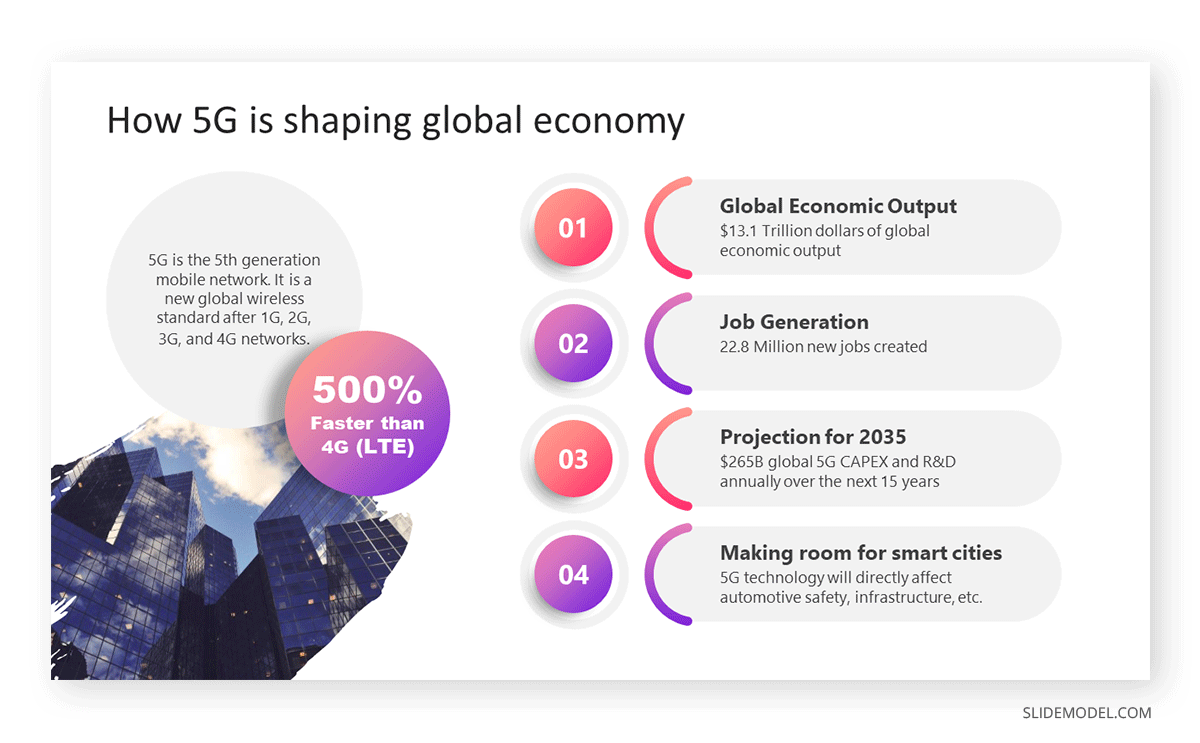
For more tips and insights on how to start a presentation , we invite you to check this article.
Just as important as starting the presentation, the closure you give to your conference presentation matters a lot. This is the opportunity in which you can add your personal experience on the topic and reflect upon it with the audience or smoothly transition between the presentation and your Q&A session.
Below are some quick tips on how to end a presentation for a conference event.
End the presentation with a quote
Give your audience something to ruminate about with the help of a quote tailored to the topic you were discussing. There are plenty of resources for finding suitable quotes, and a great method for this is to design your penultimate slide with an image or black background plus a quote. Follow this with a final “thank you” slide.
Consider a video
If we say a video whose length is shorter than 1 minute, this is a fantastic resource to summarize the intent of your conference presentation.
If you get the two-minute warning and you feel far off from finishing your presentation, first, don’t fret. Try to give a good closure when presenting in a conference without rushing information, as the audience wouldn’t get any concept clear that way. Mention that the information you presented will be available for further reading at the event’s platform site or your company’s digital business card , and proceed to your closure phase for the presentation.
It is better to miss some of the components of the conference than to get kicked out after several warnings for exceeding the allotted time.
Tailoring your conference presentation to suit your audience is crucial to delivering an impactful talk. Different audiences have varying levels of expertise, interests, and expectations. By customizing your content, tone, and examples, you can enhance the relevance and engagement of your presentation.
Understanding Audience Backgrounds and Expectations
Before crafting your presentation, research your audience’s backgrounds and interests. Are they professionals in your field, students, or a mix of both? Are they familiar with the topic, or must you provide more context? Understanding these factors will help you pitch your content correctly and avoid overwhelming or boring your audience.
Adapting Language and Tone for Relevance
Use language that resonates with your audience. Avoid jargon or technical terms that might confuse those unfamiliar with your field. Conversely, don’t oversimplify if your audience consists of experts. Adjust your tone to match the event’s formality and your listeners’ preferences.
Customizing Examples and Case Studies
Incorporate case studies, examples, and anecdotes that your audience can relate to. If you’re speaking to professionals, use real-world scenarios from their industry. For a more general audience, choose examples that are universally relatable. This personal touch makes your content relatable and memorable.
Effectively presenting data is essential for conveying complex information to your audience. Visualizations can help simplify intricate concepts and make your points more digestible.
Choosing the Right Data Representation
Select the appropriate type of graph or chart to illustrate your data. Bar graphs, pie charts, line charts, and scatter plots each serve specific purposes. Choose the one that best supports your message and ensures clarity.
Designing Graphs and Charts for Clarity
Ensure your graphs and charts are easily read. Use clear labels, appropriate color contrasts, and consistent scales. Avoid clutter and simplify the design to highlight the most important data points.
Incorporating Annotations and Explanations
Add annotations or callouts to your graphs to emphasize key findings. Explain the significance of each data point to guide your audience’s understanding. Utilize visual cues, such as arrows and labels, to direct attention.
Engaging your audience is a fundamental skill for a successful presentation for conference. Captivate their attention, encourage participation, and foster a positive connection.
Establishing Eye Contact and Body Language
Maintain eye contact with different audience parts to create a sense of connection. Effective body language, such as confident posture and expressive gestures, enhances your presence on stage.
Encouraging Participation and Interaction
Involve your audience through questions, polls, or interactive activities. Encourage them to share their thoughts or experiences related to your topic. This engagement fosters a more dynamic and memorable presentation.
Using Humor and Engaging Stories
Incorporate humor and relatable anecdotes to make your presentation more enjoyable. Well-timed jokes or personal stories can create a rapport with your audience and make your content more memorable.
The design of your conference presentation slides plays a crucial role in capturing and retaining your audience’s attention. Thoughtful design can amplify your message and reinforce key points. Take a look at these suggestions to boost the performance of your conference presentation slides, or create an entire slide deck in minutes by using SlideModel’s AI Presentation Maker from text .
Creating Memorable Opening Slides
Craft an opening slide that piques the audience’s curiosity and sets the tone for your presentation. Use an engaging visual, thought-provoking quote, or intriguing question to grab their attention from the start.
Using Visual Hierarchy for Emphasis
Employ visual hierarchy to guide your audience’s focus. Highlight key points with larger fonts, bold colors, or strategic placement. Organize information logically to enhance comprehension.
Designing a Powerful Closing Slide
End your presentation with a compelling closing slide that reinforces your main message. Summarize your key points, offer a memorable takeaway, or invite the audience to take action. Use visuals that resonate and leave a lasting impression.
Slide transitions and animations can enhance the flow of your presentation and emphasize important content. However, their use requires careful consideration to avoid distractions or confusion.
Enhancing Flow with Transitions
Select slide transitions that smoothly guide the audience from one point to the next. Avoid overly flashy transitions that detract from your content. Choose options that enhance, rather than disrupt, the presentation’s rhythm.
Using Animation to Highlight Points
Animate elements on your slides to draw attention to specific information. Animate text, images, or graphs to appear as you discuss them, helping the audience follow your narrative more effectively.
Avoiding Overuse of Effects
While animation can be engaging, avoid excessive use that might overwhelm or distract the audience. Maintain a balance between animated elements and static content for a polished presentation.
Effective time management is crucial for delivering a concise and impactful conference presentation within the allocated time frame.
Structuring for Short vs. Long Presentations
Adapt your content and pacing based on the duration of your presentation. Clearly outline the main points for shorter talks, and delve into more depth for longer sessions. Ensure your message aligns with the time available.
Prioritizing Key Information
Identify the core information you want your audience to take away. Focus on conveying these essential points, and be prepared to trim or elaborate on supporting details based on the available time.
Practicing Time Management
Rehearse your presentation while timing yourself to ensure you stay within the allocated time. Adjust your delivery speed to match your time limit, allowing for smooth transitions and adequate Q&A time.
Multimedia elements, such as videos, audio clips, and live demonstrations, can enrich your presentation and provide a dynamic experience for your audience.
Integrating Videos and Audio Clips
Use videos and audio clips strategically to reinforce your points or provide real-world examples. Ensure that the multimedia content is of high quality and directly supports your narrative.
Showcasing Live Demonstrations
Live demonstrations can engage the audience by showcasing practical applications of your topic. Practice the demonstration beforehand to ensure it runs smoothly and aligns with your message.
Using Hyperlinks for Additional Resources
Incorporate hyperlinks into your presentation to direct the audience to additional resources, references, or related content. This allows interested attendees to explore the topic further after the presentation.
Engaging with your audience after your presentation can extend the impact of your talk and foster valuable connections.
Leveraging Post-Presentation Materials
Make your presentation slides and related materials available to attendees after the event. Share them through email, a website, or a conference platform, allowing interested individuals to review the content.
Sharing Slides and Handouts
Provide downloadable versions of your slides and any handouts you used during the presentation. This helps attendees revisit key points and share the information with colleagues.
Networking and Following Up
Utilize networking opportunities during and after the conference to connect with attendees who are interested in your topic. Exchange contact information and follow up with personalized messages to continue the conversation.
Preparing for unexpected challenges during your presenting at a conference can help you maintain professionalism and composure, ensuring a seamless delivery.
Dealing with Technical Glitches
Technical issues can occur, from projector malfunctions to software crashes. Stay calm and have a backup plan, such as having your slides available on multiple devices or using printed handouts.
Handling Unexpected Interruptions
Interruptions, such as questions from the audience or unforeseen disruptions, are a normal part of live presentations. Address them politely, stay adaptable, and seamlessly return to your prepared content.
Staying Calm and Professional
Maintain a composed demeanor regardless of unexpected situations. Your ability to handle challenges gracefully reflects your professionalism and dedication to delivering a successful presentation.
Creating environmentally friendly presentations demonstrates your commitment to sustainability and responsible practices.
Designing Eco-Friendly Slides
Minimize the use of resources by designing slides with efficient layouts, avoiding unnecessary graphics or animations, and using eco-friendly color schemes.
Reducing Paper and Material Waste
Promote a paperless approach by encouraging attendees to access digital materials rather than printing handouts. If print materials are necessary, consider using recycled paper.
Promoting Sustainable Practices
Advocate for sustainability during your presentation by discussing relevant initiatives, practices, or innovations that align with environmentally conscious values.
Measuring the success of your conference presentation goes beyond the applause and immediate feedback. It involves assessing the impact of your presentation on your audience, goals, and growth as a presenter.
Collecting Audience Feedback
After presenting at a conference, gather feedback from attendees. Provide feedback forms or online surveys to capture their thoughts on the content, delivery, and visuals. Analyzing their feedback can reveal areas for improvement and give insights into audience preferences.
Evaluating Key Performance Metrics
Consider objective metrics such as audience engagement, participation, and post-presentation interactions. Did attendees ask questions? Did your content spark discussions? Tracking these metrics can help you gauge the effectiveness of your presentation in conveying your message.
Continuous Improvement Strategies
Use the feedback and insights gathered to enhance your future presentations. Identify strengths to build upon and weaknesses to address. Continuously refine your presentation skills , design choices, and content to create even more impactful presentations in the future.
Tip #1 – Exhibit a single idea per slide
Just one slide per concept, avoiding large text blocks. If you can compile the idea with an image, it’s better that way.
Research shows that people’s attention span is limited ; therefore, redirect your efforts in what concerns presentation slides so your ideas become crystal clear for the spectators.
Tip #2 – Avoid jargon whenever possible
Using complex terms does not directly imply you fully understand the concept you are about to discuss. In spite of your work being presented to a knowledgeable audience, avoid jargon as much as possible because you run the risk of people not understanding what you are saying.
Instead, opt to rehearse your presentation in front of a not-knowledgeable audience to measure the jargon volume you are adding to it. Technical terms are obviously expected in a conference situation, but archaic terms or purely jargon can be easily trimmed this way.
Tip #3 – Replace bulleted listings with structured layouts or diagrams
Bullet points are attention grabbers for the audience. People tend to instantly check what’s written in them, in contrast to waiting for you to introduce the point itself.
Using bullet points as a way to expose elements of your presentation should be restricted. Opt for limiting the bullet points to non-avoidable facts to list or crucial information.
Tip #4 – Customize presentation templates
Using presentation templates is a great idea to save time in design decisions. These pre-made slide decks are entirely customizable; however, many users fall into using them as they come, exposing themselves to design inconsistencies (especially with images) or that another presenter had the same idea (it is extremely rare, but it can happen).
Learning how to properly change color themes in PowerPoint is an advantageous asset. We also recommend you use your own images or royalty-free images selected by you rather than sticking to the ones included in a template.
Tip #5 – Displaying charts
Graphs and charts comprise around 80% of the information in most business and academic conferences. Since data visualization is important, avoid common pitfalls such as using 3D effects in bar charts. Depending on the audience’s point of view, those 3D effects can make the data hard to read or get an accurate interpretation of what it represents.

Tip #6 – Using images in the background
Use some of the images you were planning to expose as background for the slides – again, not all of them but relevant slides.
Be careful when placing text above the slides if they have a background image, as accessibility problems may arise due to contrast. Instead, apply an extra color layer above the image with reduced opacity – black or white, depending on the image and text requirements. This makes the text more legible for the audience, and you can use your images without any inconvenience.
Tip #7 – Embrace negative space
Negative space is a concept seen in design situations. If we consider positive space as the designed area, meaning the objects, shapes, etc., that are “your design,” negative space can be defined as the surrounding area. If we work on a white canvas, negative space is the remaining white area surrounding your design.
The main advantage of using negative space appropriately is to let your designs breathe. Stuffing charts, images and text makes it hard to get a proper understanding of what’s going on in the slide. Apply the “less is more” motto to your conference presentation slides, and embrace negative space as your new design asset.
Tip #8 – Use correct grammar, spelling, and punctuation
You would be surprised to see how many typos can be seen in slides at professional gatherings. Whereas typos can often pass by as a humor-relief moment, grammatical or awful spelling mistakes make you look unprofessional.
Take 5 extra minutes before submitting your slide deck to proofread the grammar, spelling, and punctuation. If in doubt, browse dictionaries for complex technical words.
Tip #10 – Use an appropriate presentation style
The format of the conference will undoubtedly require its own presentation style. By this we mean that it is different from delivering a conference presentation in front of a live audience as a webinar conference. The interaction with the audience is different, the demands for the Q&A session will be different, and also during webinars the audience is closely looking at your slides.
Tip #11 – Control your speaking tone
Another huge mistake when delivering a conference presentation is to speak with a monotonous tone. The message you transmit to your attendees is that you simply do not care about your work. If you believe you fall into this category, get feedback from others: try pitching to them, and afterward, consider how you talk.
Practicing breathing exercises can help to articulate your speech skills, especially if anxiety hinders your presentation performance.
Tip #12 – On eye contact and note reading
In order to connect with your audience, it is imperative to make eye contact. Not stare, but look at your spectators from time to time as the talk is directed at them.
If you struggle on this point, a good tip we can provide is to act like you’re looking at your viewers. Pick a good point a few centimeters above your viewer and direct your speech there. They will believe you are communicating directly with them. Shift your head slightly on the upcoming slide or bullet and choose a new location.
Regarding note reading, while it is an acceptable practice to check your notes, do not make the entire talk a lecture in which you simply read your notes to the audience. This goes hand-by-hand with the speaking tone in terms of demonstrating interest in the work you do. Practice as often as you need before the event to avoid constantly reading your notes. Reading a paragraph or two is okay, but not the entire presentation.
Tip #13 – Be ready for the Q&A session
Despite it being a requirement in most conference events, not all presenters get ready for the Q&A session. It is a part of the conference presentation itself, so you should pace your speech to give enough time for the audience to ask 1-3 questions and get a proper answer.
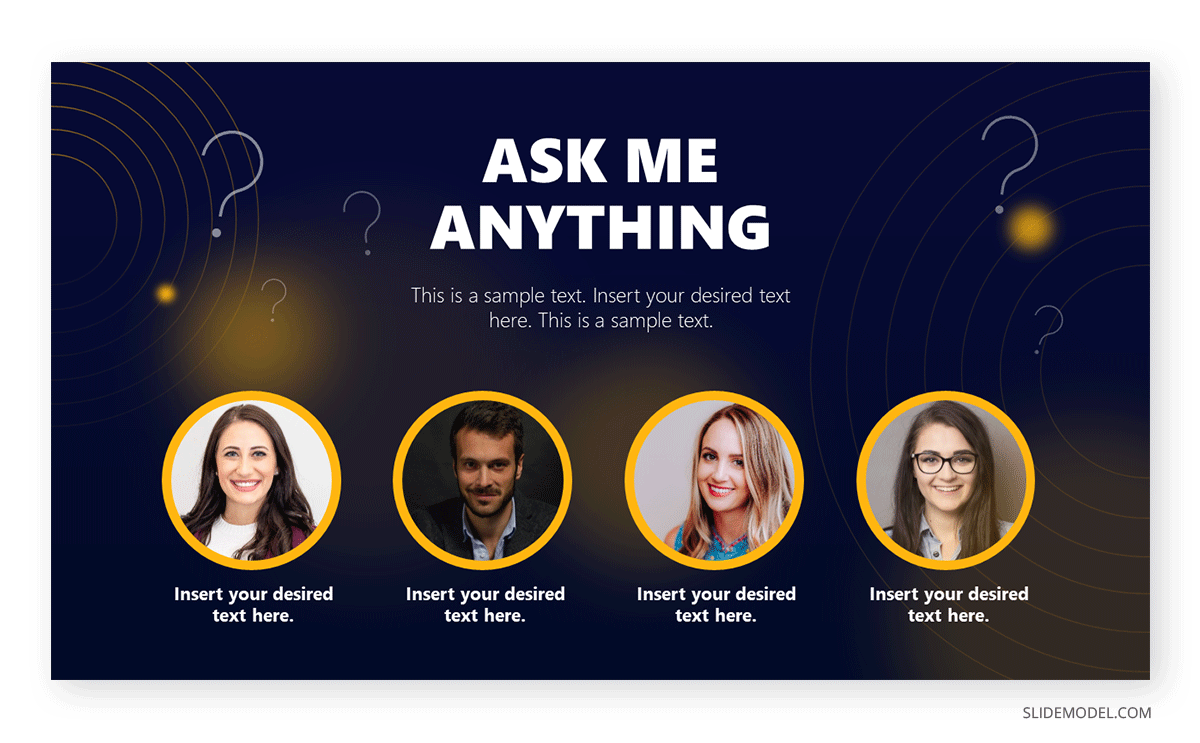
Don’t be lengthy or overbearing in replying to each question, as you may run out of time. It is preferable to give a general opinion and then reach the interested person with your contact information to discuss the topic in detail.
Observing what others do at conference events is good practice for learning a tip or two for improving your own work. As we have seen throughout this article, conference presentation slides have specific requirements to become a tool in your presentation rather than a mixture of information without order.
Employ these tips and suggestions to craft your upcoming conference presentation without any hurdles. Best of luck!
1. Conference PowerPoint Template
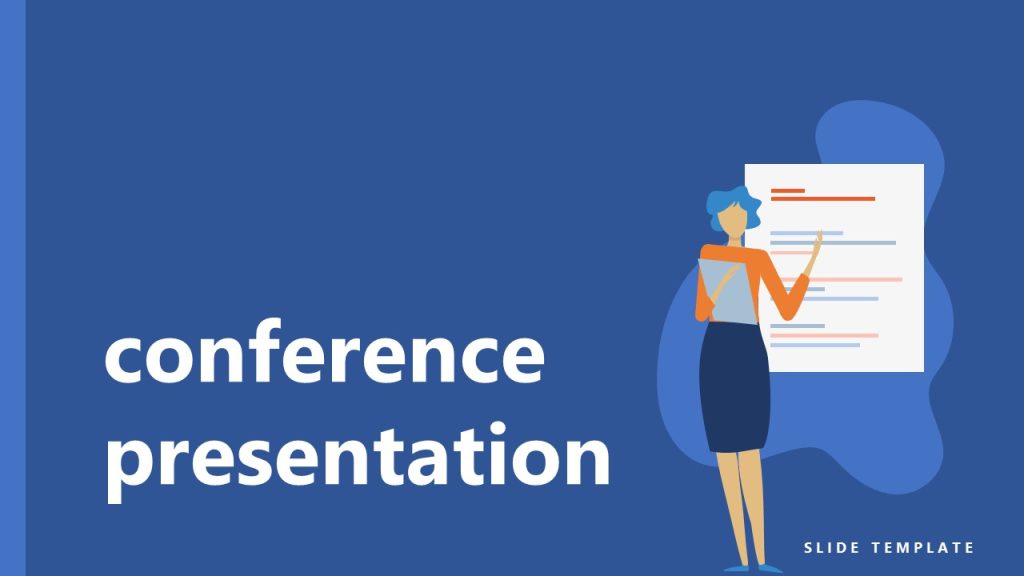
Use This Template
2. Free Conference Presentation Template
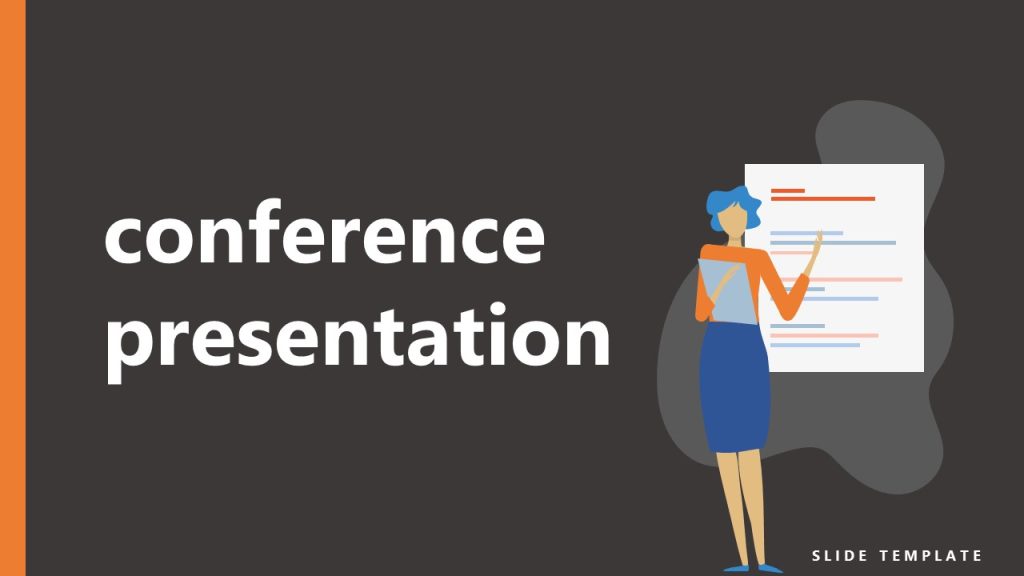
Like this article? Please share
Presentation Approaches, Presentation Skills, Presentation Tips Filed under Business
Related Articles

Filed under Business • July 24th, 2024
How to Create a Demo Presentation
Discover the secrets behind successful demo presentations and what they should contain with this article. Recommended PPT templates included.

Filed under Presentation Ideas • July 17th, 2024
How to Convert a Text Document into a Presentation with AI
One of the biggest challenges for presenters is to summarize content from lengthy reports, academic papers, or any other kind of written media in an informative and concise way. Rather than losing countless hours going over and over the same text, we can speed up the process thanks to the virtues of artificial intelligence. In […]

Filed under Google Slides Tutorials • July 15th, 2024
How to Export Trello Board to Google Slides
In this article you will learn how to export Trello Boards and convert them instantly into Google Slides, in a step by step tutorial.
Leave a Reply
Conference Presentation: A comprehensive guide
In this guide learn how to choose a topic, develop content, deliver with confidence, and more.
Raja Bothra
Building presentations

Welcome to the world of conference presentations!
Whether you're an academic, a professional, or simply someone eager to share your knowledge, the art of delivering an effective conference presentation is a skill worth mastering.
In this comprehensive guide, we will walk you through the ins and outs of conference presentations, from understanding what they are to mastering the key elements that make them successful.
So, grab your "presentation slide" of inspiration and let's dive into the world of conference presentations.
What is a conference presentation?
A conference presentation is a means of conveying information, research findings, or ideas to an audience in a structured and engaging manner. It's a platform for individuals to showcase their expertise, share their insights, and foster discussions on topics ranging from academic research to professional insights. Whether you're presenting at an "academic conference" or a corporate gathering, the goal remains the same: to effectively communicate your message.
Types of Conference Presentations
Before we delve into the nitty-gritty details, let's explore the different types of conference presentations you might encounter:
Oral presentation
The quintessential "oral presentation" remains one of the most prominent formats across conferences, be it academic or professional. These presentations typically span a concise 15-20 minutes, providing a platform for presenters to delve into a wide array of topics:
- Research findings : Share your latest research discoveries.
- Completed works : Showcase your completed projects and their outcomes.
- Innovative concepts : Introduce groundbreaking ideas that push the boundaries.
- Theoretical Applications : Explore the theoretical underpinnings of your field.
- Methodologies : Explain the methodologies you've employed in your work.
The structure of an oral presentation allows for a systematic exploration of these topics, followed by a brief Q&A session, providing valuable interactions with the audience.
Poster presentation
On the flip side, "poster presentations" offer a more relaxed and interactive avenue to convey your work. This format involves creating a visual "poster presentation" that succinctly highlights your key points. Here's why poster presentations are worth considering:
- Concise and visually appealing : Posters condense your work into a visually engaging format.
- Informal interaction : Presenters stand by their posters in a common area, ready to engage with curious attendees.
- Networking opportunity : It's an excellent way to network with fellow researchers and gain valuable feedback on your work.
Poster presentations bridge the gap between the visual and the informative, making them an excellent choice for those looking to engage their audience in a more relaxed setting.
Beyond the basics
While oral and poster presentations are the cornerstone of many conferences, there are other presentation formats that cater to diverse objectives and preferences:
- Panel discussions : Experts gather to discuss a specific topic in front of an audience, offering varied perspectives and insights.
- Roundtables : In a more informal setting, a small group of individuals engage in in-depth discussions on a particular topic.
- Workshops : Attendees immerse themselves in hands-on activities to acquire new skills or knowledge.
- Keynote speeches : Prominent speakers take the stage to deliver inspiring talks on topics of paramount importance to the conference audience.
- Lightning talks : These brief, high-impact presentations, typically lasting 5-10 minutes, cover a wide array of topics in a succinct manner.
Selecting the most appropriate presentation format depends on the nature of the conference and your personal preferences. If you're unsure about which format aligns best with your objectives, don't hesitate to reach out to the conference organizers for guidance. After all, the key to a successful conference presentation is choosing the format that allows you to shine and effectively convey your message.
How to structure an effective conference presentation
A well-structured presentation is like a well-composed symphony - it captures the audience's attention and leaves a lasting impression. Here's a step-by-step guide to help you create a harmonious presentation:
1. Begin with a clear introduction
The beginning of your presentation is your chance to make a memorable first impression. Start by introducing yourself and your topic. Use a "clear outline" to provide a roadmap for your presentation. For instance, you can say, "Today, I'll discuss the key elements of a successful conference presentation, including effective structure, engaging visuals, and impactful delivery."
2. Create an engaging body
The body of your presentation should contain the main points you want to convey. Here's where your "slide deck" comes into play. Each slide should emphasize a single point, keeping it concise and visually appealing. Remember the "good rule of thumb" - one slide per key idea.
3. Emphasize with visuals
Visual aids, such as graphs and images, can help "emphasize" your message and make complex information easily understood. However, don't overload your slides with visuals; use them strategically to "get the message across."
4. Maintain audience engagement
Your "presentation style" plays a vital role in keeping your audience engaged. Practice "body language" that conveys confidence and enthusiasm. Maintain "eye contact with your audience" to establish a connection. Utilize gestures to "emphasize" key points and establish a rapport with your audience.
5. Summarize key takeaways
As you approach the "end of your presentation," allocate some time to summarize the key takeaways. This reinforces the main points and ensures your audience leaves with a clear understanding of your message.
Do’s and don'ts of a conference presentation
Now that you know how to structure your presentation effectively, let's explore some do's and don'ts that can make or break your presentation.
- Rehearse : "Rehearse your presentation" practise multiple times to ensure a smooth delivery.
- Use visuals : Incorporate visuals, but don't let them "distract the audience."
- Maintain eye contact : "Maintain eye contact with your audience" to establish a connection.
- Engage the audience : "Give your audience" opportunities to participate, ask questions, or share their thoughts.
- Time management : Stick to the allotted time. "Conference organizers" appreciate punctuality.
Don'ts:
- Overwhelm with text : Avoid adding slide after slide filled with font text. Remember, less is often more.
- Lack of preparation : Don't "rehearse" just once. The more you practice, the more confident you'll feel.
- Reading slides : Don't simply "read your paper" or slides. Your audience can do that themselves.
- Ignoring questions : Always address "questions from the audience" respectfully and thoughtfully. Avoid being unprofessional.
- Going off topic : Stay on track. "Unrelated tangents" can confuse your audience.
Summarizing Key Takeaways
In this comprehensive guide, we've covered the essentials of crafting an "effective conference presentation." From structuring your presentation to engaging your audience, you now have the tools to shine at your next conference.
- Conference Presentations are a means to share information or research effectively.
- Types include oral (concise talks) and poster (visual presentations).
- Other formats like panels, roundtables, workshops, keynotes, and lightning talks cater to different objectives.
- Structure your presentation with a clear intro, engaging body, visuals, audience engagement, and key takeaways.
- Do's: Rehearse, use visuals wisely, maintain eye contact, engage the audience, and manage time.
- Don'ts: Avoid overwhelming text, lack of preparation, reading slides, ignoring questions, and going off-topic.
Remember, a great presentation is not just about delivering information; it's about creating a memorable experience for your audience. Whether you're "presenting at a conference" for the first time or you're a seasoned pro, these tips for presenting will help you make a lasting impression.
1. How can I create the best presentation for my conference talk?
To craft an impactful presentation for your conference talk, consider beginning with a PowerPoint template tailored to the theme of the event. The right template, such as a specialized conference strategy presentation template , can provide a solid foundation for organizing your content. Ensure your presentation flows seamlessly, incorporating bullet points strategically to highlight key information. Moreover, delivering an effective conference paper necessitates practicing in front of a mirror and employing gestures to underscore essential points.
2. What is the typical length of a conference presentation?
The length of your effective presentation may vary depending on the conference committee's guidelines, but most conferences allocate around 15-20 minutes for each presentation. It's important to remember to keep track of time as you present, as you may run out of time if you're not careful.
3. Do I need to submit an abstract before presenting a paper at a conference?
Yes, you typically need to submit an abstract related to your topic before being accepted to present at a conference. The conference committee reviews these abstracts to determine which presentations are most suitable and interesting to the audience members interested in your research.
4. How can I make my conference presentation memorable?
To make your memorable presentation, use slide decks effectively, and consider the presentation technology available on the conference platform. Emphasize key points and use gestures to engage your audience. Also, e.g., include relevant images and graphs in your slides to help the audience understand your research paper.
5. What should I do if I'm presenting at a conference where the audience is unfamiliar with my field?
If you're presenting at a conference where the audience is unfamiliar with your field, make sure to use simple language and avoid jargon. Provide enough context and background information related to your topic to help the audience understand. Additionally, be prepared to ask a question or two to engage the audience and familiarize them with your work during the Q&A session.
Create your conference presentation with prezent
Before we conclude, here's a valuable tip: Consider using presentation software like Prezent to streamline your conference presentation creation process. Prezent offers:
- Time savings: Prezent can save you up to 70% of the time typically spent on crafting presentations, allowing you to focus on other critical conference preparations.
- Brand consistency: Access to brand-approved designs from Fortune companies ensures that your conference presentation maintains a professional and consistent look.
- Audience engagement: Prezent helps you understand your audience's preferences, enabling you to create presentations that resonate and engage effectively.
- Cost efficiency: By standardizing presentations and streamlining communication, Prezent can cut communication costs by up to 60%, a valuable advantage for conference budgets.
- Overnight service: Take advantage of Prezent's overnight presentation service for tight deadlines, ensuring you receive a polished presentation by the next business day.
In conclusion, a successful conference presentation is all about striking the right balance between structure, visuals, and engagement. Mastering these elements will not only boost your "presentation skills" but also ensure that your audience leaves with a deeper understanding of your work.
So, go ahead, "present your paper" with confidence, captivate your audience, and leave a lasting impression on the conference stage.
Sign up for our free trial or book a demo !
Happy presenting!
More zenpedia articles

10 ways to build interpersonal communication skills at workplace

Nine steps to create an effective communication plan

Communicate with confidence: Understand and adapt to the 4 types of communication styles
Get the latest from Prezent community
Join thousands of subscribers who receive our best practices on communication, storytelling, presentation design, and more. New tips weekly. (No spam, we promise!)
How to make a great presentation
Stressed about an upcoming presentation? These talks are full of helpful tips on how to get up in front of an audience and make a lasting impression.

The secret structure of great talks

The beauty of data visualization

TED's secret to great public speaking

How to speak so that people want to listen

How great leaders inspire action

What To Include In A Conference Presentation?
Delivering a conference presentation can be daunting, especially your first time. To deliver an impactful presentation, you’ll need to know how to structure your content, engage your audience, and use effective visuals.
A conference presentation should include a clear objective, engaging content, relevant visuals, a logical structure, concise key points, and opportunities for audience interaction and discussion.
This article aims to provide you with the necessary tools and strategies to prepare a successful conference presentation. Whether you are a seasoned presenter or a beginner, these strategies can help you deliver a conference presentation that leaves a lasting impact on your audience.
Key Takeaways:
• Tailor the content to the audience’s needs and level of expertise • Plan the structure of the presentation with an attention-grabbing opening, logical body, and summarizing closing remarks • Use interactive activities and storytelling techniques to keep the audience engaged • Use effective visuals, simple fonts, high-quality images, and interactive elements to support the points made
Know Your Audience
A crucial aspect of delivering an effective conference presentation is to tailor the content to the specific audience, accounting for their background, interests, and level of expertise because a well-organized conference presentation attracts global conference attendees .
To do so, research the audience beforehand, and gather information about their field of study, the type of projects they are working on, and their experience level in the subject area. By doing so, the presenter can adapt the presentation to the audience’s needs and use terminology and examples that are relevant and relatable to them.
Tailoring the content to the audience also means considering their expertise. If the audience consists of experts in the field, the presenter can dive deeper into the technical aspects of the topic, whereas if the audience is less familiar with the subject area, the presentation should be more introductory.
By considering the audience’s background and level of expertise, the presenter can deliver a more engaging and informative presentation that will resonate with the audience. With this in mind, the next step is to plan the structure of the presentation accordingly.
Plan Your Structure

To effectively organize the content of a scholarly talk, carefully consider the structure of the presentation, which involves a deliberate arrangement of ideas and concepts. The opening statement should grab the audience’s attention and clearly indicate the topic of discussion.
The body of the presentation should then be organized logically and coherently, with each point building upon the previous one. Transition slides can guide the audience from one point to the next and help ensure the presentation flows smoothly.
Interactive activities, such as asking the audience questions, can also be used to keep the audience engaged and involved in the presentation. The closing remarks should summarize the presentation’s main points and leave a lasting impression on the audience.
In addition to the structure of the presentation, consider the use of effective visuals. Visual aids such as charts, graphs, and images can support the points made during the presentation and help the audience better understand complex ideas.
However, you should use visuals sparingly and ensure they are easy to read and understand. By carefully planning the structure of the presentation and using effective visuals, scholars can deliver engaging and informative talks that leave a lasting impression on their audience.
Use Effective Visuals
Effective visuals are crucial in delivering an engaging and informative scholarly talk that effectively supports and enhances the key concepts and ideas discussed. Visual design is crucial in capturing the audience’s attention and conveying complex information simply and understandably. Even you should wear the right dress , depending on the conference type.

To achieve this, presentation software such as PowerPoint, Keynote, or Prezi can be used to create visually appealing slides that enhance the overall delivery of the presentation.
However, note that the effectiveness of visuals is not solely dependent on the kind of software used but rather on the design and layout of the visual aids themselves. When designing visuals for a conference presentation, ensure that they are clear, concise, and easy to read.
This can be achieved using simple fonts, minimal text, and high-quality images. Use colors that complement each other and are not distracting or overwhelming. Additionally, graphs, charts, or infographics can effectively display complex data in a visually appealing and easily understandable format.
By incorporating effective visuals into a conference presentation, the presenter can enhance the overall delivery of their message and engage the audience more meaningfully, leading to a more successful and impactful presentation.
To further engage the audience, utilize interactive elements such as audience participation or question-and-answer sessions. In that case, it will be better to know how to ask someone to present at the conference .
By doing so, the presenter can create a dynamic and engaging atmosphere that encourages the audience to actively participate in the discussion and become more invested in the topic.
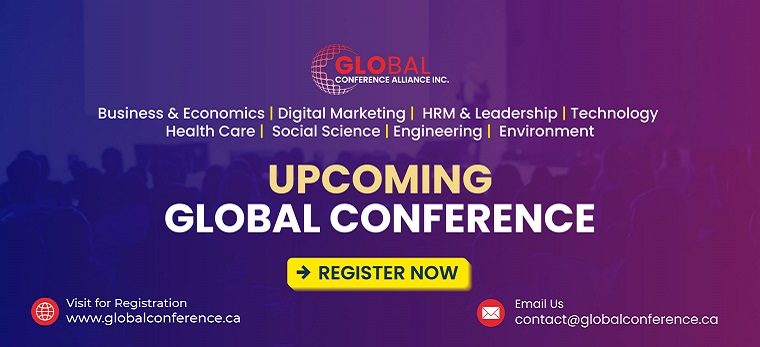
Engage Your Audience
Engaging the audience while delivering a scholarly talk is like lighting a fire that ignites their curiosity and keeps them actively involved in the discussion. One way to achieve this is through interactive activities that encourage audience participation.
This can include asking questions, conducting polls, or even role-playing exercises. Involving the audience in the presentation keeps them engaged and helps reinforce the key concepts being discussed.
Another way to engage the audience is through the use of storytelling techniques. Incorporating personal anecdotes or relevant stories adds interest to the presentation and helps connect with the audience more emotionally.
However, remember that storytelling should be relevant to the topic being discussed and should not detract from the overall message of the presentation. By incorporating these techniques, the audience is more likely to retain the information presented and be more actively engaged during the presentation.
As you prepare for your conference presentation, remember the importance of engaging your audience through interactive activities and storytelling techniques. However, practicing and preparing to deliver a polished and effective presentation is equally important.
Practice and Prepare
One key aspect of delivering an effective scholarly talk is to ensure proper practice and preparation. This involves rehearsing your speech and familiarizing yourself with the venue and the audience.
Here are some delivery techniques and presentation skills you can consider when practicing and preparing for your conference presentation:
- Practice your speech to ensure you can fit all the necessary information within the allotted time.
- Be aware of your posture, gestures, and facial expressions. Use them to convey confidence and enthusiasm.
- Vary your tone, pitch, and volume to keep your audience engaged and interested.
Creating a successful conference presentation requires careful planning, preparation, and practice. By knowing your audience, planning your structure, using effective visuals, engaging your audience, and preparing thoroughly, you can create a presentation that is both informative and engaging.
So whether you are presenting to colleagues, clients, or industry experts, keep these key elements in mind to ensure your message is heard loud and clear. As the saying goes, ‘Fail to prepare, prepare to fail.’

Leave a Comment Cancel Reply
Your email address will not be published. Required fields are marked *
Save my name, email, and website in this browser for the next time I comment.
Don’t miss our future updates! Get subscribed today!
Sign up for email updates and stay in the know about all things Conferences including price changes, early bird discounts, and the latest speakers added to the roster.

Meet and Network With International Delegates from Multidisciplinary Backgrounds.
Useful Links
Quick links, secure payment.

Copyright © Global Conference Alliance Inc 2018 – 2024. All Rights Reserved. Developed by Giant Marketers Inc .
- Mastering Event Presentation
- Enhancing Engagement and Interaction
Delivering Keynotes and Conference Presentations That Resonate

Aayush Jain
Crafting a compelling narrative for keynotes.
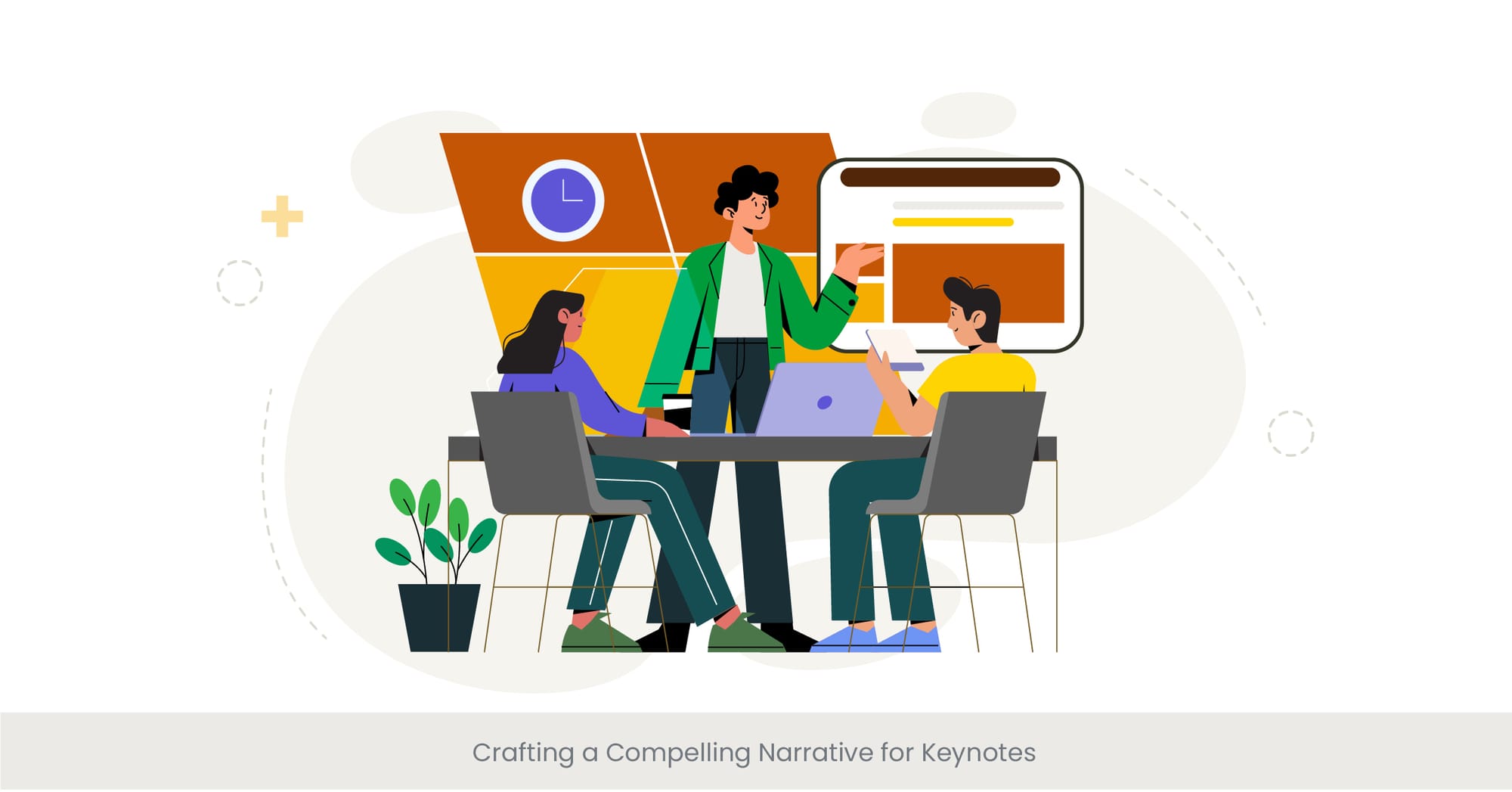
Engaging Beginnings: The Art of Crafting Compelling Narratives
Crafting a compelling narrative is the foundation of any memorable keynote and conference presentation . It's about weaving a story that not only informs but also entertains and inspires your audience. This introductory section delves into the significance of narrative structure, emphasizing its role in capturing and maintaining the audience's attention. By setting the stage with an engaging narrative, speakers can establish a connection with their audience, making their message more relatable and impactful.
The Backbone of Storytelling
Behind every compelling narrative is a well-thought-out structure. This involves setting a clear beginning, middle, and end, each serving a distinct purpose in the overall story. The beginning sets the context and introduces the main characters or ideas, the middle elaborates on the challenges or conflicts, and the end provides resolution. This structure helps in presenting key information in a logical and engaging manner, ensuring that the audience follows along and absorbs the intended message.
Real-World Narratives in Action
Illustrating this concept with real-world examples, consider how renowned speakers use personal anecdotes, historical events, or hypothetical scenarios to frame their presentations. These narratives are often rooted in universal themes such as overcoming adversity, innovation, or teamwork, making them resonate with diverse audiences. For instance, Steve Jobs' 2005 Stanford commencement speech skillfully narrated his personal and professional journey, weaving in lessons on resilience and curiosity, thereby leaving a lasting impression on his audience.
Narratives That Resonate: Evidence and Impact
Research supports the effectiveness of narrative storytelling in presentations. Studies show that stories are 22 times more memorable than facts alone. Furthermore, a well-crafted narrative can significantly enhance audience engagement, making the presentation more impactful and memorable. Incorporating narratives not only helps in conveying complex ideas more clearly but also in establishing an emotional connection with the audience, a key factor in the success of keynote and conference presentations .
Techniques for Effective Storytelling in Presentations
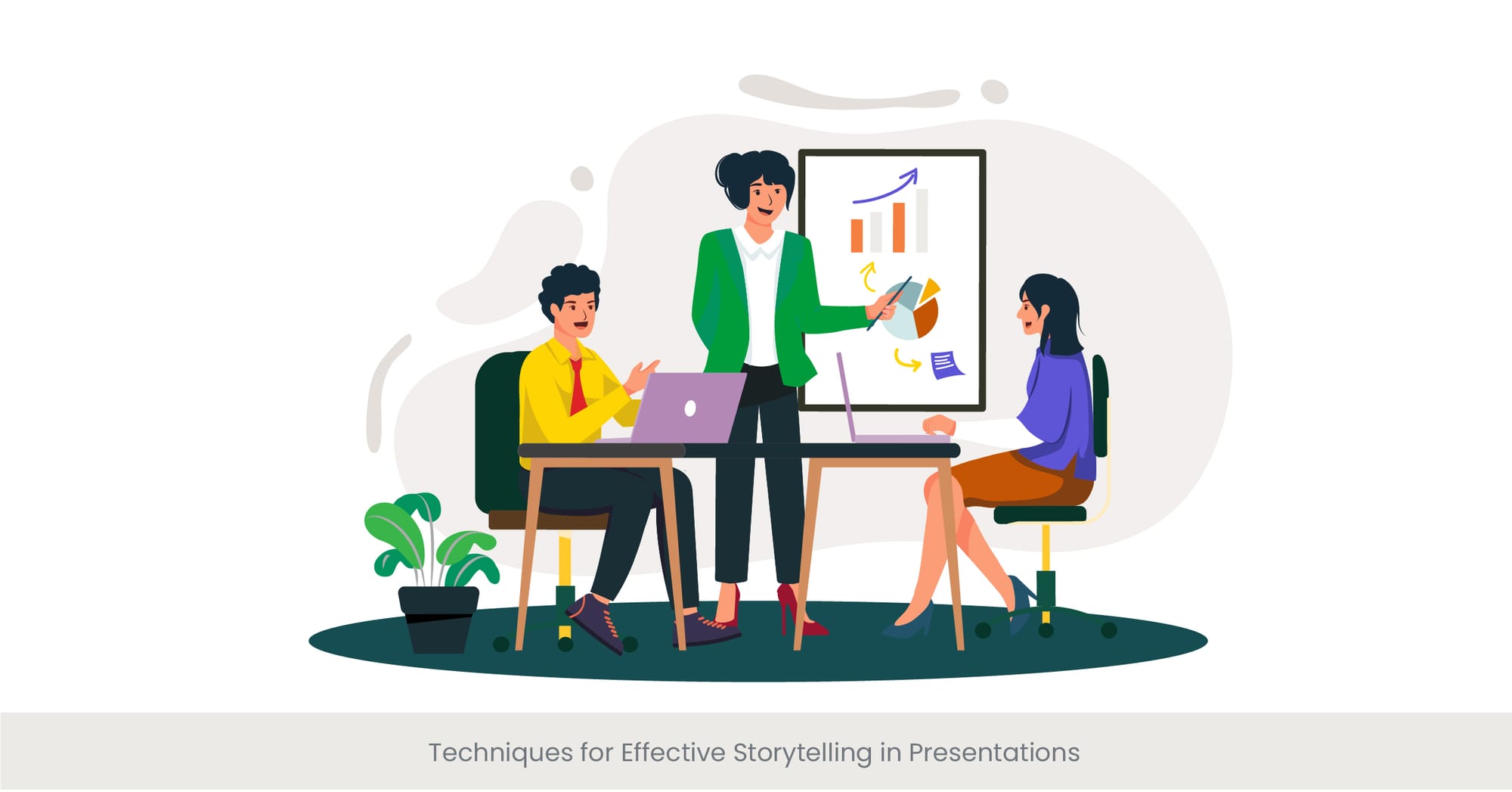
Unlocking the Power of Storytelling
Effective storytelling in keynote and conference presentations transcends mere recitation of facts; it involves crafting a narrative that engages, persuades, and moves the audience. This segment explores the techniques that transform simple presentations into riveting stories, focusing on the art of narrative delivery. By leveraging the power of storytelling, speakers can turn their presentations into memorable experiences that resonate with their audience on a deeper level.
Foundations of Engaging Storytelling
Understanding the core elements of storytelling is crucial. This includes the development of a clear plot, relatable characters, and a compelling conflict or challenge that hooks the audience. Incorporating these elements with purpose and precision is key to capturing and maintaining the audience's interest. The background of storytelling techniques stretches back to ancient oral traditions, where storytellers used these components to convey complex ideas and values. Today, these timeless principles still hold, underscoring the importance of a well-structured narrative in presentations.
Bringing Stories to Life: Examples and Applications
To illustrate, consider the use of storytelling in TED Talks, where speakers often start with personal anecdotes or surprising facts to engage the audience. These stories are not just entertaining; they serve to highlight the speaker's main points, making the presentation more relatable and the message more impactful. For example, Chimamanda Ngozi Adichie's "The Danger of a Single Story" uses personal narratives to explore complex themes of stereotypes and cultural understanding, demonstrating the profound effect of storytelling on conveying deep insights.
The Science Behind Storytelling
Research underpins the efficacy of storytelling in presentations, revealing that narratives can significantly enhance memory retention and emotional engagement. A study published in the Journal of Cognitive Neuroscience found that storytelling activates not only the language-processing parts of our brains but also those involved in experiencing the events of the story. This dual activation makes stories much more engaging than abstract presentations, facilitating a deeper connection with the audience and a more lasting impact.
Engaging Different Types of Audiences
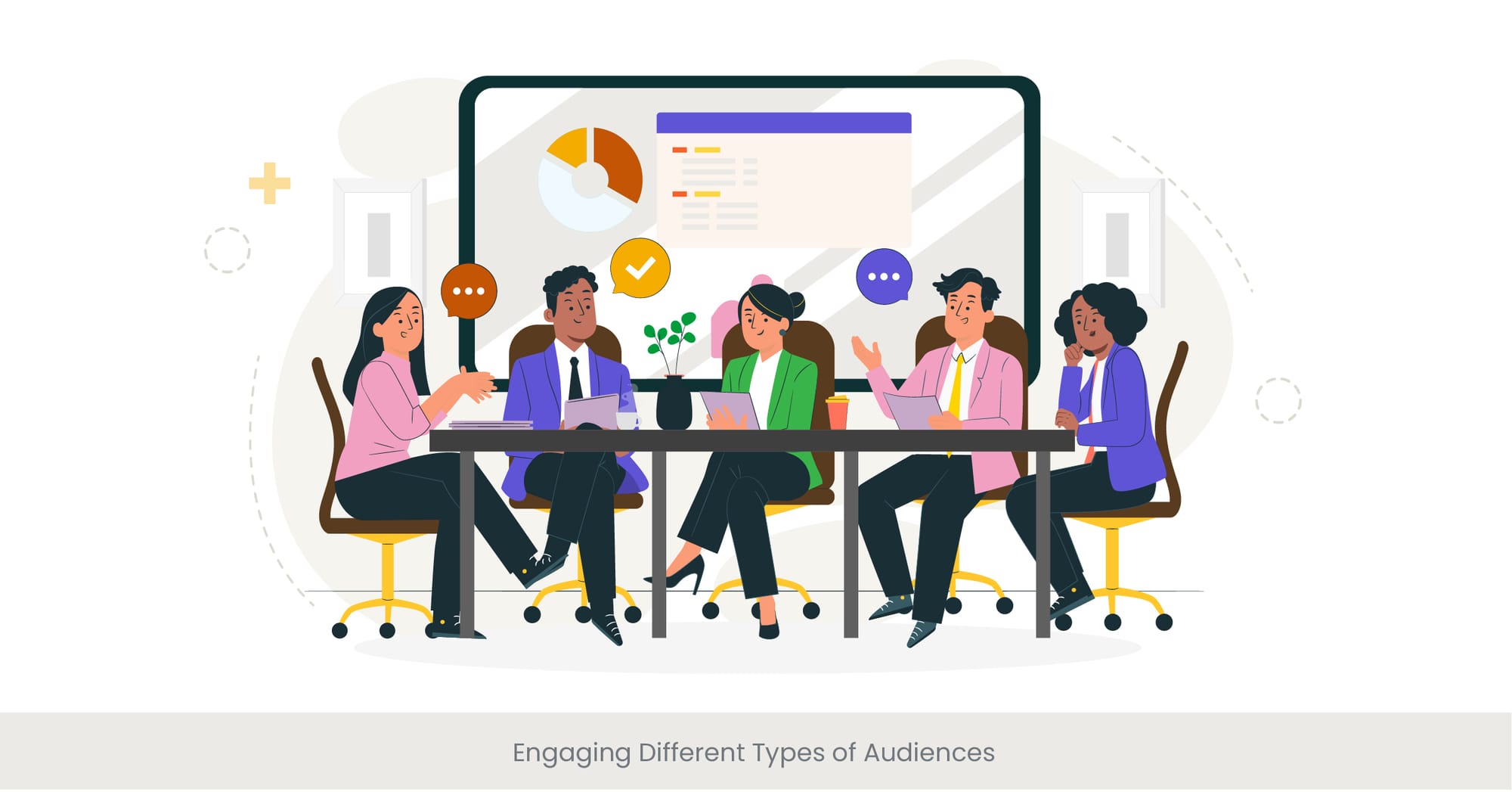
Understanding Your Audience: The Key to Effective Presentations
The effectiveness of keynote and conference presentations largely hinges on the speaker's ability to engage with their audience. However, audiences are not monolithic; they come from diverse backgrounds, possess varying levels of knowledge, and have different expectations. This section underscores the importance of audience analysis as a foundational step in preparing for any presentation. Tailoring your message and delivery style to match the audience's profile ensures that your presentation resonates with them, fostering engagement and comprehension.
Diverse Audiences, Diverse Strategies
Engaging different types of audiences requires an adaptable approach. Whether you're addressing industry experts at business conferences or a general audience at academic conferences, understanding the common interests, level of expertise, and what motivates your audience is crucial. For instance, technical jargon may be appropriate for a specialized audience but could alienate a general audience. This section explores strategies such as audience segmentation and personalized messaging to effectively connect with and engage various audience groups.
Real-World Engagement: Case Studies and Trends
To bring these concepts to life, consider the approach of seasoned speakers who excel in adapting their presentations based on their audience. For example, at TED conferences, speakers often employ a mix of humor, storytelling, and visuals to appeal to a broad audience, while maintaining depth and substance. Another case is academic conferences, where presenters may focus more on data and research findings, using technical language that resonates with an academic audience. These examples illustrate the importance of audience awareness and the use of tailored strategies to enhance engagement.
Audience Engagement: Insights and Evidence
The significance of engaging different types of audiences is backed by research. Studies suggest that audience-tailored messages are more likely to be persuasive and remembered. A review in the Journal of Marketing highlighted that presentations adapted to the audience's values and beliefs significantly increased engagement and message effectiveness. By integrating audience-specific insights and adapting your presentation accordingly, you can ensure that your message not only reaches your audience but also engages them effectively.
Utilizing Visual Aids in Conference Presentations
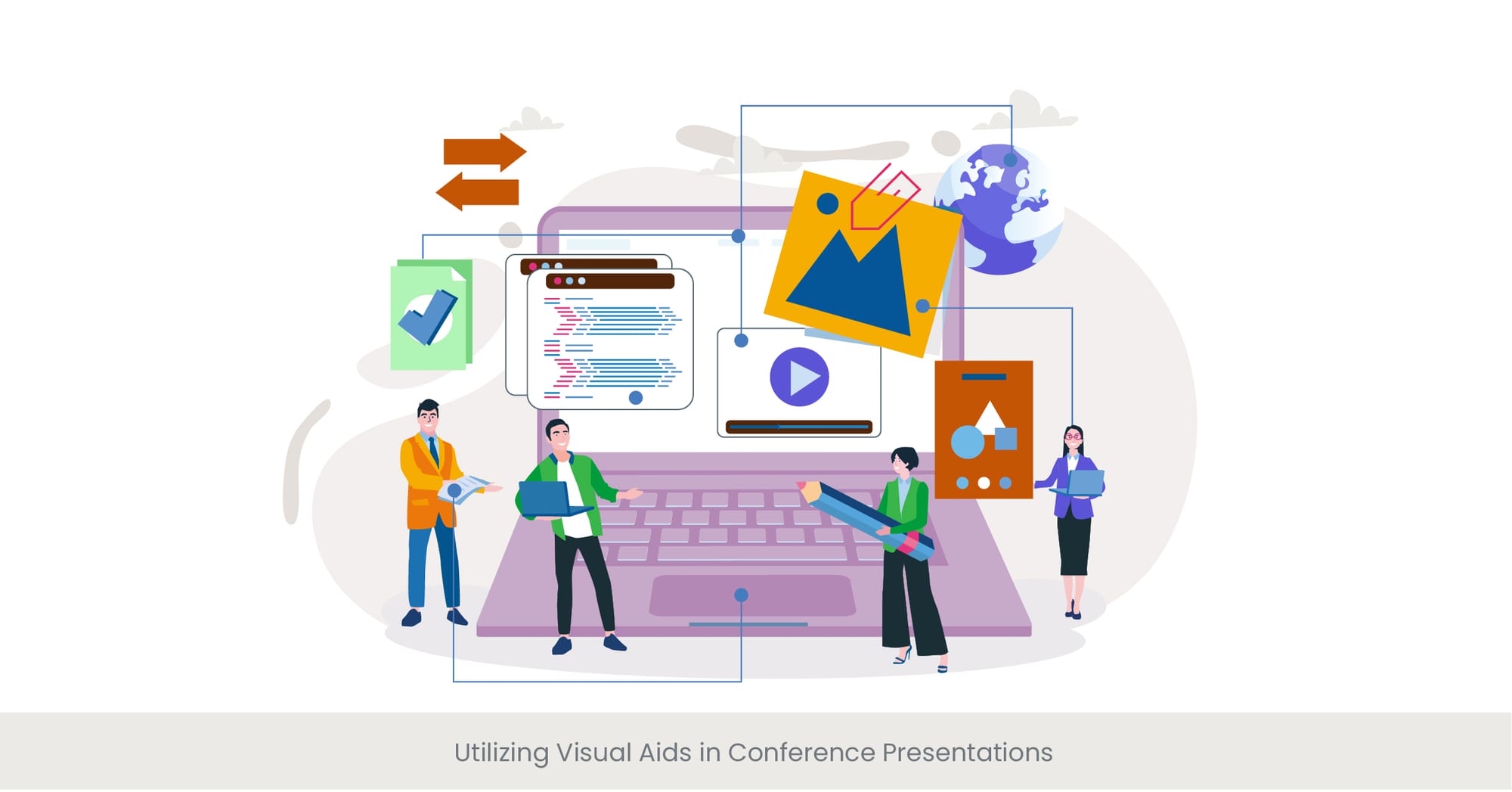
Enhancing Presentations with Visual Aids
Visual aids play a pivotal role in enhancing the effectiveness of keynote and conference presentations . They serve not only to illustrate and clarify complex ideas but also to engage the audience's attention and facilitate better understanding and retention of information. This section highlights the importance of carefully selecting and integrating visual aids into your presentation to support your message and objectives, ensuring they add value rather than distract or overwhelm.
The Art of Visual Communication
Choosing the right visual aids involves more than just adding images or slides; it requires a thoughtful approach to visual communication. Whether it's presentation templates, conference PowerPoint slides, or diagrams or engaging infographics, each visual element must be purposefully designed to complement and reinforce your narrative. This part delves into the principles of effective visual design, including simplicity, consistency, and relevance, guiding speakers on how to create visuals that resonate with their audience and enhance the overall impact of their presentation.
Real-World Impact: Visual Aids in Action
In practice, successful speakers utilize visual aids to bring their presentations to life. From Steve Jobs' iconic keynote presentations, which masterfully combined minimalistic slides with powerful imagery, to the use of engaging videos and animations in TED Talks, these examples demonstrate the transformative power of visuals. By examining these case studies, presenters can glean insights into how effective visual aids can significantly amplify the message and engage the audience, making complex concepts more accessible and memorable.
Validating Visuals: Research and Recommendations
The effectiveness of visual aids in presentations is well-supported by research. Studies have shown that people are more likely to remember information presented with relevant visuals compared to text alone. For instance, the Picture Superiority Effect, a principle in cognitive psychology, suggests that images are more likely to be remembered than words. Moreover, incorporating visuals into presentations has been proven to increase audience engagement and retention, making them a critical component of successful conference and keynote presentations.
Strategies for Memorable Closing Remarks
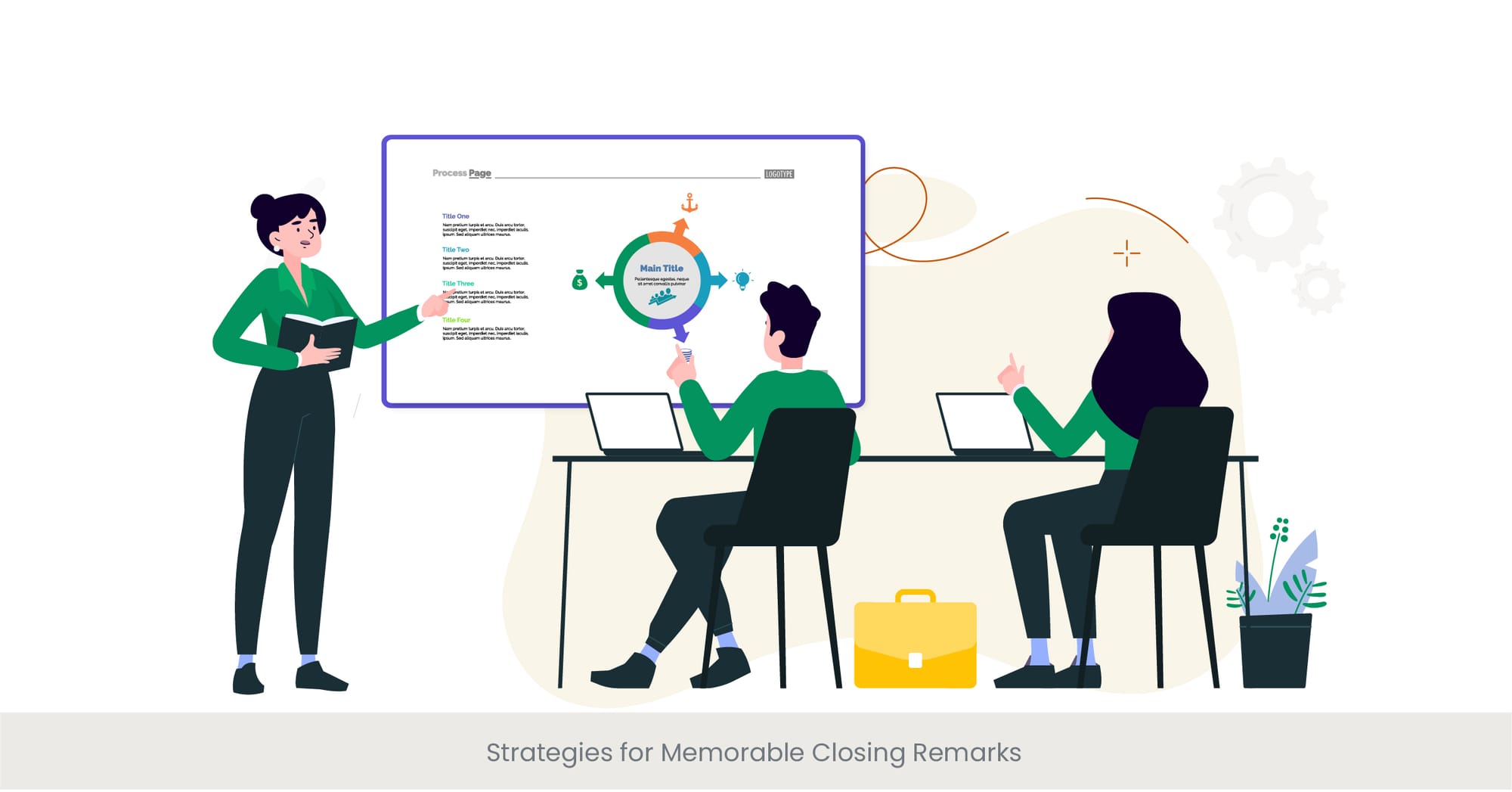
Crafting the Perfect Conclusion
The conclusion of a keynote or conference presentation is your final opportunity to leave a lasting impression on your audience. Memorable closing remarks can reinforce your message, encourage action, and ensure your presentation resonates long after it has ended. This section focuses on the strategies for crafting impactful conclusions that effectively summarize the session' key points and inspire your audience.
The Essence of a Powerful Close
A strong conclusion goes beyond merely summarizing the presentation; it connects back to the opening, reiterates the presentation tips main message, and leaves the audience with something to ponder or act upon. Whether it's a compelling quote, a thought-provoking question, or a call to action, the end of your presentation should feel like a satisfying resolution to the narrative you've built. This part explores the techniques for achieving such an ending, emphasizing the importance of coherence, emotional appeal, and relevance to the audience's interests and needs.
Illustrating Success: Memorable Conclusions in Practice
Examining real-world examples, such as the impactful closing remarks by speakers at various conferences, sheds light on the art of concluding a presentation effectively. For instance, Martin Luther King Jr.'s "I Have a Dream" speech is renowned not only for its powerful message but also for its unforgettable conclusion, which masterfully encapsulated the essence of his vision and inspired action. Similarly, in the business and academic worlds, successful speakers often conclude with a strong statement or a summary that reinforces the presentation's theme and motivates the audience toward a desired outcome.
Backing It Up: The Importance of Memorable Endings
Research underscores the significance of an effective conclusion. The serial position effect, a principle from psychology, suggests that individuals are likely to remember the first and last items in a series best (the primacy and recency effects, respectively). This highlights the critical role of closing remarks in ensuring your presentation's key messages are remembered. Studies in communication suggest that a well-crafted conclusion can enhance the persuasiveness of your presentation and significantly impact the audience's perception and recall of the information presented.
Preparing for High-Stakes Keynote Presentations
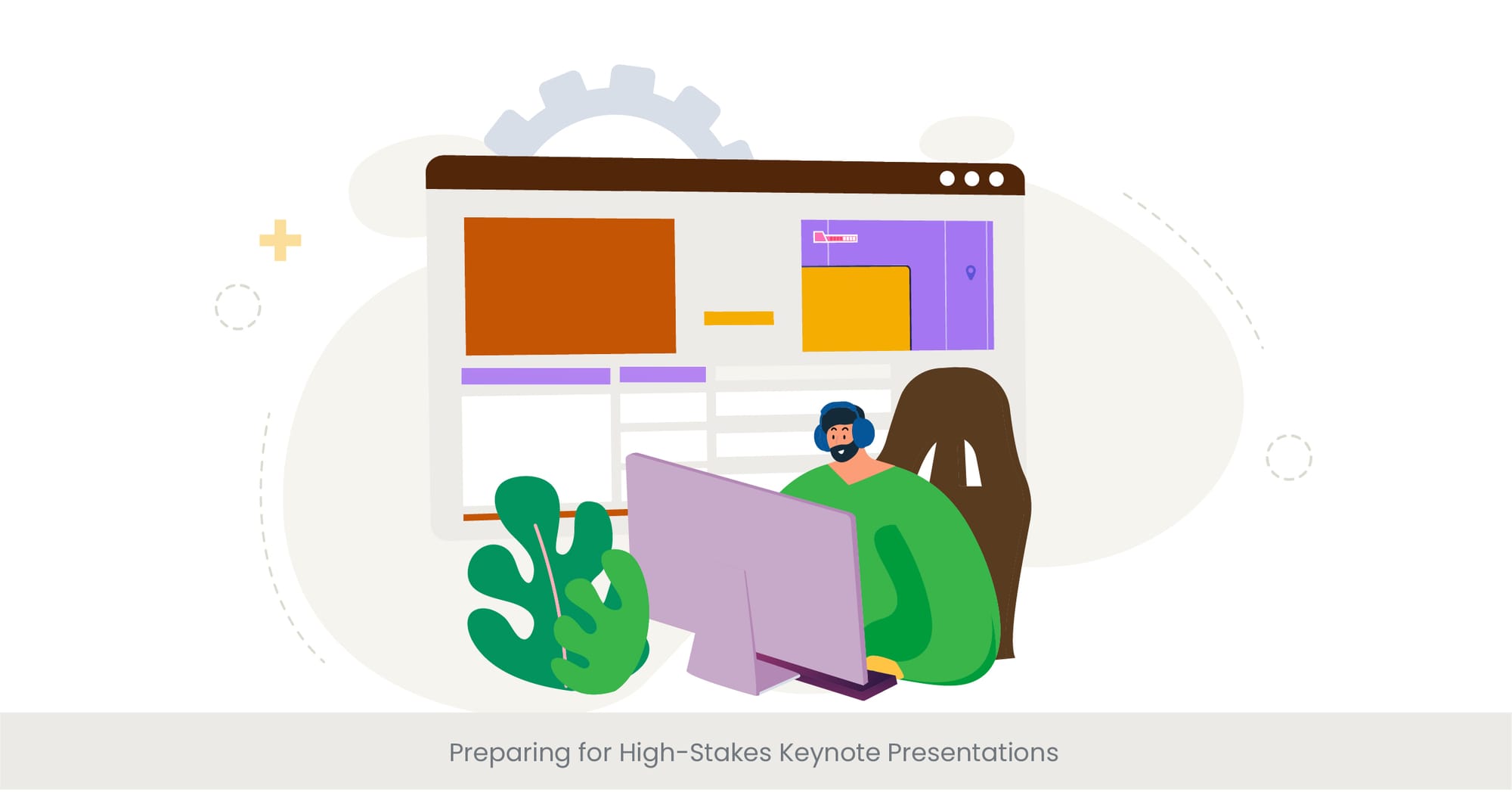
The Art of Preparation
High-stakes keynote presentations require meticulous preparation to ensure success. These are opportunities not only to share knowledge or insights but also to influence opinions, inspire change, and establish authority in your field. This section emphasizes the comprehensive approach needed for such presentations, covering everything from researching your topic and audience to rehearsing your delivery. The goal is to equip you with a roadmap for preparing presentations that captivate and resonate with your audience.
Foundational Elements of Effective Preparation
Effective preparation goes beyond content creation. It involves a deep understanding of your audience's expectations, the conference's theme, and how your message fits within that context. Additionally, it includes developing your narrative, selecting appropriate visual aids like conference PowerPoint templates or Google slides, and integrating storytelling elements to enhance engagement. This part provides insights into organizing your material, designing your own template and slides for clarity and impact, and crafting a narrative that weaves together your main points into a coherent and compelling story.
Case Studies: Preparation in Action
Successful keynote speakers often share their preparation routines, highlighting the significance of practice and audience analysis. For example, analyzing speeches from TED conferences reveals that the most impactful presentations are those where speakers have meticulously refined their messages, practiced their delivery to ensure clarity and impact, and tailored their content to engage both the audience in the room and a broader online audience. These examples serve as a testament to the power of thorough preparation in delivering presentations that leave a lasting impression.
Research-Backed Strategies for Preparation
The importance of preparation is further supported by research on effective communication and presentation skills . Studies have shown that audience engagement and message retention significantly improve when speakers are well-prepared, utilize engaging visuals, and deliver their content confidently. Furthermore, the practice has been linked to reduced public speaking anxiety, enhancing the speaker's ability to connect with the audience and convey their message effectively.
Handling Nerves and Building Confidence
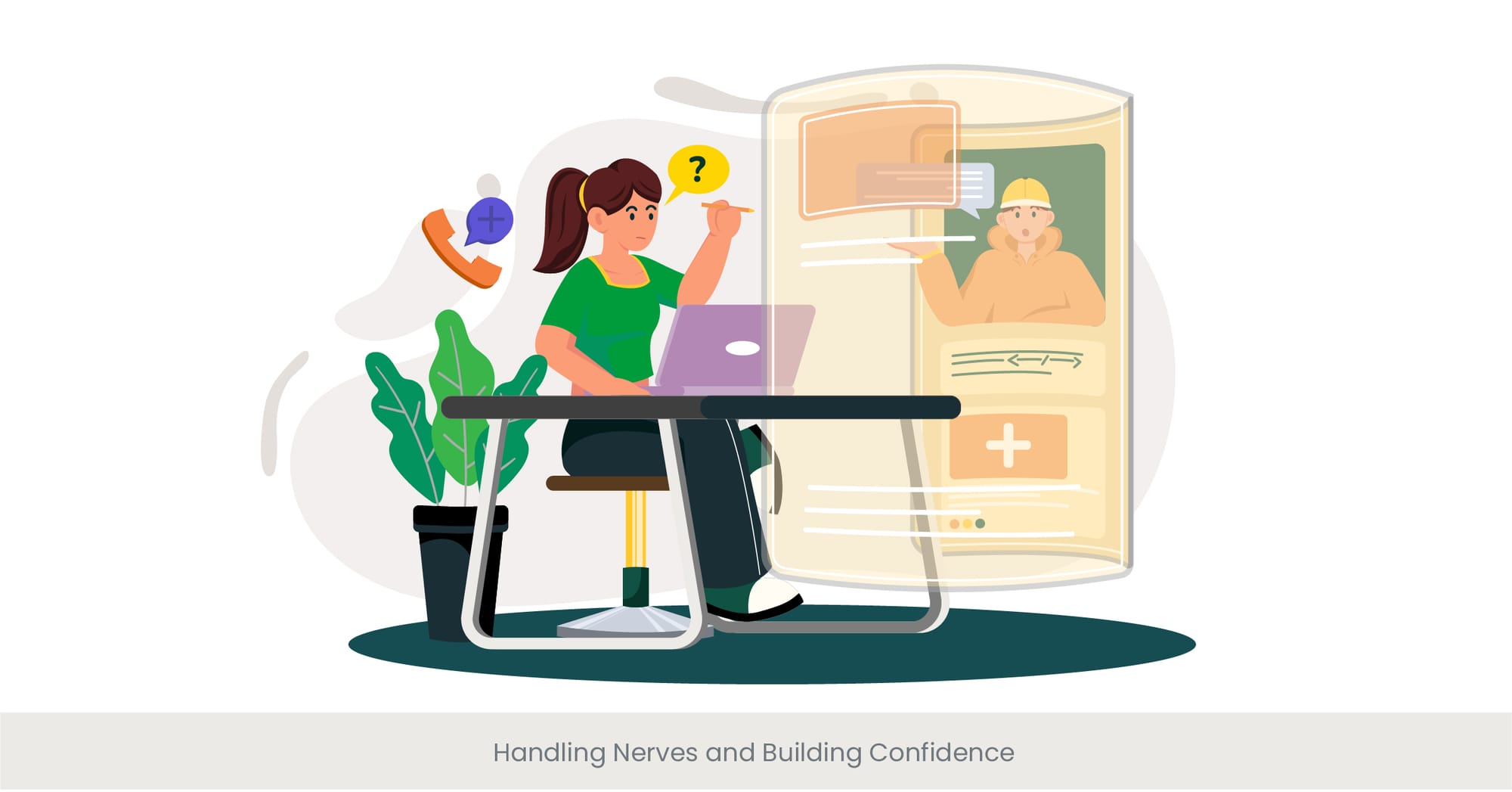
Mastering the Mindset for Public Speaking
Public speaking, particularly in the context of keynote and conference presentations , can be a daunting task, even for experienced speakers. Handling nerves and building confidence are crucial aspects of delivering a successful presentation. This section explores strategies for overcoming anxiety and fostering a confident presence on stage. Understanding that nerves are a natural response to high-stakes situations can help speakers channel this energy positively, enhancing their performance rather than hindering it.
Techniques for Overcoming Speaking Anxiety
There are several effective techniques to manage nerves and boost confidence before stepping onto the stage. Deep breathing exercises, visualization techniques, and positive affirmations can help calm the mind and reduce anxiety. Additionally, thorough preparation, including rehearsing your presentation multiple times and familiarizing yourself with the venue, can significantly alleviate stress. This part delves into these strategies, offering practical advice for speakers to feel more in control and confident during their presentations.
Real-World Examples: Confidence in Action
Drawing inspiration from seasoned speakers can provide valuable insights into managing nerves. For instance, many TED Talk presenters share their experiences of overcoming stage fright through rigorous preparation, mindfulness practices, and focusing on the message they want to convey rather than on their own fears. These stories illustrate that confidence is often the result of deliberate practice and mental preparation, emphasizing that even the most successful speakers have worked hard to master their public speaking fears.
Evidence-Based Approaches to Building Confidence
Research in the field of psychology offers evidence-based approaches to tackling public speaking anxiety. Studies suggest that exposure therapy, which involves gradually and repeatedly exposing oneself to the feared situation, can be effective in reducing fear of public speaking. Moreover, cognitive-behavioral strategies, such as challenging negative thoughts and practicing relaxation techniques, have been shown to improve confidence and performance in high-pressure situations like keynote presentations .
Feedback and Iteration for Presentation Improvement
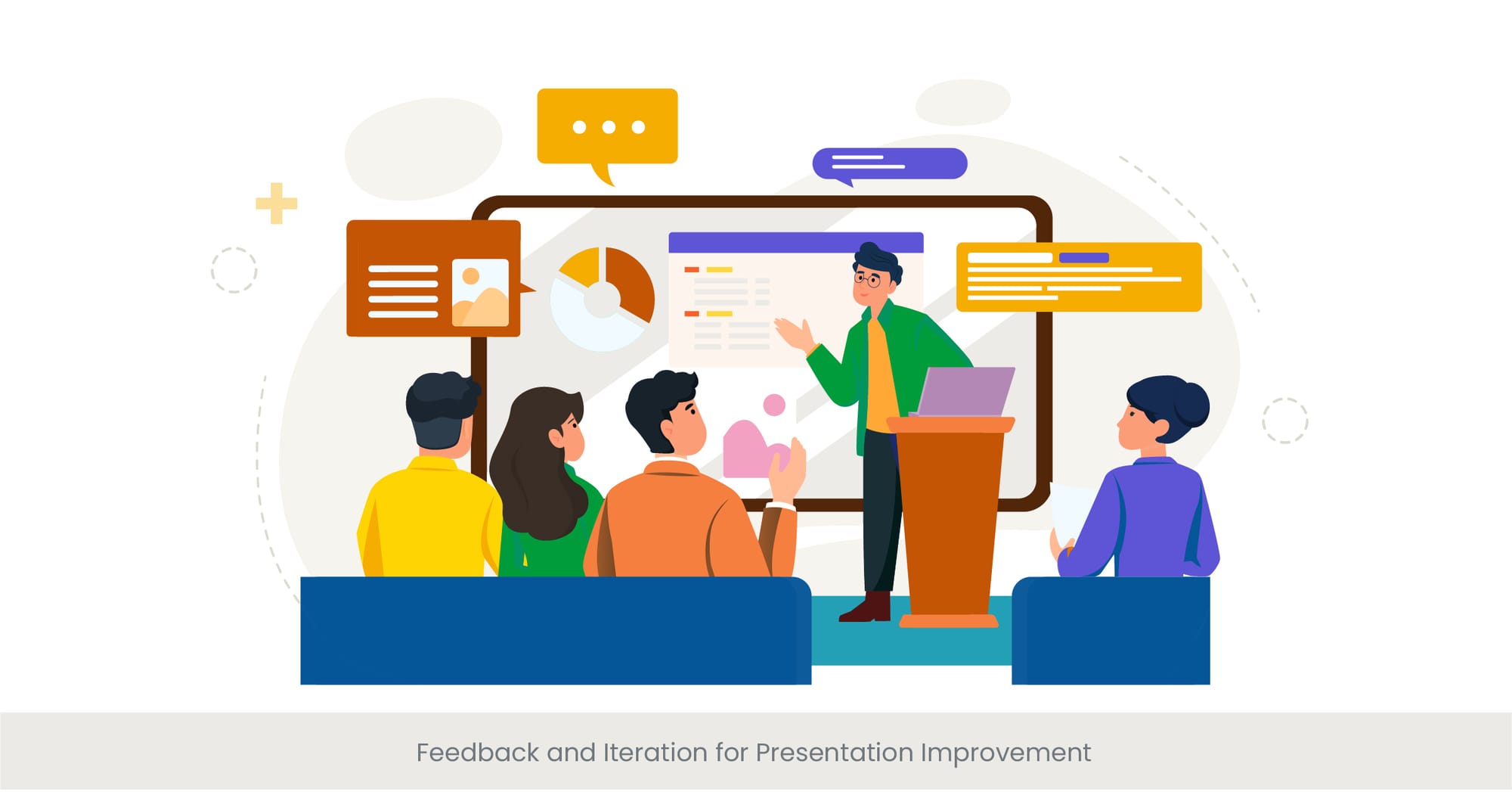
The Cycle of Continuous Improvement
Feedback and iteration play critical roles in refining keynote and conference presentations. This section emphasizes the value of constructive criticism and the iterative process in enhancing your speaking skills and presentation content. Incorporating feedback allows speakers to identify areas for improvement and adjust their approach, ensuring their presentations become more effective and engaging over time. This cycle of preparation, presentation, feedback, and revision is fundamental to mastering the art of public speaking.
Embracing Feedback for Growth
Seeking and embracing feedback, whether from peers, mentors, or audience evaluations, can provide invaluable insights into your presentation's strengths and weaknesses. Constructive criticism is not just about highlighting areas for improvement; it's also about recognizing what works well and should be retained or amplified in future presentations. This part explores strategies for collecting feedback, including post-presentation surveys, direct audience interaction, and professional coaching, offering guidance on how to interpret and act on the feedback received.
Real-World Application: Learning from Experience
Many renowned speakers attribute a significant part of their success to the feedback loop. For instance, after every keynote presentation , they analyze audience reactions, review recordings of their speeches, and seek direct feedback to identify areas for improvement. This continuous learning process enables them to adapt their content, refine their delivery, and better engage with their audiences in subsequent presentations. By highlighting these examples, this section illustrates the practical benefits of feedback and iteration in the context of public speaking.
The Impact of Iteration: Research Insights
Research supports the effectiveness of feedback and iterative practice in skill development, including public speaking. Studies in educational psychology have shown that iterative learning, characterized by repeated cycles of practice, feedback, and adjustment, leads to greater proficiency and confidence. This evidence underscores the importance of viewing each presentation as an opportunity to learn and grow, emphasizing that the path to becoming an accomplished speaker is a journey of continuous improvement.
Leveraging Social Media for Pre-Event Buzz
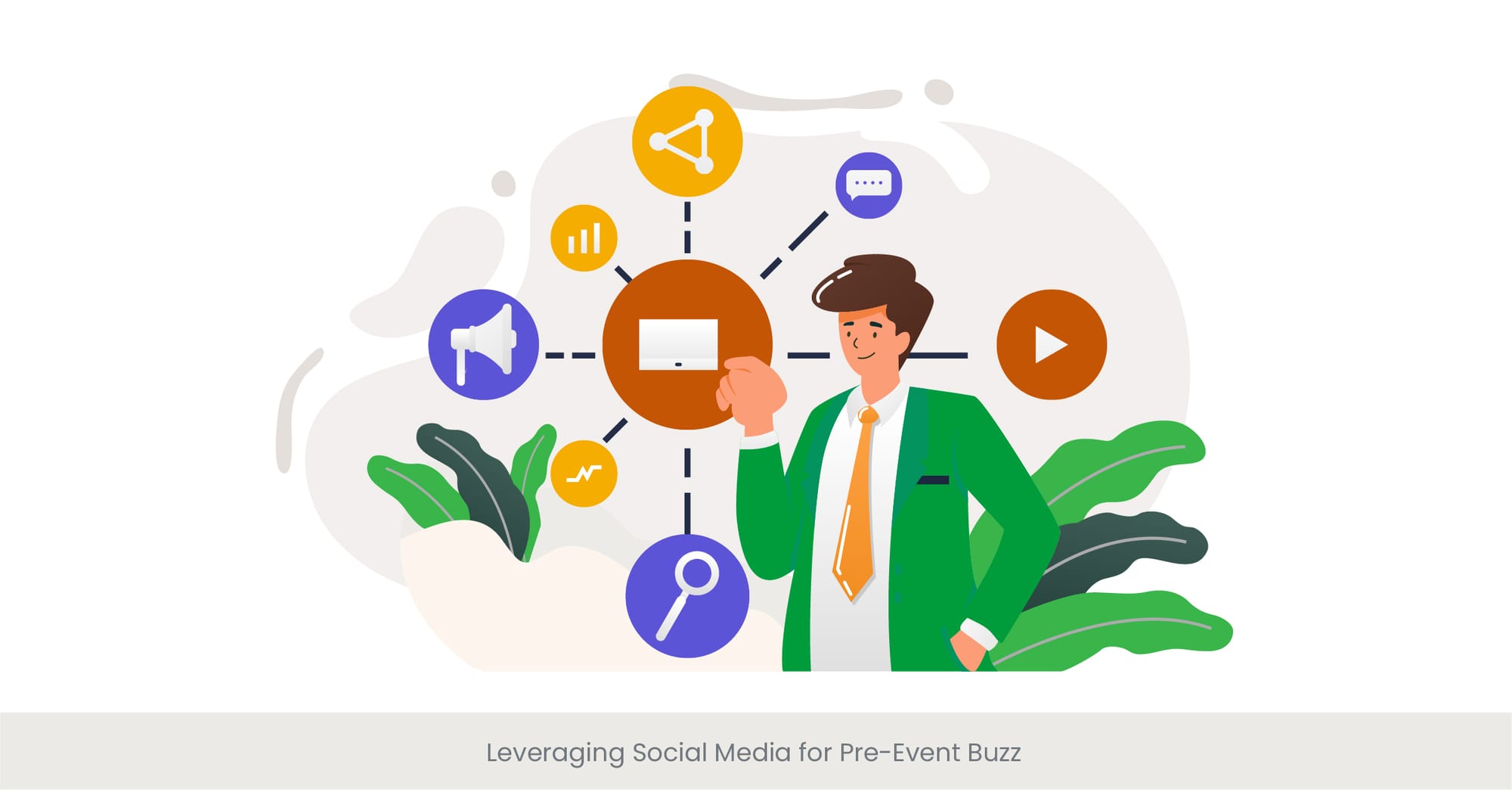
Creating Anticipation Through Digital Channels
In the digital age, leveraging social media has become a critical strategy for amplifying the reach and impact of keynote and conference presentations . This section explores how speakers and event organizers can create pre-event buzz, engaging potential attendees and expanding the audience beyond the physical venue. Utilizing platforms like Twitter, LinkedIn, and Instagram allows for the sharing of sneak peeks, key insights, and interactive content, building anticipation and driving interest in the upcoming presentation.
Strategies for Social Media Engagement
Effective social media engagement requires a strategic approach. This includes identifying the most relevant platforms for your target audience, crafting compelling content that reflects your audience follow the theme of your presentation, and encouraging interaction through questions and discussions. Additionally, using hashtags, live videos, and stories can enhance visibility and engagement. This part provides a roadmap for utilizing social media to not only generate buzz but also establish a connection with your audience before the event even begins.
Success Stories: Social Media in Action
Examples of successful pre-event social media campaigns demonstrate the power of digital engagement. For instance, conferences like SXSW and TEDx extensively use social media to tease topics, highlight speakers, and share content related to their events, significantly increasing reach and engagement. These case studies showcase innovative ways to use social media, from behind-the-scenes glimpses to interactive Q&A sessions, illustrating how these tactics can create a sense of community and anticipation around an event.
The Impact of Social Media: Evidence and Insights
Research highlights the effectiveness of social media in event promotion and engagement . A study published in the Journal of Marketing Research found that social media buzz can significantly influence event attendance and audience engagement, suggesting that digital engagement strategies can complement traditional marketing efforts. By leveraging the power of social media, speakers and event organizers can not only generate interest in their presentations but also enhance the overall event experience.
Analyzing Impactful Keynote Presentations

Decoding the DNA of Memorable Speeches
Understanding what makes certain keynote presentations stand out and resonate long after the event has concluded is crucial for any speaker aiming to make an impact. This section delves into the analysis of impactful keynote presentations, exploring the common elements that contribute to their success. By dissecting memorable speeches, we can uncover the techniques and strategies that make them effective, providing valuable lessons for future presentations.
Key Components of Successful Presentations
An impactful keynote presentation often combines compelling storytelling, clear and persuasive communication, effective use of visuals, and a strong connection with the audience. Additionally, the ability to convey complex ideas in an accessible and engaging manner is a hallmark of successful presentations. This part examines these components in detail, drawing on examples from renowned speeches that have left a lasting mark on their audiences.
Learning from the Masters
Analyzing keynote presentations by speakers such as Steve Jobs, Brené Brown, or Sir Ken Robinson offers insights into the art of captivating an audience. These speakers excel in engaging their listeners through personal anecdotes, humor, and a deep understanding of their subject matter. By studying their techniques, such as the strategic use of pauses, variations in tone, and audience interaction, speakers can glean valuable strategies for enhancing their own presentations.
Research and Recommendations for Impactful Presentations
Research on communication and psychology provides evidence-based recommendations for creating impactful presentations . For example, studies emphasize the importance of storytelling and emotional appeal in enhancing audience engagement and retention of information. Furthermore, the effective integration of visual aids and the importance of rehearsing to refine delivery are also supported by academic findings. This section highlights key research insights and offers actionable advice for speakers aiming to make their keynote presentations more impactful.
FAQs on Keynote and Conference Presentations
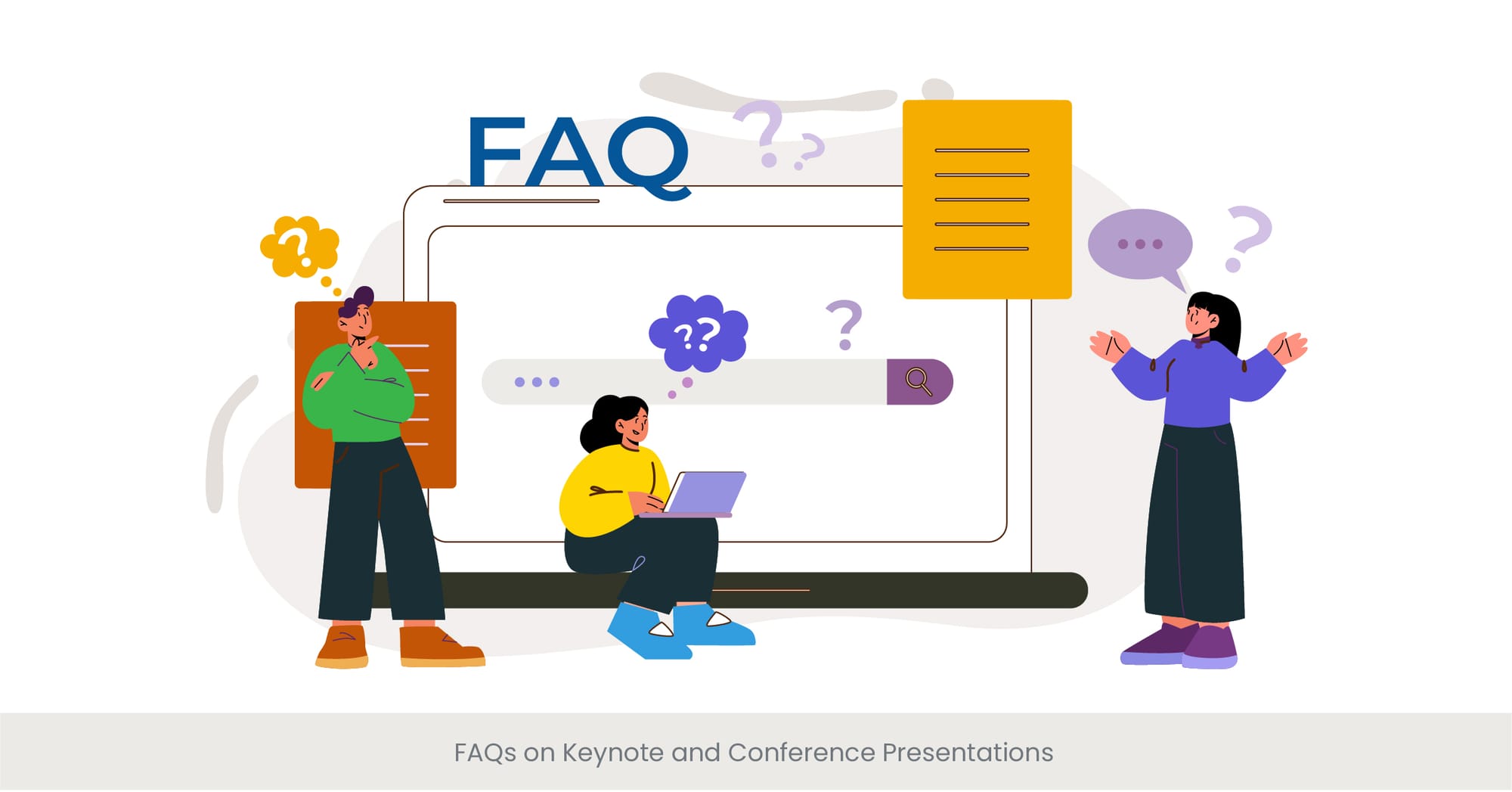
What is a Keynote Presentation?
A keynote presentation serves as the cornerstone of a conference, setting the tone and theme for the event. It's typically delivered by a prominent speaker who can inspire and engage the audience, offering valuable insights related to the next conference call's core topic.
What is the difference between PowerPoint and Keynote presentations?
PowerPoint, a product of Microsoft, and Keynote, developed by Apple, are both presentation software but differ in user interface, design templates, and functionalities. While PowerPoint is widely used across various platforms, Keynote is known for its advanced graphic capabilities and is primarily used on Apple devices.
How do you make a good Keynote presentation?
Creating a compelling keynote presentation involves clear articulation of your message, integrating storytelling, utilizing engaging visuals, and practicing your delivery. Tailoring the content to your audience's interests and expectations is also key to making your presentation resonate.
Is Keynote presentation free?
Keynote is available to download for free on Apple devices, including Mac, iPad, and iPhone, offering a suite of design tools and templates to create engaging presentations.
What is an oral presentation at a conference?
An oral presentation at a conference involves delivering your research findings, project updates, or expert insights to an audience, typically accompanied by visual aids such as slides. It's a platform for sharing knowledge and fostering academic or professional discussions.
How do you present an oral paper in a conference?
Presenting an oral paper involves summarizing your research or paper's key points, explaining the methodology, results, and conclusions, and highlighting the significance of your findings. Engaging the audience with clear explanations and visual aids is crucial for an effective presentation.
What are the 4 types of oral presentation?
The four types include informative, demonstrative, persuasive, and inspirational presentations, each serving different purposes, from educating the audience about a whole idea or specific topic to motivating them towards certain actions or changes.
How do you present a conference presentation?
Effective conference presentations require a well-organized structure, engaging content, clear visuals, and confident delivery. Engaging your audience with questions, interactive elements, and compelling storytelling can enhance the impact of your presentation.
What is the 5 golden rule of PowerPoint presentation?
The five golden rules include keeping slides simple and uncluttered, using visuals to complement your message, limiting bullet points, charts and text, practicing consistent design, and rehearsing your delivery to ensure a smooth presentation.
How many slides should a conference presentation have?
The number of slides should align with the presentation's length, aiming for a balance that allows you to convey your message effectively without rushing or overloading the audience. A common guideline for slide amount is one slide per minute of presentation time.
What is the first slide of a conference presentation?
The first slide typically includes the presentation's title, the speaker's name, and their affiliation, setting the stage for the audience by introducing the topic and the speaker.
How do you present a press conference?
Presenting at a press conference involves preparing a statement or announcement, addressing the media's questions, and delivering your message clearly and concisely. Engaging with the media positively and professionally is key to effectively conveying your information.
What do you say at the beginning of a press conference?
The beginning of a press conference usually starts with a greeting, followed by an introduction of the topic or purpose of the conference, thanking attendees for their presence, and outlining what will be discussed during allocated time.
What is press conference examples?
Press conference examples include product launches, crisis management responses, policy announcements by government officials, or any event where organizations or individuals aim to communicate directly with the media.
What are the do's and don'ts of press conference?
Do's include preparing thoroughly, being clear and concise, staying on message, and engaging respectfully with the media. Don'ts include avoiding questions, providing misleading information, or being confrontational.
Discover how we can create magic in your communication
%20(1).jpg)
The Future of Event Presentations
Looking Ahead: The Future of Event Presentations
Embracing a New Era of Engagement The landscape of event presentations is undergoing a remarkable transformation, propelled by technological innovation and shifting audience expectations. As we look to the future, it's clear that the traditional paradigms of presenting are evolving towards more dynamic, interactive, and immersive experiences. This
Product Launch Presentation Strategies
Synthesizing Strategies for Effective Product Launch Presentations
Comprehensive Planning for Product Launch Success The Blueprint for a Triumph: Navigating the Maze of Product Launch Planning In the intricate dance of launching a new product, comprehensive planning stands as the foundational step that determines the rhythm of success. The art of orchestrating a product launch event presentation begins
Accelerating Interest in Bike Launches with Dynamic Presentations
Market Trends and Consumer Insights for Bike Launches The Pulse of the Cycling World: Riding the Wave of Market Trends Understanding the current market trends and consumer insights is crucial for any bike launch. As more people are increasingly seek out sustainable and healthy modes of transport, the demand for
- Conferences
- Exhibitions / Fairs
- Career Advice
- Study Advice
- Study Abroad
- Work Abroad
- 📖 Directory
All Categories
- Digitization
- All Economics and Social Sciences
- Biochemistry
- Agricultural Science
- Neuroscience
- Biomedical Engineering
- Molecular Biology
- Cell Biology
- Microbiology
- Bioinformatics / Computational
- All Life Sciences
- Aerospace Engineering
- Automotive Engineering
- Architectual Engineering
- Chemical Engineering
- Civil Engineering
- Construction Engineering
- Electrical & Electronics Engineering
- Engineering Design
- Environmental & Energy Engineering
- Geo & Agricultural Engineering
- Industrial Engineering
- Manufacturing Engineering
- Materials & Metallurgical Engineering
- Mechanical Engineering
- Mechatronics & Robotics
- Mining & Minerals Engineering
- Process & Logistics Engineering
- Project Engineering
- Quality Engineering
- Safety & Systems Engineering
- Structural Engineering
- Engineering & Business
- General Engineering
- All Engineering
- Computer Science
- Software Development
- All IT/Software Engineering
- All Tech & Engineering
- Biomedicine
- Biotech / Biomedical Engineering
- Public Health
- Human Medicine
- Physiotherapy
- Veterinary Medicine
- Dietetics / Nutrition
- Oncology / Cancer Research
- Clinical Medicine
- All Medicine & Health
- Mathematics
- Earth Science
- Materials Science
- All Physical Science & Mathematics
- Art & Art History
- Cultural Studies
- Communications & Design
- Media Studies
- Dance, Theatre & Film Studies
- Applied Linguistics
- Computational & Quantitative Linguistics
- Neurolinguistics
- Cognitive Linguistics
- Psycholinguistics
- Sociolinguistics
- Historical Linguistics
- Ethnolinguistics/Anthropological Linguistics
- Dialectology
- Philosophy of Language
- Other/General Linguistics
- All Language Studies & Linguistics
- Literature & Creative Writing
- Archaeology
- Theology & Religeous Studies
- Sociology & Anthropology
- All Art & Humanities
All Disciplines
- All Conferences
- All Workshops
- All Exhibitions / Fairs
- All 📖 Directory

A Guide to Conference Presentations
Read a summary or generate practice questions using the INOMICS AI tool
Giving a presentation at an academic conference can be both stressful and rewarding. While it's incredibly helpful to get feedback and insights on your project from other researchers in your field, it can also be intimidating to hold your work up for scrutiny from others.
Today we're going to share some tips for making your conference presentations as compelling and distinctive as possible, as well as some tips for dealing with conference day nerves and the post-presentation discussion.
Don't make your audience sit through an uninspired, generic presentation – instead, try to focus on your unique insights and let other conference attendees see your enthusiasm and commitment to your subject. Enthusiasm on the part of the presenter goes an awfully long way to making a presentation more exciting to watch!
Here are our tips for improving your conference presentation.
- Titling your presentation
- How to use slides
- Personable or professional?
- Pitching your voice
- Moving around
- Dealing with nerves
- Post-presentation questions
Download the Conference Monkey Directory - 6 Month Conference List
Give your presentation a fun title
Cute, funny, or pun-based titles are not for everyone, but if you like the idea then it's fine to use a jokey title for your presentation. If that's not your style, then try to pick a title which conveys the interesting big-picture ideas that you'll be discussing, rather than the fine grain details. This helps people from outside your sub-field to know what your talk is about. For example, 'Queen Bee: Social Structures of Hive Species' sounds much more interesting to a non-expert than 'Scent-based communication among hymenoptera'.
Use simple, clear slides
The quickest way to turn your presentation from something interesting to something dragging and dull is by throwing loads of text onto your slides. Whenever you put up a new slide, your audience will stop listening to your speech for a moment while they read the very salient text you've put in front of them. If your slides have long paragraphs on them, then the audience will take several minutes reading the information and not hearing what you're saying during that time.
Counter this problem by using a smaller number of slides – no more than 1 slide per minute of talking, and no more than 25-30 slides in total – and by streamlining each slide as much as possible. If you've spent a lot of time in academia, you've probably become very used to presentations with hundreds of bland, text-heavy slides that distract from the presenter rather than supporting them. But just because this is common, doesn't mean it's the right way to present! Remember, the audience is supposed to absorb information from your talk, not from reading hundreds of slides. Your slides should be minimal, with no more than a few bullet points or keywords on each slide.
A slide doesn't need to fit all of your information on it, as you can give all the relevant details in your talk. The slide should be merely a guideline for what you are discussing. A good slide might have just three keywords on it, which you will discuss in detail. By getting rid of extraneous information, you make it easier for your audience to follow your talk and engage with your points.
Try to cut down your slides as much as you possibly can. Also, try to use illustrations, graphics, or graphs wherever possible to convey information in a visual way. If you're worried about forgetting what you were going to say, then use the notes feature which allows you to add notes which are only visible to the presenter to each slide. This way, you can see the information you need but your audience doesn't get distracted by all the extra text.
You could also try something different: instead of the usual PowerPoint or Keynote, you could try an alternative presentation software such as Prezi, or even consider getting rid of slides altogether if you are a very confident speaker.
Make your presentation more personable
Here's something that many presenters forget: it's okay for your presentation to be a bit personal. You can smile, crack a joke, or refer to examples from your real life to convey your point. Of course, you want to remain professional and not to be too silly or inappropriate. But you needn't be robotic or totally flat. In fact, it's much harder for an audience to engage with a presenter who speaks in a monotone and never injects a moment of levity into their speech.
To get better at this, try to remember to look at your audience when presenting. It can help to have a supportive friend or colleague in the audience who you can look to when you need someone to smile at. Also, feel free to emphasise your points by using hand gestures or by pointing to important information. You needn't stand with your hands pinned to your sides through the whole talk. You can rest your hands on the podium if you have one, or walk back and forth across the stage if you're using a microphone attached to your clothing. You can also emphasise findings that you personally found to be especially interesting, or talk about a finding which took you by surprise. This personal touch will make your presentation more distinctive to you and therefore more memorable.
Pitch your voice at the appropriate volume and speed
This one might sound silly – does it really matter how you speak in a presentation, as long as your materials are good? In fact, yes it does. If your voice is too quiet, your audience will have to strain to hear you, which is tiring for them and makes them much more likely to switch off. Conversely, if your voice is too loud it can be almost painful to listen to. Try to pay attention to the volume of your voice, and remember that most people tend to be too quiet, so you should lean towards speaking a little louder.
Similarly, many people don't realise how fast they speak, especially if they are a bit nervous. Speaking too fast causes several problems: firstly, people will not be able to hear each sentence and might get lost, and secondly, they won't have time to think about your point and consider it before you've moved onto the next point. Conversely, as we all remember from school, there's nothing more boring than having to listen to someone with a slow, droning voice. If in doubt, try giving a practice presentation to friends or colleagues and ask them for feedback.
Feel free to move around
You needn't force yourself to stand stock still while presenting. In fact, it will make your presentation more engaging if you use the same facial expressions and gestures that you would if you were talking to a friend. While it's not a good idea to bounce around and move very fast, as this can be distracting, it is fine to walk around a little, to use your hands to indicate as well as or instead of a laser pointer, or to use your hands to emphasise particular points. Try to use movements that feel natural to you instead of standing totally still, as this will make your talk more dynamic and personal.
Above all, try to relax, and this will help your presentation to be smoother and more natural, which will be appreciated by your audience. And on that subject...
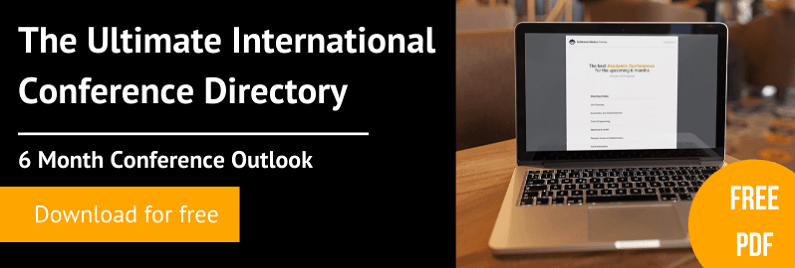
How to deal with nerves when making a presentation
Make sure you're prepared in advance.
The very best way to keep your nerves under control is to have practised your entire presentation from beginning to end beforehand, at least once. A few days before your presentation, recruit a friend or two to sit with you and be your audience. You can practise in an empty lecture hall or classroom if one is available and if that will help you to feel more comfortable. But it's also fine to practise at your house, or even in a cafe or bar if you bring a laptop with you. Run through your whole presentation, including slides, and take note of any areas where you struggled to find the right words or weren't sure what topic to speak on next. That way, you can know which specific topics or slide you need to remind yourself of.
However, it's important not to over-rehearse. You don't need to have your entire presentation memorised, and in fact doing so will only make your presenting style appear stilted and unnatural. You should be familiar with the material you're presenting (and if your presentation is about your research, you are likely to already be as familiar with the material as you need to be), and be able to anticipate some questions or criticisms that your audience might have. But remember that you are already an expert in this area – hence why you're presenting on it at a conference. There's no need to attempt to cram lots of extra information into your brain the day before a presentation; rather, let the knowledge that you already have guide you in how you present.
Make sure the IT equipment works beforehand
One issue that is almost bound to arise when you present, and can be very stressful, is problems with the computer, projector, or slides which you have prepared. Between different file formats, different laptop adaptors, and the difficulty in getting video or sound effects to work correctly in your presentation space, there is a lot that can go wrong.
The best way to deal with this is to make sure you've tested out all of the equipment earlier in the day before your presentation. Don't wait until 10 minutes before you begin in order to test! If there are problems, you need to know earlier so that you can find the correct adaptor, get help from IT support , and so on. If you're presenting in the afternoon, find a time in the morning at which you can test. If you're presenting in the morning, arrive very early, or consider testing the day before. That way you won't have any last-minute technical problems to deal with.
Tips for dealing with nerves while you're speaking
It's common to feel flustered, hyper-vigilant, or a bit overwhelmed when you start to present. The best solution for this is to give yourself the opportunity to take a few seconds to get yourself together. A good way of achieving this is to have a bottle of water in front of you – if you feel yourself getting overwhelmed, stop talking and have a drink of water and take a deep breath before you continue. It might feel to you as if you are standing in front of everyone and doing nothing for ages, but don't worry, it's only a few seconds and won't feel that long to the audience.
Another common problem is feeling like you don't know where to put your hands, or what to do with your body. If there is a lectern or podium in front of you, then make use of it – rest your hands on either side and grip it gently, which will help to make you feel grounded. If there's no lectern, then a good tip is to gently squeeze together your thumb and index finger while you're speaking; this pressure will help as an outlet for your nervousness which your audience won't notice.
Finally, one great way to reassure yourself during a presentation is to find a friendly face in the audience who you can can look to when you're feeling unsure. If possible, ask a friend or colleague to come along, and catch their eye when you need to. Otherwise, pick an audience member who seems open and friendly and look at them – the point is to think of your audience as a collection of friendly people, rather than as a singular scary judging entity.
When you can keep your nerves under control, your presentation will be more fun for you and more engaging for your audience.
Answering questions after a conference presentation
Even when you've spent a lot of time preparing your conference presentation and trying new presentation tools, there is one aspect of presenting that intimidates many people: answering questions during or after the presentation. At its best, a question and answer session can give you valuable new ideas about your research and help you to anticipate what kind of reviewers' comments you might receive when you publish your work. At worst, a question session can feel like a whole room full of people aggressively criticising your work and pointing out its flaws.
There are, of course, a few things you can do to make audience participation run a little more smoothly.
Keep the discussion to the end of the presentation
Depending on the type of presentation you are giving, generally you should expect questions to come at the end after you have finished presenting. If you are presenting in a workshop or in a teaching session, then there may be clarifying questions asked during your talk too. If someone asks a quick question during your presentation – such as asking you to explain an acronym or to define a term – then you should pause to answer them. But if someone starts to ask a more conceptual or complex question, it's fine to tell the audience to save their questions until the end.
Be prepared
The best way that you can feel more comfortable when fielding questions is to be prepared in advance. While you can't know exactly what will be asked at any given presentation, you can make some educated guesses about the kind of topics that are likely to come up. If there is a point in your presentation that you know is unclear – for example, if you used a highly complex experimental methodology or statistical analysis and you didn't have time to explain it fully during the presentation – then it's likely that someone will ask about this. Also, you can expect typical questions about what your plans are for the next stage in our research, or about how you interpreted your results.
Knowing the topics that are likely to be asked about, you can prepared yourself in advance. One great tip is to prepare extra slides with more information about your methodology or with more data to illustrate your points. When someone asks about an issue that you didn't have time to cover, you can bring up the relevant extra slide and talk them through it. You should also think of a couple of key points that you would use to answer questions about your next project or about the interpretation of your results.
Ignore the rambling and focus on the question
Often times, when people ask questions they may ramble somewhat before getting to the point. Asking questions can be intimidating for the questioner too, so sometimes this comes simply from nervousness. At other times, professors who are used to holding a floor may talk for some time as a preamble to the question. Hopefully, you have a moderator who will encourage the questioners to keep their comments brief.
But if you are confronted with a rambler, then don't panic. You don't need to respond to every single one of their points. Instead, try to sum up the essential gist of their comments and respond briefly to the topic as a whole. You can even clarify their question before responding, by saying “If I'm hearing you right, what you are asking is...” If the questioner has brought up a lot of different topics, then simply pick the one topic that is most relevant to your presentation and respond to that.
It's okay to say that you don't know
Something that often makes presenters nervous, especially if they are new to presenting, is the idea that someone might ask a question which you are unable to answer. Someone could ask for a particular factual piece of information that you don't have, or they could ask you about a specific paper which you have not heard of or have not read. If this happens, you needn't berate yourself or try to make up an answer off the cuff. It is perfectly okay to say that you don't know the answer to that question but you will look it up, or that you haven't seen the paper in question but that you will read it afterwards. You can also offer to discuss the topic further with the questioner after the session is finished.
Don't be concerned that this will make you look incompetent. In fact, being honest about the limitations of your knowledge is one of the marks of a honest and knowledgable researcher and your audience will respect you for it.
Top Blog Posts to Read:
What's the difference between a conference, a seminar, a workshop and a symposium?
How to Organise a Conference
8 Benefits of Attending Conferences
What Should Women Wear to Academic Conferences?
What Should Men Wear To Academic Conferences?
A Guide to Asking Good Questions at Conferences
How To Improve Your Public Speaking
How to Get Accepted to an Academic Conference
The Most Embarrassing Moments at Conferences
10 Best Jokes Heard at Conferences
Currently trending in Russia
- (Partially Online)
- Posted 2 days ago
The 23rd International Conference of the Japan Economic Policy Association
- presentation
- academic conference
Related Items

2024 Asia-Pacific Conference on Economics and Finance ‘LIVE’ (APEF 2024)
13th labs international banking workshop "banking in emerging markets: challenges and opportunities", featured announcements, innsbruck winter summit - (un)ethical behavior in markets, 2024 international conference in finance, accounting and banking …, call for papers: emanes annual conference 2024, 36th rsep international conference on economics, finance and business, rsep & srh dresden school of management international conference on…, mirdec 23rd barcelona 2024 conference, upcoming deadlines.
- Aug 23, 2024 RSEP & SRH Dresden School of Management International Conference on Economics, Finance and Business
INOMICS AI Tools
The INOMICS AI can generate an article summary or practice questions related to the content of this article. Try it now!
An error occured
Please try again later.
3 Practical questions, generated by our AI model
For more questions on economics study topics, with practice quizzes and detailed answer explanations, check out the INOMICS Study Guides.
Login to your account
Email Address
Forgot your password? Click here.
Dr. Heidi Toivonen
Psychologist
How to Give a Good Conference Presentation
Are you preparing to give your first talk at a scientific conference? Or perhaps you are a more seasoned scholar wishing to polish your presentation skills? In this blog post, I give some pointers on how to give a good conference presentation. In all honesty, I also share some opinions on what not to do in case you don`t want your audience to loll into sweet daydreaming or leave your talk with a heightened blood pressure.
This post is mainly attuned to the Covid-reality of Zoom-congresses and inspired by my summer spent in conferences of three different disciplines -psychology, information systems, and literary studies. Keep in mind that as this is my personal website, this is not a comprehensive all-inclusive guide to the art of conference talks. The text is shamelessly colored by my very own opinions and preferences regarding how to give a good conference presentation.
In-person and Zoom Conferences -Basics of the Setting
While the content of your presentation comes first, the setting of your speech has a huge influence on you and your audience.
Some quick key points regarding the setting of an in-person, physical conference:
- Get to know the location and the physical setting of your presentation as soon as possible.
- Familiarize yourself with the technology: Can you share the power point presentation (for goodness sake, you were going to make one, right? Right?!) or are they shared centrally, e.g. by the technical assistant of your session? Do you need to use a microphone and if yes, can you use it? Where should you stand (or sit) in order for your audience to see you as well as possible?
- When you give your presentation, acknowledge the presence of your audience first: Eye contact, thanks for them being there, presenting yourself. Keep acknowledging them throughout your talk -you are not mumbling in a vacuum here- and also at the end of it. If looking at the audience terrifies you, sharpen your eyes just above the heads of the people in the front row. In a bigger conference room, nobody will be able to tell whether you are looking at the people or not. If you know there is someone in the audience providing you with a reassuring smile, such as a friendly colleague, you can make eye contact with them. Otherwise, if you`re shy, just keep the gaze not fixed on anyone specific but let it hover above the audience.
- Pay attention to how you stand (or sit, if you for physical reasons cannot stand). Keep your back straight, shoulders down, chin up, and arms open. Don`t lean towards tables or chairs and don`t turn your back to the audience. You can use the physical space by walking or changing your position during the speech. However, avoid restless pacing back and forth in front of your audience.
Quick key points regarding the setting of an online conference:
- You have the chance to choose where you give your speech. Choose wisely. Home or office, or some other location altogether?
- Make sure that the technology works and you`re able to use all the necessary platforms and applications relevant to the conference.
- Test your audio and video beforehand.
- Even if you would otherwise be chilling in your armchair following the conference or lie on your stomach in the bed, make the setting for your presentation pleasantly professional. Often, standing instead of sitting gives you a nicer posture and a more self-confident feeling. Standing also allows you to use your hands in a more expressive manner.
- Make sure that there is enough light when you give your presentation, and no shadows covering your face or creating odd effects. Show your head and a bit of the upper body for the camera -thus, preferably, put more than just your head into the frame.
How to Give a Good Conference Presentation: Time is Money, Don`t Be a Thief
A tired chair of the session, with a tone implying he/she has said this same thing for about 59 times the past months: “Dear X, your time is out.”
Astonished speaker: “Oh, I would have had one more slide to show the points I really wanted to share with you” (after having spent his/her entire time slot merely introducing the topic and never getting to the point).
This is a dialogue I have heard so many times in physical and online conferences that I`ve lost count. In almost every session, there is at least one speaker who gives an introductory talk of 13 minutes and, if they happen to realize they are running out of time, spend the last two minutes skipping through 400 slides to show “what they actually really wanted to share”. Or, if they are not aware of running out of time, the chair will remind them they have to stop. To this, they respond in either of two ways.
They might just keep talking, as if the chair is just an annoying obstacle trying to ruin their show and not the time manager of the whole session. Alternatively, they respond by rushing through to the actual core message of their presentation. The first option is a form of extreme academic arrogance, where the speaker thinks that their chance to speak is more important than that of the others. If one person does not stay in schedule, in the worst case, the whole session becomes a chaotic running after the clock, a series of shrunk fast-forward presentations to make up for the time spend on the one person who would not stay within the limits of their allotted time slot.
Practicing and Timing Makes You Perfect
It`s incredible that I feel the need to say this to a readership that I assume consists of smart, educated, polite people interested and involved in academia, but apparently I do: Practice your presentation beforehand, with a timer. Don`t just assume that having a presentation of so and so many slides takes a certain amount of time. Remember that you will probably (hopefully!) not only read aloud your slides but introduce yourself and talk around your slides. What you have on the power point is not supposed to be the full manuscript of what you say (more of this later).
Take out the timer of your mobile phone and push the button, then speak your presentation aloud in the way you would at the actual conference. Keep checking the timing as you go, and make changes in your presentation accordingly. Talking less than your allotted 15 or 20 minutes is never a bad thing, going over the limit is impolite and selfish.
When you give your presentation at the conference, keep checking the time. Sometimes the organic nature of the actual presentation situation might take you by surprise and you end up talking more or less, faster or slower, than when you rehearsed. Don`t wrap up 10 seconds before your time is up, but a little bit before that. And if it so happens that the chair nudges you that your time is used, do not go on after that, at least for more than a couple of dozen seconds in case you absolutely need to vocalize a key point of your talk. Then apologize, thank your audience, and stop. Remember -this is not an encouragement to keep talking until the chair person intervenes. This is a gentle suggestion of what to do if it so happens that you`re overtime, despite trying hard not to be. All in all, a key secret in how to give a good conference presentation is knowing when to stop talking.
Articulation and Pronunciation is Not beyond Science
Everyone who has ever visited a scientific conference has probably participated in a session or workshop, or listened to a keynote talk, where the speaker is a super professional with interesting and relevant research to show, but you can barely understand what they`re saying. I`m writing about this even if I assume some people might intentionally decide to get offended and read me as saying something I am definitely not saying. How to give a good conference presentation has a lot to do with the how you speak and less than you might imagine with the what you speak.
Academic communities are large and international, and in the increasingly diverse conference venues, English is often not the first language of the participants. Most of us have an accent, and that is beautiful and okay. Personally, I speak with a Scandinavian accent combined either with an American or a British English version of English, depending on my humor and the speaking context. That being said, delivering a presentation in a way that allows your audience to actually understand and enjoy what you`re saying is not some supra-academic extra quality you can add to to the presentation just to be fancy. Communicating clearly is part and parcel of your scientific skillset.
It`s important to keep in mind that one can be a native English speaker and deliver a talk consisting of incomprehensible mumbling, half-swallowed words, and utterly butchered non-English expressions. One can just as well be of any national and ethnic background, have a limited English capacity, and yet, succeed in talking in a clear and accessible way. Back in my Bachelor`s degree studies, there was a lecturer at the university who would talk about political science and pronounce “democracy” as “ demo-crazy “. Is that a lack of paying attention to other people`s talks and noticing how the word is actually pronounced or just simple laziness in making sure that you have got at least the keywords correct? Who knows, but I think demo-crazies can be, for the most, avoided.
We are not talking only about correct pronunciation here. Oxford English is not the goal, but delivering a talk that helps your audience to focus on the content of what you`re saying instead of struggling to decode the medium. As academics we are communicators. We communicate to each other within and beyond the boundaries of our home discipline(s) as well as with the “laypeople”. A conference presentation where the speaker articulates clearly, speaks not too slowly nor too fast, has attempted to find out how words are pronounced, and makes an attempt not to read out the slides but to talk to actual living beings in the audience is always a pleasure, no matter how non-native the English sounds.
How to Give a Good Conference Presentation: Talking Practice Tips
- Make a video- or audio recording of yourself giving your presentation, preferably a video. Pay attention to how you sound. You can even ask a friend or a colleague to look/listen to it and give you feedback. Are you clear? Are you speaking at a convenient speed? Is it possible to understand what you`re saying even without looking at the slides? Are you sounding like a pre-recorded artificial intelligence giving instructions on an application or does your speech have variations in tonality? Can one understand you without seeing your mouth move? Do you leave enough pauses for the audience to take in what you have said? All these are important points to take into account while preparing the how of your presentation -not less important than the what , the content part of it.
- Search e.g. on YouTube different researchers giving conference or other talks and pay attention to how they speak. Sensitize yourself to aspects such as intonation, pace, and articulation. Decide what you like and try if you could adopt some of it into your own way of speaking.
- In the next opportunity, ask for a friendly conference presentation review from a colleague. Ask them to tell you honestly how you sound and what could be improved in your talking. Personally, I have had my partner, representing a completely different discipline, follow my presentations just because I wanted him to give me feedback. Am I precise? Am I clear? Was I inspiring? Keep in mind that sometimes, having someone tell you unpleasant things is the best thing that can happen for you to learn how to give a good conference presentation.
- If your conference presentation is recorded, find out how you can get to see and listen to it. This exercise can be painful, but will teach you more of your ways of presenting than any external feedback ever will.
The Power-Point Presentation is not a Manuscript
Making a nice power point presentation can be a challenging task. In terms of the key points of how to give a good conference presentation, the thing to keep in mind is that if you want to write a whole ready-made speech for yourself to be read aloud (which I don`t think is a good idea, unless we`re talking about an actual keynote speech), make it a separate document. Power point slides are not the platform for a manuscript. Write as little as possible, and make it bullet points, not whole sentences. Highlight the most important words and concepts. Use graphics and pictures to support your message, not to replace it.
Do not read aloud simply what you have written on the slides, but talk around the key points presented there. It is incredibly difficult to read full sentences in the power point slides at the same time when listening to someone talk. Also, hearing someone read aloud the same sentences that are written on the power point is just boring.
Again: Practice your presentation beforehand. If you want to make yourself notes that you can look at while showing your slides, make sure you can also deliver your presentation without looking at them all the time. Even if the audience would not see you, they can hear whether you`re speaking spontaneously or reading directly from a text, and the latter is extremely boring and uninspiring to listen to. You`re the expert of the topic of your talk; you`re not just the voice hired to read aloud a text. Personally, I will rather listen to a speaker that searches for words or loses the track of his/her thoughts for a couple of seconds when searching for the next thing they were going to say, rather than a speaker who reads aloud a pre-written text sentence by sentence. In the case of the robot-reader, I just dose off and think about other things, to be honest.
How to give a good conference presentation: Make a nice power point presentation but do not hide behind it in any sense of the word.
How to Give a Good Conference Presentation is All About Being a Professional, not a Besserwisser
Roughly speaking, annoying academics in conferences can be put into two categories. No, actually, let me rephrase that -there is just one category. This nerve-racking class consists of the Besserwissers. These all-knowing wanna-be-experts give their talk in a manner oozing intellectual authority and arrogance, nitpick their colleagues, and when in the audience, make irrelevant questions designed to show off their superiority or advertise their own papers. Inside a Besserwisser there resides a very fearful and insecure individual who, after the conference day is over, will retreat to their room and get drunk with whatever their hotel room minibar offers. They will have a legit binge of Ben&Jerry`s ice-cream directly from the box, and cry over the phone to their momma what an utter failure they are in life.
No, not really. That is just me entertaining a vision that would render a Besserwisser a degree of humanity they otherwise seem to lack.
My point is that the attitude with which you give your presentation is what people will remember from it better than any scientific detail. It is your character that draws them to talk to you in the breaks and suggest a collaboration. Hence, it is also academically more productive to come across as a nice human being than something else.
Then again, being aware of the percentage of not so nice but yet successful humans in academia, I`m wondering if I just have you some bad piece of advice.
However, I insist that coming across as self-confident without being arrogant and appearing friendly without looking like a doormat is a good skill in any situation where you want to make a good impression of yourself. This is also true in our discussion on how to give a good conference presentation. It`s infinitely more pleasant to listen to someone who has a down-to-earth attitude to their own work and an open curiosity to the work of others, and who manages to relate to their audience in a friendly, collaborative manner, than to someone who thinks a conference presentation is a self-advertising arena or a guillotine where everyone else has gathered there just to witness one`s slow and humiliating death.
Be a Person(ality), not a Bore
The psychologist in me has spent quite a while observing how many university people seem to start developing a university persona, some right from the beginning from their PhD journey, some when they land on their first postdoc. What kind of a university persona they try to embody depends on the discipline and on the surrounding society and culture. It is a distinctive collection of whatever aspects of one`s habitus are considered signs of intelligence and status in a specific context. For a Humanist, there might be a chance they are going after the look of a book-devouring radical intellectual who can recite their Lucy Irigarays and Donna Haraways even if woken up in the middle of the night. The stylistic characteristics of this look are clear and distinctive, although have changed slightly since my days of studying Comparative Literature in the mid 2000`s at the University of Helsinki.
I am not saying that building a persona that looks like whatever is considered a smart and skillful person`s look in a specific context is a distinctively academic act. Already at the mid to late phases of my Master`s studies in Psychology, some classmates started adopting a look they thought embodies what a good clinical psychologist is supposed to look like. Usually this psychologist look, whether performed by not-yet-ready students or more seasoned clinicians, consists (or consisted, my days in the clinical fields are behind) of anonymous eyeglasses, neutral and natural colors, vast cardigans, and the clear attempt to not use too much make-up or look too business-like or posh.
Personally, I never went after for a profession-adequate look, and I don`t think it has ever worked against me. Just like the clients and patients would more easily relate to and trust a psychologist who looks and acts like a real human being (as opposed to a real human being who desperately tries to look and act like a psychologist), also conference audiences see through any attempt to fit into the crowd or make yourself into a discipline-relevant hip and cool character.
Yes, whether it is what you wear or how you act, be yourself first. Whether you are downplaying your personality to look like a true old-fashioned dry academic should, or dressing up to a hip version of your discipline`s hottest rockstars of the moment, chances are it is not working for your favor. Nothing is as fantastic in a conference as listening to a person who is comfortable in their own skin and genuinely likes themselves, not trying to embody or enact anyone else. A genuine, interesting personality giving a talk can get me interested about something I never found fascinating before. Previously, I have written about how to be a kick-ass unique female professional here (go and scroll down to the videos if you want to see some uniquely charismatic female professionals show their captivating speaker-presence). Also thi s post by Professor Francesco Lelli, summarizing the key points of a video by Patrick Winston, can inspire you to make a nice presentation that lets your personality shine through.
How to Give a Good Conference Presentation – By Remembering It`s Just a Conference Presentation
Sooner or later, everyone giving conference presentations will hit the low point in their congress career. It doesn`t need to be a complete flop of a presentation where your power points vanish into thin air mid-talk, then your computer explodes, and while putting out the fire, you realize you gave the talk you managed to give while having a huge food stain in the middle of your shirt. Perhaps it`s just that you get stuck with your hairdo in the microphone headset and lose half of your hair while ripping the headset off to hand it to the next speaker (this happened to me). Perhaps you have a Besserwisser in the audience making sure that you will doubt the validity of your research for five years after getting your degree. Whatever the case may be, having some healthy perspective will not do any harm. In the end, you learn how to give a good conference presentation by having some less successful experiences.
Many people listening to your presentation will not remember anything about it tomorrow. Many people listening to your presentation are not, frankly speaking, not even that interested in it -they just pretend to be, because they are polite. Largely, the audience is either anxiously preparing for their own presentation or recovering from it in a complete lowering-my-adrenaline-levels mental smog. Usually, your audience members don’t care about anyone else’s presentations than that of their own.
A conference is not a place where your validity and importance as a researcher is somehow collectively decided. You will enjoy and benefit more if you take it as a chance to get to learn about the state of the art in a particular discipline and make new connections with people as well as get some experience in talking to academic audiences. Giving a presentation is a chance to learn: It will help you formulate the key ideas of your research in a clear and concise manner as well as give the chance to get some useful feedback. Try and not to judge your presentation in terms of how it went (the possible answers usually representing a dichotomy of okay vs. terrible) but in terms of what you learnt. Even the sharpest criticism can -sometimes with a lot of mental effort- be turned into something useful, a learning experience. And if not, follow the advice of the team leader in one of my previous research projects: Ignore mode on!
Share this:
You must log in to post a comment.
More From Forbes
How to present effectively at conferences.
- Share to Facebook
- Share to Twitter
- Share to Linkedin
John Lowe is an Executive Faculty, Coach and Business Presentations Expert at Ty Boyd, Inc .
Imagine your company is attending an industry conference and has the opportunity to present at a breakout session. In preparation, you choose your speaker, create the presentation and promote it to your customers and prospects who may be attending the event. At the actual breakout session, you assemble your team, eagerly anticipating the great response from the audience and the large number of leads that will follow. People file into the room, your speaker is introduced and the presentation is delivered. The only problems are that the audience isn’t impressed and the leads don’t follow.
You don’t have to imagine this because it happens every day. I have attended hundreds of conferences in my 40 years of business and, without fail, most presentations that I attended fell short of their intended result. This amounts to a huge opportunity lost, not to mention wasted resources spent to make the presentation happen. It doesn’t have to be this way. If you pay attention to five key things, you can take your conference presentation from a wasted opportunity to a profitable one.
1. Be laser-focused on solving your audience's problem.
Your presentation should not be about your presenter, your company or your product offering — it should be about your audience. This is where most presentations fail from the start. Almost all companies think they must first introduce themselves, talk about their company and the presenter and set the agenda. In doing so, you have now wasted five or more minutes of your attendee’s time by talking about things they already know and/or don’t care about. They know who you and your company are because it’s in the conference program and they know the topic because it’s also listed in the program.
Remember that conference attendees chose your breakout session to attend. They made this choice because they have a problem they want you to help them solve. It's not because they want to waste an hour of their time or because they need to get off their feet for a while. They specifically chose your presentation as one of interest to them.
Best High-Yield Savings Accounts Of 2024
Best 5% interest savings accounts of 2024.
Since you cannot talk to each person in advance and discover their exact problem, you need to think in generalities about what problems most of these people would have that you can help solve. And then you need to present to that, and only that.
2. Start the conversation.
At most, conference breakout sessions are usually 45 minutes long. If you allow for any Q&A, you then only have 35 minutes to actually share any information. Here’s the key thing to remember: Your goal for this presentation is simply to make your audience want to know more. It is not to sell anything. It is not to share all the information about the subject. It is not even to convince them that your solution is the one to buy. You just want them to want to continue the conversation.
To that end, there are several ways to ensure that happens. First, start with something interesting and engaging, and let your audience know your presentation will be worth their time. Don't open with a boring recap of your company history and a resume of your team, or worse, your sales VP welcoming everyone. Instead, open with a compelling fact about the industry, a rhetorical question to get them to think or a short customer testimonial video. Remember, it is critical to garner your audience's attention immediately, as they all have other things on their minds.
3. Keep things simple.
The content of your presentation should be simple and easy to grasp. Throw out any charts, graphs or spreadsheets, minimize text and maximize images, limit ideas to one per slide and eliminate any technical or industry jargon. Simply remind them of their pain and introduce possible solutions to ease it. Imagine if you came to this presentation: What would you need to hear to make you want to know more?
4. Tell stories.
Help your audience understand the connection between their problems and potential solutions through customer or situational stories. Remember, they know you are paid to tell them that your solution is the best. To make a better impression, allow them to hear that from another customer who has already experienced it. Stories help them to place themselves in the context of the problem and to imagine it being solved by a proven solution.
5. Respect their time.
Be respectful of the restrictions of conference time. These sessions happen back-to-back and attendees get really unhappy when sessions start late or end late. They also do not appreciate when presenters waste their time with unimportant information that they do not care about. Your goal should be that your attendees consider their time well spent by listening to your company versus any other session they could have attended.
I always remind my clients to consider how hard it is to get the attention of prospects through marketing and how difficult and costly it would be to gather 10, 20, 50 or 100 people to share your story with. They must understand the tremendous opportunity they have from a captured audience, all of whom chose to come to their presentation. It doesn’t get any better than that, so it is imperative to do everything possible to take the fullest advantage of these golden opportunities.
Forbes Coaches Council is an invitation-only community for leading business and career coaches. Do I qualify?

- Editorial Standards
- Reprints & Permissions

- Event Website Publish a modern and mobile friendly event website.
- Registration & Payments Collect registrations & online payments for your event.
- Abstract Management Collect and manage all your abstract submissions.
- Peer Reviews Easily distribute and manage your peer reviews.
- Conference Program Effortlessly build & publish your event program.
- Virtual Poster Sessions Host engaging virtual poster sessions.
- Customer Success Stories
- Wall of Love ❤️
15 Best Tips for Presenting at a Conference

Published on 18 Nov 2021
Presenting at a conference is an important part of a researcher’s life: it allows you to share all the work you’ve been doing for months or years.
At the same time, it also exposes some intimate aspects of yourself to the outside world, like your thought process, your level of knowledge on a topic, or your ability to structure ideas.
I personally found myself frightened about presenting on multiple occasions. I remember my first seminar at the beginning of my master's degree in biochemistry. Coming from a bachelor in ecology, I felt like an imposter in the new department and was scared others would judge my level of knowledge or the quality of my presentation. Of course, these were only negative projections I was making in my mind, but they reflect the stressful vibe one can feel when preparing to give a talk.
On the positive side, a successful presentation leads to a better understanding of your work by the audience. This generates insightful discussions that can provide ideas about what the next steps of your research should be or clues to solve roadblocks.
It also leaves a good impression on the work done at your lab which can attract new collaborators. Also, getting your work noticed, especially at large conferences, can lead to your publications being more cited. If you’re a student, you can be rewarded with a presentation prize that will boost your curriculum when applying for scholarships.
Above all, learning to communicate, especially to the general public, is a valued skill.
So how can you nail your next presentation? There are no magic pills, but in this article, we’ll share some important tips to help you deliver the best presentation at your next event.
1- Do not start by working on your slides
It is very easy to get lost in your slides if you do not plan first. That is why you need to outline your key ideas and the order in which you want to present them BEFORE jumping into building slides in PowerPoint (or another platform).
You can start with bullet points, a flowchart, or something similar. The crucial part here is to make sure you are laying out the information and not just throwing it on the slides as they come to your mind. It is easy to get lost if you just keep adding slide after slide without any concern for length and/or connections between the information.
You can use sticky notes, paper planners, online flowchart generators, or other tools to help you in the layout phase.
Then, equally important to the key ideas is how you tie all of that content together. You should plan a logical transition and a progression between each idea. This will help you define a common thread and establish the flow of your presentation. Ultimately, it will help the audience capture the message you’re sharing.
In summary, knowing what you want to talk about is key. So before working on your slide deck and your handouts, develop this layout that highlights and connects the information you want to share.
2- Have a duration in mind
You’ll have a limited amount of time to get your message across, so you have to plan your presentation around that time frame. If you have 15 minutes to present your work, plan a presentation that lasts slightly less than that time limit.
Another tip for presentations is to use a timer while presenting to ensure you don’t go overtime.
A lot of people do not plan their time wisely and end up skipping slides in their presentation or going overtime. And guess what? Your audience knows when you skip content because you ran out of time. It comes off as unprofessional and may affect the way people see your work. So take your time preparing your presentation around your time constraints.
If your initial mockup is longer than what it should be, start by analyzing what information could be deleted or ways to get the information across using fewer words.
It’s often just a matter of focusing on the details that matter the most. Don’t explain all the details of the methodology or the results if it doesn’t add to the story. Keep that for smaller group discussions or during the Q&A period.
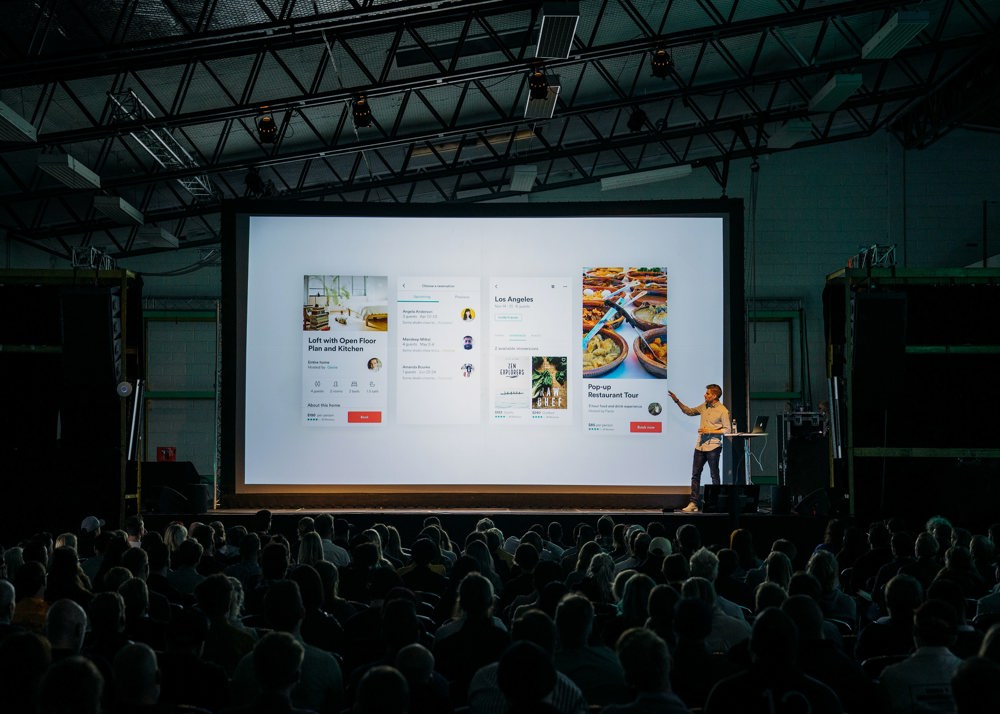
3- Use visuals to your advantage
Visuals are a must in any presentation. Whether it is an image, a chart, a graphic, or a video, visuals help with interpretation and can be an effective way to get your message across or grab the audience's attention.
Just because you’re presenting at an academic conference, it doesn’t mean you can’t use images, videos, or even gifs to help get the message across.
Most people deal better with visuals than words , especially when the information is heavy with data and numbers. But even with visuals, remember to keep it simple. The whole purpose of using visual aids is to help your audience understand the message and not to confuse them with too much information.
If you’re presenting figures or graphs, remember to use the pointer to highlight the key points while you explain your slide. This is something that is easy to forget when the stress level is high, but it can be a good way to stay grounded and focused on the presentation.
4- Know your audience
In any academic conference, knowing your audience puts you one step closer to delivering an effective presentation. Do your research when starting to prepare your presentation.
Skimming the proceedings of past editions of a conference can reveal past participant lists and their profile. Different conferences have different proportions of undergraduate and graduate students, postdocs, or principal investigators. Knowing the proportions of each category can indicate the level of knowledge on certain topics and if you need to spend time explaining certain areas so they understand the rest of the presentation or not.
If you find the abstracts, the Powerpoints, or the recordings of talks from previous editions, it can also help you adjust the depth in which you can go when explaining certain concepts.
Do not fall under the trap of assuming your audience knows nothing about your research subject. If they are at your research conference, it is most likely that they possess knowledge of (and interest in) what you are talking about. So, skip the basics that everyone knows if you feel you can.
Use jargon that is easily understood by the community at large and make sure you define less common abbreviations.
Knowing your audience is not always an easy task. If you’re not sure if your audience is familiar with a specific topic, don't be afraid to ask them! It will make everyone feel more involved and you will get their attention for the rest of the presentation. The bottom line, adapt your message to the audience.
5- Practice, practice, and practice again
No one should know your presentation better than you. When preparing for a particular conference, rehearse your talking points out loud and make sure you feel 100% comfortable with the information laid out on your slides.
In addition, make sure the key ideas and the logical transition between them are crystal clear. One of the worst things that can happen to presenters is getting lost in their own presentation.
You should practice your speech out loud to become familiar with the words as this will help your tone and confidence. When you sound confident, people are keener to listen to what you are saying.
One additional common but useful tip is to record yourself while practicing. It will help you know where you're lacking and what needs to be improved.
For example, some people tend to talk really fast or jump on sentences while others tend to ignore full stops. No matter what the issues are, recording yourself is a great tactic to find and address them.

6- Present it to a friend or colleague
Outside of practicing it out loud on your own, practice it in front of your colleagues. It will give you an experience that will resemble the real presentation the most.
While you present, notice their facial expressions. They can reveal parts of your presentation that are unclear. Tell them not to interrupt you during the presentation, but tell them to note down their suggestions or questions for the end. Make sure to use a timer to measure how you’re doing on time.
Some people like to present to someone completely detached from the topic. The idea is that if people who are not completely familiar with the subject can follow your presentation, people in the field should be able to easily follow it as well.
No matter which option you choose, this exercise will help if you have difficulties speaking in public. Do not be afraid of doing these multiple times before your presentation and always ask for honest feedback. The more you practice, the more confident and more fluent you will be.
During my Ph.D., we often presented to our lab members and went through a Q&A section. Not only was it a good opportunity to practice the presenting skills, but it was also a moment to discuss specific aspects and prepare for potential questions. I remember in some instances, the feedback led to reshuffling the ideas completely in a way that made more sense.
7- Appearances matter
Even though people are coming to your presentation because they are interested in your research, appearances matter. The way you speak, how you interact with your audience, and even what you wear, make an impact. Make sure you wear comfortable clothes.
If you’re presenting at an online event, make sure the lighting comes from in front of you and not from behind or it will make your face appear darker. Not seeing a presenter clearly can distract the audience and decrease attention.
Also make sure there isn’t anything distracting in the background, like television or someone walking. The best background is usually solid-colored walls.
8- Sleep and eat well before the event
Get a good night of sleep the night before the event. You will feel well-rested and ready to tackle the presentation. It can be tempting to practice your slides and go over your presentation late at night, but it is sometimes better to get a good night's sleep.
In addition, make sure to eat well. You don’t want to feel dizzy or be occupied thinking about food when you should be thinking about the presentation.
Lastly, have a bottle of water close to you while you’re presenting. That will allow you to take pauses when needed and give your audience time to absorb the information after you jump into the next slide or argument.

9- Have a backup
If you have your presentation stored on a hard drive, make sure to have an extra copy on the cloud and vice-versa. Hard drives can break and technical difficulties can occur with cloud storage, so always have a backup just in case.
Depending on the guidelines of the event, you can also send a copy of your presentation to the organizer and/or colleague. Send yourself a copy of the presentation by email as well.
A lot of people also have a paper copy of their presentation. That’s the last case alternative but also nice to have. If you are in a poster presentation, this may be harder to achieve.
If you have videos in your presentation, check out if the platform and/or venue can display that, especially the audio (if it’s important). Not all software or places have the necessary (or compatible) technology to display your presentation as they should.
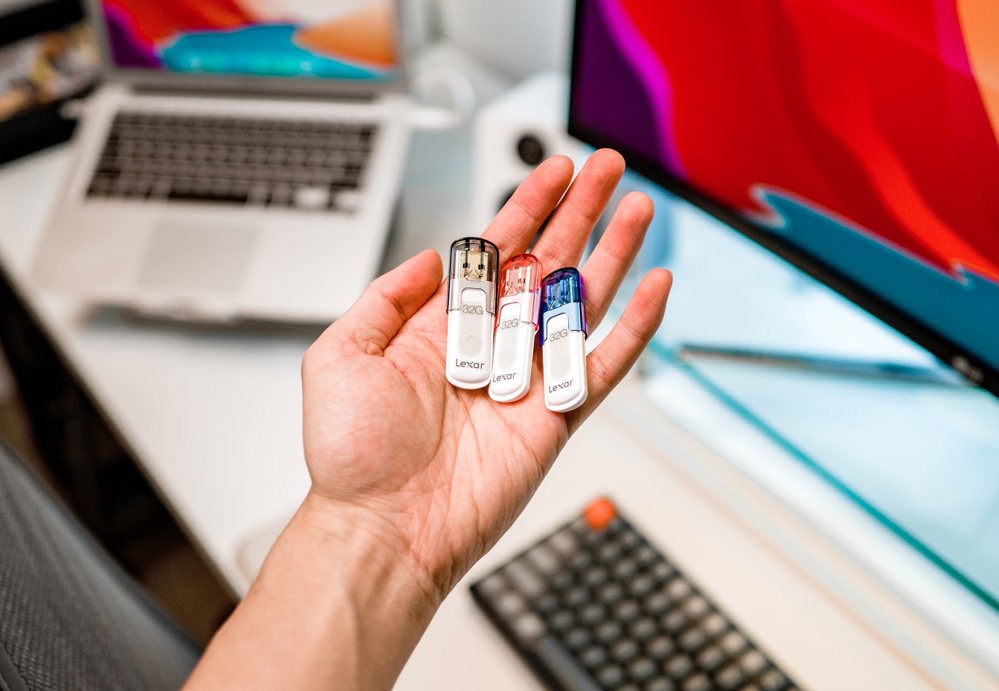
10- Use body language
Body language has an essential role in presentations, especially online ones. Make sure you use body language the right way, otherwise it can be distracting for your audience. That includes fidgeting, repeatedly fixing your hair or clothes, among other things.
In academic conferences, the presentations are usually heavy on the information and data side, so it is important that presenters take advantage of tone of voice, gestures, and other body language resources to get their point across.
It is best to keep eye contact with people in the audience. This way, they will feel you are talking TO them and not AT them. But make sure to alternate and not stare at one single person throughout the whole presentation.
Be aware of your posture and if you have any notes, make sure to either hold them or have them at eyesight. It is common to have notecards during a conference talk, but it is important to know your presentation and not depend on the notes.
11- Encourage your audience to interact with you
A big part of your presentation is for you to talk about your research. People are there to listen to you and absorb information, but they are also there to make the most out of the experience, and that includes engaging and asking questions.
Prepare yourself to answer questions from the audience. It is impossible to cover everything in a short presentation, so try to cover as much as possible and if there are questions you think will arise from the audience, prepare to answer them.
Depending on the type of presentation and what’s expected, you can keep questions for the end or allow questions during the presentation.
If there is a question that you do not have the answer to, it’s ok to say it. It’s better to offer to look more into it and get back to them rather than trying to improvise an answer. Provide your contact information in the final slide or at the end of your presentation. Some participants can reach out to you if they have any questions, suggestions, or opportunities that could be beneficial to you.
If you are giving an online presentation, invite participants to ask a question through the conference platform or website. For example, Fourwaves has a built-in Q&A section on each presentation page where presenters and participants can interact.

12- Structure your presentation and let your audience know
Let your audience know what you will be covering in your presentation. Have a clear outline of the topics and make sure to have this journey clear so the audience understands where you are taking them.
You can start the presentation by highlighting the key messages, but don’t forget to have a summary at the end (your conclusion), where you reiterate the main points of your presentation.
13- Pay attention to design
Adhere to the following basic design principles when building your slides. Avoid distracting colors and mixing more than 2 colors in each slide. If you use a light background, you should use a dark font and vice-versa. Make sure the font size is also big enough and that you are not stuffing too much information into a slide.
A good rule of thumb for your slides is to have about 5 bullet points on each one and give enough time for people to read through them if they need to. Most of the information should be coming out of your mouth and not described in the slides. The slides are just a summary (the bullet points) of what you will cover.
If you are adding visuals, make sure they are big enough so people can see them and they are not covering any information.
14- Take other presentations as an example
You have probably been part of dozens and dozens of presentations in a lifetime. Is there something you liked a lot in those or something you hated? If yes, write it down. If it is positive, strive to replicate that in your presentation. If it is negative, discard it.
If you are taking part in an annual event, you may be able to access presentations from the years before and draw conclusions from there. You can also look for similar poster presentations or templates and get inspiration from those.
Keep in mind that every person has a presentation style. Learn the basic guidelines and find what works best for you.
15- Rely on storytelling
Storytelling is relying on stories (narrative) to talk about something (e.g. personal anecdotes, metaphors, comparisons, etc.). People rely on stories for mnemonic purposes and most of the time, it is easier to remember a story or an analogy than it is to remember a specific situation.
No matter what the topic is, analogies make it easier for people to understand facts. Whenever possible, try to use a metaphor or a comparison
Bonus tip - Remember to stop and breathe during your presentation
It’s normal to feel stressed even if you’re super well prepared and that you know your topic inside out.
Make sure to take the time to pause in between slides and to take a good slow deep breath. It will help you stay focused throughout the presentation.
Practice this during your rehearsals. Not talking for 3-4 seconds can seem long for you, but your audience will appreciate it and it will help you feel calmer.
At the core, preparing for a conference presentation is no different than preparing for any type of public speaking assignment. You need to understand the topic very well, research and practice what you are going to say, and know your audience, among other things.
Most of all, remember: no one is born with great presentation skills, so give yourself room to improve.
5 Best Event Registration Platforms for Your Next Conference
By having one software to organize registrations and submissions, a pediatric health center runs aro...
5 Essential Conference Apps for Your Event
In today’s digital age, the success of any conference hinges not just on the content and speakers bu...
- Search entire site
- Search for a course
- Browse study areas
Analytics and Data Science
- Data Science and Innovation
- Postgraduate Research Courses
- Business Research Programs
- Undergraduate Business Programs
- Entrepreneurship
- MBA Programs
- Postgraduate Business Programs
Communication
- Animation Production
- Business Consulting and Technology Implementation
- Digital and Social Media
- Media Arts and Production
- Media Business
- Media Practice and Industry
- Music and Sound Design
- Social and Political Sciences
- Strategic Communication
- Writing and Publishing
- Postgraduate Communication Research Degrees
Design, Architecture and Building
- Architecture
- Built Environment
- DAB Research
- Public Policy and Governance
- Secondary Education
- Education (Learning and Leadership)
- Learning Design
- Postgraduate Education Research Degrees
- Primary Education
Engineering
- Civil and Environmental
- Computer Systems and Software
- Engineering Management
- Mechanical and Mechatronic
- Systems and Operations
- Telecommunications
- Postgraduate Engineering courses
- Undergraduate Engineering courses
- Sport and Exercise
- Palliative Care
- Public Health
- Nursing (Undergraduate)
- Nursing (Postgraduate)
- Health (Postgraduate)
- Research and Honours
- Health Services Management
- Child and Family Health
- Women's and Children's Health
Health (GEM)
- Coursework Degrees
- Clinical Psychology
- Genetic Counselling
- Good Manufacturing Practice
- Physiotherapy
- Speech Pathology
- Research Degrees
Information Technology
- Business Analysis and Information Systems
- Computer Science, Data Analytics/Mining
- Games, Graphics and Multimedia
- IT Management and Leadership
- Networking and Security
- Software Development and Programming
- Systems Design and Analysis
- Web and Cloud Computing
- Postgraduate IT courses
- Postgraduate IT online courses
- Undergraduate Information Technology courses
- International Studies
- Criminology
- International Relations
- Postgraduate International Studies Research Degrees
- Sustainability and Environment
- Practical Legal Training
- Commercial and Business Law
- Juris Doctor
- Legal Studies
- Master of Laws
- Intellectual Property
- Migration Law and Practice
- Overseas Qualified Lawyers
- Postgraduate Law Programs
- Postgraduate Law Research
- Undergraduate Law Programs
- Life Sciences
- Mathematical and Physical Sciences
- Postgraduate Science Programs
- Science Research Programs
- Undergraduate Science Programs
Transdisciplinary Innovation
- Creative Intelligence and Innovation
- Diploma in Innovation
- Postgraduate Research Degree
- Transdisciplinary Learning
Create a Conference Presentation
Common types of conference presentations.
- Full paper - The length of a full paper is variable, usually between 20 and 40 min, and rarely exceeds one hour. A full paper may be followed by question time.
- Short paper - This type of conference presentation can be as short as 10 min, and very often it is one in a series of short papers in a 1- or 2-hour session on a particular conference sub-topic or theme, each followed by 10 minutes question time. Timing is crucial as it is common for short paper sessions to be carefully managed by timekeepers who will ‘terminate’ your paper after the allocated time.
- Workshop - The emphasis of most workshops is on their practical nature. Their purpose is for participants to experience a strategy, a technique or a practical demonstration, and to have opportunities to question you about the value or workability of what you are presenting.
- Poster - You prepare a poster of your work (one or more A1 displays, including diagrams, text, references or visuals). This is displayed in an area of the conference venue. Your poster may be staffed at particular times when you are required to be available to provide further information or answer questions about your poster.
- Discussion paper - It is assumed that participants have read the paper. A summary is presented at the beginning of the paper (usually, but not always by the paper presenter), and the session consists mainly of a discussion or defence of the issues, questions and ideas raised in the paper.
- Panel presentation/discussion - You are one of several people on a panel discussing a theme/topic related to the conference. Your role is to be an expert in a particular issue, topic, technology, strategy or you represent an institution, department or company. Normally you receive advanced notice of this, but sometimes you can be asked to be a panel member at the conference.
- Roundtable discussion - This is a short paper presentation followed by the presenter facilitating/workshopping discussion with participants in groups.
Preparing your conference presentation
There are significant differences between a written paper, essay or report and a conference presentation. The introduction of a conference presentation should be considerably longer than that of a written text. Repetition is vital in a conference presentation. An audience needs to hear information several times and in slightly different forms to understand it, whereas in a written text the reader can refer back if necessary. Informal rather than formal language should be used in an oral conference presentation.
Think of a ‘catchy’ title as most conferences run parallel sessions and your presentation may compete with numerous presentations offered at the same time.
You will need to submit an abstract to the conference committee for your presentation to be accepted. If you have already written your paper, this task should be fairly easy as the abstract is a summary of the paper which is usually around 200–400 words . Ensure the issues, questions, thesis as well as the conclusion findings are clearly stated in the abstract.
In case the paper has not been written yet, prepare the abstract in such a way that you do not commit yourself to details that will not be addressed in the final paper.
Ensure that you follow guidelines set by the conference organizers regarding length, layout, references, etc. Write the paper as you would an essay, a report, or, more and more commonly, a journal article. The latter is particularly important if the conference proceedings are to be published (refereed or non-refereed). Check previous conference proceedings or journals in your field to ensure consistency with style, referencing, etc.
Presenting your conference presentation
When presenting your conference presentation you need to know your answers to the following questions:
- Is the purpose clearly stated: are you reporting, comparing, convincing, arguing, questioning…?
- Is the thesis/topic clearly stated: “In this paper, I want to report the findings of recent research which shows that under certain conditions, dolphins can be taught how to read simple text”?
- Are your main arguments/ideas supported with evidence?
- Are all the materials relevant to the topic?
- Have you demonstrated your knowledge of the subject?
- Is the level of technicality suited to the audience?
- How do you reply to audience’s questions: long questions, ‘mini papers’ disguised as questions…?
Organise your presentation
Most presentations are organised according to a predictable pattern. They have three main stages: introduction, body and conclusion (i.e. tell them what you are going to say; then say it; then tell them what you have said).
When a presentation does not have these clear sections, it can be very difficult for listeners to follow what is being said.
Introduction
This is the most crucial part of any presentation. You need to capture the audience’s interest in your topic and establish rapport with them. Your introduction should let the audience know what they are going to hear in the presentation. They need to know what to expect in order to get interested and to be able to follow you. Giving them an outline of your presentation in your introduction enables them to do this.
You need to:
- capture the audience’s attention with a question, quotation, anecdote, or interesting statistic, etc.
- main theme or main argument
- main points you will cover and the order in which you will cover them.
The body of your presentation must be clearly organised with the main points highlighted. One effective technique is to number your ideas. Any idea which is new to your audience needs to be presented simply with supportive evidence or examples which will make it more easily understood. Each important idea should be presented several times in different ways within the body of your presentation. Your audience needs several opportunities to absorb the full meaning and the significance of the most important ideas. It is also important to state the links between your ideas clearly.
The body is where you develop your main ideas/argument, using supporting ideas/evidence. Use techniques that make it easy for the listener to follow your talk:
- number your ideas: “ There are three main factors... ”
- arrange your ideas in logical order, such as chronological; cause and effect; problem–solution
- use transitional devices to help the audience follow the direction of your talk: “ secondly…; another important point is...; on the other hand…; I would now like to move on and look at another aspect of the research.. .”
- state the main idea
- refer to experts, provide examples to illustrate the idea
- provide statistics, facts, tell anecdotes (if time permits)
- provide case studies, etc.
- repeat important ideas using different words so the audience has several opportunities to absorb them
- don’t make the information too dense – remember the audience is listening, not reading!
The conclusion sums up main points. The conclusion should reinforce the central ideas of the presentation and signal a forceful ending. A weak, inconclusive or apologetic closing detracts from a good presentation. You should show in your conclusion that you have covered all the points that you said you would in your introduction. You should also show that you are confident, and that you have communicated effectively.
It is important to have a strong conclusion so the audience is left with a good impression.
- Summarise the main ideas of your presentation.
- Don’t introduce any new ideas.
- Work towards a strong ending – don’t finish abruptly or say ‘That’s all’. Perhaps leave the audience with something to think about.
Presentation Tips
Advance preparation.
The more you know about your audience, the more likely you will be able to give an effective presentation. Try to find out as much as you can about who will be there, what their background is, why they will be coming, and how much they will already know about the topic. Go to the room where you will make your presentation and get a feel of its size, acoustics, seating, etc. If you can, familiarise yourself with the equipment in the room.
Clear pronunciation
Your voice must be clear and distinct. If you know you have difficulty with pronunciation, speak a little more slowly than usual. Use intonation, stress, changes in pace (slow down at important points, speed up at details, anecdotes) and pause to keep the listeners’ attention, and focus attention on important points.
Body language
It has been estimated that 75% of meaning transferred is non-verbal. Try to maintain eye contact with your audience as this helps keep your audience engaged. Focus on standing straight and directly facing your audience, using hand gestures to emphasise important information.
Visual aids
A presentation can be enhanced by the effective use of overhead transparencies (slides), charts, pictures, posters or PowerPoint presentations (with limited graphic/sound gimmicks). They provide variety and can help reinforce points made. However, you are still the main communicator of your message. Be familiar with your visual aids, refer to them specifically and only display them when you are referring to them, otherwise they will only be a distraction.
- Physical charts, graphs, pictures, etc.: ensure that the size is appropriate for a large room. If necessary, back up with handouts.
- Video: ensure the segment shown is not too long in relation to the overall length of your presentation.
- Limit the amount of material on each visual: your listeners should be able to read and understand a visual in five seconds or less.
- Be sure your visuals are large enough to be seen by everyone: the lettering should usually be minimum 20-22 pt. font.
- Use diagrams, graphs and charts instead of words where possible.
- Eliminate unnecessary detail from diagrams, graphs and charts.
Expression and style
Try to speak to your audience using notes rather than memorising or reading your presentation. In order to do this, you will have to practise your presentations as many times as you can. If possible, perform in front of an audience. Otherwise, practise in front of a mirror or record yourself on your phone. This will also give you an idea of how long your presentation will take.
Use a conversation style to make your audience feel personally involved. Each time you use the word ‘you’, the audience feels compelled to pay attention.
Back to top
Adapted from Barthel, A. 2010, ‘Presenting a conference paper’, ELSSA Centre, University of Technology Sydney.
UTS acknowledges the Gadigal people of the Eora Nation, the Boorooberongal people of the Dharug Nation, the Bidiagal people and the Gamaygal people, upon whose ancestral lands our university stands. We would also like to pay respect to the Elders both past and present, acknowledging them as the traditional custodians of knowledge for these lands.

15 useful tips for conference presentations
When you’re putting together a presentation for your conference, a lot will be going through your mind. With so many moving parts, it can be challenging to keep track of all your visual and audio elements while creating engaging and insightful content for your presentation.
If you’re struggling to create an engaging presentation that captivates the audience and distributes all necessary information, don’t panic, you're not alone. At DEXON, we understand the importance of successful conference presentations and appreciate that they can significantly impact your business progression.
With that in mind, we’ve created this comprehensive guide to an effective conference presentation, with 15 valuable tips that we think will take your presentation to the next level.
Sign up to our newsletter
How to deliver a good, effective conference presentation?
Before we get into the specifics of conference presentations, let’s briefly discuss why it’s crucial to implement the following steps into your presentation strategy. Firstly, a successful presentation will dictate your conference's success, so it’s integral to provide an engaging presentation that sets the tone for the rest of your conference.
Suppose your attendees leave a presentation feeling inspired and engaged by a presentation. In that case, they’ll likely have a much more positive outlook on the rest of the event and be more receptive to your messaging. Secondly, your presentation will significantly influence how your audience views your business or brand. They might have more confidence in your business if they experience a well-thought-out and professional presentation.
Thirdly, your presentation needs to inspire a call to action, and to do that, your presentation requires intensive thought and preparation. Without this call to action, your audience won’t spring to life and act on your messaging, so it’s vital to implement the following 15 steps to create an impressive conference presentation.
1. Know how much time you have and prepare material
Before you begin creating any presentation slides, it’s imperative that you first determine how much time you have to put your presentation together.
Understanding how much time you have to prepare the relevant materials, liaise with vendors, contact AV professionals, and secure the correct technology will ensure you allocate your time effectively and avoid leaving essential planning stages until the last minute.
Once you have determined how much time you have to prepare, you can map out your content creation time and plan how much time it’s likely to take to create slides. This will help you allocate enough time to review your slides and improve them before your presentation.

2. Aim to be consistent and simple
When you’re designing your presentation slides, try to remain consistent. We’re referring to content consistent with your business image, previous messaging, and core ethos when talking about consistency.
With consistency, your audience may understand the direction of your presentation. Try to maintain consistency and continuity throughout your presentation slides too. This gives your presentation clear direction and ensures that your presentation tells a story instead of providing conflicting information.
Another essential thing to remember when generating your presentation slides is to keep to a simple structure and avoid overloading your slides with complex information. Doing this ensures your audience's attention remains on you throughout the presentation.
3. Understand your audience
One of the key ingredients to a successful conference presentation is understanding your audience and their requirements before generating any content.
You should determine why they’re attending the conference, what they’re hoping to gain from experience, and what they expect the conference to contain, adjusting your presentation content accordingly.
Tailoring your content to your audience in this way will ensure you can hold their attention throughout the conference and may inspire them to act on your call to action if they’re feeling engaged and inspired by personalized content.
4. Rehearse a lot
Like all forms of public speaking, rehearsing your presentation is central to your presentation's success. Rehearsing a lot allows you to identify areas that are successful in your presentation and opportunities for improvement.
Doing this can help you further optimize your presentation content, allowing you to create a more successful presentation overall. Additionally, during rehearsals, you can identify opportunities to interact with audiences to improve engagement.
During rehearsals, try to mimic the conditions of your conference as much as possible by having the correct lighting, venue, and AV technology so you can see whether your AV elements are well coordinated.
5. Use the right AV technology
Having the right AV technology for your presentation is crucial to your presentation's success. Including the correct technology can help your presentation run much smoother, ensuring you can coordinate all audio and visual elements of your presentation. To ensure you have the right AV technology, consider what’s necessary for your tech to run optimally.
For example, if you’re choosing to use a video wall as part of your display to use multiple screens and dynamic display options, you’ll need the corresponding technology. This includes video wall matrix switchers , controllers , and video wall processors . Securing this technology early in your presentation planning process ensures you can guarantee their arrival before your conference, avoiding last-minute scrambling for equipment.
Try to match the AV equipment you use to your project's complexity to avoid being unable to use specific technology. For example, consider using controllers, switchers, and processors from Dexon if you have a particularly complex presentation, as our equipment is designed with complexity in mind.
6. Have a backup
As with all things, it’s always best to plan for the unexpected such as missing equipment, system errors, and other faults that could crop up on the day. Consider investing in backup equipment such as microphones, speakers, and monitors for the day of your conference. Not only will this ensure you’re not caught short in a technical fault, but it will also decrease your anxiety, knowing that you’re covered in an emergency.
Some other equipment you should bring backups for include cables such as HDMI, CGA, or USB cables with adaptors to ensure you can adapt your equipment to your venue’s outlets. This is especially important if you’re planning to use the venue’s equipment to save yourself money.
7. Use visual technology as much as possible
Your presentation visuals will play an essential role in your presentation’s success. This is because visual elements generate high engagement, meaning your audience is more likely to be in tune with what you’re saying and act on your call to action. Without engagement, your conference and presentation may not have the desired effect.
Visual technology such as video walls and clever lighting can engage your audience, immersing them in a cinematic experience and making them feel more connected to your presentation. They might gather a more positive image of your brand, contributing to your success.
Consider using innovative visual technology such as interactive whiteboards or video walls to use multiple monitors and input signals for a more dynamic and exciting display. Using this instead of a standard single monitor will transform your presentation into a cinematic experience.

8. Present to a friend
Before you launch your presentation in front of a live audience, consider enlisting the help of a trusted friend or colleague to view your presentation and give you feedback. Presenting in front of other people will help you identify any opportunities for audience interaction to boost engagement in your audience.
Doing this will also help you identify areas of your presentation that don’t have the desired audience impact. Monitoring your friend or colleague’s engagement levels throughout these rehearsals will give you a clear indication of what parts of your presentation are a success and what parts require improvement.
At the end of your rehearsal, consider asking for in-depth feedback to understand what needs to change in your presentation. You can also ask them which parts of your presentation were successful to help boost your confidence and reduce your anxiety about presenting in front of an audience.

9. Pay attention to your body language
During your rehearsals, pay attention to your body language and ask yourself some questions. Ask yourself whether your body language makes you appear open, friendly, and interactive with your audience or whether your anxiety about public speaking makes your body language appear stand-offish or nervous.
Body language plays a significant role in presentation success, and the more relaxed and open you appear, the more comfortable and receptive your audience will be. While you should over-gesticulate, you should ensure that you move your hands and arms when explaining vital information to make yourself appear more friendly.
Your audience will likely connect to this and pay more attention to you if you’re animated and enthused about your presentation content.
10. Consider encouraging your audience to interact with you
An interactive presentation is a successful one , and when you don’t interact with your audience, they’re likely to switch off or be disengaged with your conference content.
The best way to ensure that your conference and presentation are as interactive as possible is to allot specific time for audience interaction. Consider implementing a Q&A section into the session, going into the crowd and asking for audience participation, or conducting a brainstorming session with your attendees.
Incorporating these elements into your presentation will ensure your audience is switched on and ready for the next opportunity to express their thoughts. This will also leave them with lasting memories to take away from their experience, meaning your presentation and business will be memorable.
11. Create a schedule that your audience can follow
Consider creating a program with a clear schedule if your presentation is part of a huge conference with multiple events throughout the day. Giving your audience a clear indication of timings allows them to plan their day more effectively and prevents them from getting distracted by confusing timings or missed events.
Creating a straightforward program with a small introduction to your presentation conference also portrays you as professional and highly communicative, a significant value your audience may seek.

12. Try not to focus on the audience too much if you have anxiety
It’s no secret that public speaking can make our stomachs turn, but it’s important to take constructive steps to overcome your anxiety for a successful conference.
If public speaking and presentation anxiety is a significant concerns, consider trying not to focus on your audience outside of the audience participation sections of your presentation.
To do this, try to find a focal point in your venue, such as a wall section, or identify a person in the crowd and focus on them. Doing this ensures you’re not focusing on being scrutinized by lots of other people-which may calm your nerves.
13. Try to make full use of the presentation space
Sticking to one part of your stage can feel impersonal and robotic, so consider interacting with your set by moving around as much as possible. Not only can this significantly impact your body language and give you more opportunities to interact with your audience, but it can also help to calm you.
When we’re nervous, we may feel inclined to tap our feet or keep our hands busy to redirect our energy and self-soothe. Moving around your set and interacting with the space is an effective redirection of nervous energy that disguises your fear, making you appear and feel more relaxed.
14. Consider getting help from AV professionals
One of the best ways to guarantee a successful conference presentation incorporating visual and audio elements is to seek help from AV professionals like AV integrators. These professionals can help you optimize your use of AV technology and provide you with a simple interface that gives you more control over your technology.
This can help you better coordinate your visual and sound elements, creating a smoother presentation. Seeking help from AV professionals is a must if you’re confronting a large AV project with lots of conflicting AV technology, as AV integrators can find ways of making this more manageable and help you achieve your presentation goals with the help of technology.

15. Gather feedback
Lastly, the key to a successful presentation lies in acting on feedback. The best way to improve on future presentations is to implement the feedback from your audience and find ways of better catering to their needs.
To do this, consider asking your audience to provide feedback with an online survey to help you identify areas to improve in the future. This also allows you to celebrate presentation successes by identifying what your audience enjoyed, making you feel more confident in your abilities.
Final thoughts
If you’re looking for ways to turn your conference and presentations into a cinematic experience for all, check out Dexon’s products now. We stock an impressive range of controllers, switchers, and processors that can help you create more dynamic displays that your audiences will love. Check out our product family now, or contact us to find out how we can take your conference presentations to the next level.
DEXON Systems +36 23 422 804 +36 23 445 199
Latest Blog

Dear Visitor! We use cookies to enhance your experience. By continuing to visit this site you agree to our use of cookies. More OK
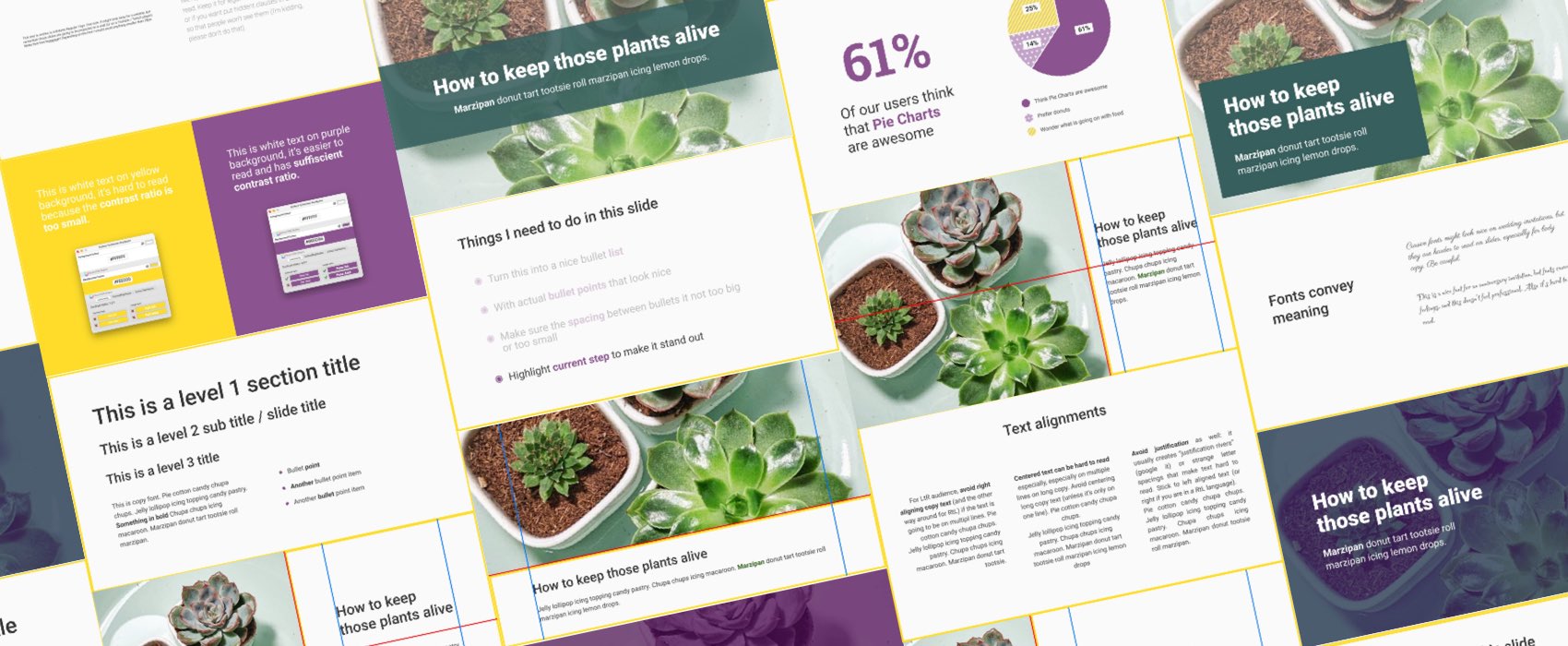
Create better conference slides and presentations
Do you want to start a journey in public speaking , but are no designers ? You’re in the right place! Today, I am showing you the ropes and basics to help you craft slides that look professional. Slides that will help catch the audience’s attention, while still keeping them focused on your talk. No magic; mostly planing, typography, content layout, images, audio, video and content tips. And a few extra tips on rhythm, notes, technical checks, rehearsals. You know, all those small details to make sure you are and feel prepared . As bonus, I bundled this all quick checklist to help you not forget anything. So here we go, let’s start your slides journey together 🙂
This article is a transcript of the tips I gave for Women Talk Design’s next cohort of “ Present yourself with confidence ” workshops that starts soon. And this year, I am one of their guest speaker .
Inspiration, Planing, Preparation & Rehearsal
The first tip I can give you about slides, is actually to not start with the slides, but with a plan and a structure.
Start with understanding what type of “ conference style ” you want to go with. Take a look at other talks and slides for inspiration : technical ones, inspirational ones (like keynotes), case studies, etc. What style do you enjoy? What would YOU be comfortable with?
Some people have 125 slides for a 45min talk and go super fast from slide to slide. Some people have 25 slides for 45 minutes and talk a lot on each slide. I’m usually a 90slides for 45min kind of gurl. Up to you to see what you are more comfortable with. It comes with practise and might change over time.
Have a plan
** Xayha and Rakan’s voices “ We have a plan? We always have a plan ” **
I always start with a plan , not the slides. I like to write my talk like articles, it helps with storytelling. Some people write a plan with a few bullet points. Some people use mind mapping tools. Whatever works for you.
For anything topic and plan related, I recommend you read Lara Hogan’s excellent “ Demystifying public speaking ” book. I prepare my plan in Gdocs, with a LOT of bullet points and titles. But, again, that’s me. Whatever tool helps YOU organise your structure. Then, I don’t want to invest too much time in the slide design until I have the structure and timing right.
If this is a “non remote talk” (yes, remote is the new normal haha), I also plan for “ OMG I can’t share the computer’s audio and there’s no internet connection in the room ” worse case scenarios. Because this might happen. Can you still give your talk from a PDF version of those slides? If you planned a live demo, record it in advance. Just in case. And have the recording as a backup in case wifi is dead. Be prepared for a “lower” version of those slides and talk if necessary.
Rehearse the structure with “skeleton slides”.
So I start with basic slide structure (titles + text), kind of like a skeleton of future slides.. I rehearse them once or twice to get the timing, storytelling and content right . Then I do the design (this way I avoid designing slides I won’t use).
I also sometimes rehearse that basic structure in front of an external observer to get feedback about the rhythm, the flow. If also helps me see if the order of the slides make sense. I don’t need super detailed designed slides for this, it’s about structure.
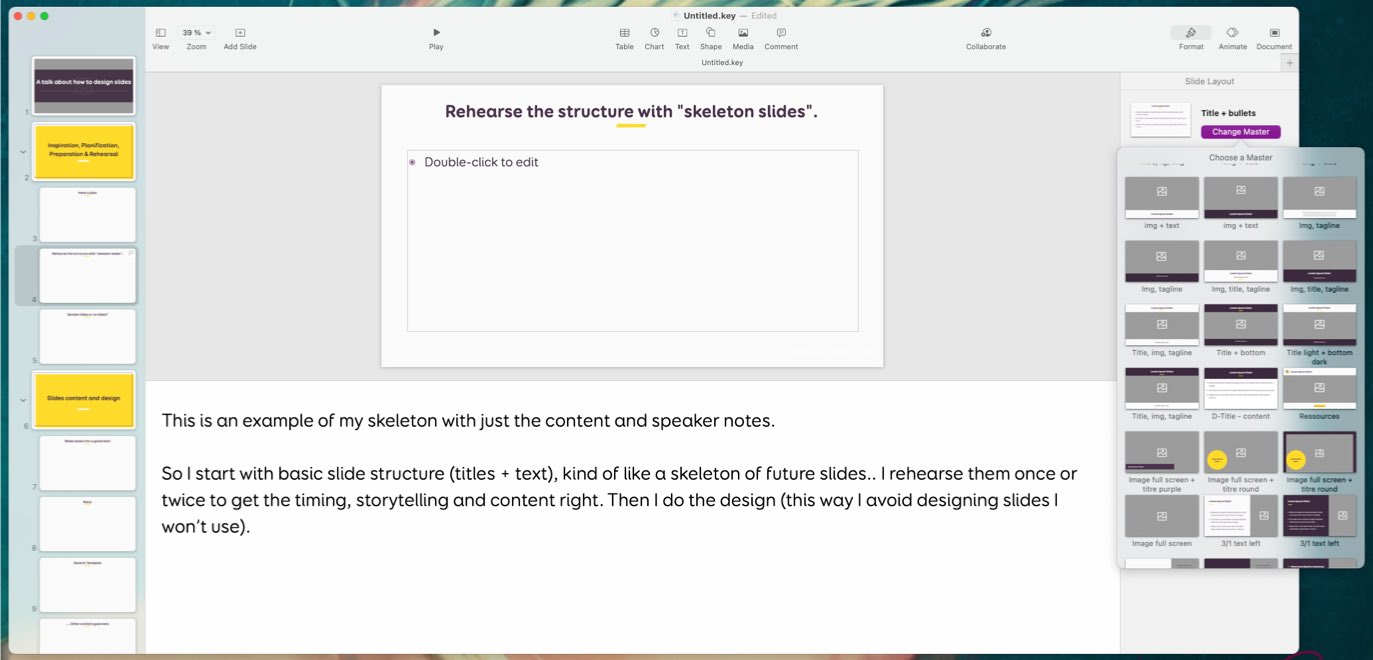
This is what my skeleton usually looks like: the main titles, the slides with mostly just some text and some notes
Once I have the slides finished, I still rehearse a lot. Usually, if it’s the first time I give a talk, I am up to 4 or 5 rehearsal sessions. This is important for me to get the timing right. I know that I’m stressed out and tend to speak faster, but still. You don’t want to be the speaker who messed up the whole organization because your 20 min talk took 35 min (I saw that happen). I have friends who can finish their slides 1h before the talk and pull it of. Goof for them. BUT, if this is your first talk, don’t do that. It will be even more stressful for you. Be prepared 🙂
Section titles or no titles?
Having clear sections with titles work well for technical talks and talks where each part digs into a specific topic. Titles also help transition from one idea to the other and let you have a small “breathing” (even water) break. If you have titles, having a summary of what you’ll talk about at the beginning can help the audience project into the talk. Some other talks are following more of a storytelling inspirational path. For those, it might be strange to have titles in the middle of the story. But, it could still work.
Slides Content and Design
A quick note: those are generic advice for people who give their first talk, want to improve their presentation and slide skills and might not be designers. I speak and talk in English and French, so those advice is for LtR (Left to Right) languages. You could reverse the tips for RtL (Right to Left). I honestly have no idea if this would apply for TtB (Top to Bottom) languages (like Chinese).
Here comes my main advice: your conference slides are a visual support to help the audience follow what you are saying. It is NOT here replace you . You want them to listen to you, not read your slides. So, all the tips here will try to focus on that idea. Non visual distraction.
Which means that those tips apply mostly to conference slides . Workshop and teaching slides are a little bit different. Because they are also used as support students and workshop attendees refer back to. So, if you are teaching classes or presenting a workshop, your slides might contain more content that what I advice here.
Slides basics for a good start
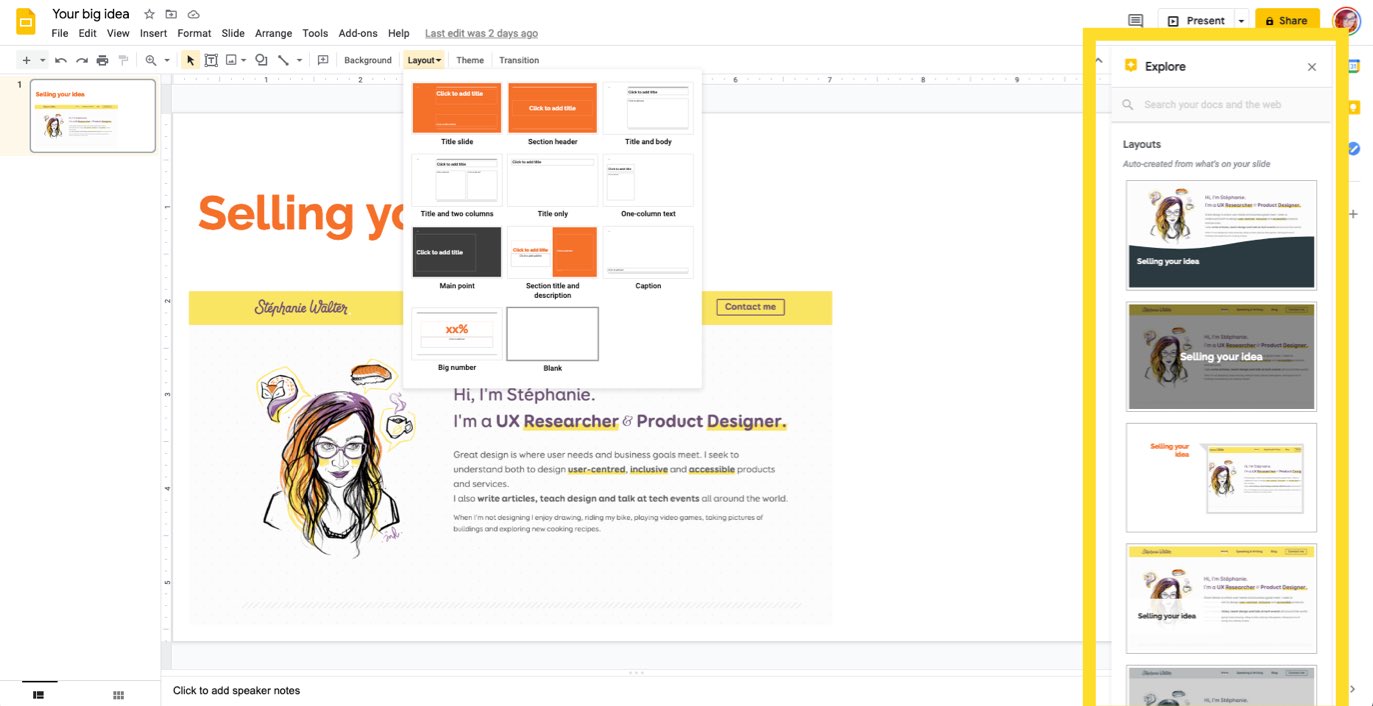
Gslide Explore layout offers multiple layouts for an image and text combination
Let’s cover a few basics first:
- Slides ratio : 16:9 works on most projectors those days and is ideal for online presentation. 4:3 is still an option since most projectors can switch between one or the other. I prefer 16:9 because it gives more space for nice visuals.
- You can always ask the organizer about the format of the projector if they know it.
- There’s NO SHAME in using a generic theme when you start. Most themes come with a lot of options and layout.
- Use a consistent theme : colors, consistent font-size, etc. The best way to achieve this is to use slide templates/ master. If you don’t use a generic template, you can start from scratch. Most tools have blank starter themes. Or modify an existing theme to adapt to your colors / fonts.
- GSlides even has some machine learning suggestions to try to find the best layout based on your content .
- Avoid too many ideas on one slide . If you have a lot of ideas and content, it’s better to split “one idea by slide ” so the audience can follow.
Choosing your color scheme wisely
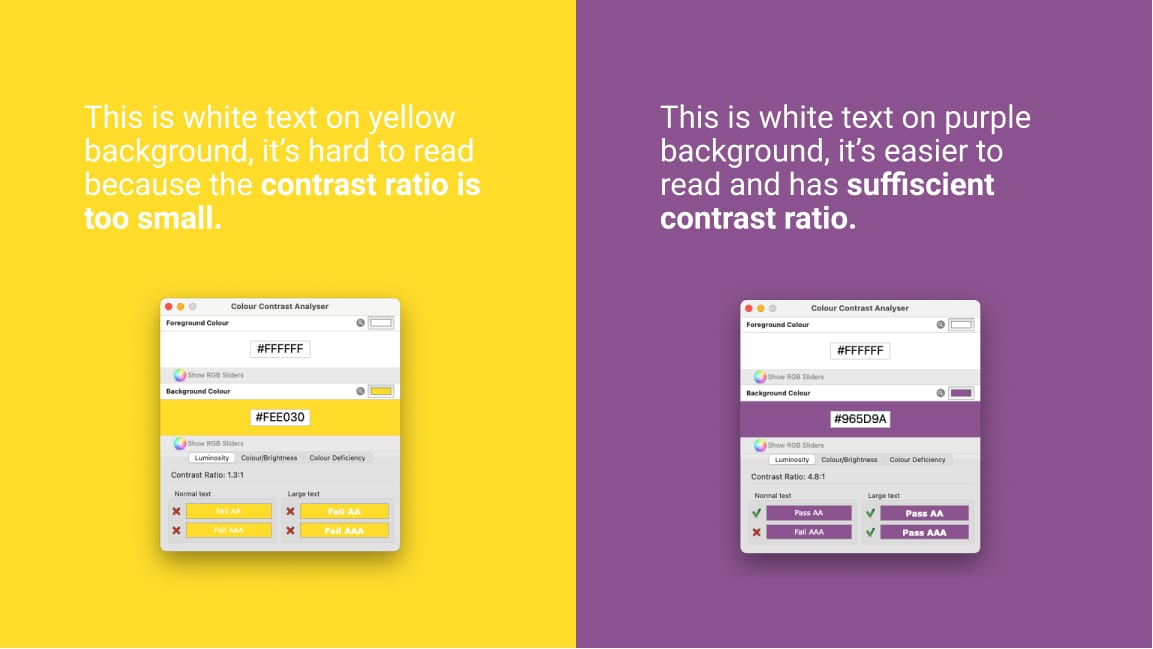
When it comes to colors, be careful with text/background contrast and follow main accessibility guidelines. Especially if the slides might be displayed on old projectors. I am not going to detail how to pick colors here, I wrote about it in “ Tips to Create an Accessible and Contrasted Color Palette “. Also check “ Color accessibility: tools and resources to help you design inclusive products ” for more details and tools to help you. Also Geoffrey Crofte has an awesome article on “ Pantone 2021: Working on an Accessible Color Palette “.
One question I have often is the “do you recommend light or dark theme”. It is an interesting debate. It depends.
- Dark themes work for dark rooms. If you know you will present in a theatre or cinema for example.
- If you are not a designer it can be hard to make some good readable dark mode slides that work nicely with pictures .
- Dark themes work nicely with code, and “non images just text” kind of slides.
- Some colors tend to “bleed” or “move” on a dark background. If you put some levels of blue on dark themes for example I will have a headache after 10 minutes in your talk. So, again, it might be complicated.
- So, if this is your first talk and you are not a designer, unless you found a template that works, stick to light themes.
- If you go for a dark theme, avoid pure white text on pure black color . The contrast might be too high for some people (like me, yes there’s such things as too high contrast).
- Also if you are doing more of a workshop, some people like to print the slides to have a physical handout. In that case, dark mode is going to cost a LOT of ink.
Fonts and typography
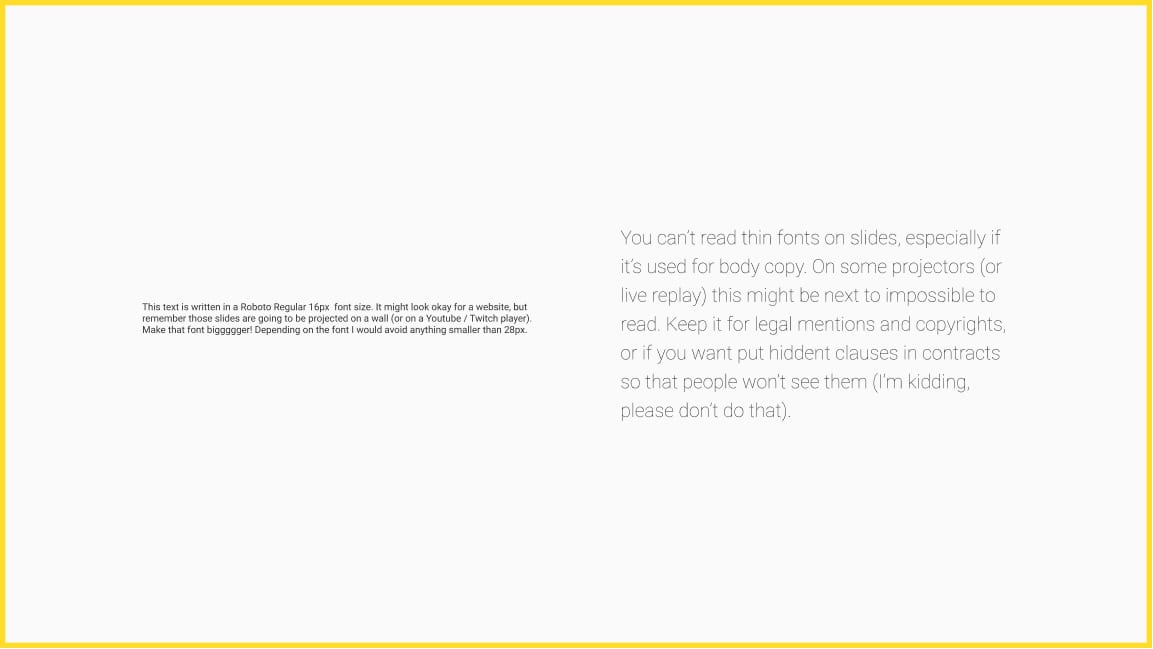
Font hierarchy and ratio : usually you need a font-size for some “big section titles”, then a “header in the slides” size and some body and bullet font-size. You can use mathematique ratio to create balance here (or tools like https://type-scale.com/ ). But again, most templates usually are well built, so use the template font hierarchy
Also, you want to keep consistency . Try to use the same font-size for “big slides titles”, “header title on a slide” and “body copy” all the way through your presentation. Again, designers who master font and visual hierarchy will play with this rule. But if you are a beginner with no design background, stick to the rules ^^
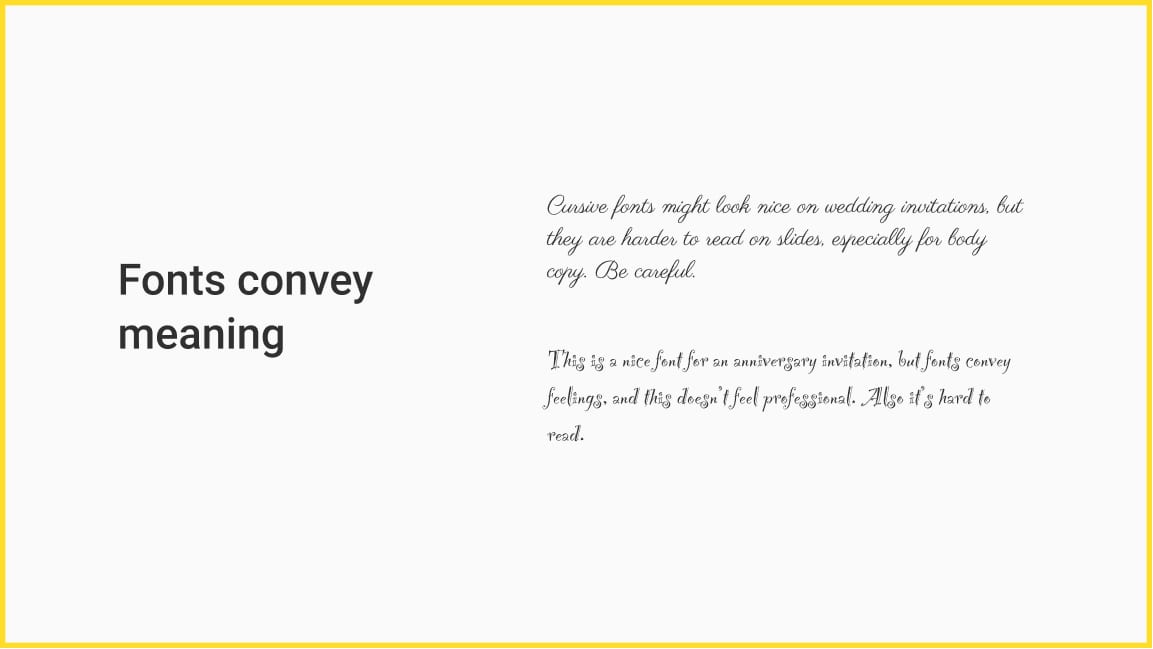
Now, here are a 2 tips on font choice and pairing : fonts convey meaning. Be careful with those (a cursive is nice for weddings, but hard to read on slides for example). When in double, stick to the basics , even if they look boring. Same for font pairing: if you are not a designer, stick to one font and multiple weight . Or use one of those tools:
- Some examples of good Google Font pairings
- A curated list of (google fonts) pairings that work well together
- Another curated list of nice pairings
- Okay, one last list of fonts that work well together
- Font pairing generated with deep learning
- Font Combination by Bold
Last but not least: don’t use vertical writing (again, this applies to LtR languages). And yes, I know some templates offer the option. But it’s annoying for the audience to have to turn their head to read something.
Caps and alignments
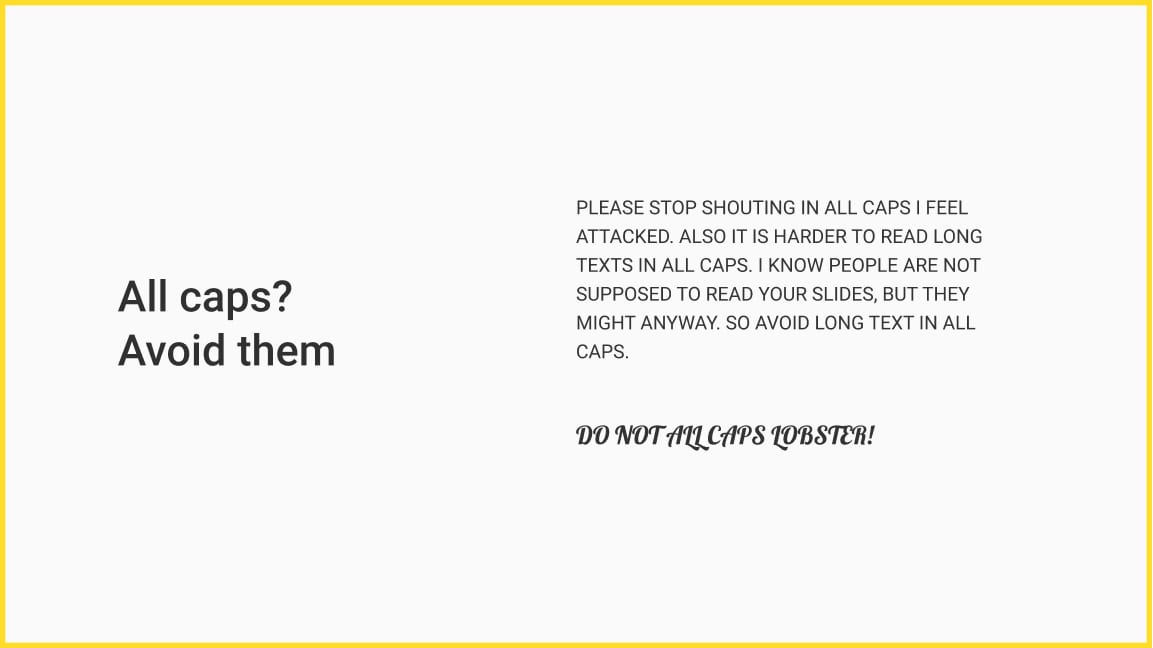
Avoid all caps on super long titles / text . It is harder to read for some people. But you could use caps it to emphasize some words.
You can use bold to emphasize some important elements . Remember that if everything is bold, nothing is emphasized anymore. So, use this carefully.
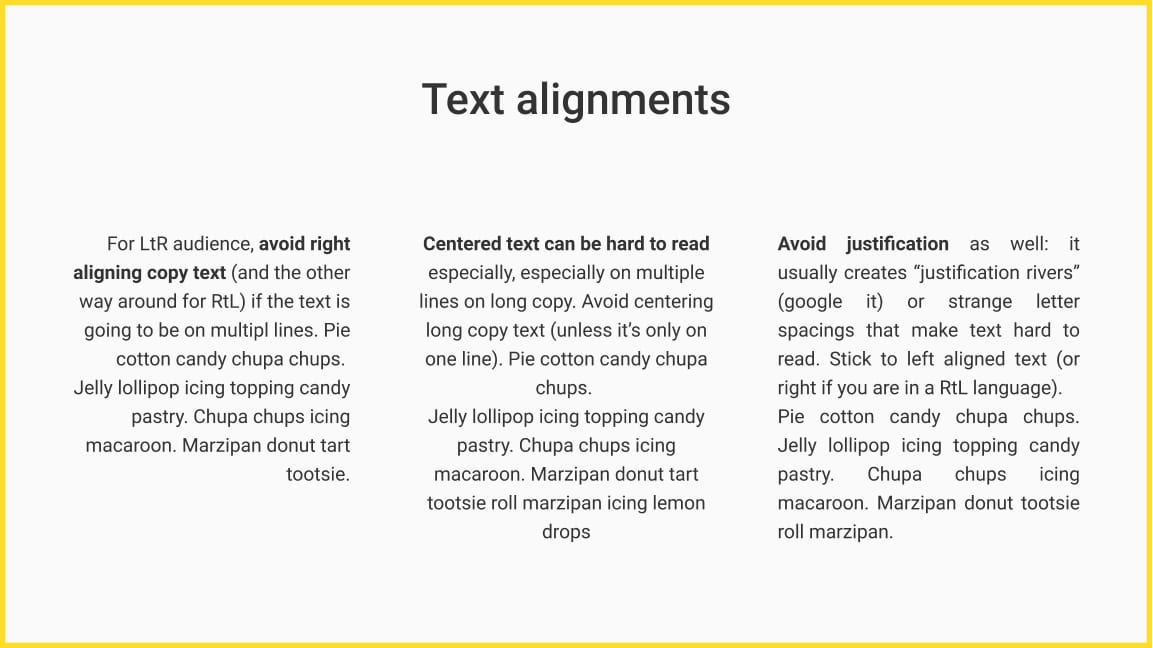
For the alignment:
- For LtR audience, avoid right aligning copy text. And the other way around for RtL. This is not true for graphs thought you might need to right align legends.
- Also centered text is hard to read. So keep centered text for titles , avoid on body copy, avoid at all costs on bullet points!
- Same for justification: it usually creates “ justification rivers ” that make it hard to read. Stick to left aligned text (or right if you are in a RtL language).
Structure your content with bullet point lists

Bullet point lists is a good way to structure some heavy content. Here are a few tips:
- Use a bullet list , but not too many bullets.
- I mentioned before you want to have one idea by slide . You could have multiple ideas with bullet points but… They need to be all related to the same topic. And after 4/5 bullets it’s hard to follow .
- Try to keep each bullet content short . Unless it’s teaching slides that you will give to students after. But for conference talk slides, again, you don’t want people to read it .
- So, put the main idea in the bullet in a few words, then develop it in your speech.
- Tools like keynote let you play the bullets one by one . It’s a nice trick to help people focus on the current bullet.
- Another trick is to gray out any bullets that are not the current topic
Structure your content with layout and composition
The human eye loves structures. And things that are aligned. Slides should also follow basic “aligning design elements” rules:
- Use guides to make sure everything is aligned properly.
- Sometimes the guides are hidden, you usually find those options under “view” of the main tools/
- Also use the alignment tools in your presentation software to align content with each other. They usually “appear” when you select multiple elements. They are under things called “align” or “arrange” It’s amazing how just a few alignment can change some slides.
- Same tips for distribution. Use the horizontal / vertical distribution options when you have multiple elements and want them to be equally spaces.
- Don’t put important information in the edges in case it might get cropped. Or you might have your webcam on top of it with certain tools (Skype I hate you).

You should also follow some rules of composition to make your slides more balanced when you have multiple elements (like text + image)
- Vertical splits work well : content left + image right or the other way around.
- You could also use math ratio: 1/3 – 2/3 . Explore different options depending on your content density and image sizes.
- Top / bottom composition might work in some cases. But it depends on the image.
Here are some visual examples of different compositions using the same image and text. It depends what you want to put more emphasis on. Note the blue and red lines: those are my guides/rules.
Using images in slides
How to chose the right images for your slides is out of the scope of this article. But most tips I give in “ How to make your blog images stand out & reflect your identity ” also apply to slides. So be sure to check it out.
Now, let’s talk about how to use those images and what you need to be careful about:
- Keep the ratio of images when scaling . ALWAYS. This is the number one deadly sin of images in slides. Horrible stretched images make me want to cry. And make YOU look unprofessional and amateurish.
- If you have a portrait image, it is easier to use a left / right composition (see tips above). You don’t think you need to center everything 🙂
- Be careful about how the image is cropped , what the focus of the image is. For example: avoid chopping someone’s head of with your image cropping
- If you scale up images, make sure they are not pixelated (especially for high def projectors).
- On that note SVGs are awesome for images that scale without pixelation (but Keynote doesn’t like them).
- Accessibility : if you have images that bring information like graphs, tell the audience what’s on the image . Some people might be blind, some people might listen to your talk in audio only. You could put the description in the notes to help you remember to describe it (this doesn’t apply if you have decorative images that are here to fill the space and make the slides look nice).
- Looping gifs might look fun, but they are quite annoying if they stay on screen for a long time.
- Also, anything moving is distracting to our reptilian brain and draws attention. So, be careful with looping videos, gif or animations (more on that in the video section).
- Diversity is important . Try to avoid having only images of white men in your presentations. Especially for a quite diverse audience. Same for different body types, different disabilities, etc. The best talks have inclusive images.
- Also, if you quote people, it would be nice to not only quote the same white men everyone is quoting #stevejobs
- Drawing illustrations for your slides is an awesome idea if you draw, but, this takes a LOT of time. You are warned. (still I love the illustration slides style).
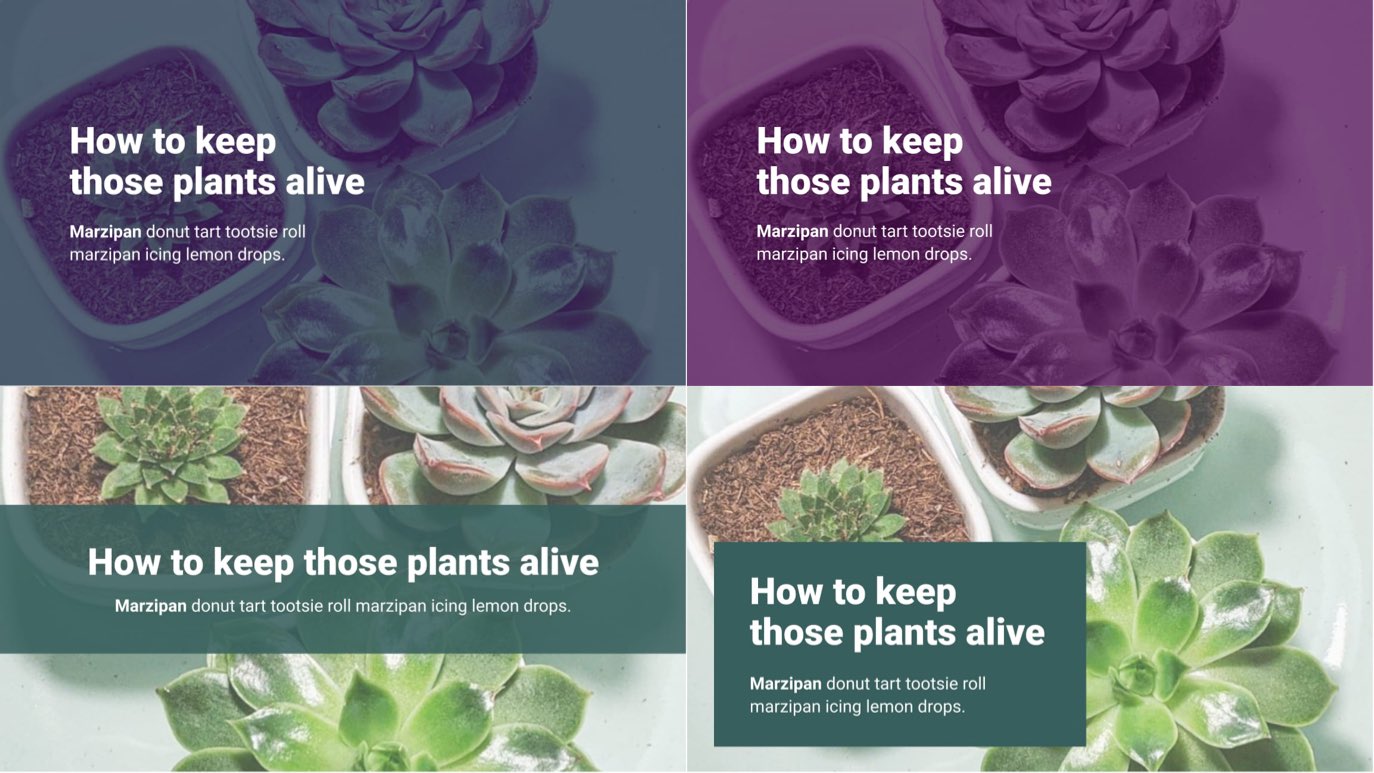
You can also have fun with full screen images. But then how do you deal with the text? Here’s a few ideas:
- If you use background images and text on top of those, again, be careful with contrast and accessibility. You can have a dark (or dark colored) overlay on top of them to enhance contrast
- Instead of having a whole overlay, you can have a background only on your text (like put the text in a box).
- That background can be a rectangle like the example below. But you could have fun with shapes . I use a lot of text on full yellow circules in my talks . Just be careful because text might be more complex to read if it follows a complex shape
Graphs and chart

I’m not a big fan of graphs and charts because they bring a lot of cognitive load to the audience. And again, you want people to listen to you. Not to try to understand the graph on the slides. So, here are a few tips:
- It’s hard to keep the audience engaged with complex graphs. Extract the main idea , one number and don’t show graphs at all.
- If you really need a graph, try to make it simple. Avoid gradients and visual noise. Remove unnecessary information. Keep in mind that it’s supposed to be a visual help for your talk , not the other way around.
- Also if you use graph, be careful about accessibility : don’t use color as the way to convey information.
Last but not least, it’s not always easy to find the “right” visual representation for the data. Should you go with a pie chart? An histogram? Here are a few resources to help:
- From Data to Viz
- Data Visualization – How to Pick the Right Chart Type?
- An intro to designing accessible data visualizations
- How to pick more beautiful colors for your data visualizations
Multimedia content (videos, audio, animations)
This is a personal preference, but I am not a big fan of animations and things moving around. Prezi’s zoom in/out makes me nauseous, literally. They are distracting at best. So, I tend to avoid eye candy animations between slides . Or to stick to smooth fadein/out.
It’s even worse if you present remotely. There’s a chance that people will not even see your animation anyway if there’s a latency with your bandwidth. Or frame drops.
As I explain in my talk “ Enhancing User Experience with CSS Animations “, animations are a good candidate for storytelling. They can help explain complex concepts, like graphs or flows. So, I would use animations in those cases: when moving things around on the screen helps people understand the concept.
When it comes to audio and videos with sound, here are a few tips:
- If you have sound, test audio before the talk . Make sure it’s not too loud for the audience.
- If you are presenting remotely, it’s a whole other mess. By default, most video conference tools only route the audio of your microphone . Some tools like zoom have a checkbox that lets you also share the audio of your computer. But most tools don’t. If you have audio in your slides and want to play it remotely, depending on the tool, you need to reroute the audio of your computer to the microphone. You need some virtual cable software to do so. I use loopback for that on mac.
- Based on your bandwidth, your videos might be super poor quality, or have some frames that drop . Be prepared to describe what’s happening on the video if you are speaking remotely.
- Usually webcams use a lot of bandwidth. If you want to keep the quality of the audio and your screen sharing, it’s sad, but sometimes it’s better to turn off your webcam .
Most presentation tools now also let you embed videos. A short video can be a nice way to help get your message accross to your audience. It’s also a life saver for demos. I’ve seen so many demos backfire, that now, I don’t do them live anymore, I pre-record them instead and play the video during the talk. It takes a little bit of time to record, prepare and cut, but there’s plenty of tools online, like FlexClip , that can help you with that. Also, if you have some sound in your video, don’t forget to have some caption so that the audience can follow. It will also save you in case the sound doesn’t work.
Announce triggering content
Some multimedia content might be triggered for different reasons. I usually try to announce when some content might be triggering at the beginning of the talk, and then, just before the triggering slide comes. For example: I have a talk on UX design where I use a campaign for safety vests where the person is drowning. This is a horrible (yet effective) image, and drowning might trigger some people. So I announce this at the beginning of the talk, and just before I play that video.
This is also true for animations . I have a whole talk on CSS animations and I know some of those might trigger motion sickness so I announce them before playing them, and only play them once.
It’s also true for sound. I once almost left a conference room because the speaker was playing samples of ASMR and the audio was so loud and it created some cognitive overload for me. I covered my ears, the friend next to me left. Announce that kind of audio content before.
Giving the Talk: rhythm, speaker notes, pausing, breathing and drinking water

My notes on the right with the “breath” written (in French) and Marie’s “don’t forget to drink” slide
Okay, we tackled the part of the slides people can see. I got a few more tips for the part people don’t see.
- I put a lot of notes in the slides, even full sentences. This helps me because English is not my native language.
- Stress can make you forget what you wanted to say. I don’t want to read those notes (but you can totally read them if this is your style), but I want to have them around if I am lost . It’s one of those “I am prepared I won’t panic” things.
- Those notes have words in bold. This way, even if I do not read them, my eye still has words to focus on if I need them.
- Notes also help me with timing . I found out that if I don’t have notes or script, I tend to talk way much more on specific slides. It’s usually okay in a meetup when you are the only speaker. But, if you are talking at a conference and you have a specific amount of time, going off topic means you have to go quicker through some other slides later.
- I write “BREATH” or “RESPIRE” in purple on my notes . It’s strange, but it helps. I know speakers who have a “breath post it” on the screen. It’s just one of those reminders.
- Talking will dry your mouth and it’s actually a big brain activity, your brain needs water. Have a few slides where you know you can drink some water . It can be a title slide. Or you could have a cute slide with your pet on it, that works too. My friend Marie Guillaumet does that and the audience loves it. Here’s her cute cat.
Technical check and room setting
You have nice slides, you are prepared. You rehearsed. Everything is fine. There’s still a few extra things you can check and do to make sure everything runs smoothly for your talk.
- If you can visit and take a look at the room you will be presenting into (or ask pictures) to adapt , it’s nice. It also helps me be less nervous.
- Be careful about stage and room layout . I presented in a flat room where all the participants were on the same level, super low screen. It meant that any text at the bottom of the slides would not be seen by some people. It’s okay if I read that text, but still it might be frustrating for the audience.
- Check the air , is it cold on stage? Warn ? This way you can dress to be at ease.
- Try to know where the notes will be displayed . Do you need to be close to your computer? Are there some small screens at the bottom of the stage? Are your notes big enough?
- If you speak remotely: ask to see the template. I have seen conferences that cover part of the left of the slides with a speaker webcam. They should not, but you never know. Try to see the remote setting and plan accordingly.
- Some conferences have live captions (online and in person). Those captions take space on the screen. So maybe your slides will be smaller than expected because of the caption. Again, ask.
- Ask for a technical check before. Check audio , check the wifi if you need it, check the slides format. If you have videos, check if they are smooth (especially if it’s a remote online conference).
- If it’s a remote conference, ask to use the tool before to test how it works. Try to know how it will work. Do you have to share your screen and unmute yourself at a specific time or does a technical person do it for you? I once spoke at a conference in Russia and the tool was in Russian. I was glad that we did some technical checks so that I knew where to press to share my screen and webcam.
Most conferences are used to all of that. So they will usually come to you for technical checks and all. But, you can never be too prepared.
A few other final tips
This was a looong list of tips. So, just a few last things before you go
- Enjoy yourself . The audience is rooting FOR you. They are usually just a bunch of nice people eager to learn and listen to you.
- The audience doesn’t see your notes, your plan. If you miss something, they might not even notice 😉
- If it’s possible (and it doesn’t pose any issues with NDAs and such), giving access to the slides to the audience before or during the talk can be useful.
- If there’s someone who will introduce you, you could drop the “me presenting myself” slide. This is good advice if you are on a tight schedule and need to remove slides haha, like me.
And if you present online and remotely:
- Check with the organizers if you will take the questions during the talk or after . Some speakers are comfortable chatting with the chat audience while going through the slides. While some other speakers don’t like their flow to be broken and prefer the questions at the end. Both are okay, know what makes YOU comfortable and communicate with the organizers.
- For remote conferences, what’s important is your voice and slides. I think it’s okay to switch off the camera if this causes bandwidth issues . You want to keep the audio and screen sharing quality as high as possible.
- Live caption: Powerpoint has some built in live captioning tools. It’s not perfect but it’s a start to try to make your content more accessible if the conference doesn’t provide any (I wish Keynote had that). For me it’s okay in English. French is a mess though.
We all love a good checklist. Well, at least I do. So, to help you not forget any of those tips, I prepared a small checklist in PDF that you can download a go trough when you’ll design your first slides.
Download the Slides Checklist in .PDF
Resources and more tips from other people
And here comes the usual list of other tips you could check on that topic:
- My friend Morgane Peng wrote a nice article to help you start with public speaking . Also thank you Morgane for the proof reading of this article ^^
- Again, check Lara Hogan’s book
- Accessible Speaking Best Practices
Other articles you might enjoy:
- There is an app, NO, a web API for that – conference talk
- Designing for Accessibility: Creating Inclusive and User-Centric Products
Published on 4 May 2021
in UX Research & Design
By Stéphanie Walter
Nice curated content, in your mailbox!
Stay informed when I publish new articles and save some precious time on content curation. Join a select group of developers, designers, UX researchers and agencies who also get exclusive resources and discounts along the year. (If you didn’t get a confirmation email, check your spam box.)
Both fields are mandatory
♥ Design by Stéphanie , code/motion by Geoffrey , SEO by Myriam ♥ — © 2024 — All Rights Reserved
Purdue Online Writing Lab Purdue OWL® College of Liberal Arts
Conference Presentations

Welcome to the Purdue OWL
This page is brought to you by the OWL at Purdue University. When printing this page, you must include the entire legal notice.
Copyright ©1995-2018 by The Writing Lab & The OWL at Purdue and Purdue University. All rights reserved. This material may not be published, reproduced, broadcast, rewritten, or redistributed without permission. Use of this site constitutes acceptance of our terms and conditions of fair use.
This resource provides a detailed overview of the common types of conference papers and sessions graduate students can expect, followed by pointers on presenting conference papers for an audience.
Types of conference papers and sessions
Panel presentations are the most common form of presentation you will encounter in your graduate career. You will be one of three to four participants in a panel or session (the terminology varies depending on the organizers) and be given fifteen to twenty minutes to present your paper. This is often followed by a ten-minute question-and-answer session either immediately after your presentation or after all of the speakers are finished. It is up to the panel organizer to decide upon this framework. In the course of the question-and-answer session, you may also address and query the other panelists if you have questions yourself. Note that you can often propose a conference presentation by yourself and be sorted onto a panel by conference organizers, or you can propose a panel with a group of colleagues. Self-proposed panels typically have more closely related topics than conference-organized panels.
Roundtables feature an average of five to six speakers, each of whom gets the floor for approximately five to ten minutes to speak on their respective topics and/or subtopics. At times, papers from the speakers might be circulated in advance among the roundtable members or even prospective attendees.
Workshops feature one or a few organizers, who usually give a brief presentation but spend the majority of the time for the session facilitating an activity that attendees will do. Some common topics for these sessions typically include learning a technology or generating some content, such as teaching materials.
Lightning talks (or Ignite talks, or Pecha Kucha talks) are very short presentations where presenters' slide decks automatically advance after a few seconds; most individual talks are no longer than 5 minutes, and a lightning talk session typically invites 10 or more presenters to participate over the course of an hour or two rather than limiting the presenters like a panel presentation. A lightning talk session will sometimes be held as a sort of competition where attendees can vote for the best talk.
SIGs (Special Interest Groups) are groups of scholars focused on a particular smaller topic within the purview of the larger conference. The structure of these sessions varies by conference and even by group, but in general they tend to be structured either more like a panel presentation, with presenters and leaders, or more like a roundtable, with several speakers and a particular meeting agenda. These styles resemble, respectively, a miniconference focusing on a particular topic and a committee meeting.
Papers with respondents are structured around a speaker who gives an approximately thirty-minute paper and a respondent who contributes their own thoughts, objections, and further questions in the following fifteen minutes. Finally, the speaker gets that same amount of time to formulate their reply to the respondent.
Poster presentations ask participants to visually display their ideas on a research poster, which is typically displayed with other research posters in a specific area at a conference. The poster needs to be understandable on its own (without the author) as viewers sometimes look through the posters outside the bounds of the poster session, which is a scheduled period of time where poster authors stand with their posters and engage viewers in conversation about the work. Research posters have long tended to follow common templates for design, but in recent years some scholars have begun challenging these templates for improved usability (for example, the Better Poster campaign as described here or the APA template based on the original, here.
You can read more about research posters on our resource here .
Presenting the conference paper
Aim to take less time than you are given! If your presentation slot is 15 minutes, aim for 13 or 14 when you practice. A little leeway and a slightly shorter presentation is a courtesy to your audience and to your fellow presenters, and will not at all imply that you are unprepared or unprofessional — in fact, being able to keep well within your allotted time is the mark of a good presenter.
Make sure you speak slowly and clearly, using accessibility aids if available such as a microphone or closed captioning on a slide deck. Many presenters have begun bringing accessibility copies of their talks, which are printed transcripts of the talk using a larger font for audience members who need them. It is also becoming increasingly common for presenters at conferences to share their slides and copies of their talk via a shortened link or QR code found on the bottom of the slides so that audiences may access them later or even while they are in your session.
The conventions for presentation differ based on field. Some fields tend toward reading papers aloud with very little audiovisual accompaniment; others use slide decks; others speak extemporaneously. You can find out more about typical practices in your field by attending conferences yourself and by asking mentors. Generally, you will be able to improve the accessibility of your presentation if you have a visual accompaniment and prepared remarks.
Even in fields where presenters tend to read papers verbatim, it is rarely a good idea to bring a paper from a class or another research paper you have written without editing it for an oral presentation. Seminar papers tend to be too long to read in 15 minutes, and often lead to graduate students surpassing their time limits. Moreover, research papers are meant to be read — they lack the kinds of repetition and simple sentence structure that are more beneficial to listeners. Finally, conference presentations do not serve the same purposes as most class papers — typically in a class, you're expected to show that you have understood the material, but at a conference, listeners are more interested in hearing what contributions you have that might help them in their own research. It's typical to move the bulk of your literature review to an appendix or another document so that you can discuss other scholarship in the area if it comes up in the Q&A, but during your presentation you're left free to focus on your own methods and findings. (Many presenters will even say: "I'm skipping a lot of [X material] for the sake of time, but I'm happy to discuss it later with anyone who's interested.")
Since you will present your paper orally, you may repeat important points and say more about the structure of the essay than a written submission to a journal (or a paper for your undergraduate or graduate courses) would require. This often means signposting orally when you are moving to a new section of the paper or when you are shifting to a new idea. The thesis of your paper should come early in your presentation to give listeners a clear understanding of what is to follow. At this point, you may also overview or forecast your paper and tell listeners how you will move from one argument to the next. It is generally advised to quickly summarize your important points in a bulleted list at the end of your presentation to remind everyone of the two or three most essential arguments or findings.
If you use a slide presentation, you may want to follow the guidelines presented in the OWL resource, Designing an Effective PowerPoint Presentation .

Beyond the Podium: Understanding the differences in conference and academic presentations
Conferences can be captivating as it where knowledge meets presentation skills. They serve as dynamic platforms where scholars, researchers, and professionals interact to share insights, exchange ideas, and foster collaboration. The importance of conferences lies in their ability to nurture intellectual growth, stimulate discussions, and propel academic advancements. Let’s uncover the intricacies of various conference presentations to help you shine in the academic spotlight.
The Multi-faceted Nature of Conference
Conference is a broad term that encompasses various professional/ academic events. As we delve deeper into such events, we encounter different types of conferences, each serving a specific purpose. Common types of conferences include Business Conferences, Academic Conferences, Educational Conferences, Scientific Conferences, Social/ Cultural Conferences, Peace Conferences, Trade Conferences, Press or News Conferences, and Authors’ Conferences.
In addition to the different types of conferences, there are several types of conference presentations. Understanding them is important to make the right presentation for a conference before submitting your abstract.
Types of Conference Presentations
Here are the commonly used formats for conference presentations:
1. Oral Presentation
Oral presentations are the standard form of presentation where the speaker(s) share details about their research questions , methodology , findings, applications, etc. It lasts between 15-30 minutes. Oral presentations can be further divided into four subtypes:
1.1. Student Presentation:
These presentations emphasize on students work and offer them an opportunity to share their work with the academic community.
1.2. Panel Discussion:
Panel discussions are delivered by a panel of speakers who share different aspects of the presentations. Furthermore, such events are generally more open and characterized by engaging discussions.
2. Poster Presentation
Poster presentations are less formal platforms to share your work in a visual format. Presenters summarize their work in a visually appealing poster and display them for the attendees to understand.
Both oral and poster presentations serve as integral components of conferences, catering to different learning preferences and promoting the exchange of knowledge among researchers and professionals in diverse fields.
However, based on the difference in the content, and the intended audience, conference presentations can be divided as:
1. Academic Presentations
Academic presentations at conferences are the bedrock of knowledge dissemination. They showcase research findings, theories, and contribute to the collective intellectual discourse.
- General Elements : Title and Authorship, Introduction , Objectives/ Hypothesis, Methodology, Results, Discussion, Conclusion, and Recommendations
- Who Presents: Researchers, Scholars, Academics, Graduate Students, and Professionals
- For Whom: Peers, Fellow Researchers, Scholars, Academics, Professionals, Reviewers, and Critics
2. Research Presentations
Research presentations delve into the specifics of a study, highlighting methodologies, results, and implications. Additionally, they bridge the gap between theory and practical application, offering a comprehensive view of the research process.
- General Elements: Title Slide, Introduction, Objectives/ Hypothesis , Literature Review , Research Design and Methodology, Results, Discussion, Conclusion, and Recommendations
- Who Presents: Researchers or Scholars who conducted the study, Primary Author(s), Principal Investigator, Graduate Students, and Collaborators
- For Whom: Peers and Colleagues, Academic Community, Reviewers and Assessors, Industry Professionals, Policy Makers and Practitioners, and Funding Agencies
3. Grant Proposal Presentations
These presentations aim to convince funding bodies about the significance and viability of a proposed project. However, they require a blend of persuasive communication and a clear articulation of the project’s objectives and potential impact.
- General Elements: Introduction, Background and Rationale , Objectives and Goals, Methods and Approach, Timeline, Budget, Evaluation and Metrics, Sustainability and Long-term Impact, Collaborations and Partnerships, Team Qualifications and Expertise, Plan of Action, and Challenges and Mitigation Strategies
- Who Presents: Principal Investigator, Co-Investigators or Collaborators, Project Team Members, Institutional Representatives, Community or Stakeholder Representatives, and Advisors or Mentors (for Students)
- For Whom: Granting Organization Representatives, Review Committee or Panel, Advisory Board, Potential Collaborators or Partners, Community Stakeholders, Internal Team or Collaborators, and Public or Lay Audience (Rarely)
4. Thesis Presentations
Thesis presentations mark the culmination of academic endeavors. They involve presenting the key findings and contributions of a research project undertaken for a degree, providing an opportunity for peers and experts to evaluate the work.
- General Elements: Title Slide, Author’s Name and Affiliation, Date of the Presentation, Introduction, Background and Context, Research Objectives and Hypotheses, Methodology, Results, Discussion , Contribution to the Field, Limitations, Conclusion, Recommendations for Future Research, and References
- Who Presents: Thesis Candidate (Student), Thesis Committee, and Thesis Advisor (Supervisor)
- For Whom: Instructors and Evaluators, Peers and Classmates, Academic Community, and Reviewers
Understanding different types of presentations in conferences can empower researchers to make appropriate presentations that meets the requirement of the conference. However, to make your presentations more interactive, here is a downloadable guide with specific tips for conference presentations .
Making each presentation type distinct involves tailoring your approach based on the purpose, audience, and format of the presentation. To maximize your conference experience, consider participating in interactive sessions and networking with the other participants . Engage with your peers, ask questions, and embrace the collaborative spirit that conferences embody.
The diverse array of conference presentations creates a vibrant tapestry of knowledge sharing. Each format offers a unique avenue for researchers and professionals to showcase their work and connect with a broader audience. So, whether you find yourself behind a podium or beside a poster board, remember that the power of conferences lies in the collective exchange of ideas, where each presenter and attendee contributes to the saga of knowledge and discovery.
Frequently Asked Questions
Creating a successful conference presentation involves careful planning, organization, and effective communication. Here are steps to guide you through the process: 1. Understand Your Audience 2. Define Your Objectives 3. Understand the conference type 4. Create a Clear Structure 5. Craft Engaging Content 6. Practice Time Management 7. Prepare for Q&A
An academic presentation is a formal communication of research findings, scholarly work, or educational content delivered to an audience within an academic or professional setting. These presentations occur in various formats, such as lectures, seminars, workshops, or conference sessions, and they serve the purpose of sharing knowledge, insights, and research outcomes with peers, students, or other members of the academic community. Academic presentations can cover a wide range of topics, including research methodologies, experimental results, literature reviews, theoretical frameworks, and educational practices.
A conference presentation is a formal communication delivered at a conference, seminar, symposium, or similar academic or professional gathering. These presentations serve as a means for researchers, scholars, professionals, and experts to share their work, findings, and insights with a wider audience. Conference presentations cover a diverse range of topics, including research studies, case analyses, theoretical frameworks, and practical applications within various fields. They play a crucial role in the advancement of academic and professional fields by facilitating the exchange of ideas, fostering collaboration, and showcasing the latest research and developments in a given area of study.
Learning is a process and does not end. You keep on wanting to know more. I have learnt a lot .
Rate this article Cancel Reply
Your email address will not be published.

Enago Academy's Most Popular Articles

- Career Corner
- Reporting Research
How to Create a Poster That Stands Out: Tips for a smooth poster presentation
It was the conference season. Judy was excited to present her first poster! She had…

- Diversity and Inclusion
- Industry News
6 Reasons Why There is a Decline in Higher Education Enrollment: Action plan to overcome this crisis
Over the past decade, colleges and universities across the globe have witnessed a concerning trend…

Academic Essay Writing Made Simple: 4 types and tips
The pen is mightier than the sword, they say, and nowhere is this more evident…
![conference presentation content What is Academic Integrity and How to Uphold it [FREE CHECKLIST]](https://www.enago.com/academy/wp-content/uploads/2024/05/FeatureImages-59-210x136.png)
Ensuring Academic Integrity and Transparency in Academic Research: A comprehensive checklist for researchers
Academic integrity is the foundation upon which the credibility and value of scientific findings are…

- Publishing News
Unified AI Guidelines Crucial as Academic Writing Embraces Generative Tools
As generative artificial intelligence (AI) tools like ChatGPT are advancing at an accelerating pace, their…
How to Effectively Cite a PDF (APA, MLA, AMA, and Chicago Style)
Digital Citations: A comprehensive guide to citing of websites in APA, MLA, and CMOS…

Sign-up to read more
Subscribe for free to get unrestricted access to all our resources on research writing and academic publishing including:
- 2000+ blog articles
- 50+ Webinars
- 10+ Expert podcasts
- 50+ Infographics
- 10+ Checklists
- Research Guides
We hate spam too. We promise to protect your privacy and never spam you.
- Presentations
- Most Recent
- Infographics
- Data Visualizations
- Forms and Surveys
- Video & Animation
- Case Studies
- Design for Business
- Digital Marketing
- Design Inspiration
- Visual Thinking
- Product Updates
- Visme Webinars
- Artificial Intelligence
51 Best Presentation Slides for Engaging Presentations (2024)
Written by: Chloe West
When you're creating a presentation for a live audience or embedding it on a webpage for visitors to access on their own time, you want it to be engaging. And unfortunately, too many presentation slides are boring and forgettable.
But with Visme, we've put together 51 of our top presentation slides to help you find the perfect template for your next presentation.
To make navigation easier, we've broken them down into six categories. Browse through each below to find your next presentation slides.
Here's a short selection of 8 easy-to-edit presentation templates you can edit, share and download with Visme. View more below:
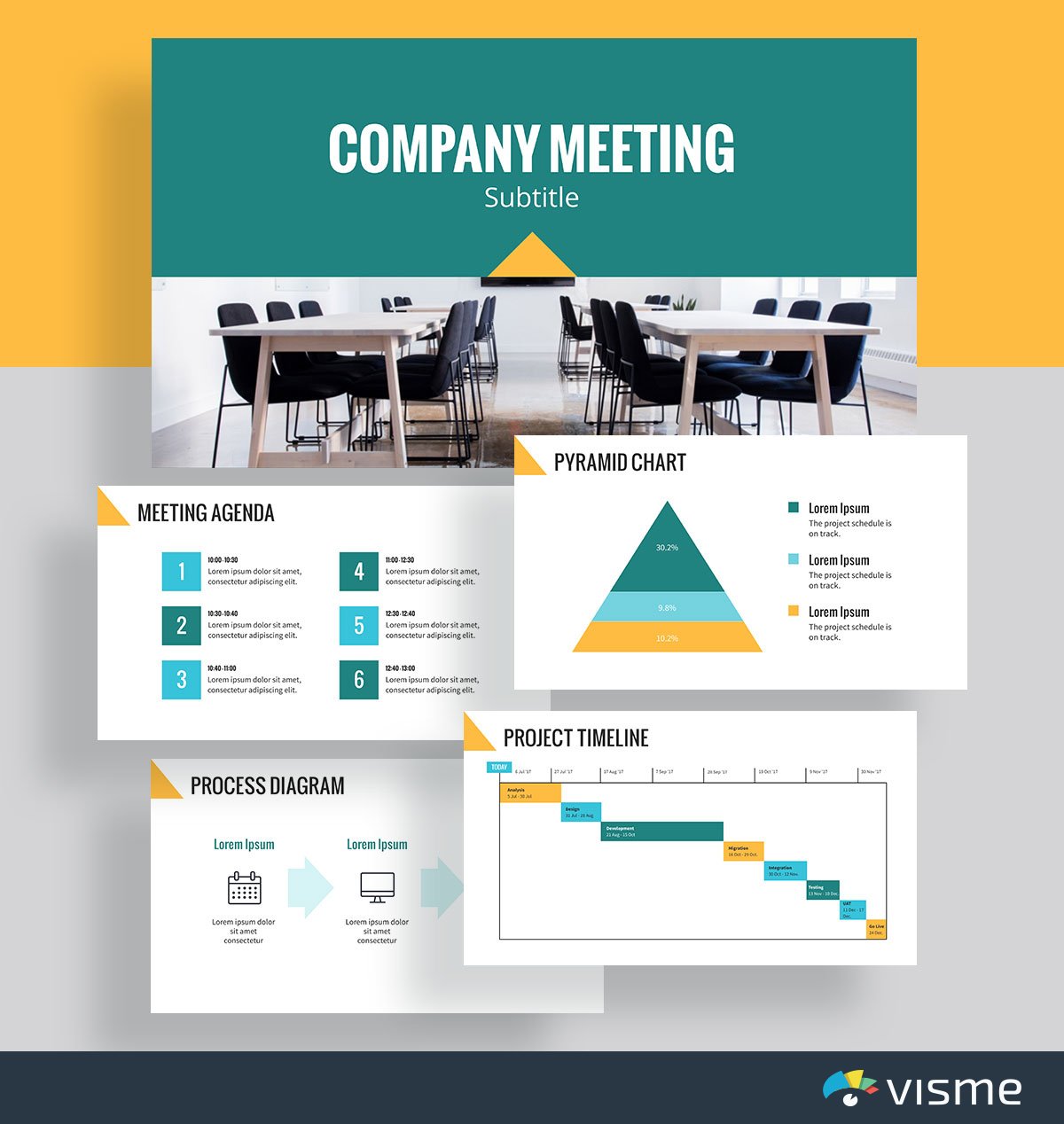
51 Best Presentation Slides for Engaging Presentations
Business Presentation Slides
Finance presentation slides.
- Sales & Marketing Presentation Slides
Education Presentation Slides
Pitch deck presentation slides, nonprofit presentation slides, presentation slide faqs.
There are so many reasons you might need to give a presentation in your business or career. And we’ve got just the right templates to get you started.
After all, you’re probably spending enough time creating the content and rehearsing your presentation deck. You don’t need to worry about your presentation slide design at the same time.
Here are a few of the best presentation slide ideas based on topic material, like the ones you’re regularly using. And if you're racing against the clock, tap into Visme's AI presentation maker to create eye-catching presentations in seconds. Just input your prompt, provide more context, select your preferred style and watch the tool generate your slides. Customize every part of your presentation with our intuitive editor.
1. Meeting Agenda Template

Customize this presentation template to make it your own! Edit and Download
Sick of seeing team members nod off or lose focus during your team meetings?
Put together your meeting agenda ahead of time using these presentation slides to help keep your team engaged and informed throughout.
This template comes with 15 premade presentation slides that cover everything from project management to charts showing performance and overall meeting objectives. Whatever you need to share in your meeting, you can find in this theme.
Plus, you can completely customize these business slides to match your company colors directly in Visme!
2. Company Goals Template
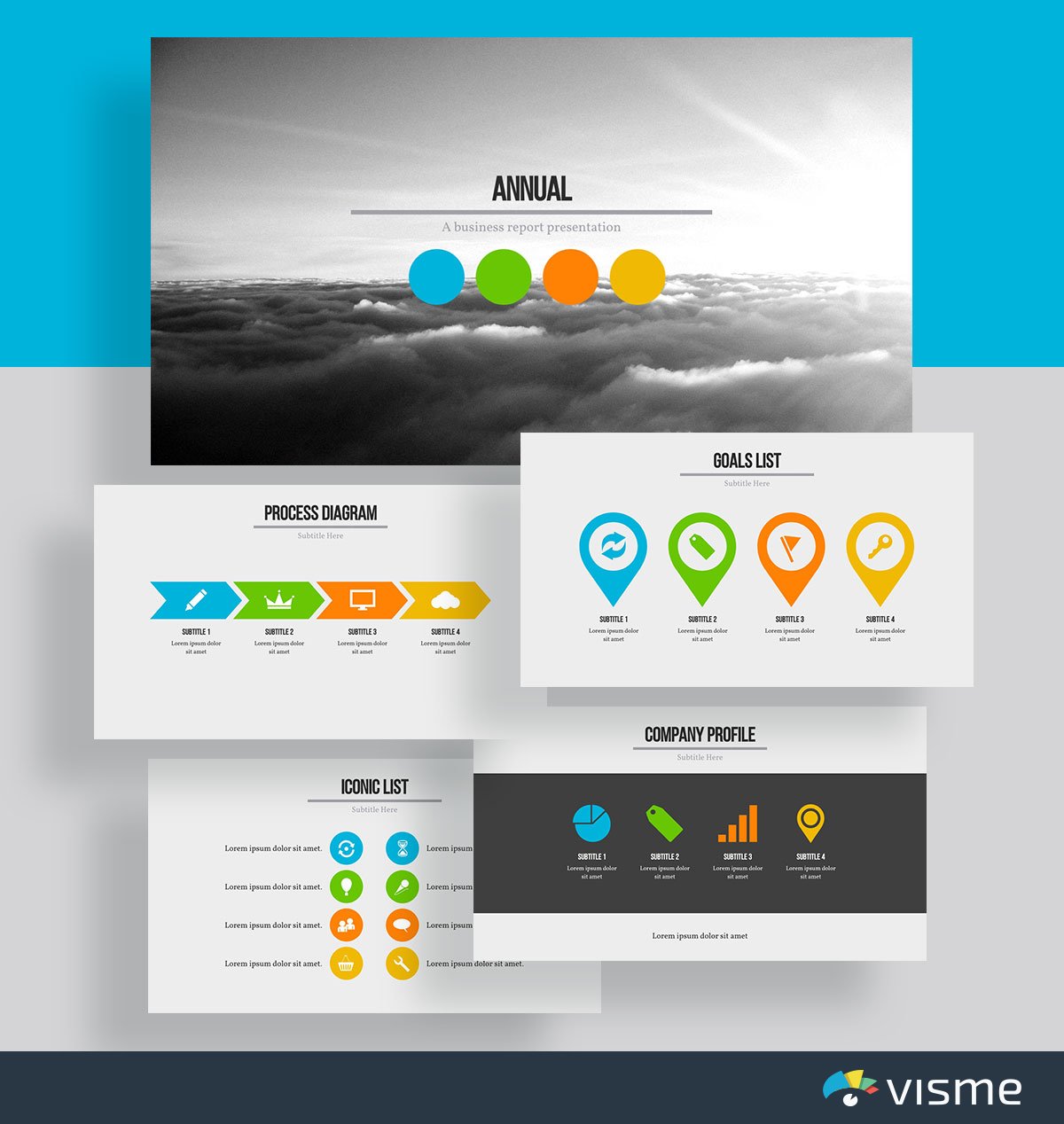
It’s important to ensure everyone on your team knows and understands the company’s goals. After all, everyone’s work should be geared towards achieving those goals.
You can use these nice business slides to put together a background of your company and how far it’s come, as well as detail your upcoming goals, launches and more.
3. Company Overview Template
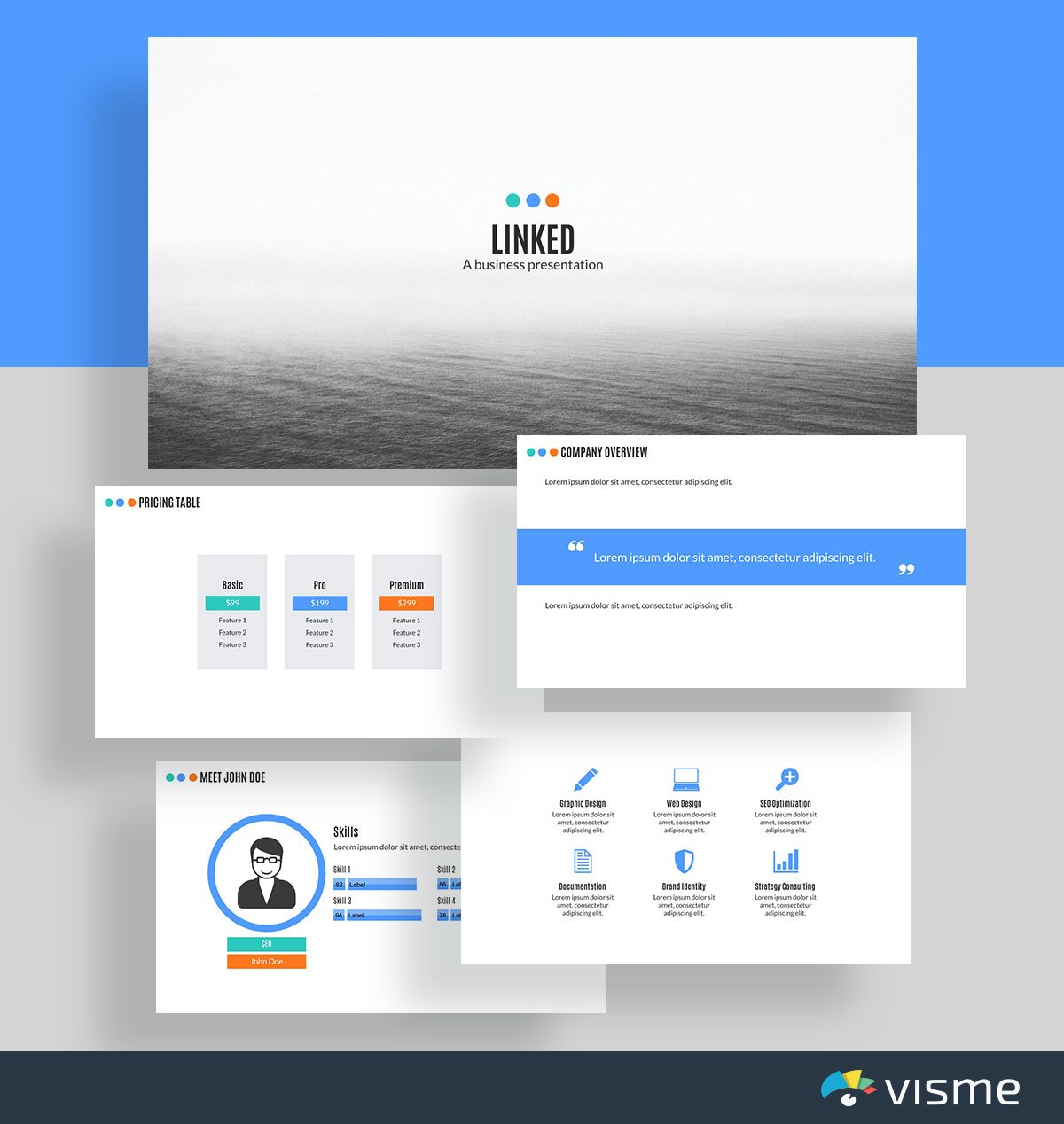
If you’re speaking to a networking group about your company or pitching to investors, you likely need to give an overview of your company, its leadership team and its offerings.
These are the perfect presentation slides to help you put together a minimalistic design that draws focus towards your company and its mission.
Plus, all of these good-looking slides are perfectly set up to highlight your company’s most important assets.
And best of all, they’re completely customizable. Add in your own brand fonts and colors to create the perfect presentation for your business.
Make the goal-setting or design process a collaborative activity with the help of Visme’s collaborative feature . Team members can edit your presentation, leave feedback and draw annotations in real-time or at their own pace.
4. Project Status Report Template
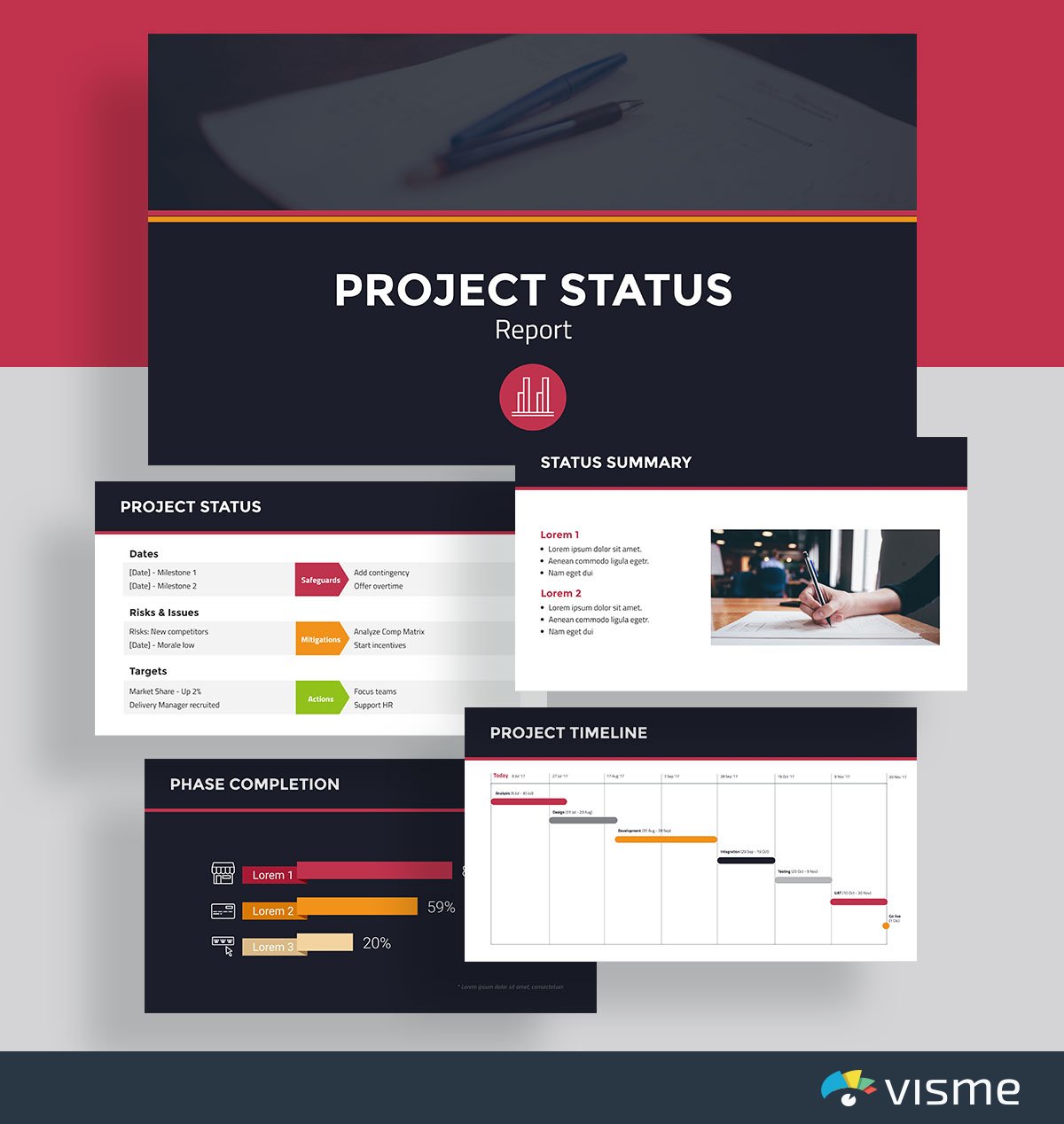
When it comes to project management, you could always just send over a boring email or report update, but a better way would be to put together a presentation updating your team and/or your supervisors on the status of the project and the remaining timeline.
This presentation theme comes with 14 different slides to help you put together a status report that covers all aspects of your project: the various phases and how far along each one is, the timeline for your project, a project health card and more.
You can also gain even more inspiration for your project timeline slides from these timeline infographic ideas .
5. Business Annual Report Template

Want to show your boss how the company is doing? Or share how your team’s efforts have affected the bottom line? Put together a presentation that shows your business’s results over the year.
While this presentation template comes with a fun geometric accent pattern, you’re able to swap out any of these shapes for ones that more accurately represent your business or your message right in Visme’s design dashboard.
Working on this design with your team? Effectively manage the process with Visme’s workflow management tool . You can assign different sections of the slide to your team members to work on set deadlines, manage progress, track corrections and more.
6. Business Plan Template
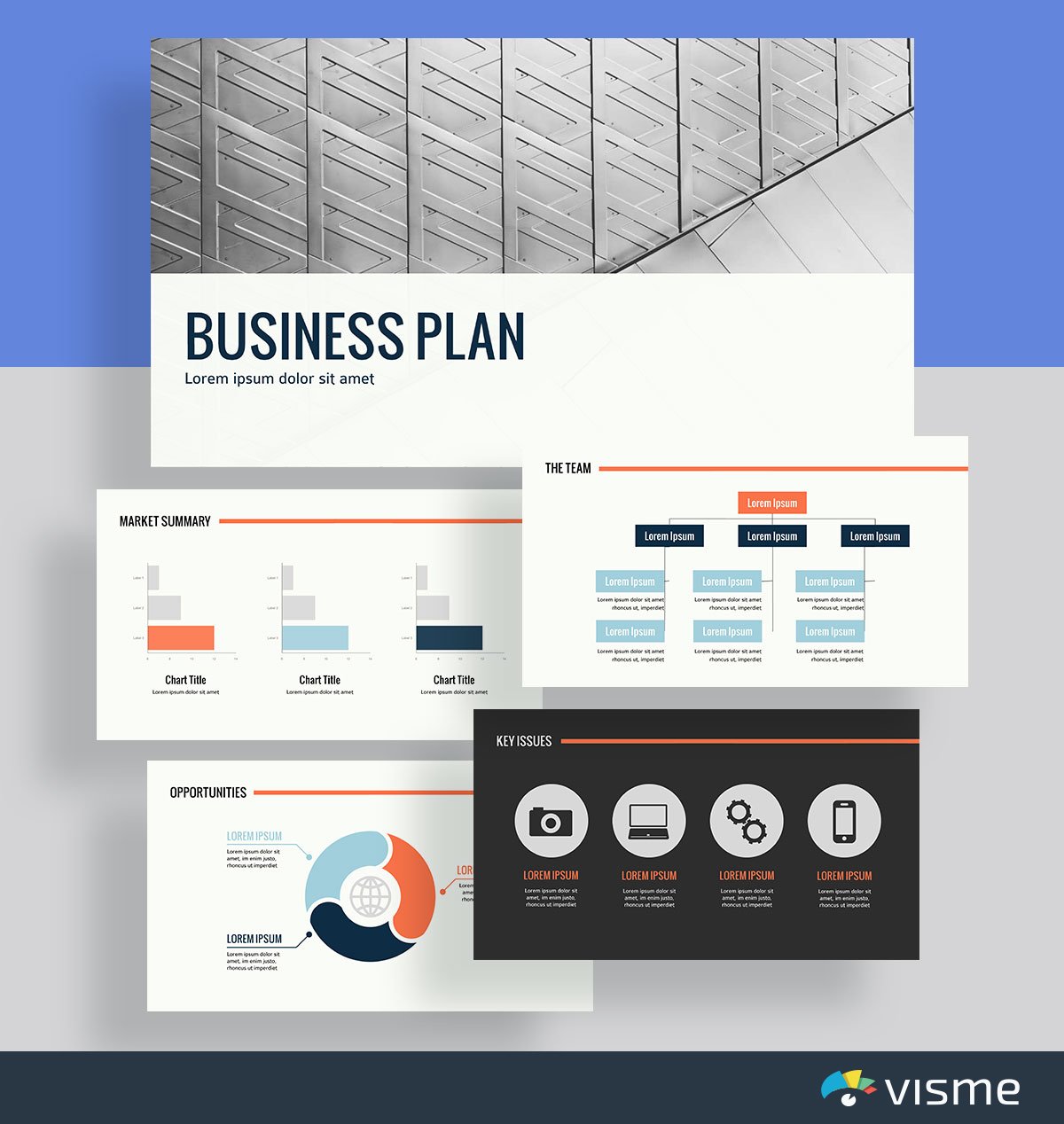
Are you starting a new business? You might be looking for investors, or perhaps you want to pitch the idea to a potential cofounder. You need to deploy the best presentation slides possible.
You can use this theme to put together a polished business plan presentation that showcases your business idea, the market summary, the industry opportunities and more.
You can also use Visme’s color themes to find the perfect color scheme for your presentation and your upcoming business. After all, your brand colors can say a lot about your business.
7. Product Introduction Template
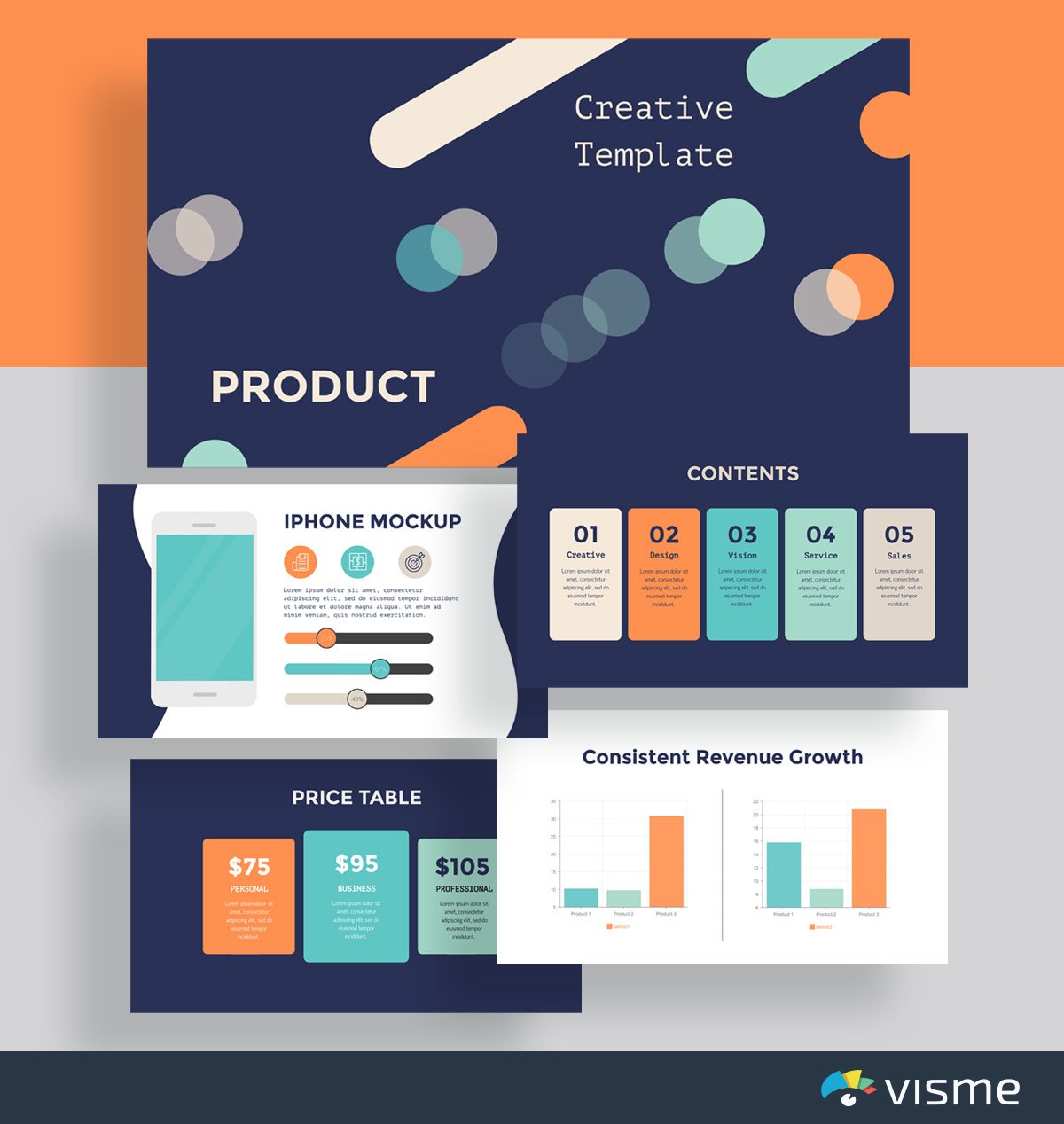
Put together a presentation that introduces a new product idea to your boss, your board of directors or your investors. Take advantage of the charts and graphs in Visme’s design dashboard to showcase various studies and statistics that prove why your idea will be profitable.
Or you can utilize this presentation theme to introduce a product to the public. If your company is in the process of developing a new product to release, a presentation introduction can be a great and engaging way to share it with your audience.
8. Product Presentation Template
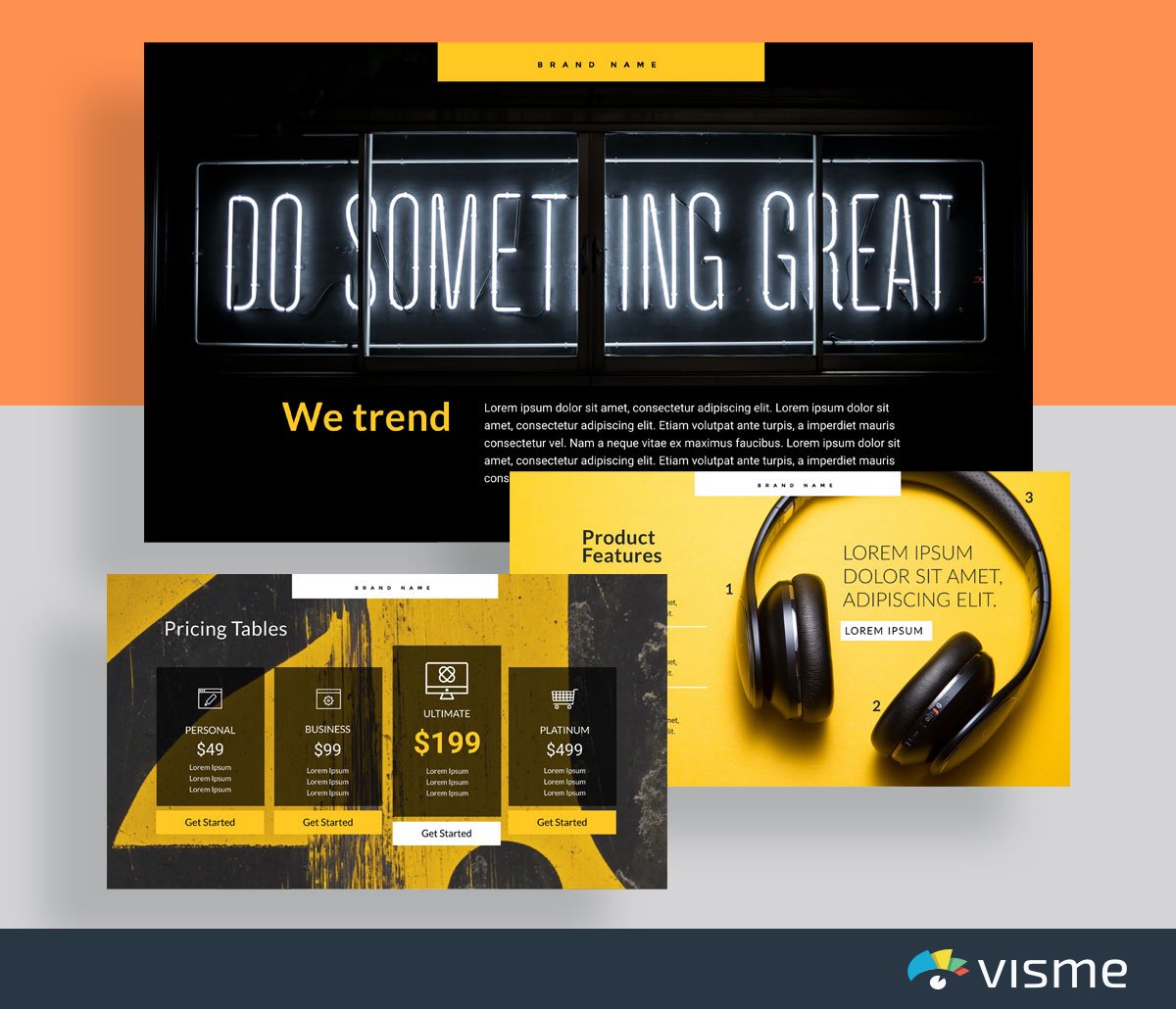
Whether you’re launching a new product or sharing the features of an already existing one, you can show off your product through a presentation with nice slides.
You can share your presentation on social media, on your website or at a large company event to announce it to your audience. Include bright, high-quality photos of your product and a list of its best features to really highlight your new release.
9. Visual Brand Identity Template
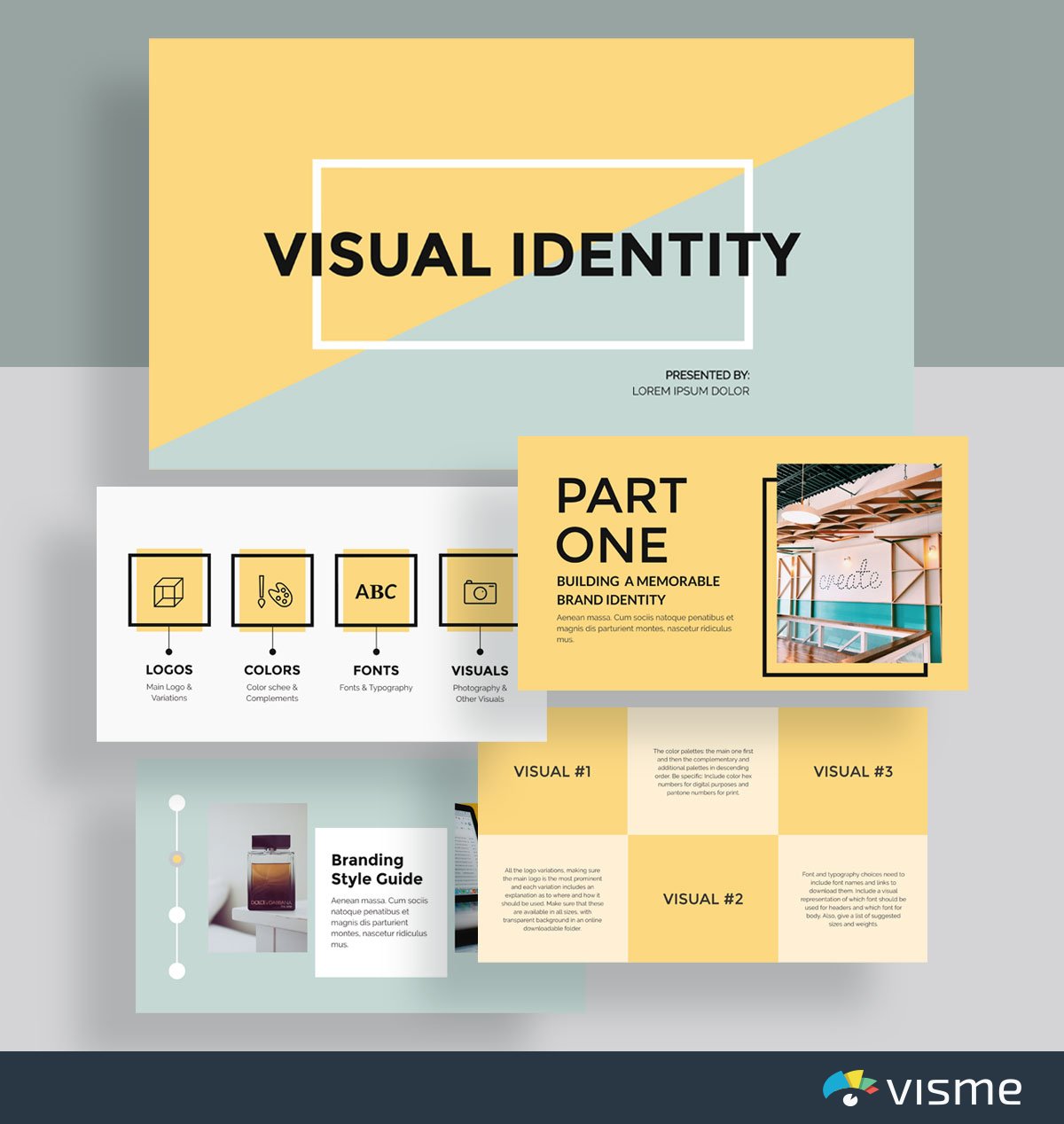
There are many different ways to create a brand style guide for your business. One great way is with a presentation.
These presentation example slides allow you to seamlessly input your fonts, colors and other visual guidelines into a single presentation so that you can easily share your brand with the designers, marketers and other members of your team.
10. Special Business Presentation Template

These presentation slides can help you easily put together a business introduction template for a conference or networking event.
Just click above to edit in Visme, switch out your background with one of the thousands of options in our photo library, add in your own key facts, vision and values and download!
If you’re running out of ideas for your presentation , you can use Visme’s Writer AI to produce high-quality drafts, proofread your content or adjust its tone.
11. Industry Trends Template

Put together a presentation to showcase upcoming trends in your industry. You can leave the patterns and colors the way they are in these existing presentation slides, or you can add in your own brand colors or product colors.
Understanding developing trends in your industry each year is important so that you know where your business should focus its efforts.
Sharing a presentation with your team is a great way to stay ahead of the curve.
12. Services Template
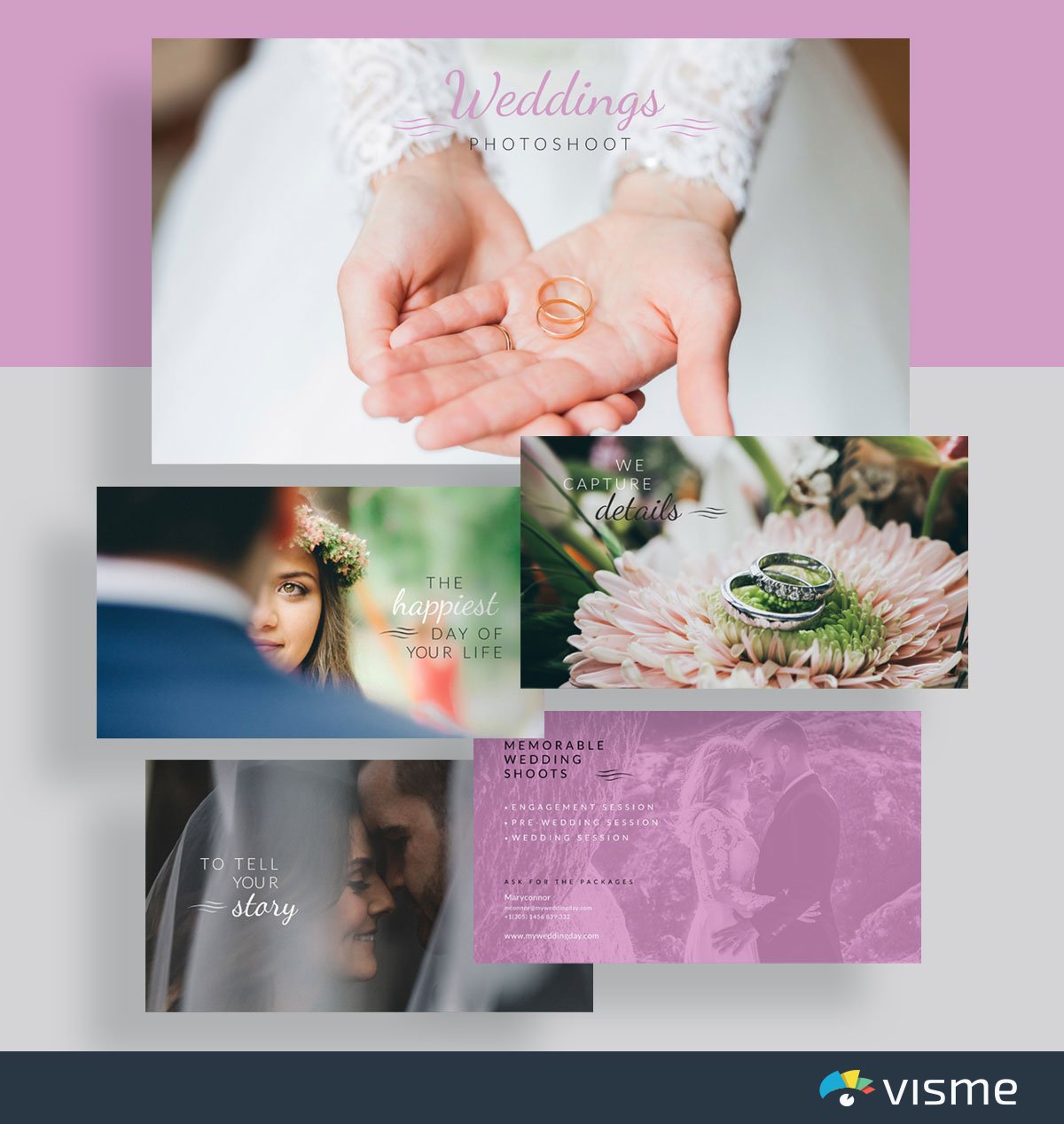
Use these slide presentation examples to showcase your services and what you can offer your clients/customers. If you have a visual business, a presentation is an excellent way to highlight your work and show it off to prospective leads.
Swap out each photo in the example slides with photos of your work, update the fonts to match your brand voice (or upload your brand fonts) and add in the services you offer.
13. Slideshow Template
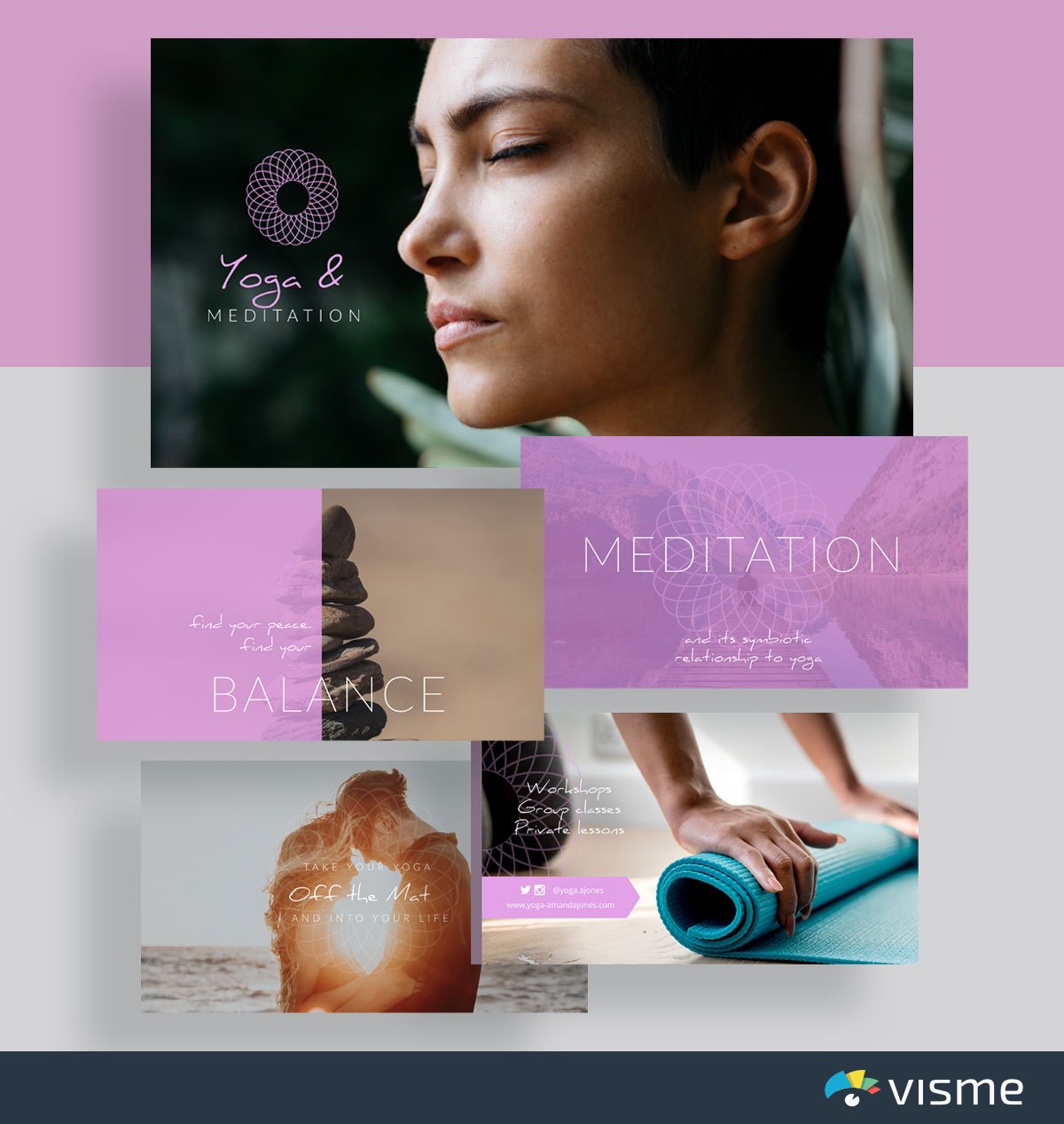
A slideshow presentation is a great way for you to showcase photos of your work alongside your service offerings. This template even includes social media icons on the last page so that viewers know how to find the business online.
Again, you’ll want to swap out all of the photos with your own work, but this presentation theme is a great way to get started.
14. How To Presentation Template
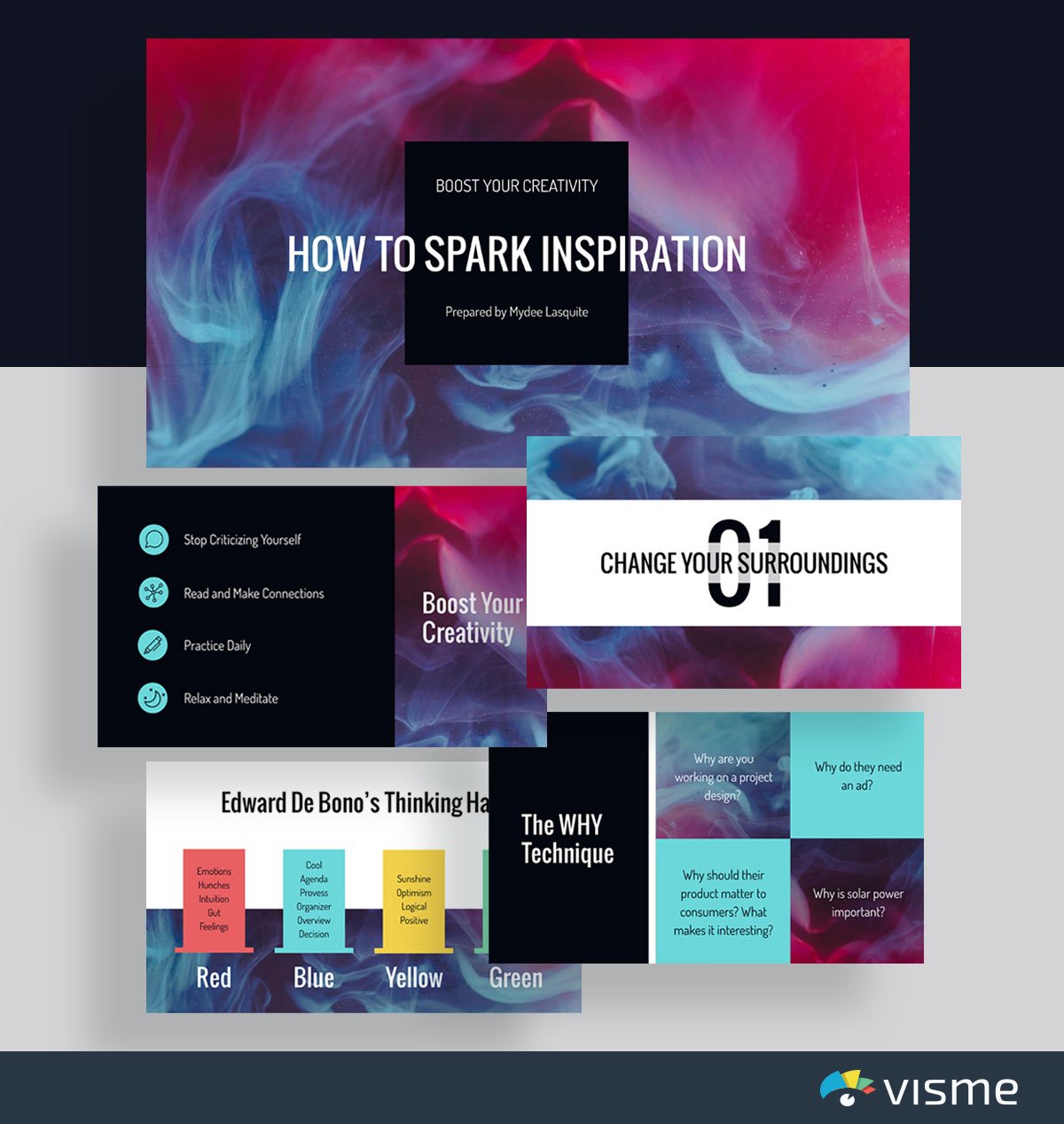
Are you presenting a tutorial or step-by-step guide on how to do something? Using example slides to put together your content is a great idea.
It’s a disservice to your company and your customer to assume that everyone automatically knows how to use your product or service. Showing your audience exactly what to do is essential to your customer service strategy.
Spice up your presentation by adding stunning, high-resolution images and stock photos , videos , icons , widgets and other design elements.
Didn’t find any photos that caught your eye? We’ve got you. Use Visme’s AI image generator to whip up captivating images that match your presentation theme and design.
Even if you have photos that need editing, use Visme's AI Edit tools to touch up, unblur, upscale, erase and replace images with one click.
15. Survey Results Template
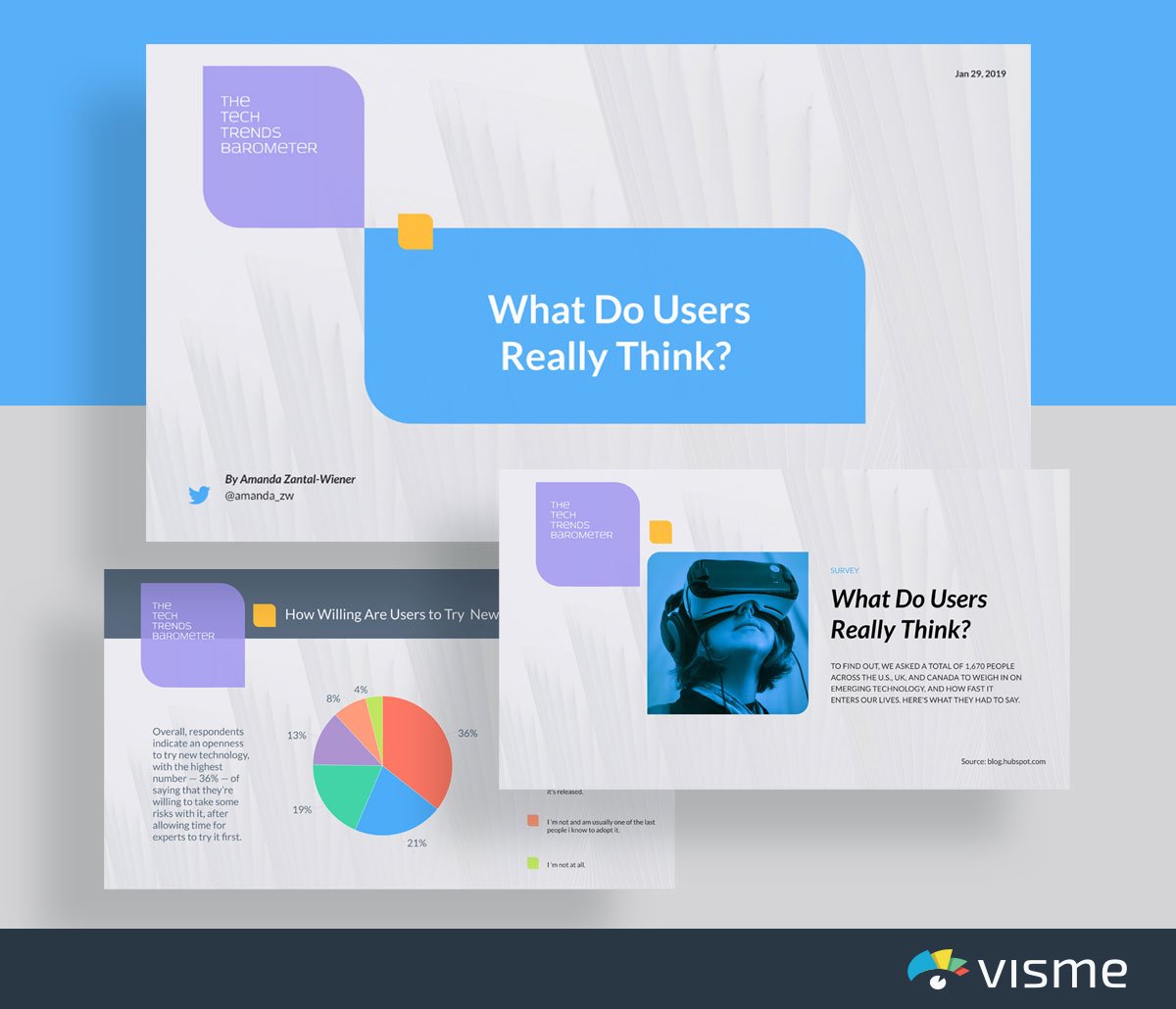
Putting together a customer survey is a great idea to understand how your audience feels about your industry or even your company. Grab those results and insert them into these presentation slides to share with your team.
You can also put together a blog post or webpage with survey results and embed this presentation directly into it so your audience can understand the state of the industry as well.
Visme’s design dashboard allows you to add in various charts and graphs that adjust automatically based on the numbers you input. After all, ain’t nobody got time for manually adjusting the sizes of bar graphs and pie charts.
16. Company Overview Presentation Template
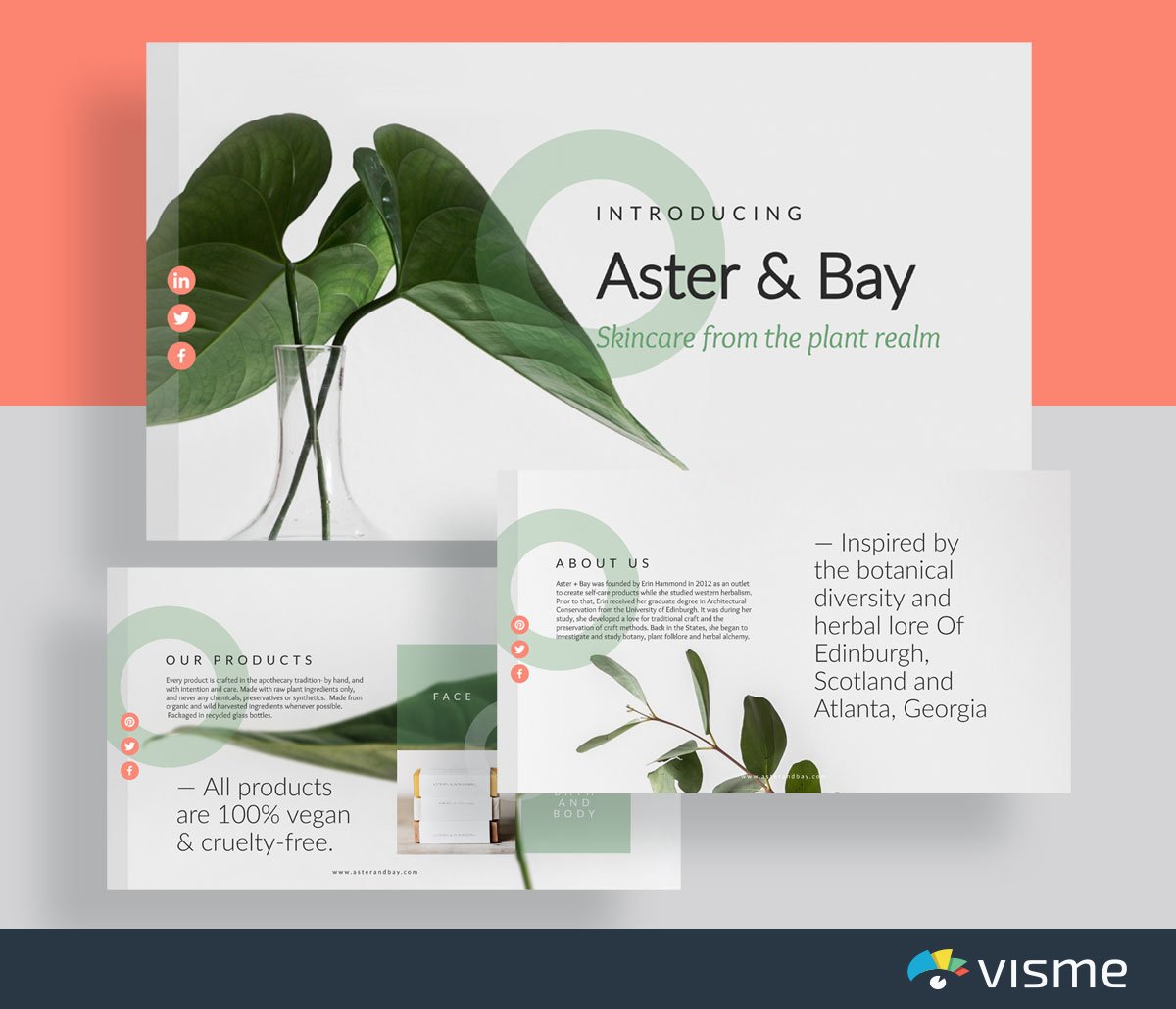
Utilize these beautifully designed presentation slides to create a brief overview of your company and its offerings.
Having a readily available presentation overview of your company is a great idea for when you’re pitching investors, journalists for coverage and more. You don’t need to recreate a presentation each time. Instead, put together a visually appealing and informative one-size-fits-all overview.
You can add in your own photos or choose from Visme’s photo library to keep the same beautifully minimalistic appeal.
When sharing financial information, it’s always helpful to put together some kind of visual aid. This can be used to further emphasize your content, whether it’s about going over budget, showing off exciting revenue increases and more.
Check out these finance slide presentation examples to find the perfect template for your goals.
17. Financial Report Template
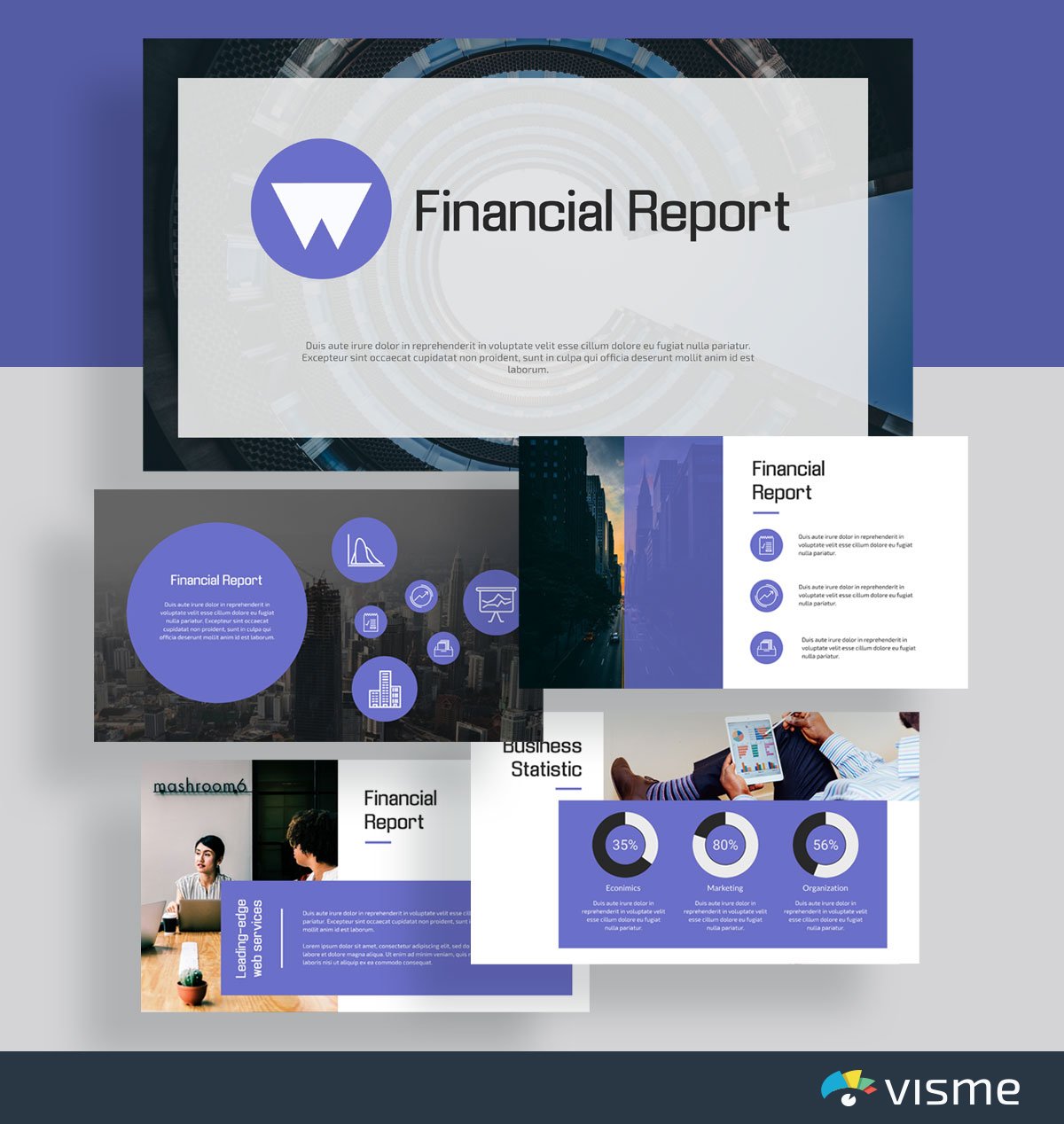
Use this template to put together a presentation that goes over your company’s expenses, sales, profits and more.
The built-in data visualization options allow you to showcase your point with more than just numbers. Add in a table of contents to keep your report organized and cohesive, letting your team know exactly what information they’ll find inside.
18. Statistical Presentation Template
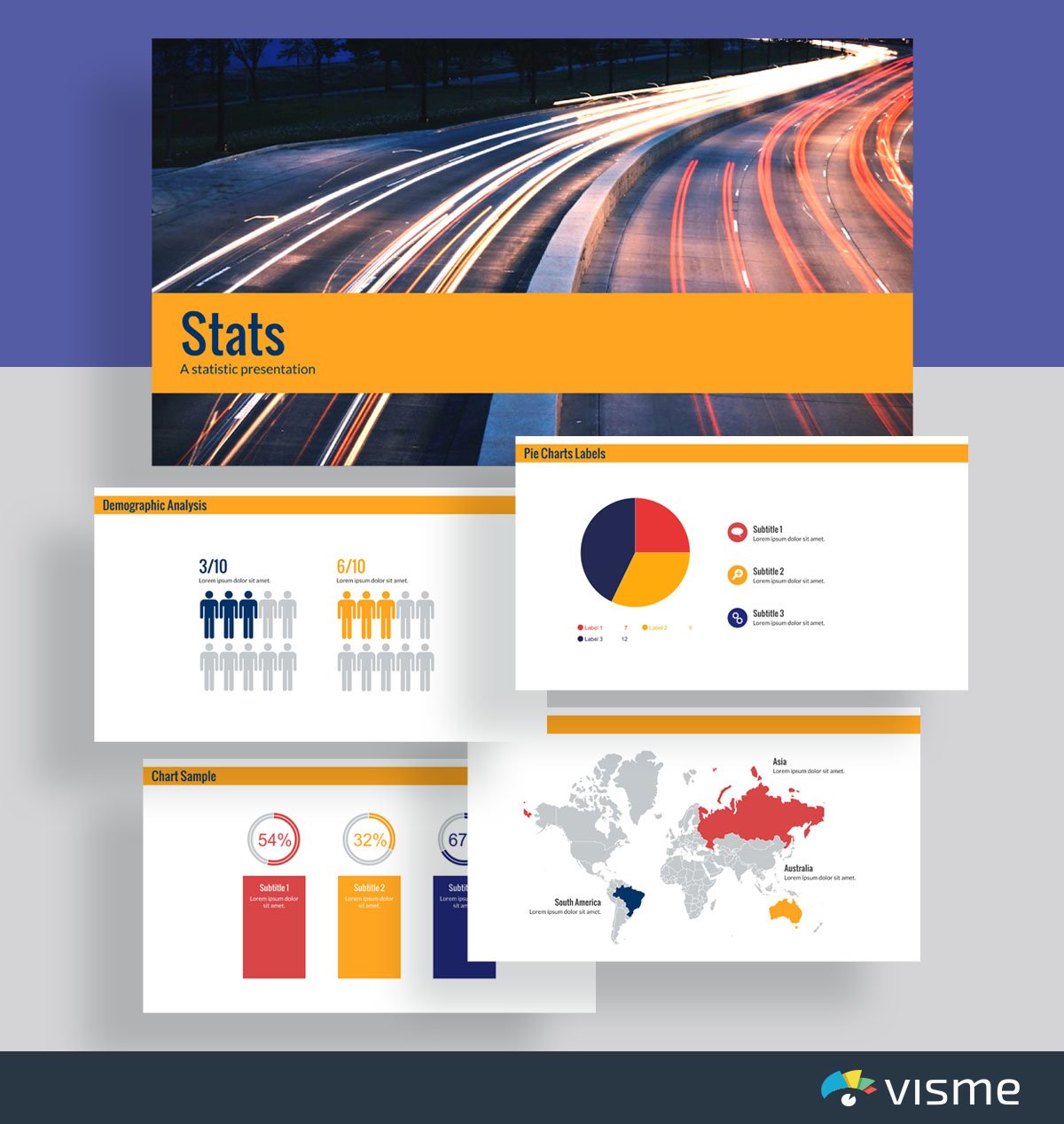
Need to report some financial statistics and data? These presentation slides are perfect for helping you insert cold, hard facts into your presentation.
Each slide includes a different type of chart or graph for you to choose from to fully represent your data and statistics. You can easily switch your color scheme by inputting your own brand colors or by choosing a preset color theme from Visme’s dashboard.
19. Map Presentation Template
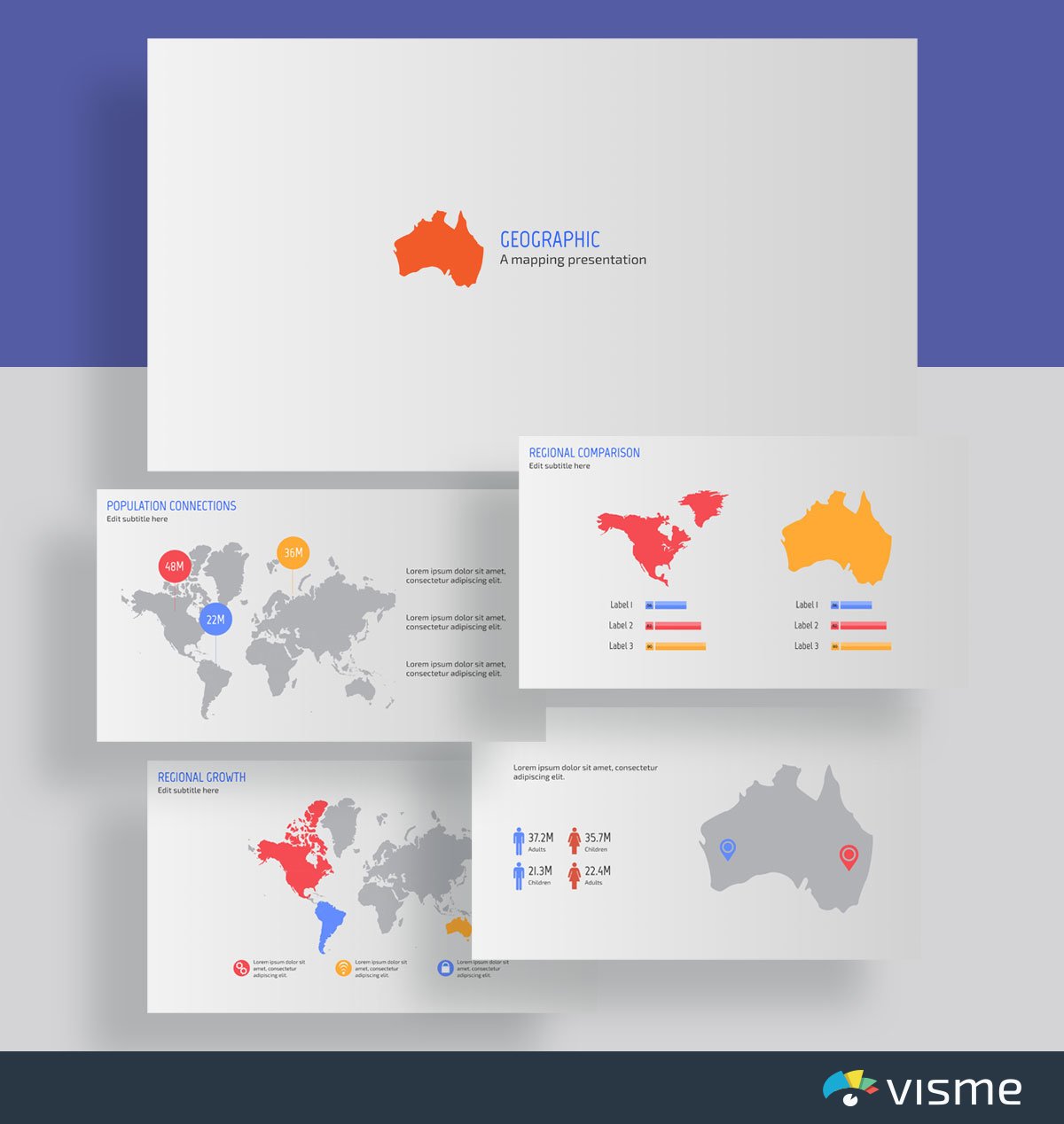
It’s important to know where it makes the most sense to market your product geographically. Showcase sales and overall company growth and profitability by location.
Knowing your revenue based on geographic location is essential for a global company, and this presentation template is perfect for the job.
Create a stunning presentation in less time
- Hundreds of premade slides available
- Add animation and interactivity to your slides
- Choose from various presentation options
Sign up. It’s free.

Sales and Marketing Presentation Slides
When it comes to sales and marketing for your company, there is a lot of data and information that can be represented visually. Creating sales and marketing presentations helps with keeping your team on the right track, but can also be a great way to make a pitch.
Learn more about creating essential sales and marketing presentations with these templates.
20. Visualization for Sales and Marketing Template
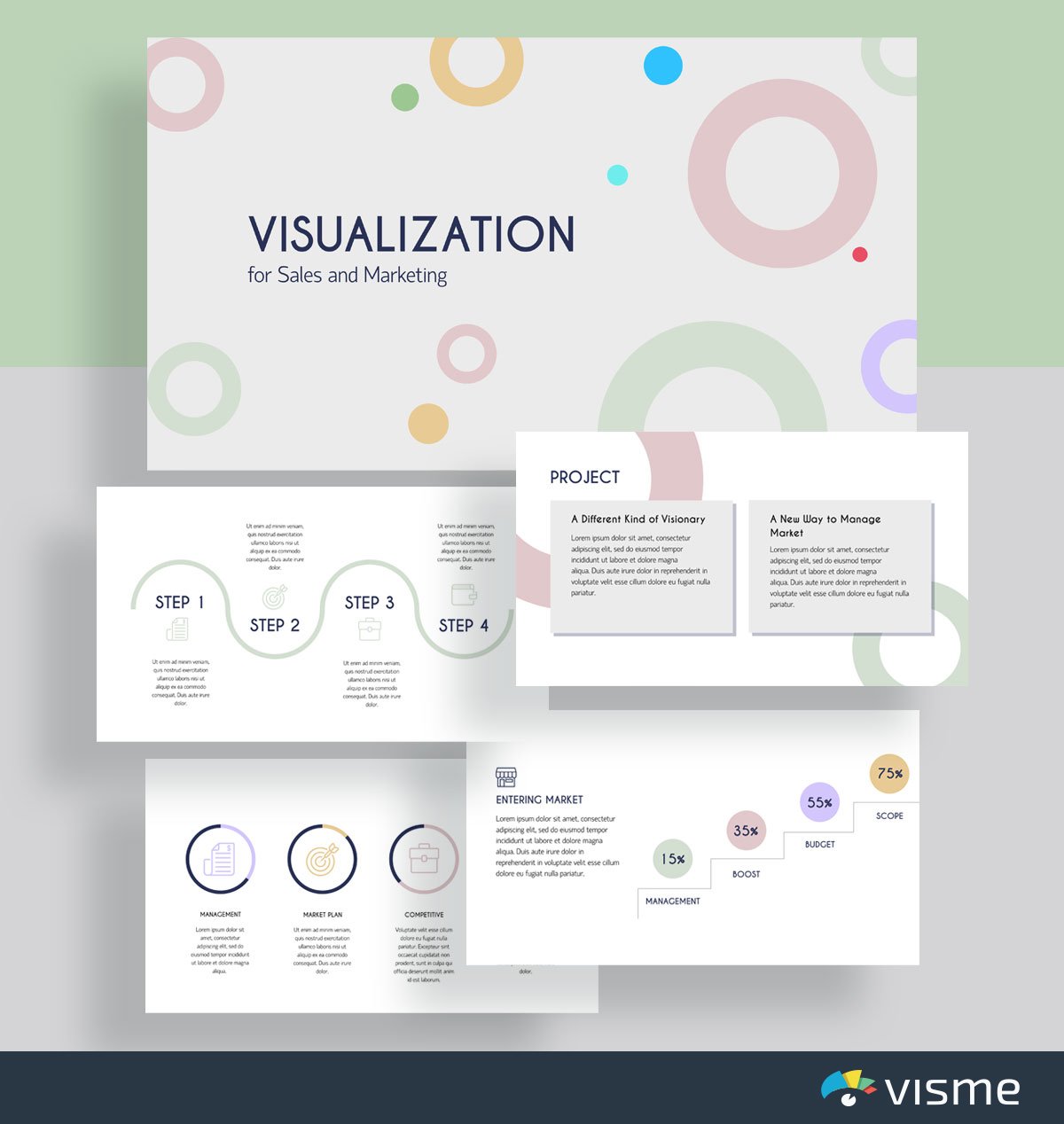
When you’re putting together a sales and marketing plan, you have to present it to your boss for approval, then to your team for implementation.
Use these presentation slides to help visualize your sales and marketing plan , including each of the upcoming tactics and strategies and the steps for putting them in place.
Having a presentation to refer back to allows your team to ensure they’re implementing the strategies properly.
21. Simple Marketing Presentation Template
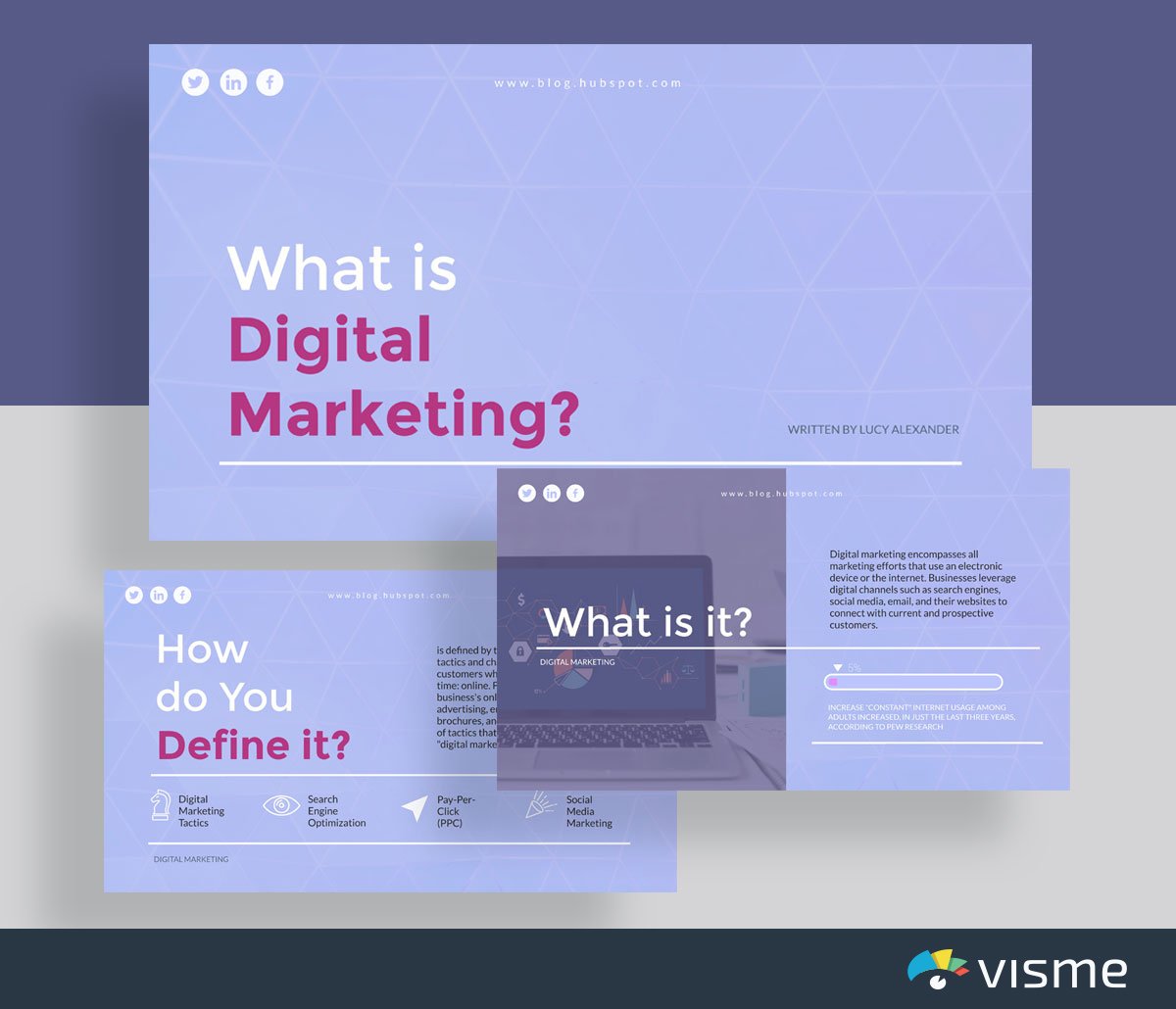
Whether you’re introducing new marketing ideas to your team, pitching a new marketing strategy to your boss or to a new client, a presentation with nice slides is the perfect format.
Grab this presentation template that helps you to define your new ideas and share specific tactics for how they should be implemented for the business. Then get ready to rock your pitch and share your awesome new ideas.
22. Market Analysis Template
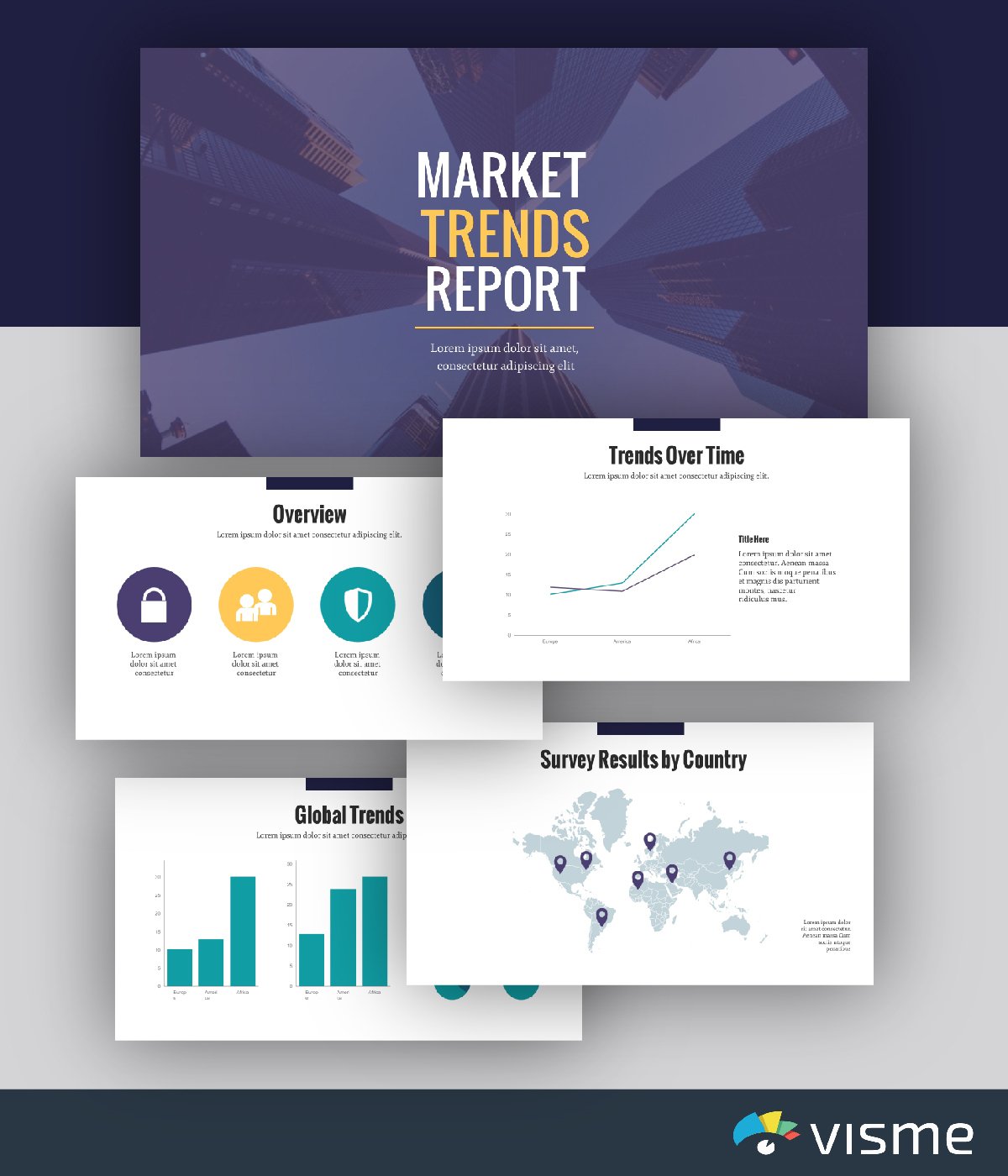
Review market trends with your team so you know where to take your company’s marketing messaging. You can send out a customer survey or take a look at a few studies that have been done surrounding your industry to put together your market analysis report.
Input all of your findings into this presentation template so you can easily present it to your team or grab the link and send it in an email. Even if you’re not standing up to give a presentation, these presentation slides are still an engaging way to share necessary information.
23. Marketing Plan Template
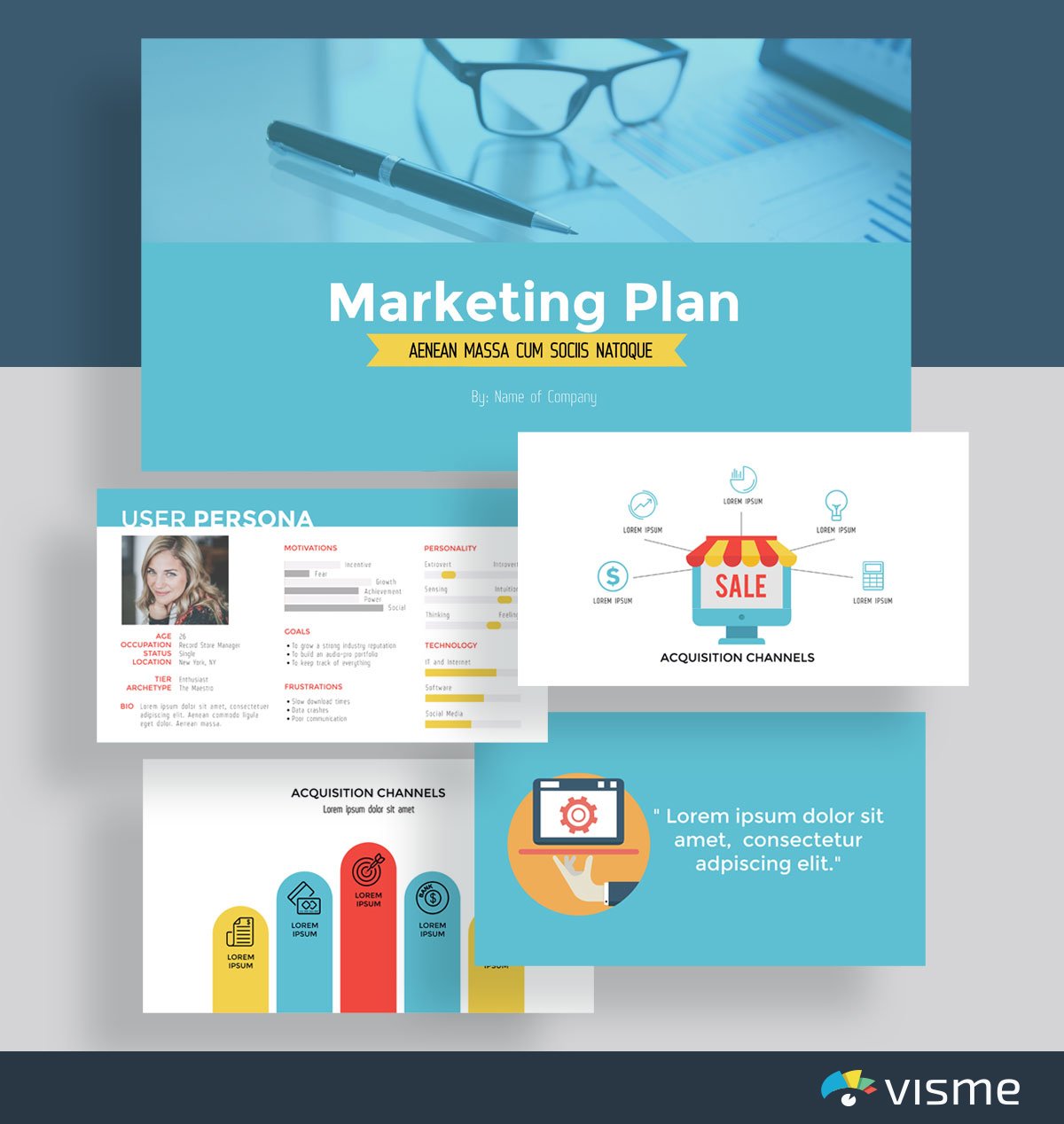
Building a new marketing plan for your business? Put together great presentations for your marketing plan to share with your team.
Presenting your new marketing plan to the company is a great way to get everyone motivated and on board with new strategies and ideas.
You can add in your goals, objectives and even user personas with this ready-made marketing plan template.
24. Sales Report Template
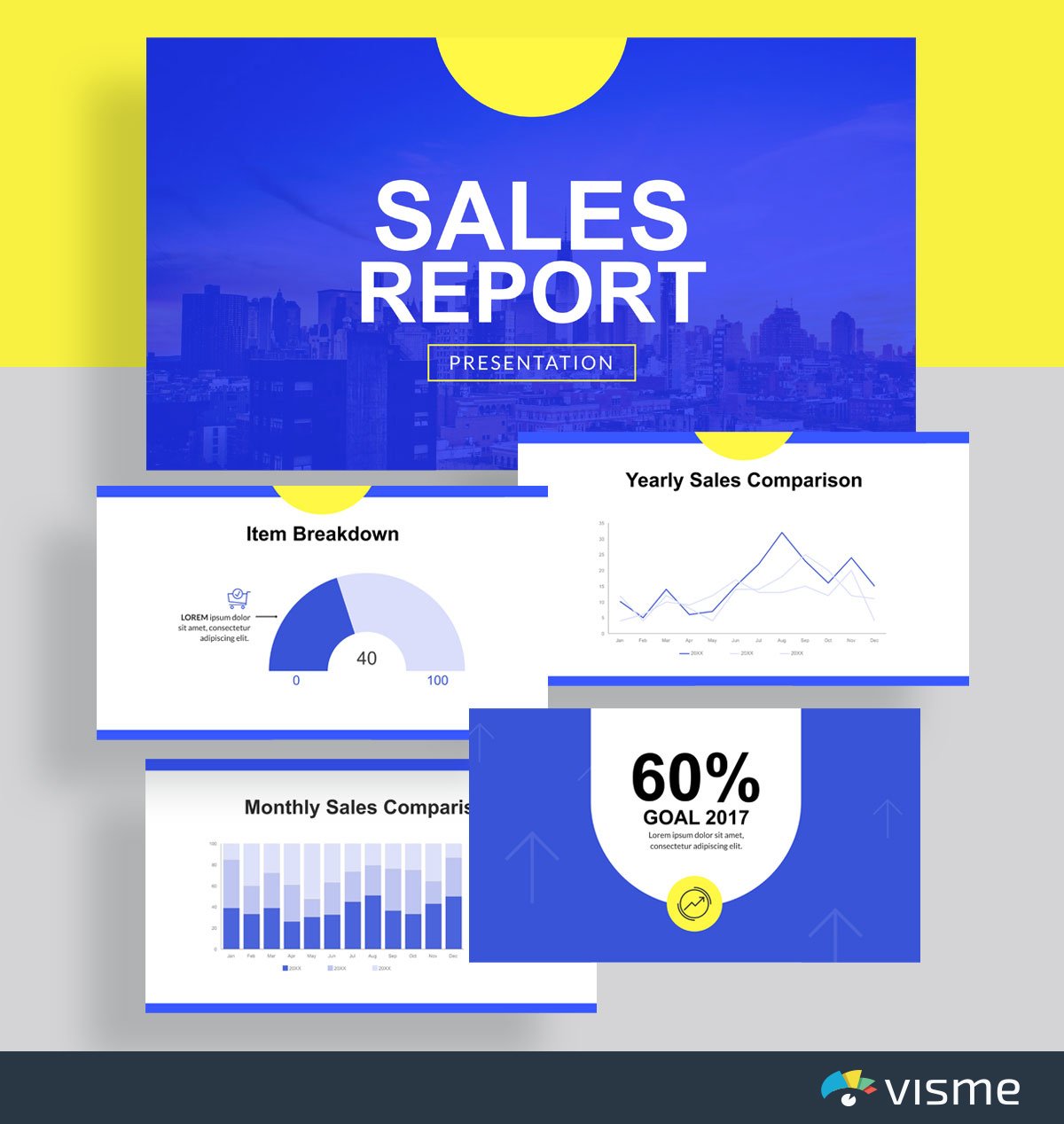
Your sales team should be regularly providing insight on how much revenue the company is generating. And a great way to do that is through a sales report presentation or slideshow.
It’s important to stay informed of sales growth throughout the year. Share graphs of sales quarter-over-quarter or year-over-year to see where the company/sales team needs to improve.
25. Press Release Template
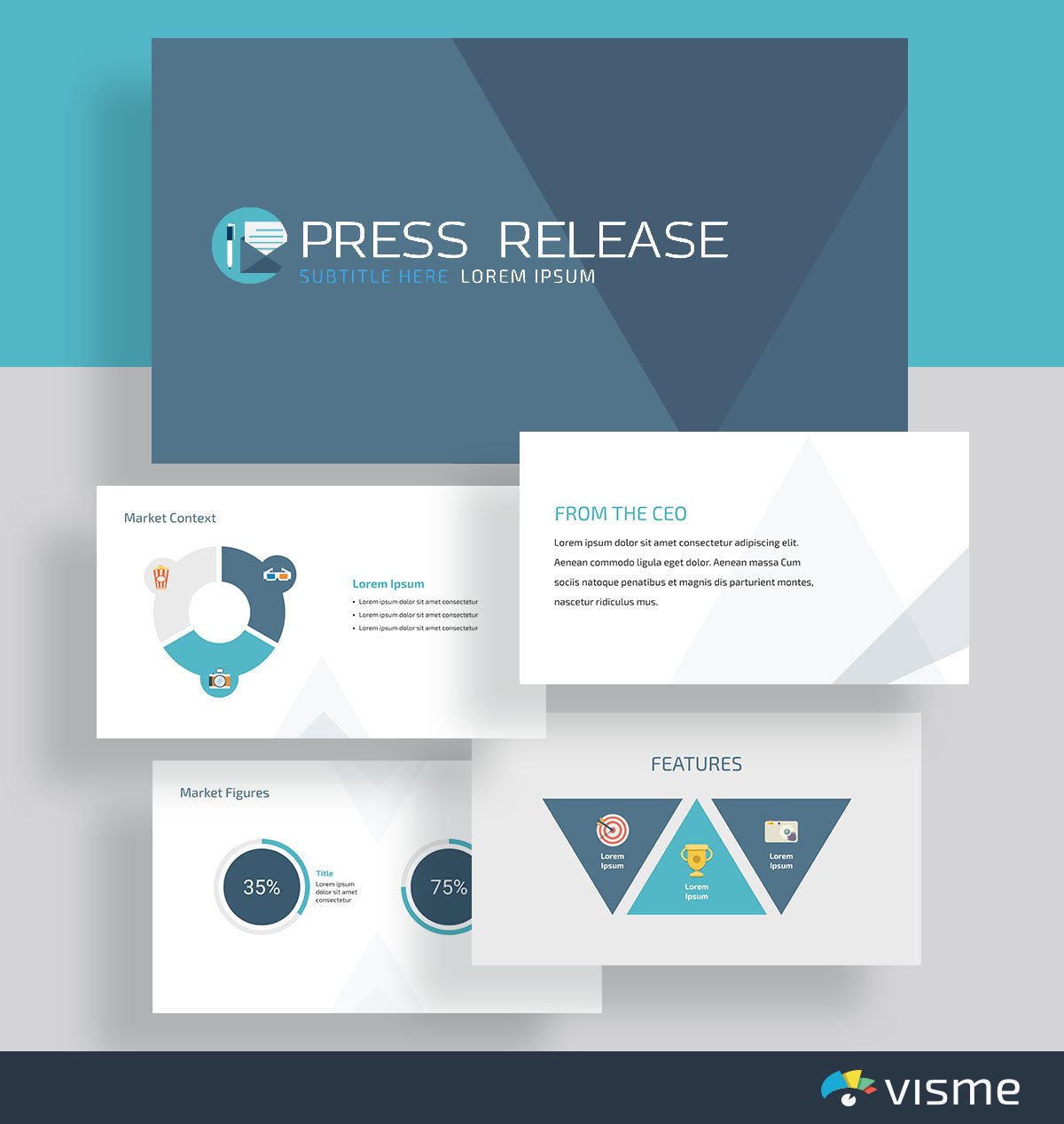
Don’t just write a boring old press release to send out to journalists and media publications. Instead, create an interactive press release showcasing your launch.
A presentation press release will help your business stand out from the dry press releases most publications receive, offering even more incentive for them to highlight your business and its products/services.
Edit this business slide to add in your own brand touches, voice and launch information before grabbing the link and sending it off.
26. Social Media Report Template
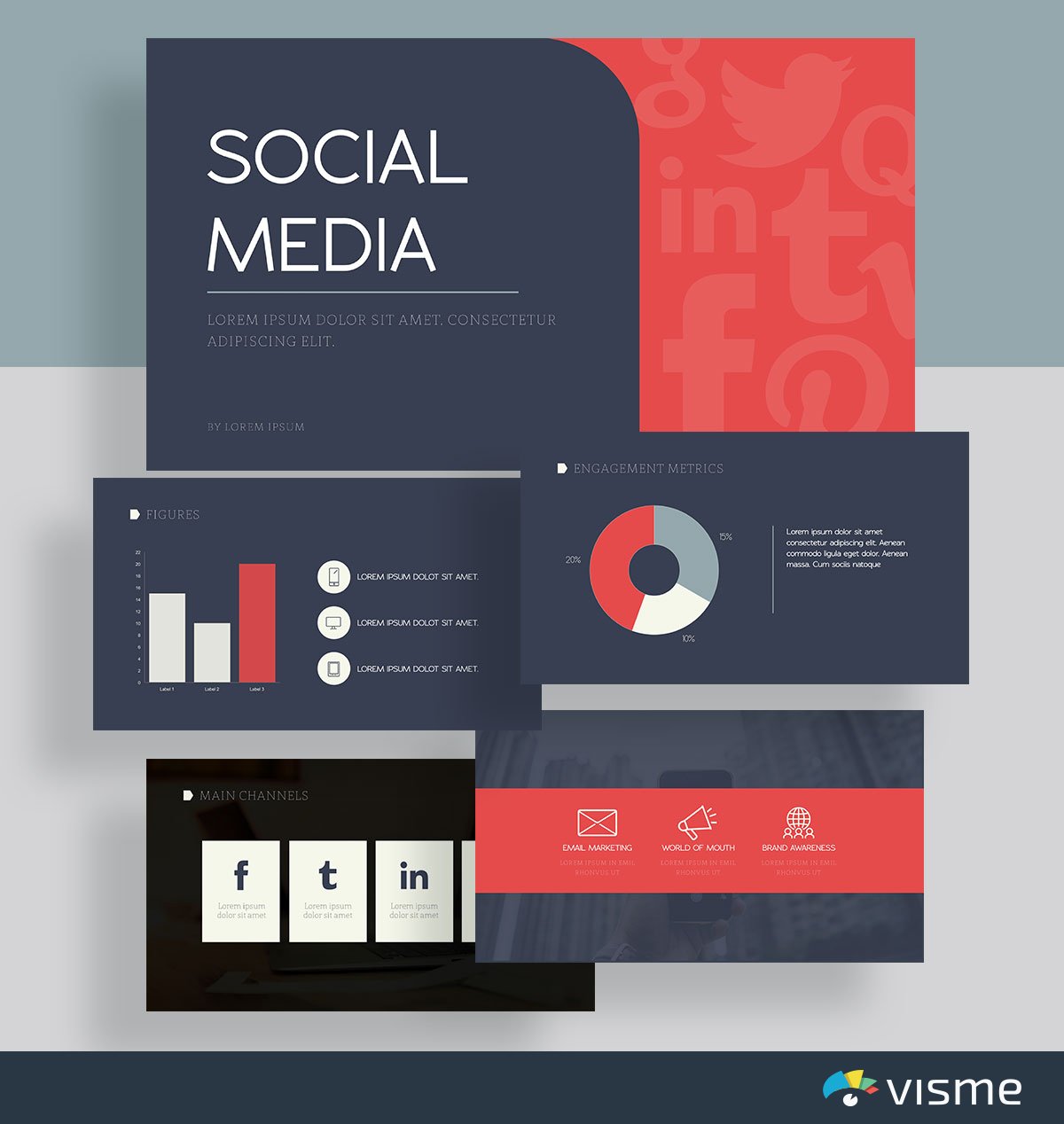
Sharing results of any marketing strategy is always essential. This is how you keep your team updated of any strategies that are working, and any strategies that need some adapting.
This presentation theme is a great way to share your current strategy and results. Input your platforms, your strategies and your metrics before presenting it to your team. Customize the presentation slides so that they cater perfectly to your company’s strategy.
27. Social Media Strategy Template
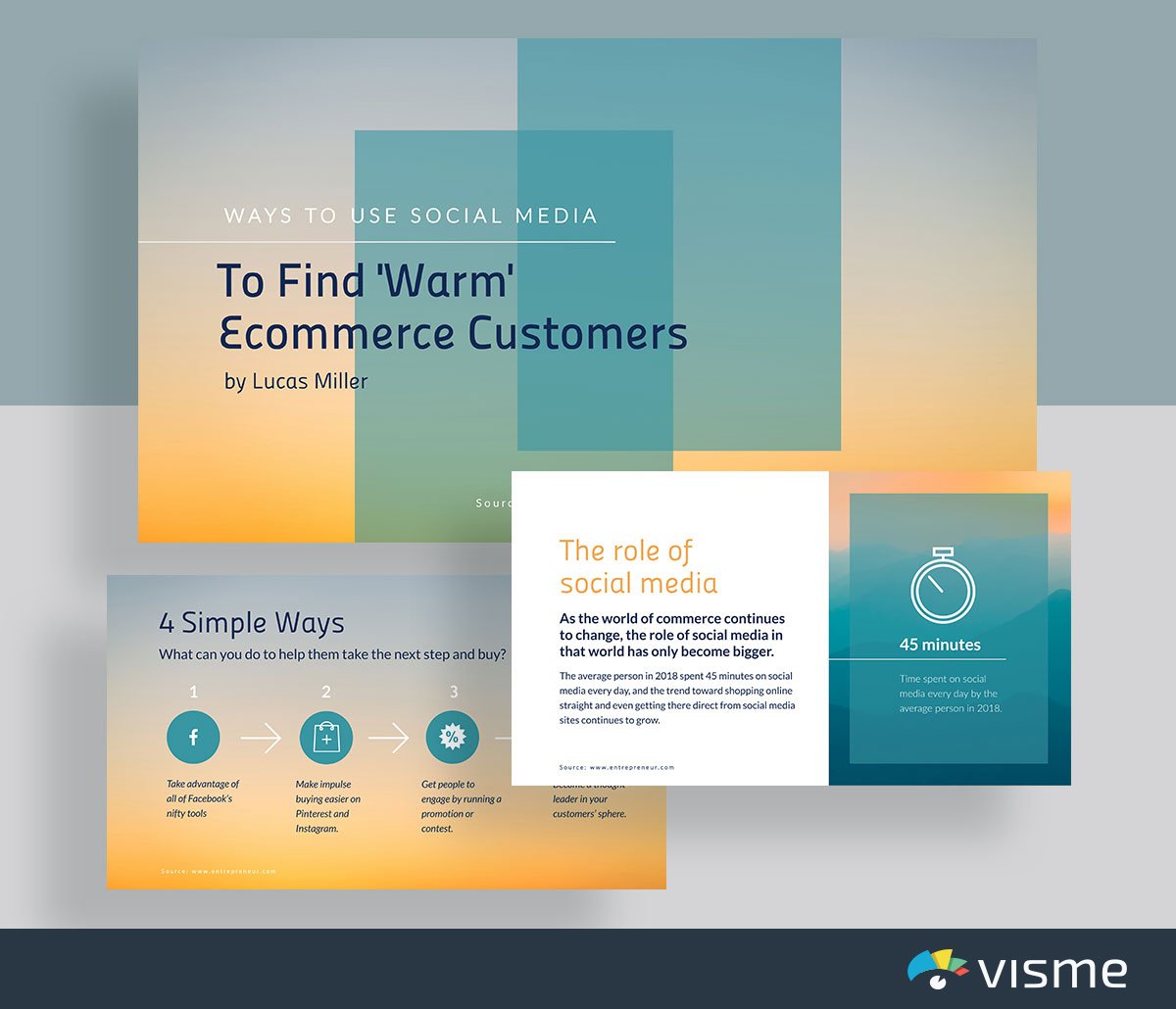
Pitching a social media strategy to your boss can also be done well with a presentation. Showcase why social media is important to invest in, what your plan is and how it will affect the bottom line.
This presentation template already gets you started in perfectly pitching your own strategy. Simply adjust it to your brand colors and fonts and update the information with your own.
Presentations are huge in educational settings.
Whether you’re a teacher looking for an interactive way to share your lesson plan or a student trying to finish up a school project, we’ve got the presentation templates for you.
Take a look at our education presentation slide options to find one that works for you.
28. Training Plan Template
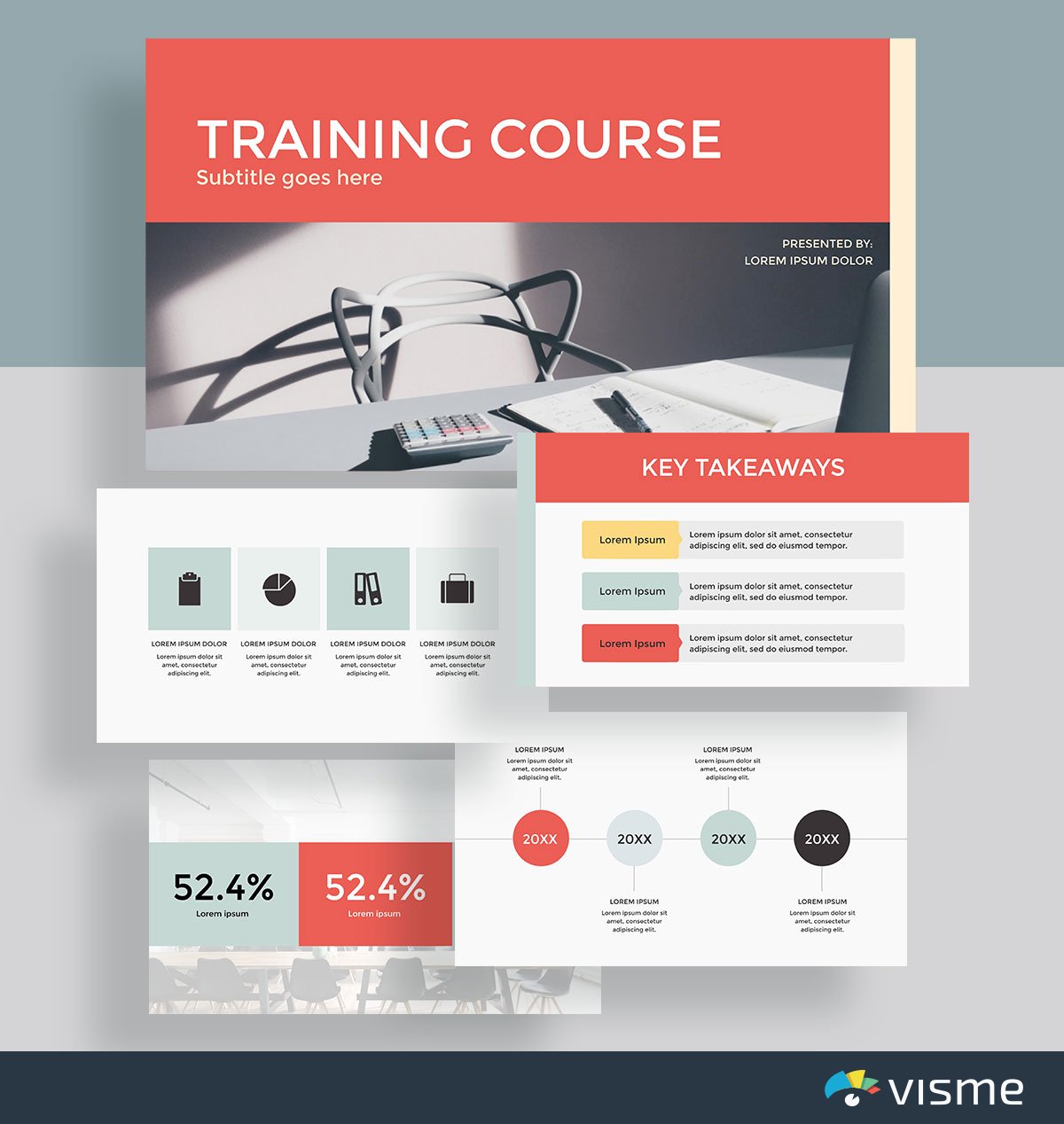
When working one-on-one with a student or mentee, it can be a good idea to put a training or education plan into place. These presentation slides are the perfect start to your lesson and can help to visualize the content and learn in a different way.
Putting together educational content in a presentation helps offer different formats for learning. Students are often not provided with all of the tools they need to learn the material, and an interactive presentation is a great place to start.
29. Book Report Template
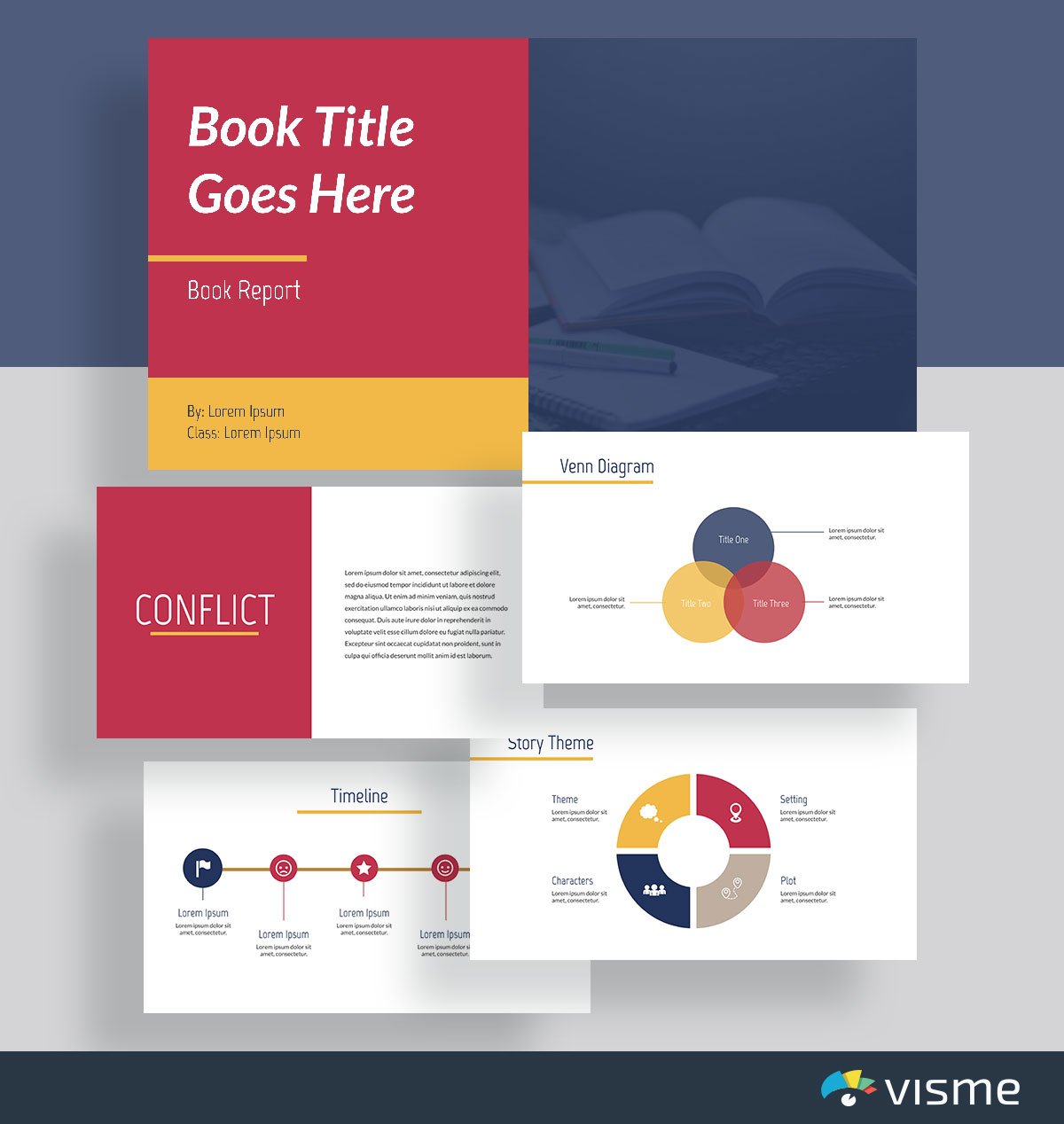
Putting together a book report to present for your class? Get started with a presentation theme that you can fully customize for your specific book.
These presentation slides allow you to seamlessly enter in the information about your main characters, the theme of the book, its timeline and any other pertinent information you need to share with the class.
Don’t worry about presentation design in your next project. We’ve already got it all put together for you! Simply click edit, insert your book content and download your presentation.
30. Trivia Template
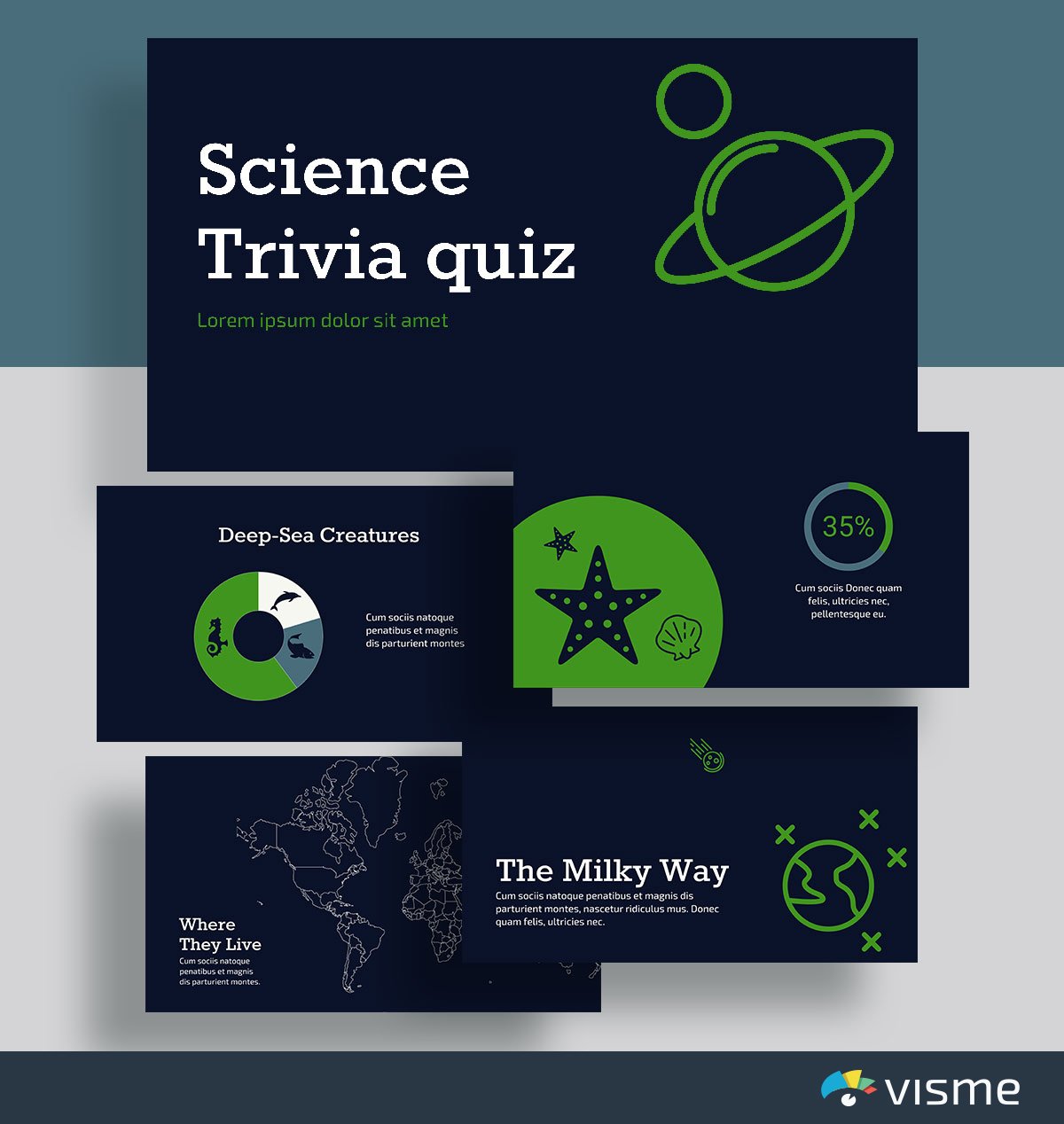
Help your class remember fast facts before a text with this trivia template. It’s a great way to host a study session in your classroom, and the content is easily interchangeable.
Or if you’re a student, put together a presentation study guide to help you memorize the most important key facts and information from class. A trivia presentation format can make for a fun study sesh before the test.
31. Lesson Plan Template
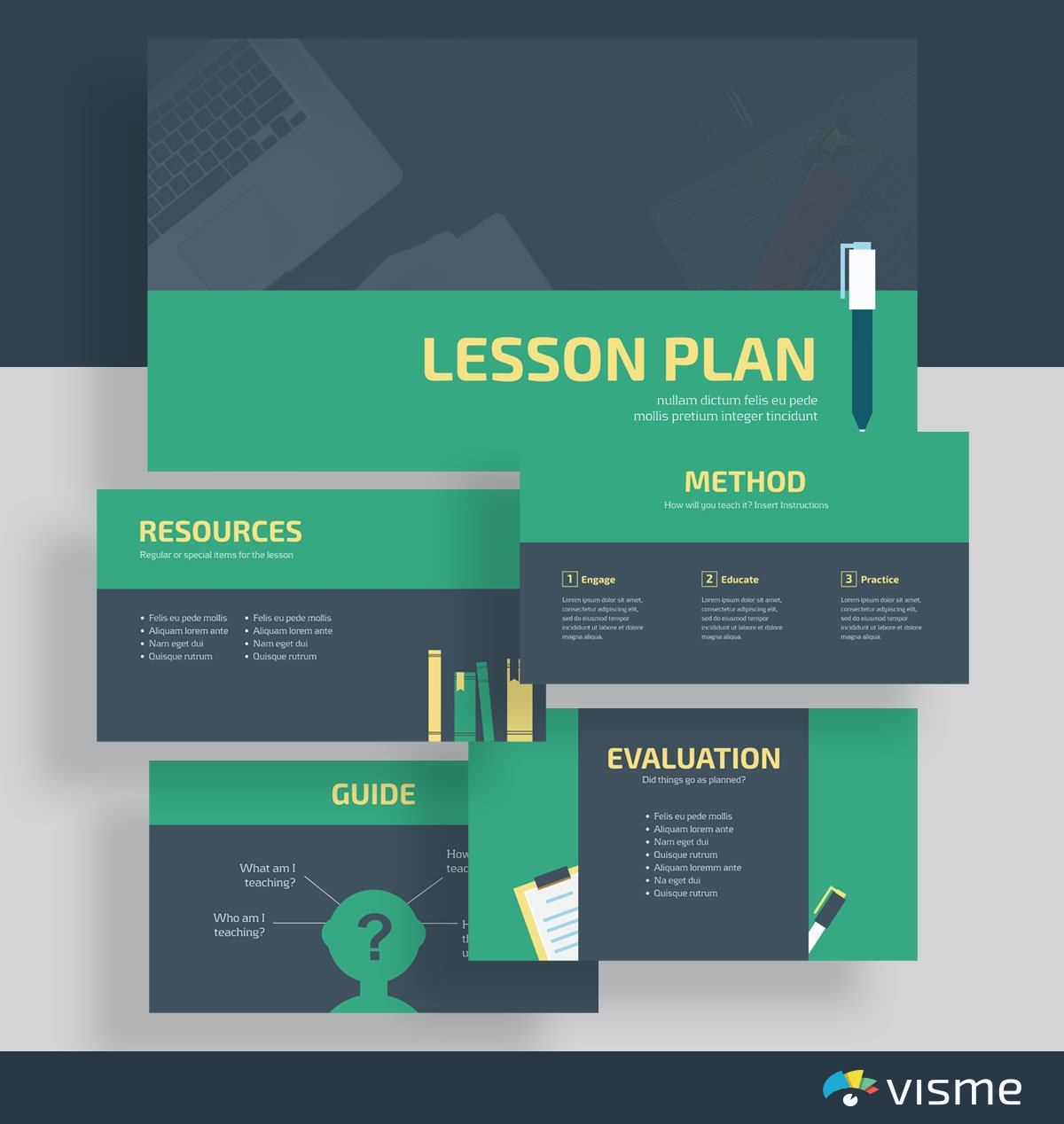
Don’t waste time putting together a dry Microsoft Word or PowerPoint lesson plan. Instead, create an interactive lesson plan that helps you stay on message during your class, and helps your students to know exactly what’s going to come next.
32. Group Project Template
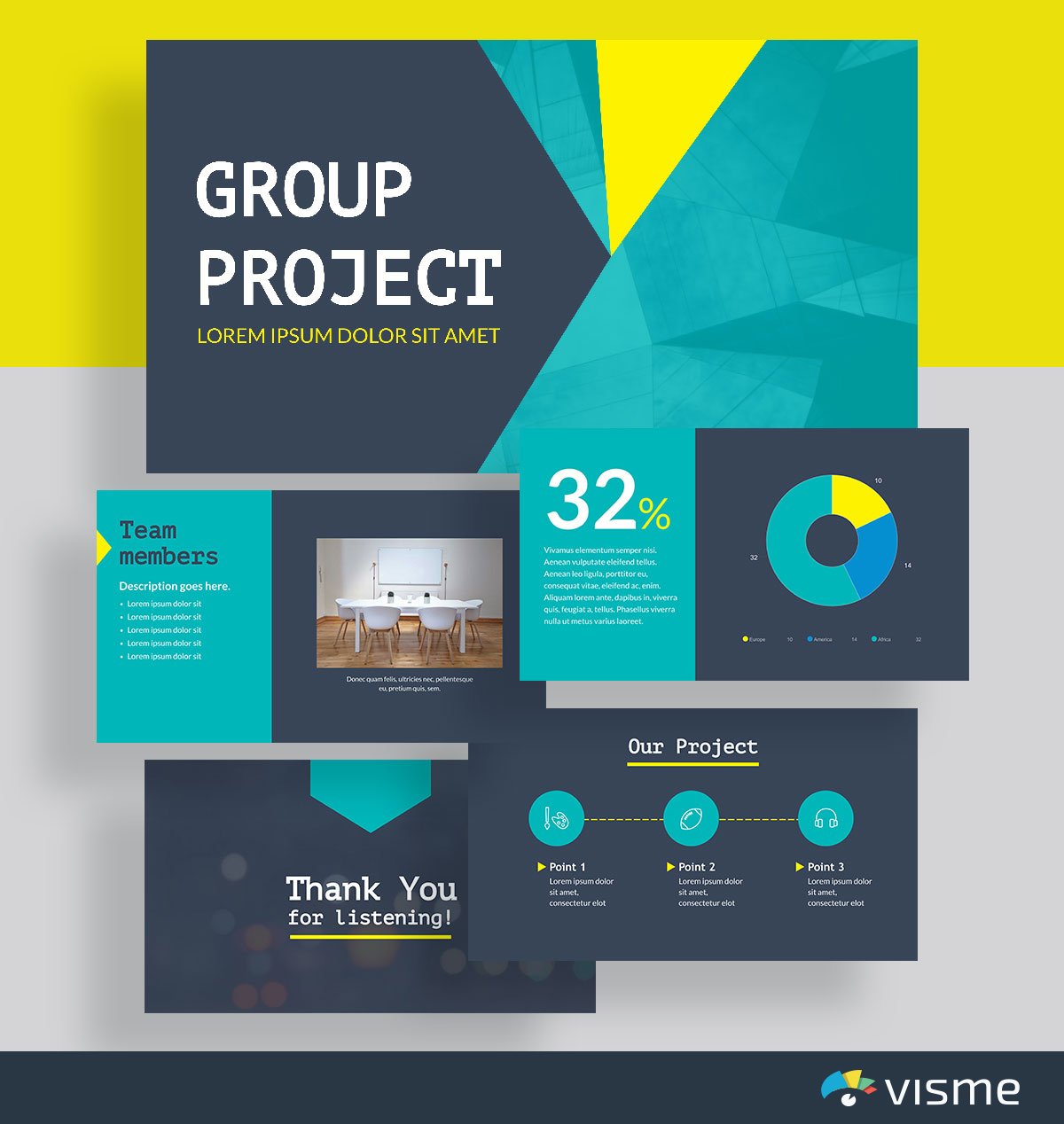
Group presentations just got a little more exciting. Blow the rest of your class’s projects away by using these presentation slides to compile your overall project objectives and results.
You can easily adjust colors and fonts, add in your team members and insert copy relevant to your class and your group project.
Don’t forget to thank your classmates and your teacher for listening in the end.
A pitch deck is an essential presentation for all businesses and entrepreneurs to have. There are many times you might need to pitch your business, whether it’s to investors for funding, journalists for media coverage and more.
Using a presentation template to put together your pitch deck is a great idea so that you can focus on pitching your business without having to worry about the design.
Browse through the pitch deck presentation slides below to find one that works for your business and its goals.
33. Airbnb Pitch Deck Presentation Template
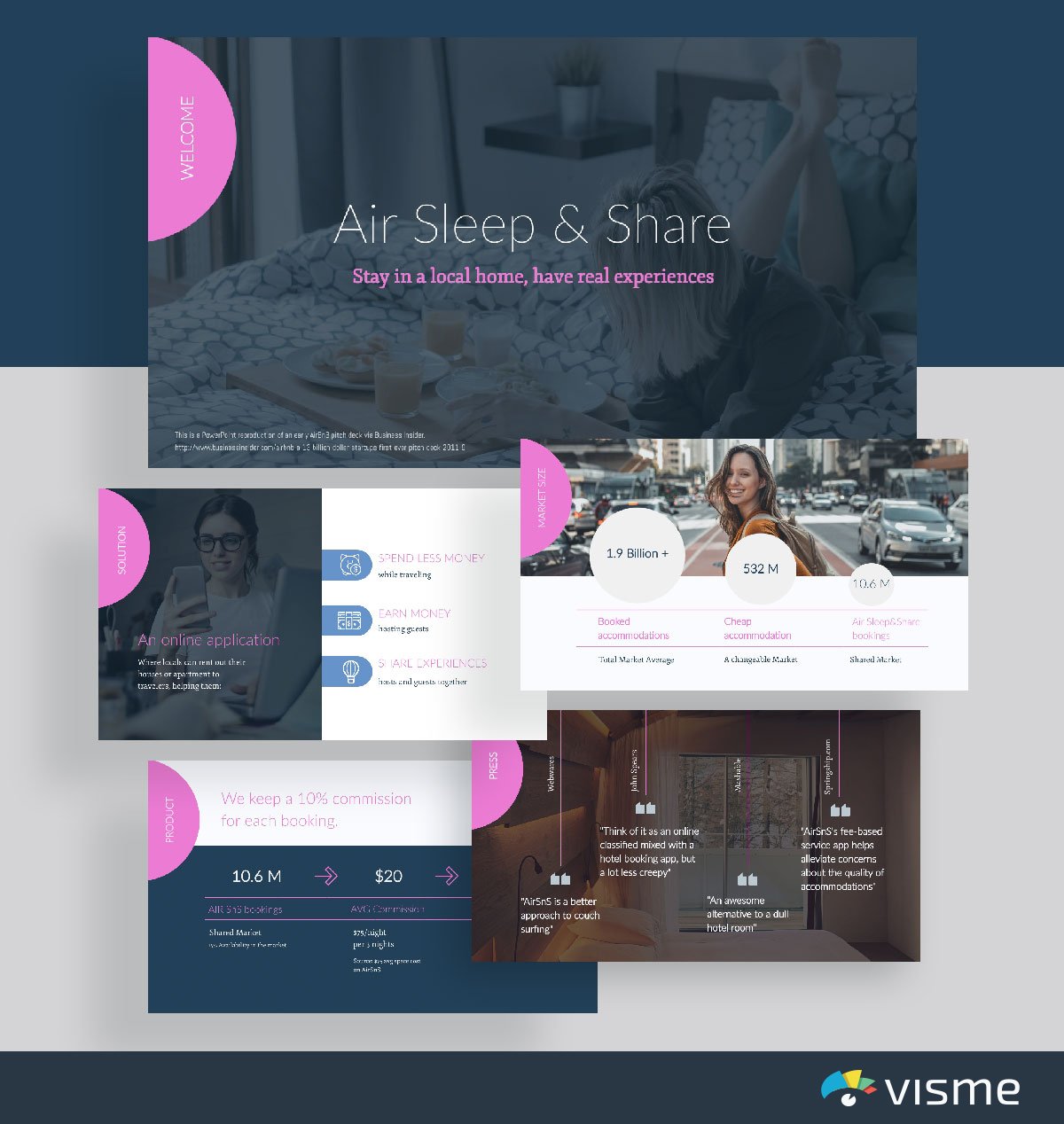
Give this Airbnb-inspired pitch deck presentation theme a go when putting together a slideshow for your business. In your company slide, include the solution that your business provides its customers, product/service information, and excerpts from press acknowledgements.
34. Front Pitch Deck Presentation Template
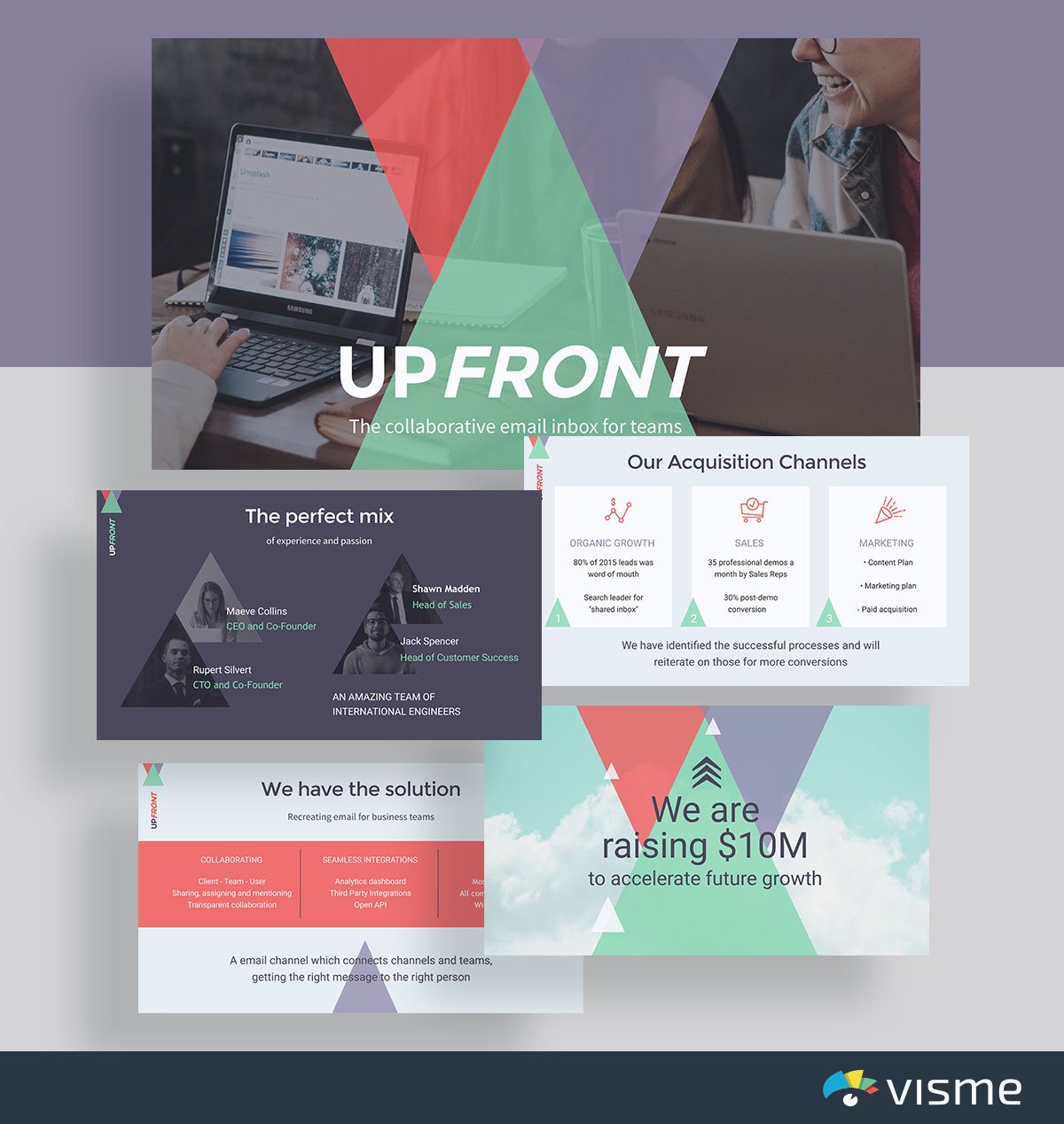
Showcase your business with this geometric pitch deck template inspired by Front. Add in the planned acquisition channels for your business, your leadership team and more.
Your pitch deck is meant to showcase your business to people who may want to work with you, so it’s important to share the most imperative information.
35. Buffer Pitch Deck Presentation Template
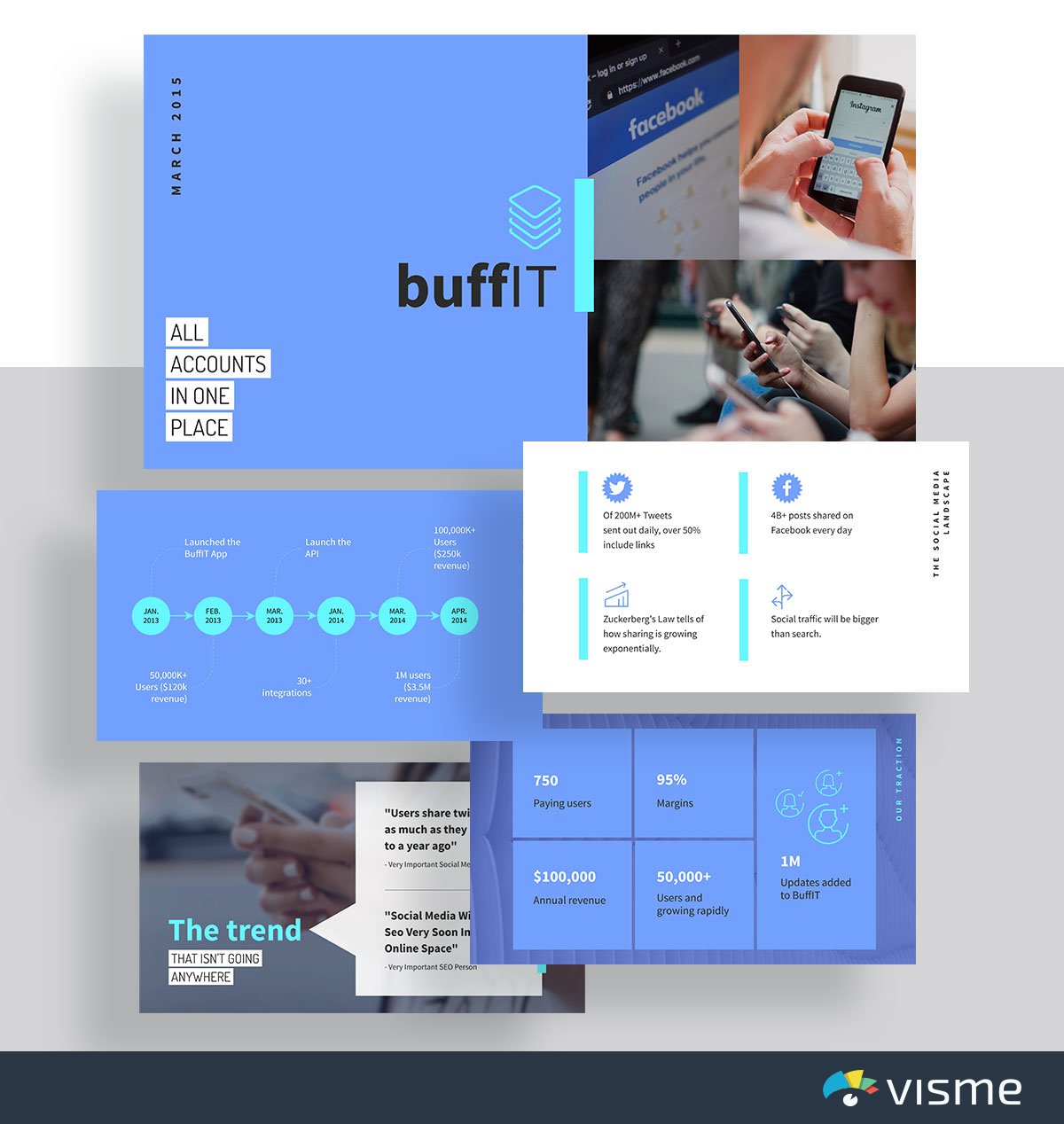
Showcase the state of the industry and your business’s role in it with this pitch presentation slides idea inspired by Buffer. The information these presentation slides include helps you to share the impact your company has had on your industry.
Since industries are ever-changing, you can easily update the information within your pitch deck in Visme and it will automatically sync to the webpage where you embed this presentation.
36. Comms Pitch Deck Presentation Template
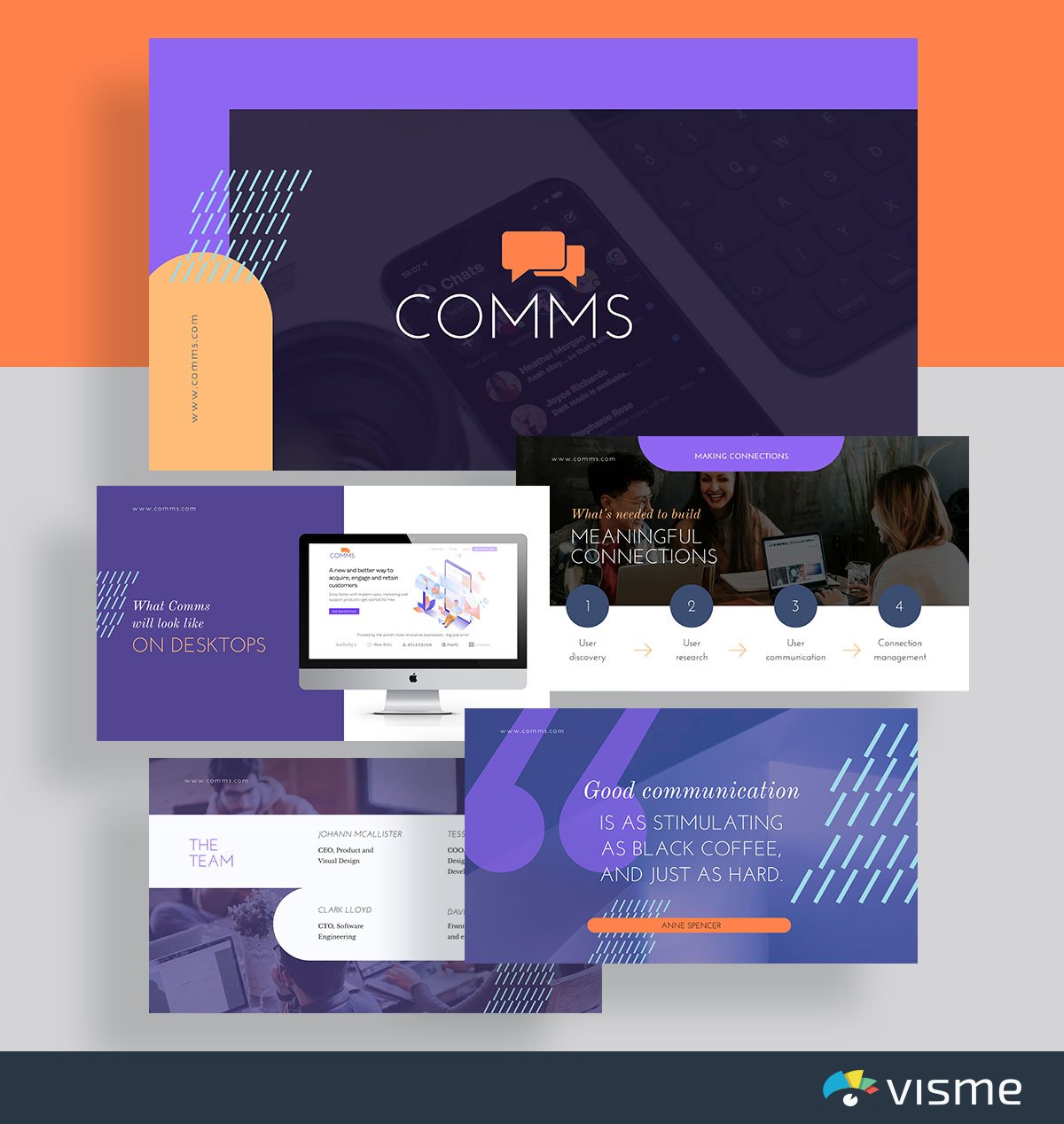
Use these presentation slides inspired by Intercom to give your audience an idea of what your product is going to look like and how it will work.
This is the perfect pitch deck template to take advantage of when launching a new SaaS product or app so that you can share what the technology will look like and how it will work.
Showcasing specific features and tutorials is a great way to get people talking about your product.
37. WeWork Pitch Deck Presentation Template
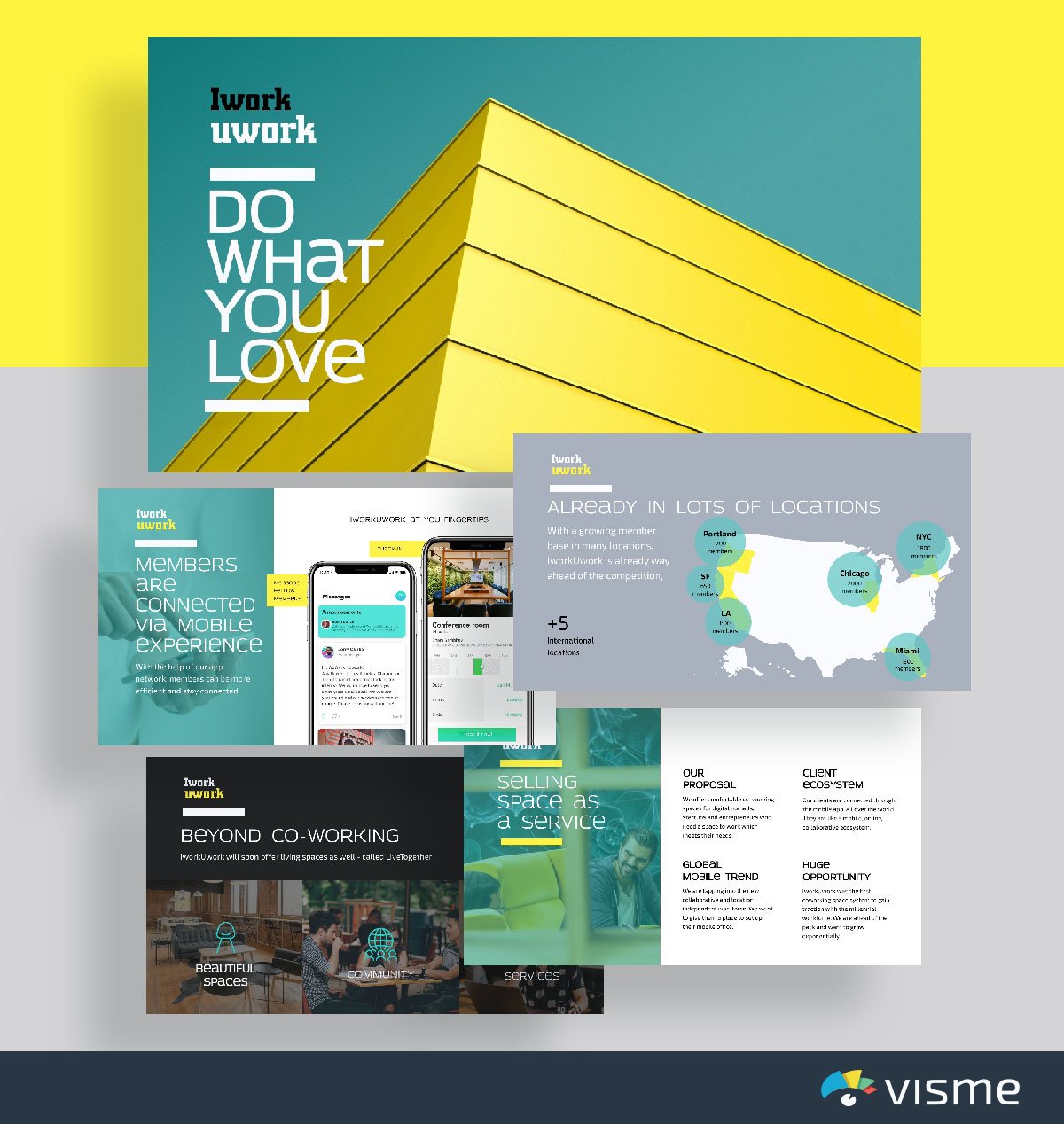
Is your company helping to fuel a movement? Share how your company is changing the industry with this pitch deck template inspired by WeWork.
It’s exciting when your business is doing more for your industry than simply adding another product or service. Focusing on a movement that really switches up the way your industry does things is an incredible feat.
Utilize a pitch deck template like the one above to showcase how your company is involved.
38. Buzzfeed Pitch Deck Presentation Template
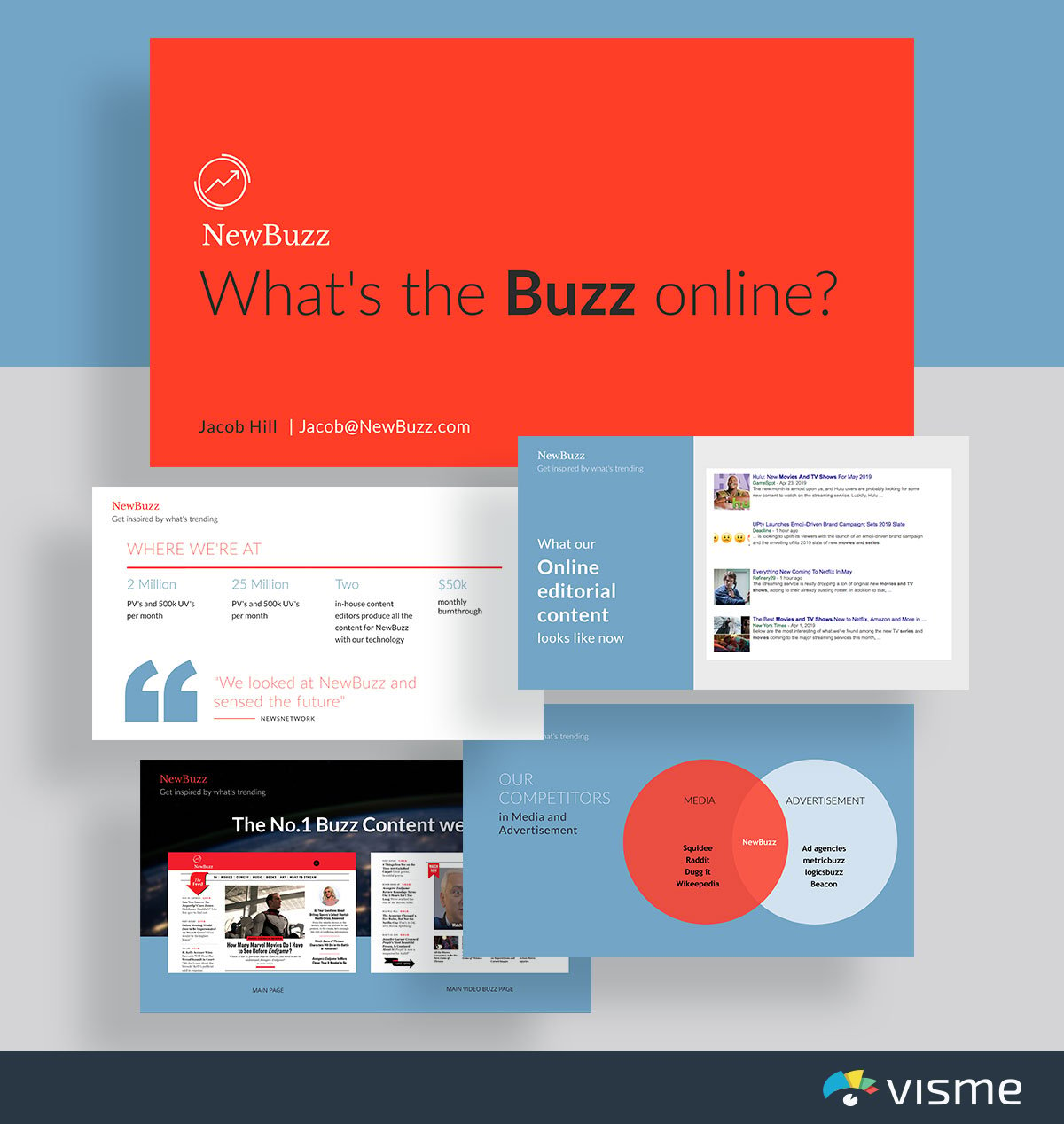
Does your business focus on content? Or perhaps you’re creating a new kind of media outlet?
Show off your content and analytics with this Buzzfeed-inspired pitch deck presentation template. Getting advertisers on board and other media outlets to talk about you is important for success.
This is why you need to be putting together a pitch deck that shares that kind of information. No one will want to work with you if you keep your analytics in the dark.
Use dynamic fields to ensure your brand information and other key details stays consistent across slides and other projects. These fields are customizable and change automatically based on input or predefined conditions.
39. Investor Pitch Deck Template
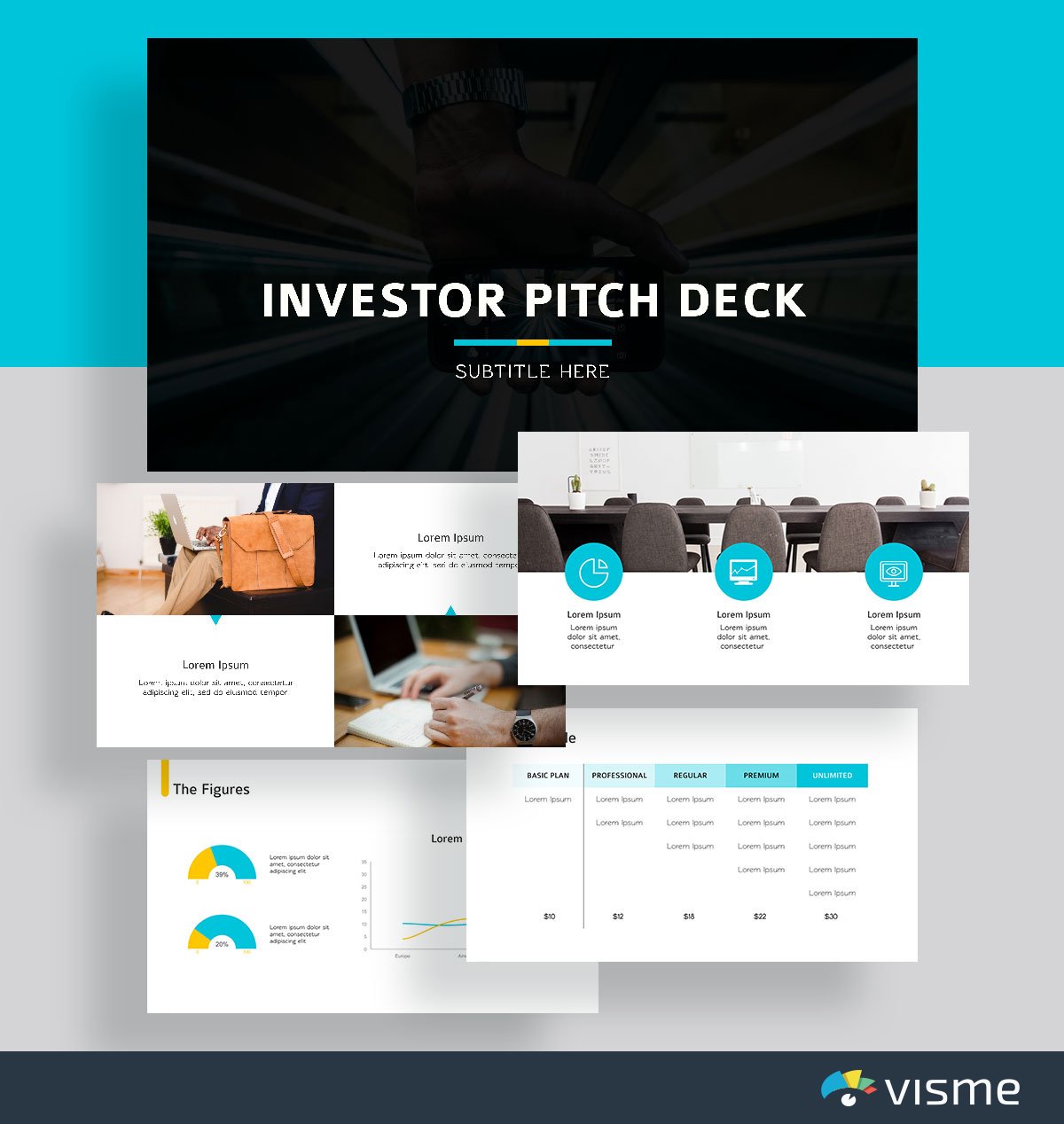
Starting a new venture that you need funding for? Use these presentation slides to put together a pitch for investors in your business.
From showcasing the problem in the industry to your business’s solution, along with your business plan and pricing table is a great way to get potential investors interested in what you’re selling.
40. LinkedIn Pitch Deck Presentation Template
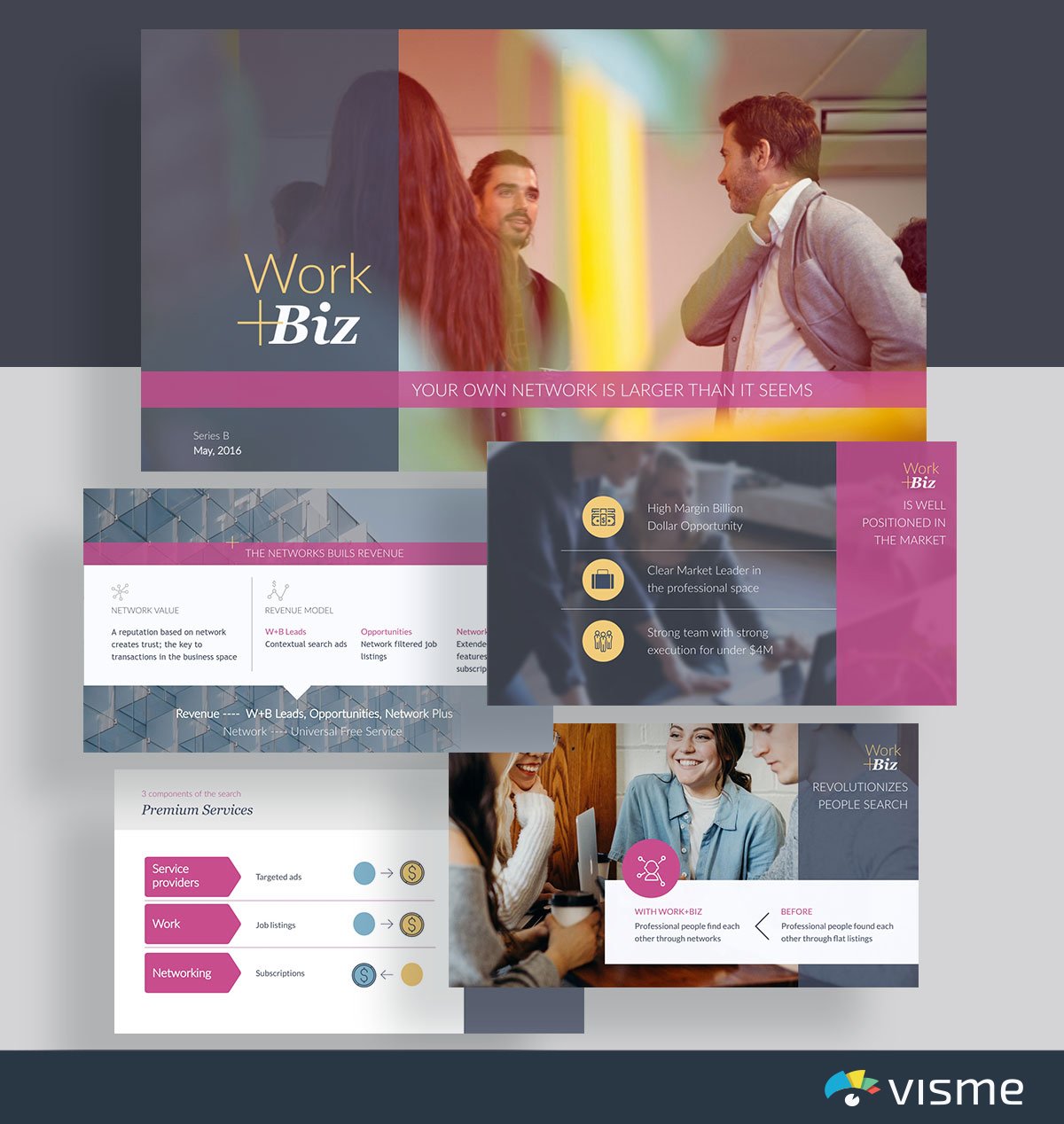
Compare and contrast what processes look like with and without your business with this pitch deck template inspired by LinkedIn.
It’s a great idea to take care of this in your pitch deck so that you make the job of any media outlet or writer covering your business even easier. After all, you’ve done the hard work for them.
They were going to share how your business helps. You’ve already visualized this in your pitch deck. This increases the chances that people will cover your business.
41. Mattermark Pitch Deck Presentation Template
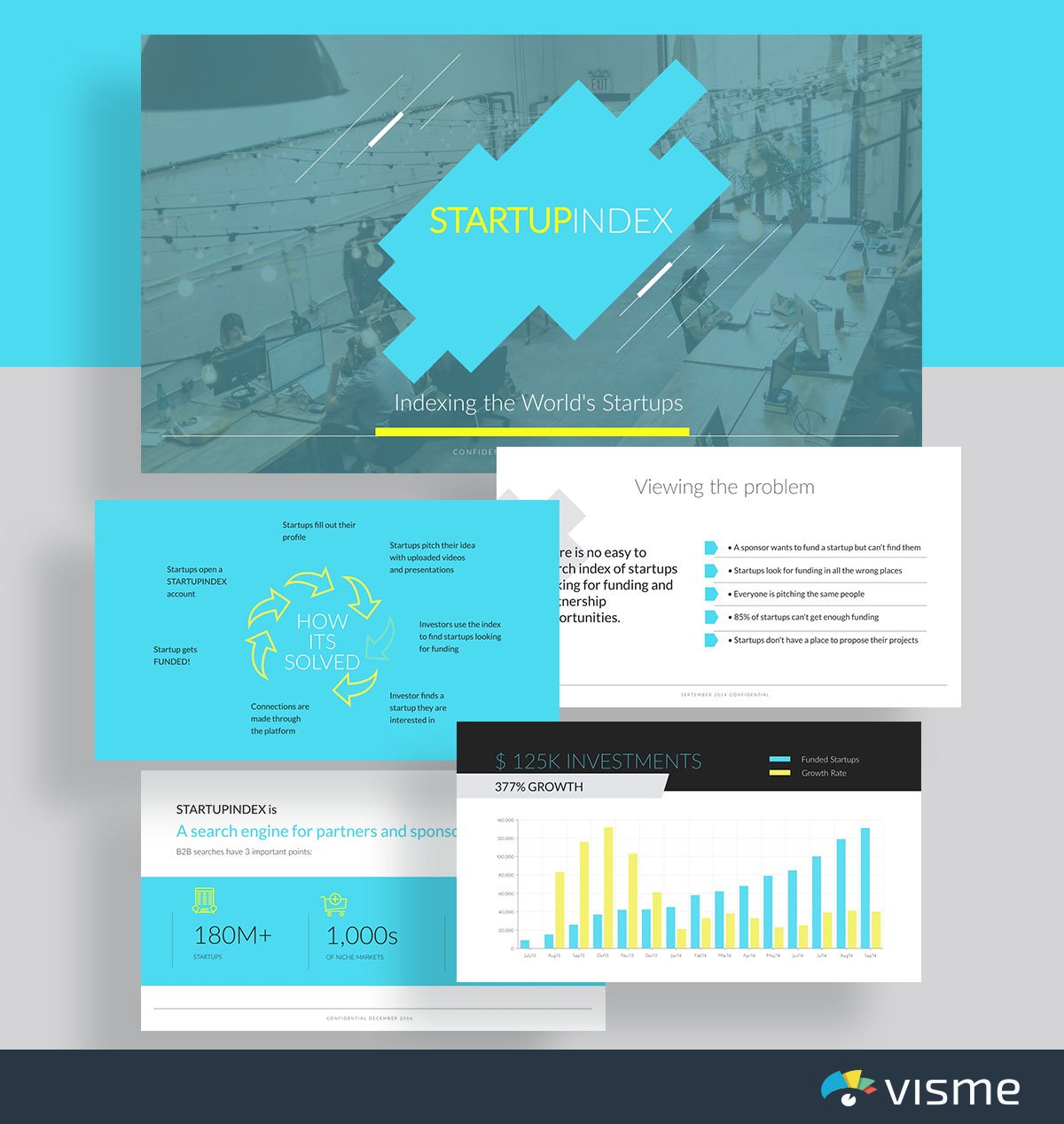
Use this pitch deck presentation theme inspired by Mattermark to put together key questions about the industry that showcase why your business is so essential.
Launching a startup is hard work, and that’s why a pitch deck is an essential marketing tool to have. Creating a pitch deck that already answers the why and how questions of your business is a great way to introduce who you are and what you’re doing to investors and reporters.
42. Foursquare Pitch Deck Presentation Template
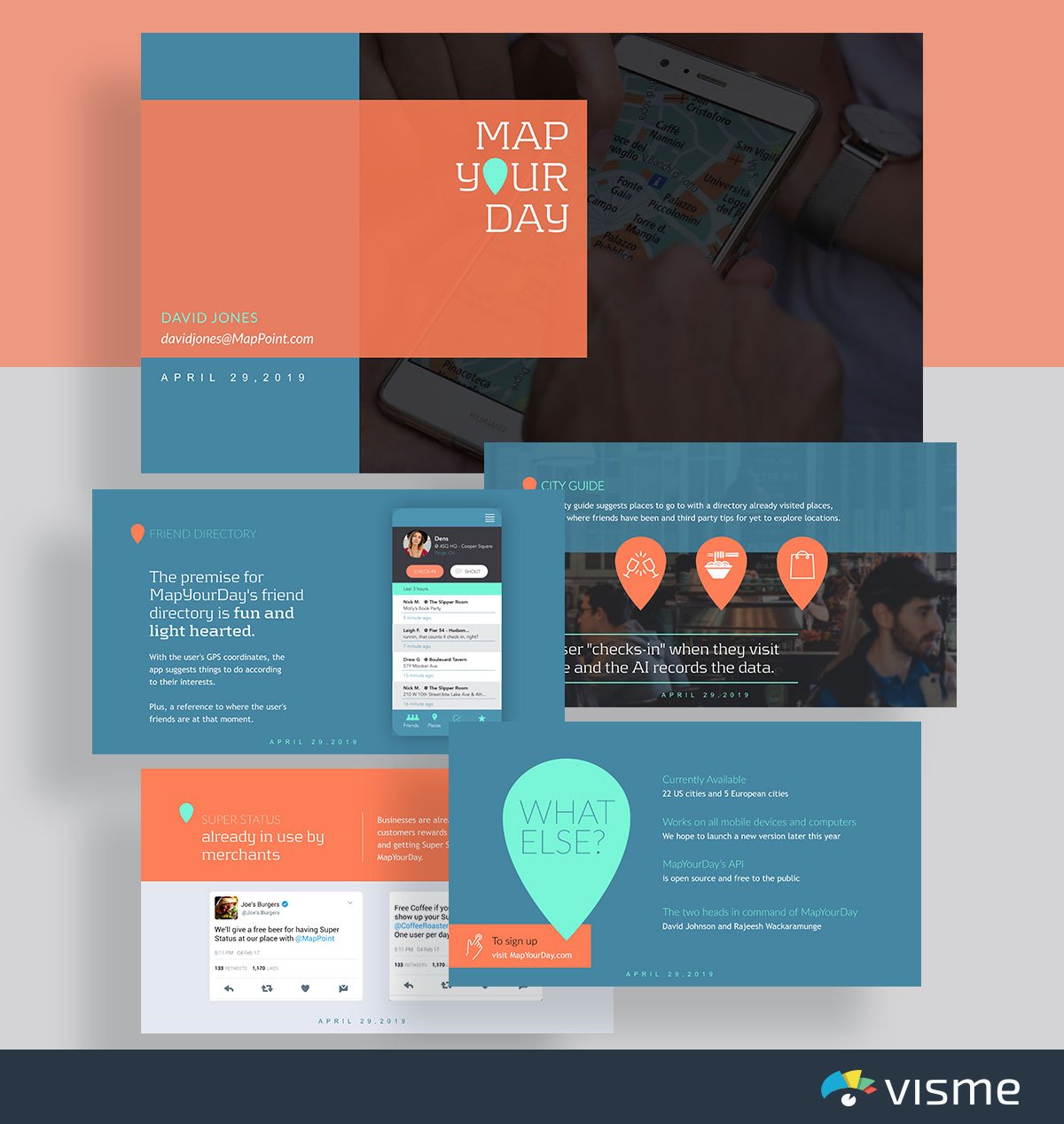
Put together an overview of how your product works with this pitch deck presentation template inspired by Foursquare.
With presentation slides already in place to showcase a step-by-step tutorial, all you have to do is input your content and publish your presentation.
43. Fyre Festival Pitch Deck Presentation Template
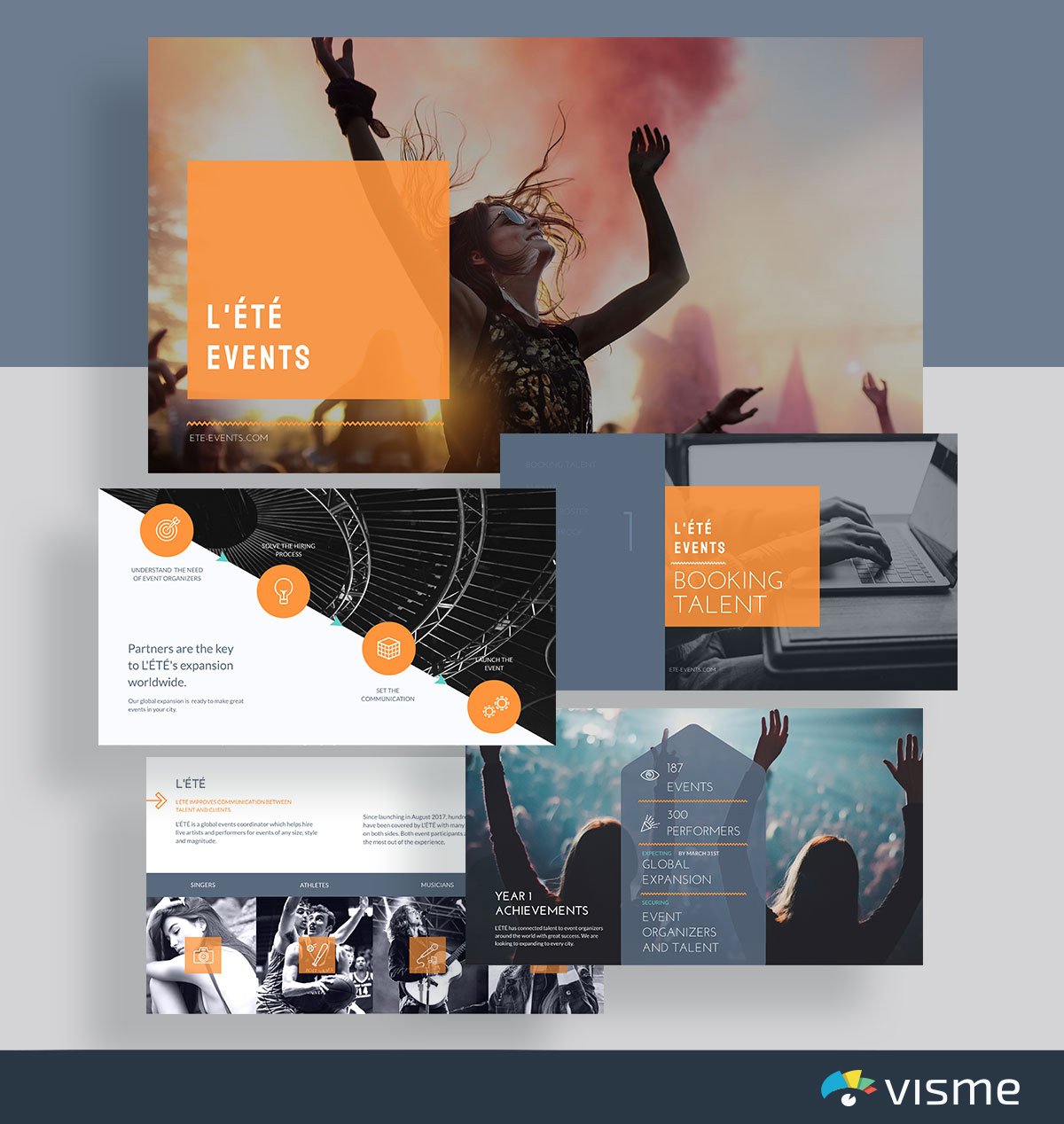
If your company has been doing some awesome stuff lately, you want your potential investors and those looking to work with your business to know about it.
Show off your company achievements with this pitch deck presentation template inspired by the famous Fyre Festival pitch deck.
44. Biogrify Pitch Deck Presentation Template
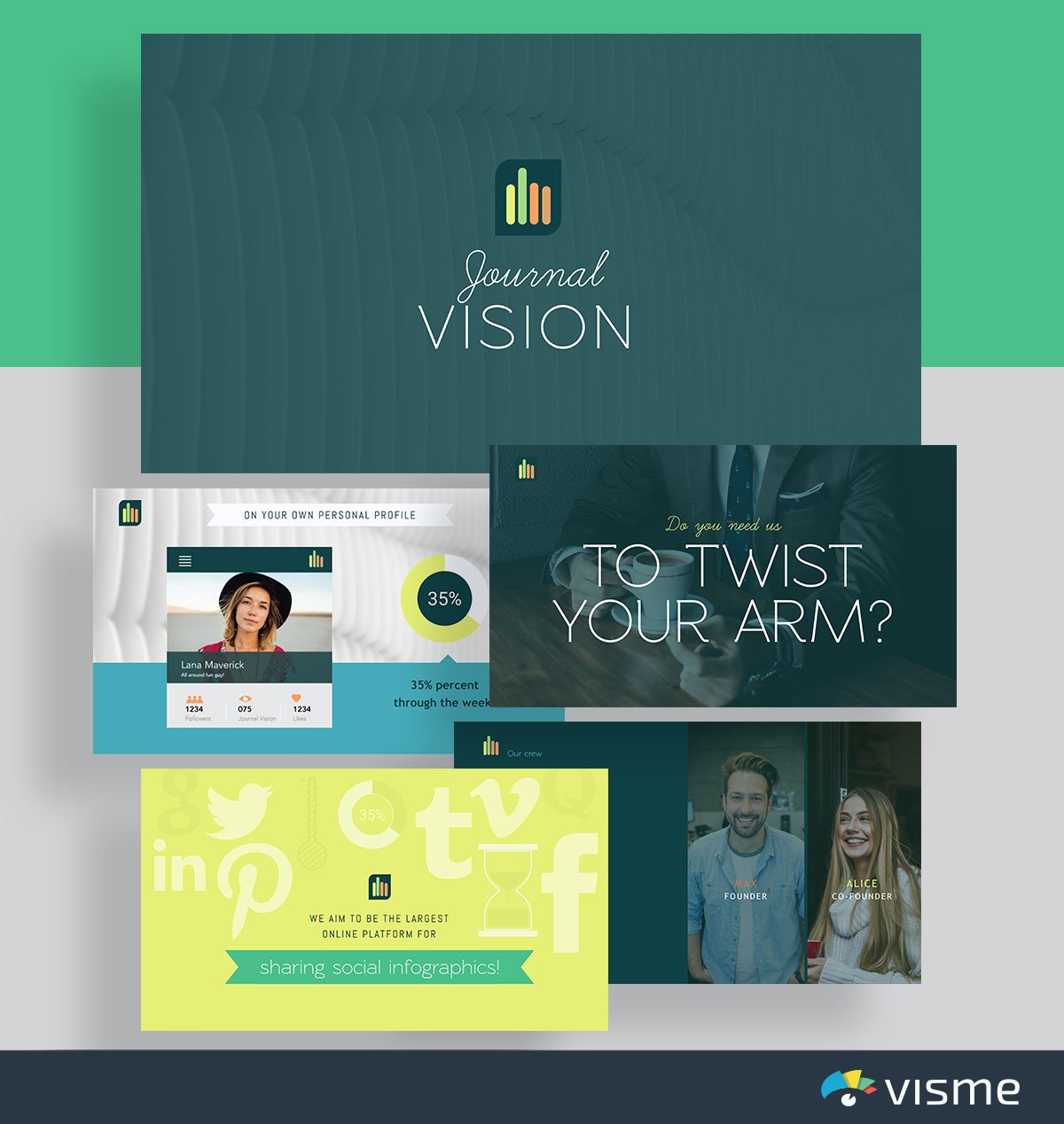
Use these presentation slides inspired by Biogrify to excite people about how they can use your product. If you have a unique product or service, you just need to drum up a little excitement and attention!
A pitch deck is the perfect way to do that. Add in your company’s logo, mission and unique selling proposition to get people looking forward to becoming customers/users.
45. Launchrock Pitch Deck Presentation Template
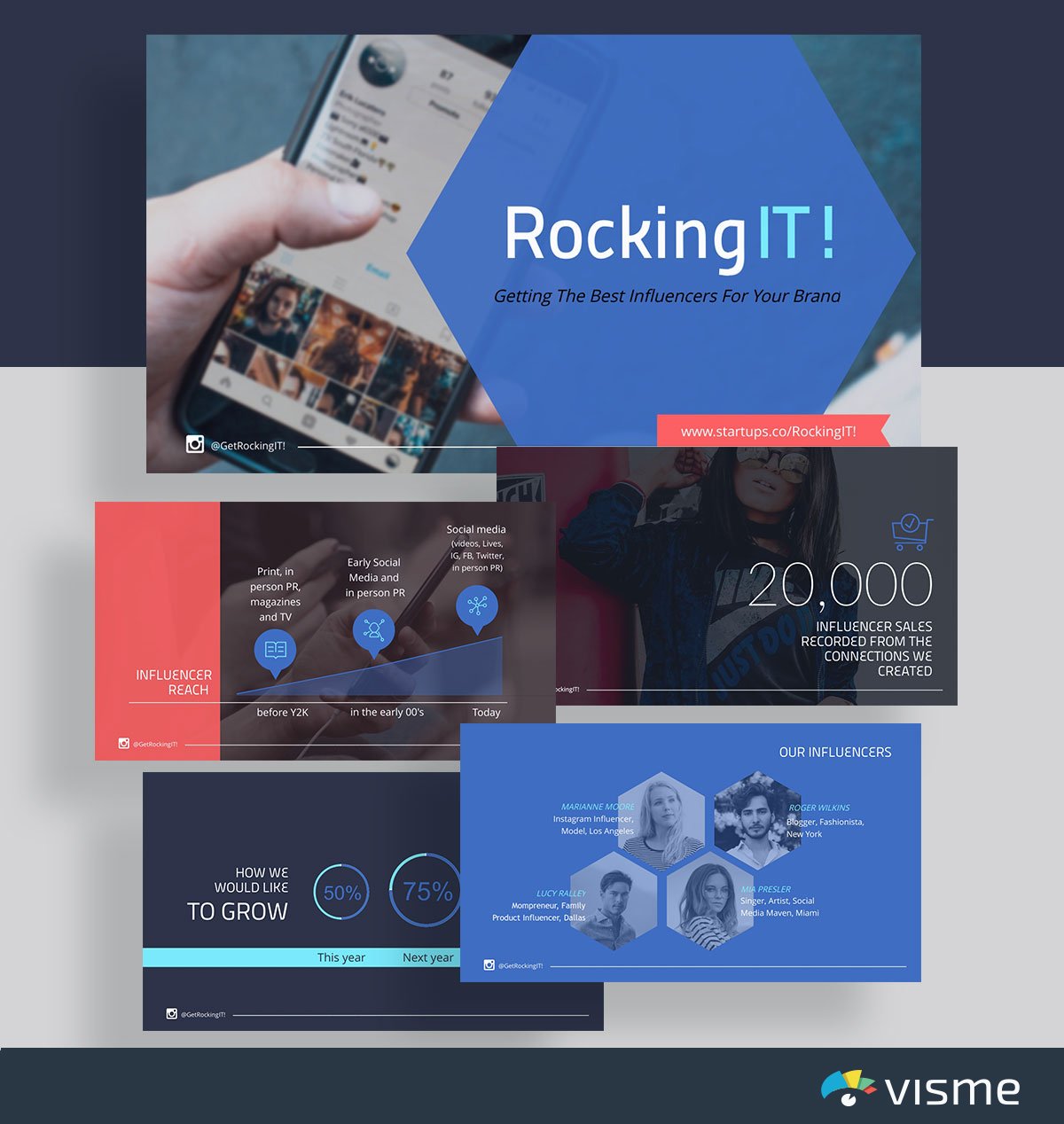
Influencer marketing is a huge marketing strategy that can generate some serious results. What better way to pitch influencers about your business than with this pitch deck inspired by Launchrock?
Don’t email off some boring PDF or Google Doc. Create enticing pitches to influencers with this pitch deck theme, and start watching the replies from influencers pour in.
Working with influencers to promote your product is a great way to increase your audience base and word of mouth about your company.
When you’re running a nonprofit, there is a lot of pitching your organization, talking to donors and working on events to increase donations. This is why you need great slide presentations.
Putting together a presentation for your nonprofit is a great way to showcase what your organization does and why people should donate to it.
Here are a few nonprofit presentation slides to choose from, where all you have to do is insert your information, change colors and fonts and present.
46. Nonprofit Report Template
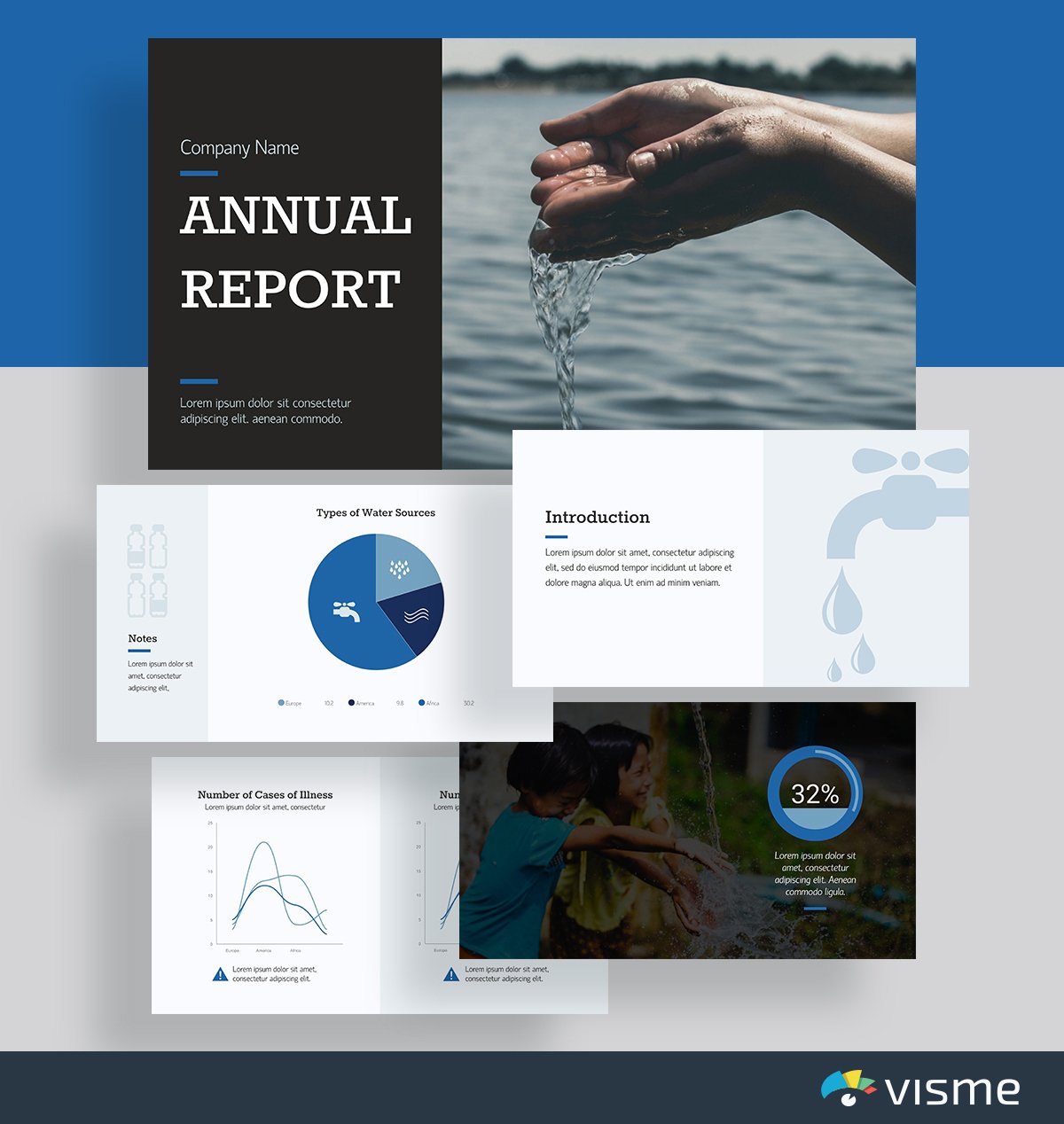
Put together a report that covers what your nonprofit is working against as well as your nonprofit’s achievements each year.
47. Nonprofit Art Template
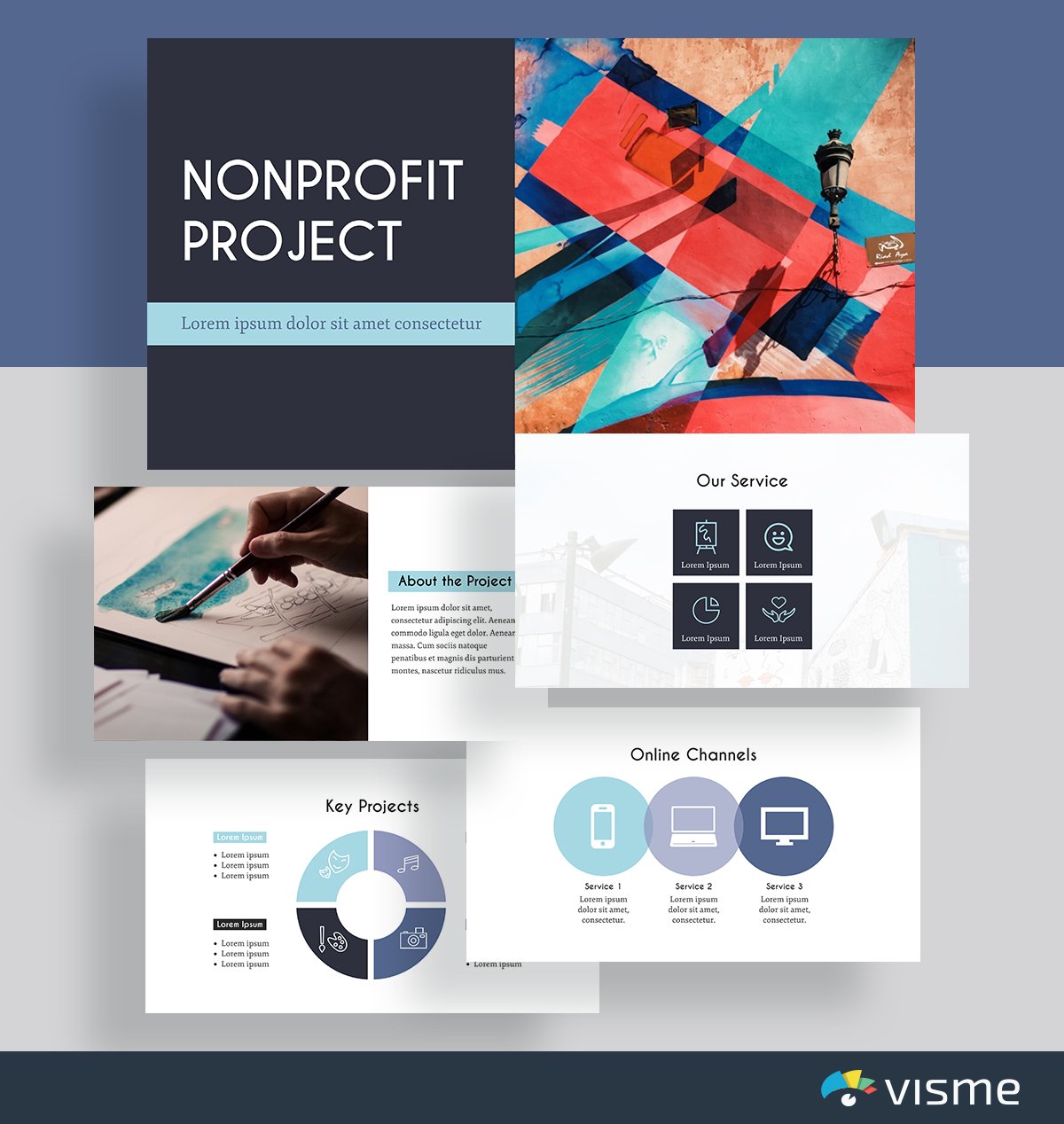
Use this presentation slides idea to provide an overview of your nonprofit and its main projects. To generate even more support and donations, it’s important to provide clear insight into your key products and objectives.
48. Nonprofit Environmental Template
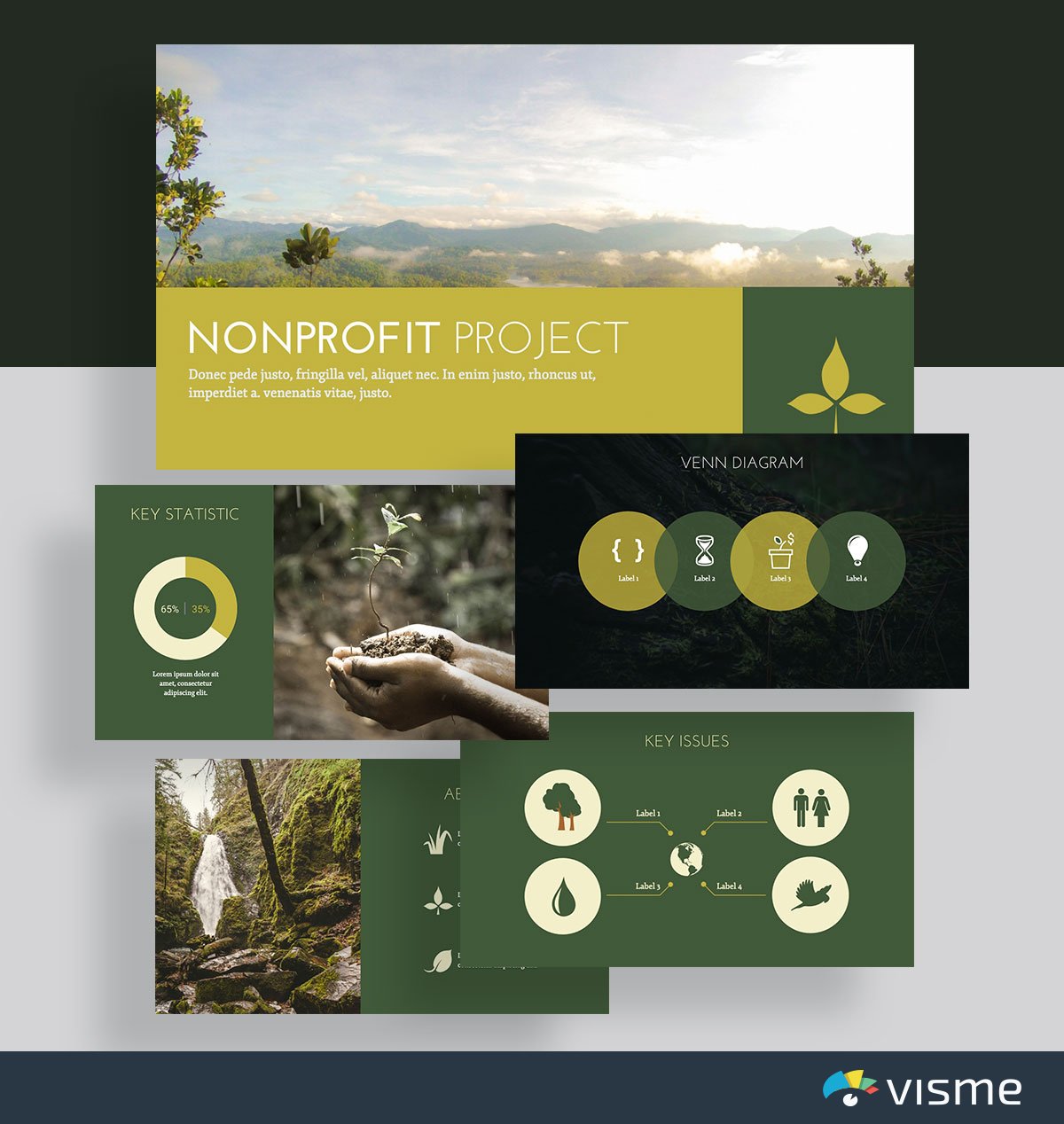
This presentation theme is perfect for showcasing the key issues your nonprofit fights for and its process for doing so.
Being transparent about what your nonprofit works on is important so that your donors know exactly where their money is going. Being secretive can generate some bad press, so it’s better to be open with your supporters.
49. Nonprofit Animals Template
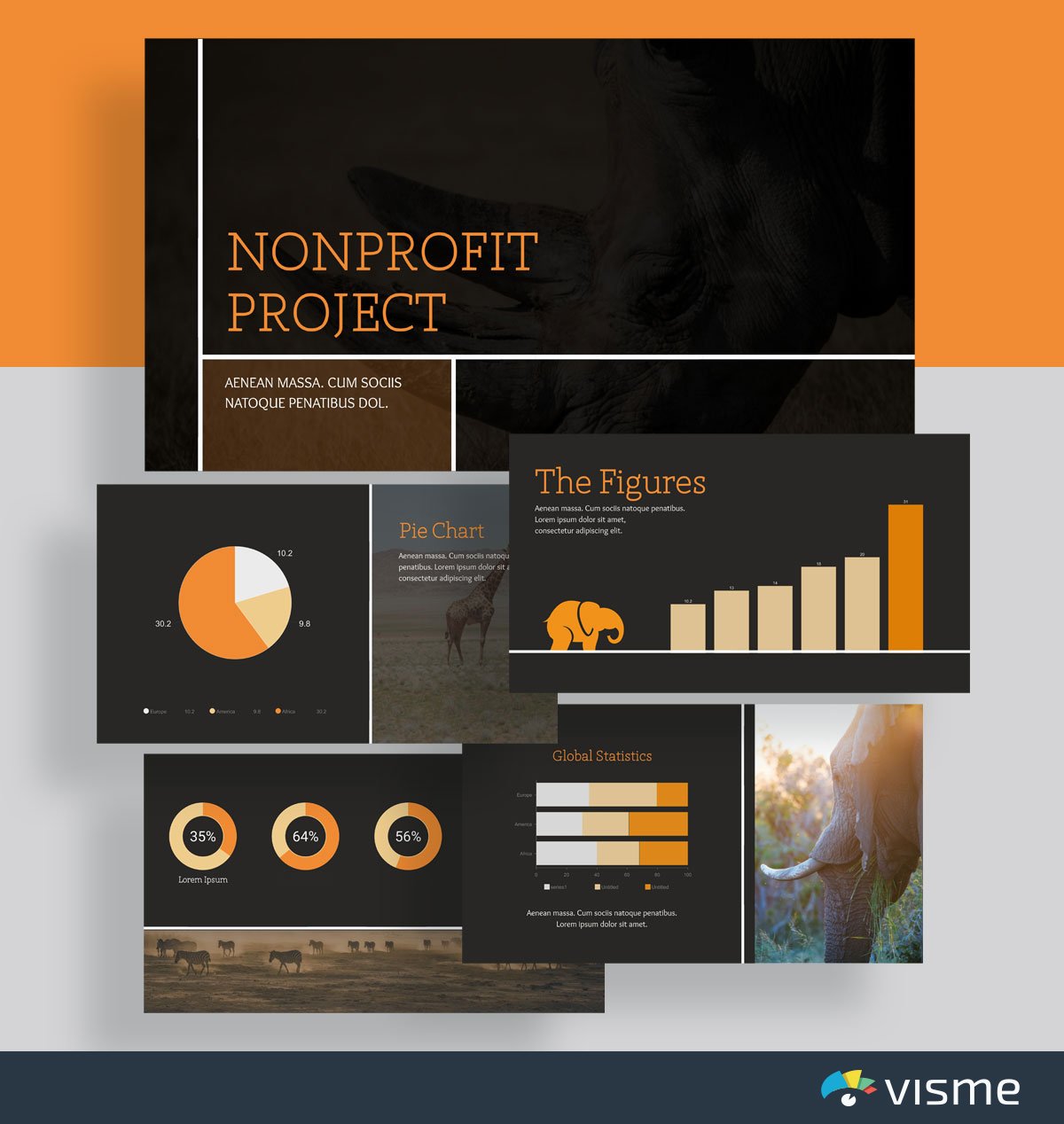
These presentation slides use earthy colors to convey their nonprofit’s connection to animal rights. Use this to showcase your nonprofit. You can use the current colors or update it to match your nonprofit’s brand/industry.
50. Wildlife Conservation Template
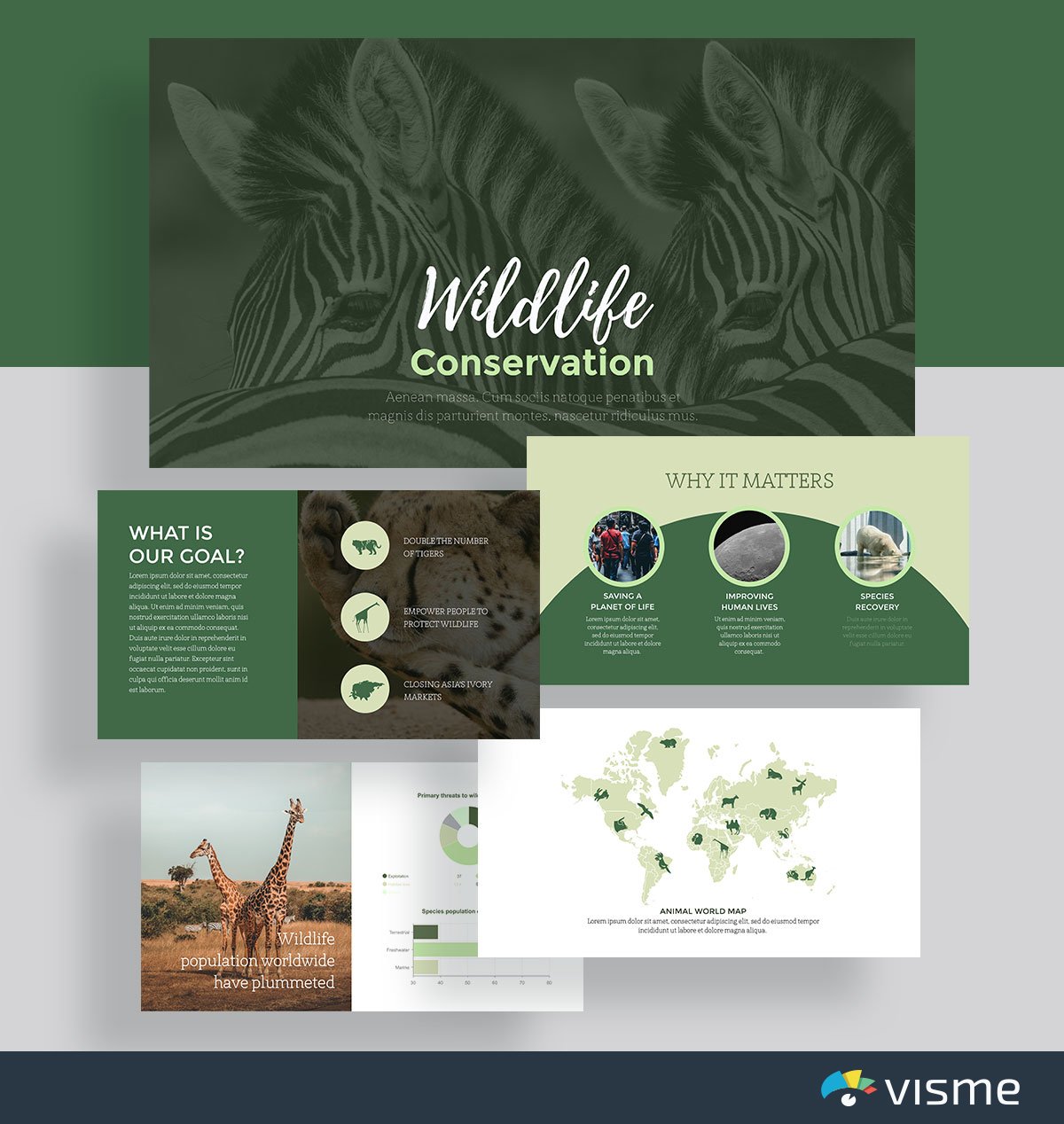
Use these presentation slide examples to cover why your nonprofit matters and why donors should consider contributing.
A nonprofit only exists when people donate, so putting together a compelling pitch deck showcasing why your nonprofit is so important to your main issue is important. These slides are perfect for sharing your goals and mission.
51. Pet Adoption Slideshow Template
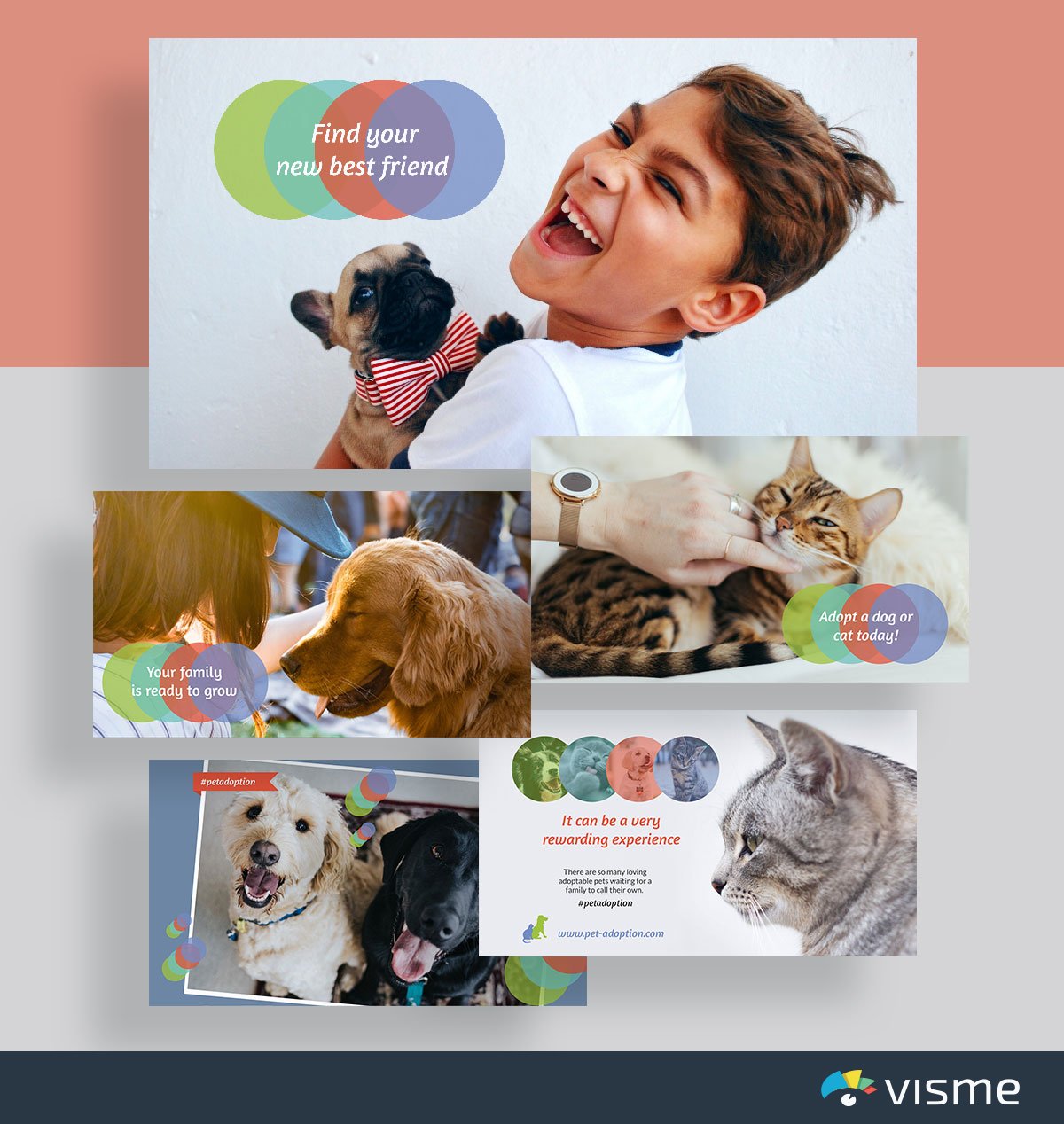
If you're looking for stunning presentation slide ideas , we've got more than enough. This pitch deck presentation template is perfect for SPCAs and other animal societies working on finding forever homes for their animals.
However, it can also be adapted to any other nonprofit or business need. The great thing about these presentation slides is how versatile they are. Each one is completely customizable to fit your specific needs. For example, you can turn it into a video presentation .
Q. What is a PowerPoint Slide Deck?
A PowerPoint slide deck is a collection of slides that are created using an online presentation maker. These slides are used to create presentations for various purposes, like sales , marketing , research , case studies , webinars , onboarding and business in general.
PPT presentation slides typically consist of a series of slides that contain text, images, charts, graphs, and other multimedia elements that are used to communicate information to the audience in an engaging and visually appealing manner.
So why is it called a slide deck? In the early days, presenters would create slides by photographing images or text onto transparent film. These slides would then be loaded into a slide projector and displayed on a screen. The collection of slides was referred to as a "deck," and the presenter would advance through them one by one. Today, the term "slide deck" is still used to refer to a collection of slides or presentation materials, even though most presentations are now created and displayed digitally.
Q. What is a good presentation slide?
A good presentation slide is one that engages your audience and effectively communicates your message.
Here are some key characteristics of a good presentation slide:
1. Keep your slides simple and uncluttered: Avoid excessive text and use bullet points or concise phrases to convey your main points. Use clear and legible fonts, and maintain a consistent design throughout the presentation.
2. Visual appeal: Incorporate visually appealing elements such as relevant images, charts, graphs, or diagrams. Use high-quality visuals that enhance understanding and make the content more engaging
3. Make it readable: Use a readable font size. Stick to a maximum of two or three font styles and sizes. Blend bright and dark colors for the text and background to ensure visual contrast and good visibility.
4. Consistent structure: Use consistent formatting, such as font styles, colors, and alignment, throughout the presentation.
5. Make it interactive: Include animation and interactivity to add flair to your presentation. It can make your presentation powerful and memorable.
Q. How do you make a good presentation slide?
There are lots of presentation software available for creating presentations. But Visme offers users a wide range of features to create visually stunning and engaging presentations.
All you need to do is choose a template from our extensive library of over 500 presentation templates and customize it with your text. You can edit content, change image(s), apply custom colors, input your own fonts and logo, and more. You can visualize data using our wide range of customizable charts and widgets.
Spruce up your presentation by adding audio, video, animations and other interactive elements. Download it as a PDF, PPTX, MP4, and HTML5 to share with your recipient , or generate a shareable link for online sharing.
Q. How do you design a presentation?
Here's a step-by-step guide to help you design some of the best business presentations:
1. Define Your Objective: Determine the purpose of your presentation and identify the main message or key points you want to convey
2. Plan Your Content: Outline the structure and flow of your presentation. Divide it into sections or key topics to ensure a logical progression. Read this article to learn more about creating an effective presentation outline .
3. Create a Storyline: Craft a compelling narrative that ties your key points together. Storytelling can help engage your audience and make your presentation more memorable.
4. Choose a Design Theme: Select a visually appealing design theme or template that aligns with your topic and audience. You can use the ones we've shared above as your presentation inspiration.
Visme’s branding kit streamlines on-brand content creation and ensures you stay consistent across all channels. With our AI-powered brand wizard , you can automatically generate branded templates fitted with your brand elements.
5. Use Visual Elements: Incorporate relevant visuals such as images, charts, graphs, icons, or diagrams to enhance understanding and engagement.
6. Maintain Visual Hierarchy: Organize your content with a clear visual hierarchy. Use headings, subheadings, and bullet points to guide the audience's attention and emphasize key points.
7. Use Transitions and Animations: Apply transitions and animations to enhance the flow and engagement of your presentation.
8. Practice and Test: Review and rehearse your presentation to ensure a smooth delivery. Test your presentation on the actual equipment or platform you'll be using to ensure compatibility and optimal display.
9. Seek Feedback: Before delivering your presentation, consider sharing it with a trusted colleague or friend for feedback. Ask for their input on the content, design, and overall effectiveness. Incorporate their suggestions to improve your presentation.
Q. Which slide is best for presentation?
The best slide for a presentation highly depends on the topic and the target audience. For example, if it's a pitch deck presentation, the financial projections or business model slide would be the best.
However, here are some of the most common slides you should know about:
1. Title Slide: It announces the presentation's topic and introduces the speaker. It grabs the audience's initial attention.
2. Agenda Slide : This gives the audience an idea of what to expect throughout the presentation.
3. Content Slide : These are dense with information. They're best when broken down into bullet points for readability.
4. Visual Slide: Slides with infographics, charts, or other visuals can improve understanding and retention of complex data.
5. Interactive Slide: Encourages audience participation and engagement, especially in virtual presentations.
6. Conclusion/Summary Slide: Reinforces your presentation's key points or takeaways.
7. Question & Answer Slide: Allows interaction and clarification, ensuring the audience fully grasps the presented materials.
8. Contact Information Slide: Provides follow-up information for further questions or networking.
Q. What are the 3 main types of presentation slides?
While there's no one-size-fits-all rule for making presentation slides, you can group them into three main categories:
Introduction and Closing Slides
These slides bookend your presentation. The introduction slide typically includes the title of your presentation, your name and any relevant introductory information. The closing slide summarizes key points, provides a conclusion and often includes contact information or a call to action.
Content Slides
Content slides make up the core of your presentation and contain the primary information you want to convey to your audience. They can include text, images, charts, graphs and other visual or textual elements supporting your presentation's message.
Transition Slides
Transition slides signal a change in topic or create a smooth flow between different sections of your presentation. They often feature a brief title or heading that previews the upcoming content. Transition slides help guide your audience through the presentation and make it easy to follow.
Q. What are the 4 types of presentation?
The four types of presentations are informative, instructional, persuasive and arousing.
1. Informative Presentations: These are used to educate the audience on a particular topic. They present facts, data and information to increase the audience's knowledge and understanding.
2. Instructional Presentations: These presentations provide step-by-step guidance or training on a specific task, process or concept. You can use this type of presentation for teaching or coaching purposes, emphasizing learning and development.
3. Persuasive Presentations: The primary goal of these presentations is to influence the listeners' attitudes, beliefs or behaviors. Use this presentation type when you want your audience to accept certain arguments or propositions.
4. Arousing Presentations: These presentations aim to evoke interest and awaken curiosity about the topic among the audience. They often aim to inspire, motivate or raise awareness about an issue.
Q. How do you make a 5-minute presentation interesting?
Creating an intriguing 5-minute presentation may be challenging due to the time constraint. Yet, you can deliver an impactful and engaging presentation with a focused approach and attention to detail.
Here are some of the ways to do it:
1. Focus on a single core message : Since you have limited time, choose a specific topic and stick to it. Present only the crucial information that will help the audience understand your point.
2. Engage from the start: Start your presentation with a compelling story, anecdote or a surprising fact. This will grab the audience's attention and spark curiosity.
3. Keep slides simple and visual: Avoid cluttered slides with too much text. Use visuals such as images, graphs or infographics to illustrate your points clearly and concisely.
4. Tell a story: A narrative structure engages the audience and helps them follow your message. Consider using metaphors or anecdotes to explain complex ideas.
5. Encourage questions or interaction: Since time is limited, you might opt for a brief Q&A session, ask a rhetorical question or request audience feedback for further discussion later.
6. Finish strong: Conclude with a powerful statement, call-to-action or takeaway summarizing your main point. Leave your audience with a lasting impression of your message.
Q. How many slides should a 20 minute presentation be?
The number of slides you should have for a 20-minute presentation can vary depending on several factors, such as the complexity of the topic and the pace of your speech.
However, the general rule of thumb is to allocate at least 1-2 minutes per slide, which suggests 10-20 slides for a 20-minute presentation.
Q. What Is the 5 5 5 Rule for Presentation?
The 5 5 5 rule is a framework that ensures your presentation is clear and remains engaging. A presentation should have no more than five words per line of text, five lines of text per slide and five slides that apply the first two rules in a row.
Q. How Do You Make a Presentation Slide?
With Visme’s presentation software, creating a presentation slide is a breeze. Follow these steps to create a presentation slide with Visme.
Step 1: Log in to Visme and choose from hundreds of beautifully designed presentation templates . Each template is equipped with various intuitive layouts, typography, color themes, data widgets and graphics. Or Use Visme’s AI presentation maker to swiftly create a presentation based on your specific needs.
Step 2: Customize your presentation with your company’s logo, colors and other brand items. Upload your own creative collateral or use our assets library to add photos, images, graphics, icons and animations to your content.
Step 3: Once you have finished editing and are ready to share, download your presentation as a live webpage, video, PDF, or HTML file, a customizable PPTX, or embed it on your website.
Q. What Is the 10 Rule for Slides?
The 10 rule for slides is part of Guy Kawasaki’s 10/20/30 rule which emphasizes that no presentation should have more than 10 slides, last longer than 20 minutes, and contain fonts smaller than thirty points.
Q. Which is better Google Slides or PowerPoint?
When it comes to PowerPoint vs Google Slides , both have they're pro's and con's. You'll need to decide what's worth the trade if you should pick one over the other, or simply choose Visme.
Ready to Create Engaging Presentation Slides?
Ready to get started with creating your presentation? Choose from any of these 51 slides for presentation, or browse Visme’s complete template library to find the perfect match for creating your own presentation.
Each one of these presentation themes can be adapted to match your business, school, nonprofit and other needs so that you can create something perfect for your goals and objectives. Create your free account to start customizing with our drag-and-drop presentation maker.
And once you’ve finished creating your presentation, check out our video to help you present like a pro and wow your audience.

Create beautiful presentation slides with Visme

Trusted by leading brands
Recommended content for you:

Create Stunning Content!
Design visual brand experiences for your business whether you are a seasoned designer or a total novice.
About the Author
Chloe West is the content marketing manager at Visme. Her experience in digital marketing includes everything from social media, blogging, email marketing to graphic design, strategy creation and implementation, and more. During her spare time, she enjoys exploring her home city of Charleston with her son.
- AMG Newsletter
3 Types Of Conference Content That Will Boost Results

Is your conference content ready for prime time?
From a content marketing perspective, major industry conferences are attention magnets because they laser-focus your target audience on the key topics.
As a result, the major conferences are content generation and distribution opportunities requiring less work and budget to break through.
Even better, conference attendees are physically present in one location and following the show’s hashtag on social media. Further, they’re predisposed to acquire as much information as possible!
More importantly, conferences are ALL about business.
But, to create quality conference content, you need a content marketing plan and related editorial calendar regardless of whether you’re a conference producer, presenter, sponsor, attendee or outside spectator.
Otherwise—no conference content magic happens!
Don’t worry, we’ve got you covered–here are the 3 types of conference content that you need to boost your marketing results.
3 Types of Conference Content
Since conferences are audience attention magnets, include related content creation and promotion around these major events. Make conference content part of your content marketing plan and budget to take advantage of this topic-related interest.
At a minimum go through the conference agenda. Develop a plan before you get to the event!
For your conference content consider the following:
- Have you created conference content in the past? If so: How did it perform? Is it still relevant? Can it be updated and improved? What gaps did you leave?
- Where are opportunities for your content to stand out and shine? What hook will you use to attract and keep attention? Assess what you and the competition did at past conferences.
RECOMMENDED READING:
- The Ultimate Guide To Attending Conferences
- 20 Conference Blog Post Ideas You Can Steal
1. Pre-conference content
Pre-conference content focuses on building attention and excitement for the event.
It’s best done over time where special details such as keynote speakers are revealed to boost interest.
Most pre-conference content focuses on one of the following 3 objectives and has related metrics:
- Generating sales in terms of attendee fees and sponsorships.
- Building excitement over special keynotes and breakout sessions as well as attendees. Every speaker wants to have a sold-out session to create thought leadership and generate business leads. Similarly sponsors want to connect with attendees to drive warm leads.
- Take advantage of the category interest to distribute content and build relationships .
Pre-conference content options include:
1. Build community with social media
This helps to amplify conference attention during the show since the hashtag has been used over time and remained visible.

- The #CMWorld chat has a different guest every week. Even better, they create a blog post summary of many of the chats. Here’s an example with Allen Gannett.

Write up from #CMWorld chat. It’s a great way to extend your content.
Or take a page from Twitter Expert Madalyn Sklar . She holds her Twitter Chats live at events and invites attendees to join her. She also crosses from Twitter to Facebook Live after her chats (so that it’s also live conference content!)

Lisa Buyer and Madalyn Sklar at the SMMW18 live #TwitterSmarter
Facebook and LinkedIn Groups. This approach is increasingly popular and the community can be very helpful. It’s also a great way to keep attendees engaged after the event. Even better it often acts like a Mastermind as the Heroic Public Speaking Facebook Group does.
Depending on the conference, consider going niche. For example, Social Media Examiner created a Facebook Group solely for their speakers.
Even attendees can develop their own Facebook Group as Nadya Khoja and Susan Moeller did with their Women In Content Marketing.
2. Produce epic content
Top Rank’s Lee Odden and his team wrote the epic conference playbook with their curated ebooks .
- For Content Marketing World , Odden and his team reach out to presenters and ask them specific questions. The team compiles this information and creates an ebook. They also reach out to contributors to share the content with pre-formatted social media shares.
- BTW: Their 2014 Content Marketing World ebook series won a MarketingProfs’s Bright Bulb award for the campaign.

Pre-Conference Content – Top Rank-Content Marketing Institute ebook for 2018 Content Marketing World

Example of a page from Top Rank’s Pre-Conference Content featuring Heidi Cohen
3. Develop Crowd Pleaser Posts: Lists and Interviews
The key to pre-conference content success with crowd pleaser content is name dropping. The more people that you get involved the better your results.

Pre-conference crowd pleaser content names content marketing influencers
2. During Conference Content
To create conference content on the fly, you must be prepared! As a result, your conference content plan is key.
1. Present Live presentations
Give an amazing presentation with fresh new insights. “It’s not just the content but also, the experience!”
Don’t forget to include pre-formatted social media shares in your presentation
Many speakers imbed pithy sharable content in their presentations. You can even spotlight the fact to your audience with verbal and visual hints as Doug Kessler did with this slide.

During conference presentation social media content sharing – Dou Kessler
You can also enhance your presentation with shortened URLs and/or pre-schedule social shares during your presentation to help attendees and others follow your talk.
2. Use visual notetaking
Kelly Kingman of KingmanInk is the go-to visual note taking expert.
Don’t take my word for it!
Kingman creates visual notes for Content Marketing World and MarketingProfs B2B. The results become social media eye-candy that attendees snap and share.

Visual Note Taking – During Conference Content at its best–Thank you Kelly Kingman
3. Live blog sessions to leverage other people’s expertise
The Top Rank team are live-blogging experts. They plan the sessions that they will attend in advance and turn around posts that day.
In addition to giving non-attendees the inside scoop they seek, these live blogging posts have built-in amplification. Since the speaker and others following the conference hashtag will share it. Here’s an example by Top Rank’s Ashley Zeckman.

Example of Live Blogging from SMMW18 by Ashley Zeckman
4. Create content at the conference
This includes photos and videos. One of my personal favorites is photo setups at sponsor booths.
Last year, Content Marketing World sent speakers a framed photograph taken at their presentation with a personal note. (The personal touch really made a difference!)

Presenter gift is a framed photo
3. Post-conference content
While it helps your distribution and amplification if you can turn around your post-conference content quickly. But it’s not a deal breaker if you’ve got big content such as a major roundup post or compiled video.
1. Write post-conference articles
By far, this is the most popular form of post-conference content because anyone can do it. (BTW, I always try to find
But not everyone does it well!
- Personally I always try to find a point of distinction as I did with Social Media Marketing World 2018 . The key to success is a good hook like this post by BuzzSumo’s Steve Rayson from last year’s Content Marketing World.

BuzzSumo’s Steve Rayson focuses his post-conference content on what he learned at the parties
To make your post-conference articles standout, use these tips:
- Summarize the key elements of your presentation . Add in new content that was too long to explain and got cut out.
- Ask a single question of attendees or presenters. This creates a longer piece of crowd pleaser content. You can include photos, audio and/or video.
- Include conference social media shares. Give presenters and attendees a shout out.
2. Share conference presentations
While many conferences ask presenters not to share their content publicly since they make it into a paid product, presenters often send a copy of their presentation to attendees. Use this as a way to engage with your attendees after your presentation.
One of the most creative uses I’ve seen was Content Marketing World Track Sponsor, Curata who offered a unique spin. They scheduled a webinar to replay Razor Social’s Ian Cleary’s presentation. It’s a content home run!

3. Follow up with people you’ve met
Use email, social media or even postal mail (to stand out!) to keep building the relationship with people you’ve met at the event . This doesn’t just apply to sponsors and presenters.
If you spent enough time talking to someone at an event, at least send them a personal note. The easiest way to remember people is to write a note on the back of their card. (Hint: Bring post-its for the fancy cards that you can’t write on.)
While many sponsors send a one-size fits all push message, consider a softer approach since not everyone is ready to talk to your sales team.
4. Present compiled interviews
LinkedIn’s Sean Callahan and Jeff Julian excel at capturing video at events and then transforming them into new video content that they drip out during the year.
Take a page from Callahan’s playbook and include some fun questions as well as out takes. Note that Callahan also uses pull quotes and ego bait.
5. Go big by doing something unusual

Conference content conclusion:
Conferences create a content goldmine: before, during and after the event.
They provide a motherlode of content combined with an audience prepared to learn as much as possible in a short period of time.
As a result, content amplification and distribution are close to frictionless.
So whether you’re a conference producer, presenter, sponsor, attendee or outsider, develop your content marketing plan to take advantage of this high attention period.
Not sure what to do?
Share this article to read with your team since it’s filled with content ideas you can easily apply. Then challenge your team to generate at least 10 ideas in a half-hour and email them to you.
Then get together and vet the best ideas (without names attached). Research shows individuals are best at idea generation and groups are best at qualifying the best ones.
Just do it.
I dare you!
Happy Marketing, Heidi Cohen
PS: Even if you’re headed to Content Marketing World next week, you’ve still got time to develop some ideas to create content at and after the conference.
PPS: Please let me know if you’re attending. I’m presenting at 2:35 on Thursday, September 6th in Room 1. My presentation is called: Secret 3 Steps To Content Amplification and Distribution Success.
Note: This article was originally published on September 21, 2016. It has been extensively updated and revised with new content.

| Signup NOW to get Actionable Marketing updates on your favorite device. | ||
Want to check out the newsletter before you subscribe? Visit the Actionable Marketing Guide newsletter archive.
Photo: https://www.pexels.com/photo/photo-of-orange-chairs-722708/ cc zero
Comments are closed.
- Newsletters
- Privacy Policy
- Terms Of Use

APA Style 7th Edition: Citing Your Sources
- Basics of APA Formatting
- In Text Quick View
- Block Quotes
- Books & eBooks
- Thesis/Dissertation
- Audiovisual
- Conference Presentations
Standard Format
Formatting rules, various examples.
- Social Media
- Legal References
- Reports and Gray Literature
- Academic Integrity and Plagiarism
- Additional Resources
- Reference Page
|
| ||||
|
|
| |||
|
|
|
|
|
|
| Presenter, A. A. & Presenter, B. B.
| (year, Month date range). | [Type of contribution].
| Conference Name, Location. | https://doi.org/xxxx.... https://xxxx...
|
|
| ||||
|
|
| |||
|
|
|
|
|
|
| Author, A. A. & Author, B. B.
| (year, Month date range). | Title of contribution: Use sentence case. | In C. C. Chairperson (Chair), [Symposium]. Conference Name, Location. | https://doi.org/xxxx.... https://xxxx...
|
Adapted from American Psychological Association. (2020). Publication manual of the American Psychological Association (7th ed). https://doi.org/10.1037/0000165-000
- Date should match the date(s) of the full conference
- Conference Proceedings published in journal or book should follow the same format for a journal or edited book chapter
| Paper from published conference proceedings available online | Dahal, G. (2016). Paper presented at the 3 Teaching and Education Conference, Barcelona Spain. Retrieved from http://www.iises.net/proceedings/3rd-teaching-education-conference-barcelona/table-of-content/detail?article=education-policy-and-its-contribution-to-socioeconomic-development-of-nepal-with-reference-to-some-selected-as |
| Paper from published conference proceedings available in print | Arem, G. L. (2006). The effects of teaching and playing experience on ability to diagnose a motor skill. In P. Brewer & Firmin, M. (Eds.), (pp.1-20). Newcastle, UK: Cambridge Scholars Press. |
| Paper presentation | Zhang, H. & Llebot, C. (2019, April). [Paper presentation]. Association of College and Research Libraries meeting, Cleveland, OH. |
See Ch. 10 pp. 313-352 of APA Manual for more examples and formatting rules
- << Previous: Audiovisual
- Next: Social Media >>
- Last Updated: Jun 13, 2024 1:51 PM
- URL: https://libguides.usc.edu/APA7th

Conference Presentation References
This page contains reference examples for works presented at conferences and meetings, including the following:
- Conference presentation
- Abstract of a conference presentation
1. Conference presentation
Evans, A. C., Jr., Garbarino, J., Bocanegra, E., Kinscherff, R. T., & Márquez-Greene, N. (2019, August 8–11). Gun violence: An event on the power of community [Conference presentation]. APA 2019 Convention, Chicago, IL, United States. https://convention.apa.org/2019-video
- Parenthetical citation : (Evans et al., 2019)
- Narrative citation : Evans et al. (2019)
- Provide the names of the presenters in the author element of the reference.
- Provide the full dates of the conference in the date element of the reference.
- Describe the presentation in square brackets after the title. The description is flexible (e.g., “[Conference session],” “[Paper presentation],” “[Poster session],” “[Keynote address]”).
- Provide the name of the conference or meeting and its location in the source element of the reference.
- If video of the conference presentation is available, include a link at the end of the reference.
2. Abstract of a conference presentation
Cacioppo, S. (2019, April 25–28). Evolutionary theory of social connections: Past, present, and future [Conference presentation abstract]. Ninety-ninth annual convention of the Western Psychological Association, Pasadena, CA, United States. https://westernpsych.org/wp-content/uploads/2019/04/WPA-Program-2019-Final-2.pdf
- Parenthetical citation : (Cacioppo, 2019)
- Narrative citation : Cacioppo (2019)
- To cite only the abstract of a conference presentation, include the word “abstract” as part of the bracketed description (e.g., “[Conference presentation abstract]”).
Conference presentation references are covered in the seventh edition Publication Manual Section 10.5
- How to Login
- Use Teams on the web
- Join a meeting in Teams
- Join without a Teams account
- Join on a second device
- Join as a view-only attendee
- Join a breakout room
- Join from Google
- Schedule a meeting in Teams
- Schedule from Outlook
- Schedule from Google
- Instant meeting
- Add a dial-in number
- See all your meetings
- Invite people
- Meeting roles
- Add co-organizers
- Hide attendee names
- Tips for large Teams meeting
- Lock a meeting
- End a meeting
- Manage your calendar
- Meeting controls
- Prepare in a green room
Share content
- Share slides
Share sound
- Apply video filters
- Mute and unmute
- Spotlight a video
- Multitasking
- Raise your hand
- Live reactions
- Take meeting notes
- Customize your view
- Laser pointer
- Cast from a desktop
- Use a green screen
- Join as an avatar
- Customize your avatar
- Use emotes, gestures, and more
- Get started with immersive spaces
- Use in-meeting controls
- Spatial audio
- Overview of Microsoft Teams Premium
- Intelligent productivity
- Advanced meeting protection
- Engaging event experiences
- Change your background
- Meeting themes
- Audio settings
- Manage attendee audio and video
- Reduce background noise
- Voice isolation in Teams
- Mute notifications
- Use breakout rooms
- Live transcription
- Language interpretation
- Live captions
- End-to-end encryption
- Presenter modes
- Call and meeting quality
- Meeting attendance reports
- Using the lobby
- Meeting options
- Record a meeting
- Meeting recap
- Play and share a meeting recording
- Delete a recording
- Edit or delete a transcript
- Customize access to recordings or transcripts
- Switch to town halls
- Get started
- Schedule a live event
- Invite attendees
- organizer checklist
- For tier 1 events
- Produce a live event
- Produce a live event with Teams Encoder
- Best practices
- Moderate a Q&A
- Allow anonymous presenters
- Attendee engagement report
- Recording and reports
- Attend a live event in Teams
- Participate in a Q&A
- Use live captions
- Schedule a webinar
- Customize a webinar
- Publicize a webinar
- Manage webinar registration
- Manage what attendees see
- Change webinar details
- Manage webinar emails
- Cancel a webinar
- Manage webinar recordings
- Webinar attendance report
- Get started with town hall
- Attend a town hall
- Schedule a town hall
- Customize a town hall
- Host a town hall
- Use RTMP-In
- Town hall insights
- Manage town hall recordings
- Cancel a town hall
- Can't join a meeting
- Camera isn't working
- Microphone isn't working
- My speaker isn’t working
- Breakout rooms issues
- Immersive spaces issues
- Meetings keep dropping

Present content in Microsoft Teams meetings
When working remotely in Microsoft Teams, you can present content by sharing your screen, your entire desktop, a PowerPoint file, and more.
Start presenting content

Note: If you're using Teams on the web, you'll be able to share your screen only if you're using Google Chrome or the latest version of Microsoft Edge. Screen sharing isn't available for Linux users.
|
|
|
|
|---|---|---|
| Desktop | Show your entire screen, including notifications and other desktop activity. | You need to seamlessly share multiple windows. |
| Window | Show just one window, and no notifications or other desktop activity. | You only need to show one thing and want to keep the rest of your screen to yourself. |
| PowerPoint Live | Present a PowerPoint file others can interact with. | You need to share a presentation and want others to be able to move through it at their own pace. For info on PowerPoint sharing, see . |
| Whiteboard | Collaborate with others in real time. | You want to sketch with others and have your notes attached to the meeting. |
When you're done sharing, select Stop sharing in your meeting controls.
To turn off screensharing if your screen locks:

Turn the Turn off my camera and mic when my screen locks toggle on.
Restart Teams to activate this setting.
Presenter controls
While you're sharing content, use the controls in the presenter toolbar to keep your presentation engaging and running smoothly. The presenter toolbar is only visible to the person presenting.
To bring the presenter toolbar onscreen:

The toolbar will stay in place for a few seconds until you're done adjusting the controls. Then, it'll disappear from view.

Move the presenter toolbar
To keep the presenter toolbar from blocking important content on your screen, move it to any area on the screen you're sharing.
To move the presenter toolbar:

Drag it anywhere on your screen.
Release the drag handle when you've placed it in the right area.
Tip: You can also move the toolbar by clicking and holding any area on the toolbar that isn't interactive (e.g., in between presenter controls) and dragging it.
Control your camera and mic

Give and take control of shared content
Give control.
If you want another meeting participant to change a file, help you present, or demonstrate something, you can give control to that person. While someone has control, they can make selections, edits, and other modifications to the shared screen.
You'll both be in control of the sharing, and you can take back control anytime.
Caution: When you’re sharing an app, only give control to people you trust . People you give control can send commands that could affect your system or other apps. We've taken steps to prevent this but haven't tested every possible system customization.
Start sharing your screen.

Select the person you want to give control to. Teams will notify them that you’re sharing control.
Select Take back to take back control.
Take control
To take control while another person is sharing:
Select Request control . The person sharing can approve or deny your request.
Make selections, edits, and other modifications to the shared screen while you have control.
Select Release control to stop sharing control.
Sharing computer sound lets you stream audio from your computer to meeting participants through Teams. You can use it to play a video or audio clip as part of a presentation.

To learn more, see Share sound from your computer in a Teams meeting or live event .
All sound from your computer, including notifications, will be audible in the meeting.
Optimize for video
Prevent choppiness or lag when you're sharing high-motion content by optimizing video.
To optimize video, select Optimize in your presenter toolbar.

Change your layout
When you're sharing content, you can choose from several different layouts to help make your presentation more engaging.
To change your layout while you're sharing your screen:
Turn your camera on.

Select the layout you want to use:
Content only : Participants will see the content you're sharing in the main Teams window. They'll still be able to see your video feed next to the content.
Standout : This produces an effect on your background that blocks it and helps you stand out in your video feed.
Side-by-side : This view will place you and another participant side-by-side in the meeting window. This helps draw focus to you and other participants who are speaking during the meeting.
Reporter : This layout isolates you from your video feed and places you in front of the content you're sharing, just like a reporter in front of a scene.
Annotate content

To learn more, see Use annotation while sharing your screen in Microsoft Teams .
View participants
After you start presenting, a minimized view of the meeting window will appear next to your shared content.

Stop sharing
Select Stop sharing in the presenter toolbar to stop sharing your screen and return to the main Teams meeting window.
Share content on a Mac
If you're using a Mac, you'll need to grant permission to Teams to record your computer's screen before you can share.
You'll be prompted to grant permission the first time you try to share your screen. Select Open System Preferences from the prompt. If you miss the prompt, you can do this anytime by going to Apple Menu > System Settings > Privacy & Security .
Under Screen & System Audio Recording , make sure the toggle next to Microsoft Teams is turned on.
Go back to your meeting and try sharing your screen again.
Note: If you're using Teams on the web, make sure you've also granted screen recording permission to your browser.
Zoom in to shared content
To get a better look at shared content, click and drag it to see different areas. To zoom into or out of content someone's sharing during a meeting or call, use the buttons at the lower left of your meeting window: [+] to zoom in and [-] to zoom out. You can also try the following:
Pinch in or out on your trackpad.
Use Teams keyboard shortcuts .
Hold the Ctrl key and scroll with your mouse.
Note: Mac trackpads don't support zoom in meetings. If you're on a Mac, use one of the other options. If you're using Linux, giving and taking control of shared content isn't available at this time.
Open shared content in new window
Expand your view by opening shared content in a separate window during your Teams meetings.
To open shared content:
Join your meeting from Teams for desktop .

To minimize content, select X to close the window.
To share content from your mobile device:

| Choose... | If you want to... |
|---|---|
|
| Present a PowerPoint file others can interact with. Choose the PowerPoint you want to share; when you select one, sharing will start automatically. |
|
| Take a photo to share or choose one from your gallery. Choose the photo you want to share and select when you're ready to share. |
|
| Share live video from your camera. Tap when you're ready to share. |
|
| Show your entire screen, including notifications and other activity. You'll be prompted to tap when you're ready to share. Turn on the toggle to share audio from the content on your screen. |
|
| . Whiteboard content will share automatically. |
Tap Stop presenting or Stop sharing when you're done.
Tip: To go forward and back in a PowerPoint presentation, swipe in the direction you'd like to go, or tap the forward and back buttons on the bottom of your screen.
Note: If your role changes from presenter to attendee during a meeting and you're presenting, screensharing will stop.
Zoom in to shared content
Want to get a better look at shared content?
Pinch in or out to zoom, and tap and drag to see different areas.
Note: Zoom isn't currently supported when you're sharing photos and videos.
Minimize shared content
You may want to minimize the content someone is sharing in order to better see the people in the meeting on your mobile device. Here's how:
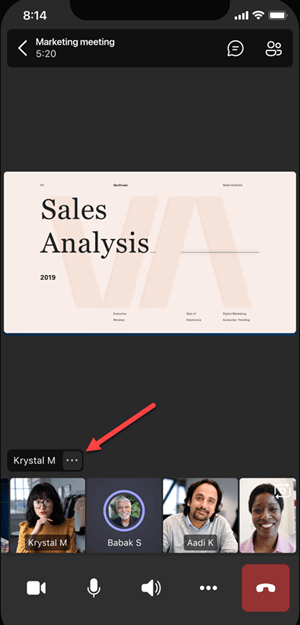
Tap Minimize content from the menu
This will give you a better look at more of the people in the meeting. You'll still see the shared content on the lower portion of your screen.
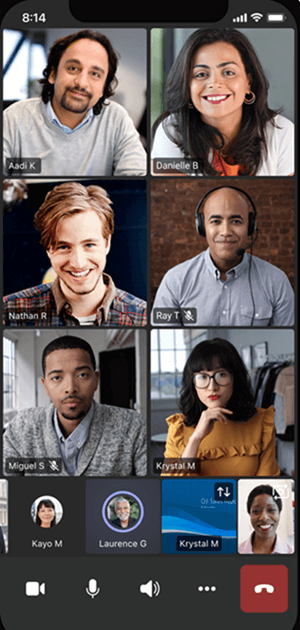
Use your phone as a companion device in a meeting
Join a meeting on more than one device for more collaboration and content-sharing options.
If you're already in a meeting on your laptop, for example, you can add your phone as a companion device to present files, share live video, and much more. Any device with the Teams mobile app can be added as a companion device—just make sure the devices you're using are signed in to the same Teams account.
There's a lot you can do when you add a companion device to your meeting experience:
Use mobile video to show things that are out of view for remote participants.
Take a photo to share with everyone or pick one from your camera roll.
Use your phone to control a presentation.
Share your mobile screen.
If you can see it on your phone, you can share it in the meeting!
Tip: For more details, see Join a Teams meeting on a second device .
Add a companion device to a meeting
Open Teams on your mobile phone when you're already in a meeting on another device.
You'll see a message near the top of your screen informing you that you're currently in a meeting on another device, and asking if you want to join it on this one, too. Tap Join .

You'll then see two options: Add this device , and Transfer to this device . Tap Add this device .
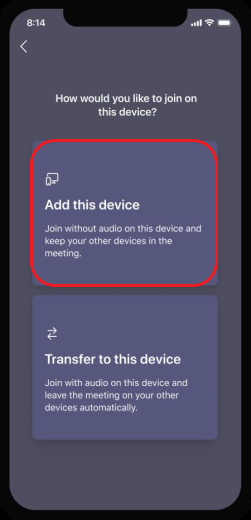
If you join this way, we'll mute your companion device's mic and speaker to avoid causing an echo effect.
When you're ready to share something from the companion device, tap Start presenting at the bottom of the screen. On your other device, you'll be able to see what you're sharing, just like everyone else in the meeting.
When you're finished, tap Stop presenting , or simply hang up. Your other device will still be connected to the meeting.

Need more help?
Want more options.
Explore subscription benefits, browse training courses, learn how to secure your device, and more.

Microsoft 365 subscription benefits

Microsoft 365 training

Microsoft security

Accessibility center
Communities help you ask and answer questions, give feedback, and hear from experts with rich knowledge.

Ask the Microsoft Community

Microsoft Tech Community

Windows Insiders
Microsoft 365 Insiders
Was this information helpful?
Thank you for your feedback.
- Get 7 Days Free
Ellington Credit Company Announces Release Date of Second Quarter 2024 Earnings, Conference Call, and Investor Presentation
Ellington Credit Company (NYSE: EARN) (the "Company") today announced that it will release financial results for the quarter ended June 30, 2024 after market close on Monday, August 12, 2024. The Company will host a conference call to discuss its financial results at 11:00 a.m. Eastern Time on Tuesday, August 13, 2024. To participate in the event by telephone, please dial (800) 579-2543 at least 10 minutes prior to the start time and reference the conference code EARNQ224. International callers should dial (785) 424-1789 and reference the same code. The conference call will also be webcast live and can be accessed via the "For Investors" section of the Company's website at www.ellingtoncredit.com . To listen to the live webcast, please visit www.ellingtoncredit.com at least 15 minutes prior to the start of the call to register, download, and install necessary audio software.
A dial-in replay of the conference call will be available on Tuesday, August 13, 2024, at approximately 2 p.m. Eastern Time through Tuesday, August 20, 2024 at approximately 11:59 p.m. Eastern Time. To access this replay, please dial (800) 753-8878. International callers should dial (402) 220-0688. A replay of the conference call will be archived on the Company's website at www.ellingtoncredit.com .
In connection with the release of financial results, the Company will post an investor presentation to accompany the conference call on its website at www.ellingtoncredit.com under "For Investors—Presentations" after market close on Monday, August 12, 2024.
About Ellington Credit Company
Ellington Credit Company, formerly known as Ellington Residential Mortgage REIT, was initially formed as a real estate investment trust ("REIT") that invested primarily in residential mortgage-backed securities ("MBS"). On March 29, 2024, the Company’s Board of Trustees approved a strategic transformation of its investment strategy to focus on corporate CLOs, with an emphasis on mezzanine debt and equity tranches. In connection with this transformation, the Company revoked its election to be taxed as a REIT effective January 1, 2024, and rebranded to Ellington Credit Company. Later in 2024, the Company intends, subject to shareholder approval of certain matters, to convert to a closed-end fund and complete its transition from an MBS-focused company to a CLO-focused company.
Ellington Credit Company is externally managed and advised by Ellington Credit Company Management LLC, formerly known as Ellington Residential Mortgage Management LLC, an affiliate of Ellington Management Group, L.L.C.
Investors: Ellington Credit Company Investor Relations (203) 409-3773 [email protected] or Media: Amanda Shpiner/Sara Widmann Gasthalter & Co. for Ellington Credit Company (212) 257-4170 [email protected]
View source version on businesswire.com: https://www.businesswire.com/news/home/20240801179963/en/
Market Updates
Markets brief: back on recession watch, what’s happening in the markets this week, 10 top-performing dividend stocks of july 2024, best- and worst-performing stocks of july 2024, july jobs report forecasts show moderating hiring gains, elections and markets are a mixed bag, 5 stocks to buy now and hold for the long term, markets brief: fed interest-rate decision looms, stock picks, berkshire hathaway earnings: strong insurance results continue to lift revenue and profitability, 3 dividend stocks for august 2024, exxon earnings: strong quarter demonstrates progress on long-term objectives, august 2024 stock market outlook: small-cap and value stocks shine, after earnings, is coca-cola stock a buy, a sell, or fairly valued, coinbase earnings: net income declines as lower volatility drives down trading volume, snap earnings: attracting users and advertisers remains a constant struggle against giants, albemarle earnings: plummeting prices pause expansion plans, sponsor center.
Microsoft Fiscal Year 2024 Fourth Quarter Earnings Conference Call
Filter events:, microsoft fy24 fourth quarter earnings conference call.
Brett Iversen, Satya Nadella, Amy Hood
Tuesday, July 30, 2024
BRETT IVERSEN: Good afternoon and thank you for joining us today. On the call with me are Satya Nadella, chairman and chief executive officer, Amy Hood, chief financial officer, Alice Jolla, chief accounting officer, and Keith Dolliver, corporate secretary and deputy general counsel.
On the Microsoft Investor Relations website, you can find our earnings press release and financial summary slide deck, which is intended to supplement our prepared remarks during today’s call and provides the reconciliation of differences between GAAP and non-GAAP financial measures. More detailed outlook slides will be available on the Microsoft Investor Relations website when we provide outlook commentary on today’s call.
On this call we will discuss certain non-GAAP items. The non-GAAP financial measures provided should not be considered as a substitute for or superior to the measures of financial performance prepared in accordance with GAAP. They are included as additional clarifying items to aid investors in further understanding the company's fourth quarter performance in addition to the impact these items and events have on the financial results.
All growth comparisons we make on the call today relate to the corresponding period of last year unless otherwise noted. We will also provide growth rates in constant currency, when available, as a framework for assessing how our underlying businesses performed, excluding the effect of foreign currency rate fluctuations. Where growth rates are the same in constant currency, we will refer to the growth rate only.
We will post our prepared remarks to our website immediately following the call until the complete transcript is available. Today's call is being webcast live and recorded. If you ask a question, it will be included in our live transmission, in the transcript, and in any future use of the recording. You can replay the call and view the transcript on the Microsoft Investor Relations website.
During this call, we will be making forward-looking statements which are predictions, projections, or other statements about future events. These statements are based on current expectations and assumptions that are subject to risks and uncertainties. Actual results could materially differ because of factors discussed in today's earnings press release, in the comments made during this conference call, and in the risk factor section of our Form 10-K, Forms 10-Q, and other reports and filings with the Securities and Exchange Commission. We do not undertake any duty to update any forward-looking statement.
And with that, I’ll turn the call over to Satya.
SATYA NADELLA:
Thank you, Brett.
We had a solid close to our fiscal year.
All-up, annual revenue was more than $245 billion, up 15% year-over-year. And Microsoft Cloud revenue surpassed $135 billion, up 23%.
Before I dive in, I want to offer some broader perspective on the AI platform shift.
Similar to the cloud, this transition involves both knowledge and capital intensive investments.
As we go through this shift, we are focused on two fundamental things: First, driving innovation across a product portfolio that spans infrastructure and applications so as to ensure we are maximizing our opportunity, while in parallel continuing to scale our cloud business and prioritizing fundamentals, starting with security.
Second, using customer demand signal and time to value to manage our cost structure dynamically and generate durable, long-term operating leverage.
With that, let me highlight examples, starting with Azure.
Our share gains accelerated this year, driven by AI.
We expanded our datacenter footprint, announcing investments across four continents. These are long term assets around the world to drive growth for the next decade and beyond.
We added new AI accelerators from AMD and NVIDIA, as well as our own first party silicon Azure Maia.
And we introduced new Cobalt 100, which provides best-in-class performance for customers like Elastic, MongoDB, Siemens, Snowflake, and Teradata.
We continued to see sustained revenue growth from migrations.
Azure Arc is helping customers in every industry, from ABB and Cathay Pacific, to LALIGA, to streamline their cloud migrations.
We now have 36,000 Arc customers, up 90% year-over-year.
We remain the hyperscale cloud of choice for SAP and Oracle workloads.
Atos, Coles, Daimler Truck AG, Domino’s, Haleon, for example, all migrated their mission-critical SAP workloads to our cloud.
And with our Azure VMware Solution, we offer the fastest and most cost-effective way for customers to migrate their VMware workloads too.
With Azure AI, we are building out the app server for the AI wave, providing access to the most diverse selection of models to meet customers’ unique cost, latency, and design considerations.
All-up, we now have over 60,000 Azure AI customers, up nearly 60% year-over-year, and average spend per customer continues to grow.
Azure OpenAI Service provides access to best-in-class frontier models, including as of this quarter GPT-4o and GPT-4o mini.
It is being used by leading companies in every industry, including H&R Block, Suzuki, Swiss Re, Telstra as well as digital natives like Freshworks, Meesho, and Zomato.
With Phi-3, we offer a family of powerful, small language models, which are being used by companies like BlackRock, Emirates, Epic, ITC, Navy Federal Credit Union, and others.
And with Models as a Service, we provide API access to third party models, including as of last week the latest from Cohere, Meta, and Mistral.
The number of paid Models as a Service customers more than doubled quarter-over-quarter, and we are seeing increased usage by leaders in every industry, from Adobe and Bridgestone, to Novo Nordisk and Palantir.
Now, on to data.
Our Microsoft Intelligent Data Platform provides customers with the broadest capabilities spanning databases, analytics, business intelligence, and governance – along with seamless integration with all of our AI services.
The number of Azure AI customers also using our data and analytics tools grew nearly 50% year-over-year.
Microsoft Fabric – our AI-powered next generation data platform – now has over 14,000 paid customers, including leaders in every industry, from Accenture and Kroger, to Rockwell Automation and Zeiss – up 20% quarter-over-quarter.
And, this quarter, we introduced new first-of-their-kind real-time intelligence capabilities in Fabric so customers can unlock insights on high-volume, time sensitive data.
Now, on to developer tools.
GitHub Copilot is by far the most widely adopted AI-powered developer tool.
Just over two years since its general availability, more than 77,000 organizations – from BBVA, FedEx, and H&M, to Infosys and Paytm – have adopted Copilot, up 180% year-over-year.
And we are going further.
With Copilot Workspace, we offer Copilot-native end-to-end developer productivity across plan, build, test, debug, and deploy cycle.
Copilot is driving GitHub growth, and all up, GitHub’s annual revenue run rate is now $2 billion.
Copilot accounted for over 40% of GitHub’s revenue growth this year, and is already a larger business than all of GitHub was when we acquired it.
We are also integrating generative AI across Power Platform, enabling anyone to use natural language to create apps, automate workflows, or build a website.
To date, over 480,000 organizations have used AI-powered capabilities in Power Platform, up 45% quarter-over-quarter.
In total, we now have 48 million monthly active users of Power Platform, up 40% year-over-year.
Now, on to future of work.
Copilot for Microsoft 365 is becoming a daily habit for knowledge workers, as it transforms work, workflow, and work artifacts.
The number of people who use Copilot daily at work nearly doubled quarter-over-quarter, as they use it to complete tasks faster, hold more effective meetings, and automate business workflows and processes.
Copilot customers increased more than 60% quarter-over-quarter.
Feedback has been positive, with majority of enterprise customers coming back to purchase more seats.
All-up, the number of customers with more than 10,000 seats more than doubled quarter-over-quarter, including Capital Group, Disney, Dow, Kyndryl, Novartis. And EY alone will deploy Copilot to 150,000 of its employees.
And we are going further, adding agent capabilities to Copilot.
New Team Copilot can facilitate meetings, and create and assign tasks.
And, with Copilot Studio, customers can extend Copilot for Microsoft 365 and build custom copilots that proactively respond to data and events using their own first and third-party business data.
To date, 50,000 organizations – from Carnival Corp., Cognizant, and Eaton, to KPMG, Majesco, and McKinsey – have used Copilot Studio, up over 70% quarter-over-quarter.
We are also extending Copilot to specific industries, including healthcare, with DAX Copilot.
More than 400 healthcare organizations – including Community Health Network, Intermountain, Northwestern Memorial Healthcare, and Ohio State University Wexner Medical Center – have purchased DAX Copilot to date, up over 40% quarter-over-quarter.
And the number of AI-generated clinical reports more than tripled.
Copilot is also transforming ERP and CRM business applications.
We again took share this quarter, as customers like ThermoFisher Scientific switched to Dynamics.
Our new Dynamics 365 Contact Center is a Copilot-first solution that infuses generative AI throughout the contact center workflow.
Companies like 1-800 Flowers, Mediterranean Shipping, Synoptek will rely on it to deliver better customer support.
And Dynamics 365 Business Central is now trusted by over 40,000 organizations for core ERP.
Microsoft Teams has become essential to how hundreds of millions of people meet, call, chat, collaborate, and do business.
We once again saw year-over-year usage growth.
Teams Premium has surpassed 3 million seats, up nearly 400% year-over-year, as organizations like dentsu, Eli Lilly, and Ford chose it for advanced features like end-to-end encryption and real-time translation.
When it comes to devices, we introduced our new category of Copilot+ PCs this quarter.
They are the fastest, most intelligent Windows PCs ever, and they include a new system architecture designed to deliver best-in-class performance and breakthrough AI experiences.
We are delighted by early reviews. And we are looking forward to the introduction of more Copilot+ PCs powered by all of our silicon and OEM partners in the coming months.
More broadly, Windows 11 active devices increased 50% year-over-year.
And we are seeing accelerated adoption of Windows 11 by companies like Carlsberg, E.ON, National Australia Bank.
Now, on to security.
We continue to prioritize security above all else.
We are doubling down on our Secure Future Initiative, as we implement our principles of secure by design, secure by default, and secure operations.
Through this initiative, we are also continuously applying what we are learning, and translating it into innovation for our customers, including how we approach AI.
Over 1,000 paid customers have used Copilot for Security, including Alaska Airlines, Oregon State University, Petrofac, Wipro, WTW.
And we are also securing customers’ AI deployments, with updates to Defender and Purview.
All-up, we now have over 1.2 million security customers. Over 800,000 – including Dell Technologies, Deutsche Telekom, TomTom use 4 or more workloads, up 25% year-over-year.
And Defender for Cloud, our cloud security solution, surpassed $1 billion in revenue over the past 12 months as we protect customer workloads across multi-cloud and hybrid environments.
Now, let me turn to our consumer businesses, starting with LinkedIn.
LinkedIn continues to see accelerated member growth and record engagement.
1.5 million pieces of content are shared every minute on the platform.
And video is now the fastest growing format on LinkedIn, with uploads up 34% year-over-year.
LinkedIn Marketing Solutions continues to be a leader in B2B digital advertising, helping companies deliver the right message, to the right audience, on a safe, trusted platform.
And when it comes to our subscription businesses, Premium sign ups increased 51% this fiscal year, and we are adding even more value to our members and customers with new AI tools.
Our reimagined AI-powered LinkedIn Premium experience is now available for every Premium subscriber worldwide, helping them more easily and intuitively connect to opportunity, learn, and get career coaching.
Finally, hiring took share for the second consecutive year.
And, now, on to Search, Advertising and News.
We are ensuring that Bing, Edge, and Copilot are collectively driving more engagement and value to end-users, publishers, and advertisers.
Our overall revenue ex-TAC increased 19% year-over-year, and we again took share across Bing and Edge.
We continue to apply generative AI to pioneer new approaches to how people search and browse.
Just last week, we announced we are testing a new generative search experience, which creates a dynamic response to a user’s query, while maintaining click share to publishers.
And we continue to drive record engagement with Copilot for the web. Consumers have used Copilot to create over 12 billion images and conduct 13 billion chats to date, up 150% since the start of the calendar year.
Thousands of news and entertainment publishers trust us to reach new audiences with Microsoft Start.
And, in fact, we have paid them $1 billion over the last five years.
We are helping advertisers increase their ROI too.
We have seen positive response to Performance Max, which uses AI to dynamically create and optimize ads.
And Copilot in Microsoft Ad Platform helps marketers create campaigns and troubleshoot using natural language.
Now, on to gaming.
We now have over 500 million monthly active users across platforms and devices.
And our content pipeline has never been stronger.
We previewed a record 30 new titles at our showcase this quarter. 18 of them – such as Call of Duty: Black Ops 6 – will be available on Game Pass.
Game Pass Ultimate subscribers can now stream games directly on the devices they already have, including as of last month, Amazon Fire TVs.
Finally, we are bringing our IP to new audiences. Fallout, for example, made its debut as a TV show on Amazon Prime this quarter. It was the second most watched title on the platform ever, and hours played on Game Pass for Fallout franchise increased nearly 5X quarter-over-quarter.
In closing, I am energized about the opportunities ahead.
We are investing for the long-term — in our fundamentals, in our innovation, and in our people.
With that, let me turn it over to Amy.
Thank you, Satya, and good afternoon everyone. This quarter, revenue was $64.7 billion, up 15% and 16% in constant currency. Earnings per share was $2.95 cents and increased 10% and 11% in constant currency.
In our largest quarter of the year, we again delivered double-digit top and bottom-line growth with continued share gains across many of our businesses and record commitments to our Microsoft Cloud platform.
Commercial bookings were significantly ahead of expectations and increased 17% and 19% in constant currency. This record commitment quarter was driven by growth in the number of 10-million-dollar-plus and 100-million-dollar-plus contracts for both Azure and Microsoft 365 and consistent execution across our core annuity sales motions.
Commercial remaining performance obligation increased 20% and 21% in constant currency to $269 billion. Roughly 40% will be recognized in revenue in the next 12 months, up 18% year-over-year. The remaining portion, recognized beyond the next 12 months, increased 21%. And this quarter, our annuity mix was 97%.
At a company level, Activision contributed a net impact of approximately 3 points to revenue growth, was a 2 point drag on operating income growth, and had a negative 6 cent impact to earnings per share. A reminder that this net impact includes adjusting for the movement of Activision content from our prior relationship as a third-party partner to first-party, and includes $938 million from purchase accounting adjustments, integration, and transaction-related costs.
FX did not have a significant impact on our results and was roughly in line with our expectations on total company revenue, segment level revenue, COGS, and operating expense growth.
Microsoft Cloud revenue was $36.8 billion and grew 21% and 22% in constant currency, roughly in line with expectations.
Microsoft Cloud gross margin percentage decreased roughly 2 points year-over-year to 69% in line with expectations. Excluding the impact of the change in accounting estimate for useful lives, gross margin percentage decreased slightly driven by sales mix shift to Azure, partially offset by improvement in Azure even with the impact of scaling our AI infrastructure.
Company gross margin dollars increased 14% and 15% in constant currency and gross margin percentage decreased slightly year-over-year to 70%. Excluding the impact of the change in accounting estimate, gross margin percentage increased slightly, even with the impact from purchase accounting adjustments, integration, and transaction-related costs from the Activision acquisition.
Operating expenses increased 13% with 9 points from the Activision acquisition.
At a total company level, headcount at the end of June was 3% higher than a year ago.
Operating income increased 15% and 16% in constant currency and operating margins were 43%, relatively unchanged year-over-year. Excluding the impact of the change in accounting estimate, operating margins increased slightly driven by the higher gross margin noted earlier and improved operating leverage through continued cost discipline.
Now to our segment results.
Revenue from Productivity and Business Processes was $20.3 billion and grew 11% and 12% in constant currency, slightly ahead of expectations driven by better-than-expected results across all business units.
Office commercial revenue grew 12% and 13% in constant currency. Office 365 commercial revenue increased 13% and 14% in constant currency with ARPU growth primarily from E5 momentum as well as Copilot for Microsoft 365. Paid Office 365 commercial seats grew 7% year-over-year with installed base expansion across all customer segments. Seat growth was again driven by our small and medium business and frontline worker offerings, although both segments continued to moderate.
Office commercial licensing declined 9% and 7% in constant currency, with continued customer shift to cloud offerings.
Office consumer revenue increased 3% and 4% in constant currency with continued momentum in Microsoft 365 subscriptions, which grew 10% to 82.5 million.
LinkedIn revenue increased 10% and 9% in constant currency driven by better-than-expected performance across all businesses.
Dynamics revenue grew 16% driven by Dynamics 365 which grew 19% and 20% in constant currency. We saw continued growth across all workloads and better-than-expected new business. Dynamics 365 now represents roughly 90% of total Dynamics revenue.
Segment gross margin dollars increased 9% and 10% in constant currency and gross margin percentage decreased roughly 1 point year-over-year. Excluding the impact of the change in accounting estimate, gross margin percentage decreased slightly driven by Office 365 as we scale our AI infrastructure. Operating expenses increased 5%, and operating income increased 12% and 13% in constant currency.
Next, the Intelligent Cloud segment. Revenue was $28.5 billion, increasing 19% and 20% in constant currency, in line with expectations.
Overall, server products and cloud services revenue grew 21% and 22% in constant currency. Azure and other cloud services revenue grew 29% and 30% in constant currency, in line with expectations and consistent with Q3 when adjusting for leap year. Azure growth included 8 points from AI services where demand remained higher than our available capacity. In June, we saw slightly lower-than-expected growth in a few European geos.
In our per-user business, the enterprise mobility and security installed base grew 10% to over 281 million seats with continued impact from moderated growth in seats sold outside the Microsoft 365 suite.
Therefore, our Azure consumption business continues to grow faster than total Azure.
In our on-premises server business, revenue increased 2% and 3% in constant currency. Growth was driven by demand for our hybrid solutions although with slightly lower-than-expected transactional purchasing.
Enterprise and partner services revenue decreased 7% on a strong prior year comparable for Enterprise Support Services.
Segment gross margin dollars increased 16% and gross margin percentage decreased roughly 2 points year-over-year. Excluding the impact of the change in accounting estimate, gross margin percentage decreased slightly driven by sales mix shift to Azure, partially offset by the improvement in Azure noted earlier, even with the impact of scaling our AI infrastructure. Operating expenses increased 5% and operating income grew 22% and 23% in constant currency.
Now to More Personal Computing. Revenue was $15.9 billion, increasing 14% and 15% in constant currency, with 12 points of net impact from the Activision acquisition. Results were above expectations driven by Windows commercial and Search.
The PC market was as expected and Windows OEM revenue increased 4% year-over-year.
Windows commercial products and cloud services revenue increased 11% and 12% in constant currency, ahead of expectations due to higher in-period revenue recognition from the mix of contracts.
Devices revenue decreased 11% and 9% in constant currency, roughly in line with expectations, as we remain focused on our higher margin premium products. While early days, we’re excited about the recent launch of our Copilot+ PCs.
Search and news advertising revenue ex-TAC increased 19%, ahead of expectations, primarily due to improved execution. Healthy volume growth was driven by Bing and Edge.
And in Gaming, revenue increased 44% with 48 points of net impact from the Activision acquisition. Xbox content and services revenue increased 61%, slightly ahead of expectations, with 58 points of net impact from the Activision acquisition. Stronger-than-expected performance in first-party content was partially offset by third-party content performance. Xbox hardware revenue decreased 42% and 41% in constant currency.
Segment gross margin dollars increased 21%, with 10 points of net impact from the Activision acquisition. Gross margin percentage increased roughly 3 points year-over-year primarily driven by sales mix shift to higher margin businesses.
Operating expenses increased 43% with 41 points from the Activision acquisition. Operating income increased 5% and 6% in constant currency.
Now back to total company results.
Capital expenditures including finance leases were $19 billion, in line with expectations, and cash paid for P, P, and E was $13.9 billion. Cloud and AI related spend represents nearly all of total capital expenditures. Within that, roughly half is for infrastructure needs where we continue to build and lease datacenters that will support monetization over the next 15 years and beyond. The remaining cloud and AI related spend is primarily for servers, both CPUs and GPUs, to serve customers based on demand signals. For the full fiscal year, the mix of our cloud and AI related spend was similar to Q4.
Cash flow from operations was $37.2 billion, up 29% driven by strong cloud billings and collections. Free cash flow was $23.3 billion, up 18% year-over-year, reflecting higher capital expenditures to support our cloud and AI offerings. For the full year, cash flow from operations surpassed $100 billion for the first time, reaching $119 billion.
This quarter, other income and expense was negative $675 million, more favorable than anticipated with lower-than-expected interest expense and higher-than-expected interest income. Our losses on investments accounted for under the equity method were as expected.
Our effective tax rate was approximately 19%, higher than anticipated due to a state tax law signed in June that was effective retroactively.
And finally, we returned $8.4 billion to shareholders through dividends and share repurchases, bringing our total cash returned to shareholders to over $34 billion for the full fiscal year.
Now, moving to our outlook.
My commentary for both the full year and next quarter is on a US dollar basis unless specifically noted otherwise.
Let me start with some full year commentary for FY25.
First, FX. Assuming current rates remain stable, we expect FX to have no meaningful impact to full year revenue, COGS, or operating expense growth.
Next, we continue to expect double-digit revenue and operating income growth as we focus on delivering differentiated value for our customers. To meet the growing demand signal for our AI and cloud products, we will scale our infrastructure investments with FY25 capital expenditures expected to be higher than FY24. As a reminder, these expenditures are dependent on demand signals and adoption of our services that will be managed thru the year. As scaling these investments drive growth in COGS, we will remain disciplined on operating expense management. Therefore, we expect FY25 opex growth to be in the single digits. And given our focused commitment to managing at the operating margin level, we still expect FY25 operating margins to be down only about one point year-over-year.
And finally, we expect our FY25 effective tax rate to be around 19%.
Now, to the outlook for our first quarter.
Based on current rates, we expect FX to decrease total revenue and segment level revenue growth by less than one point. We expect FX to decrease COGS growth by less than one point and to have no meaningful impact to operating expense growth.
In commercial bookings, increased long-term commitments to our platform and strong execution across core annuity sales motions should drive healthy growth on a growing expiry base. As a reminder, larger long-term Azure contracts, which are more unpredictable in their timing, can drive increased quarterly volatility in our bookings growth rate.
Microsoft Cloud gross margin percentage should be roughly 70%, down year-over-year driven by the impact of scaling our AI infrastructure.
We expect capital expenditures to increase on a sequential basis given our cloud and AI demand, as well as existing AI capacity constraints. As a reminder, there can be quarterly spend variability from cloud infrastructure buildouts and the timing of delivery of finance leases.
Next to segment guidance.
In Productivity and Business Processes, we expect revenue to grow between 10% and 11% in constant currency, or $20.3 to $20.6 billion.
In Office Commercial, revenue growth will again be driven by Office 365 with seat growth across customer segments and ARPU growth through E5 and Copilot for Microsoft 365. We expect Office 365 revenue growth to be approximately 14% in constant currency. In our on-premises business, we expect revenue to decline in the mid to high teens.
In Office consumer, we expect revenue growth in the low to mid-single digits, driven by Microsoft 365 subscriptions.
For LinkedIn, we expect revenue growth in the high single digits driven by continued growth across all businesses.
And in Dynamics, we expect revenue growth in the low to mid-teens driven by Dynamics 365.
For Intelligent Cloud we expect revenue to grow between 18% and 20% in constant currency, or $28.6 to $28.9 billion.
Revenue will continue to be driven by Azure which, as a reminder, can have quarterly variability primarily from our per-user business and in-period revenue recognition depending on the mix of contracts.
In Azure, we expect Q1 revenue growth to be 28% to 29% in constant currency. Growth will continue to be driven by our consumption business, inclusive of AI, which is growing faster than total Azure. We expect the consumption trends from Q4 to continue thru the first half of the year. This includes both AI demand impacted by capacity constraints and non-AI growth trends similar to June. Growth in our per-user business will continue to moderate. And in H2, we expect Azure growth to accelerate as our capital investments create an increase in available AI capacity to serve more of the growing demand.
In our on-premises server business, we expect revenue to decline in the low single digits as continued hybrid demand will be more than offset by lower transactional purchasing.
And in Enterprise and partner services, revenue should decline in the low single digits.
In More Personal Computing, we expect revenue to grow between 9% and 12% in constant currency, or $14.9 to $15.3 billion.
Windows OEM revenue growth should be relatively flat, roughly in line with the PC market.
In Windows commercial products and cloud services, customer demand for Microsoft 365 and our advanced security solutions should drive revenue growth in the mid-single digits. As a reminder, our quarterly revenue growth can have variability primarily from in-period revenue recognition depending on the mix of contracts.
In Devices, revenue growth should be in the low to mid-single digits.
Search and news advertising ex-TAC revenue growth should be in the mid to high teens. This will be higher than overall Search and news advertising revenue growth, which we expect to be in the low single digits.
And in Gaming, we expect revenue growth in the mid-30s, including approximately 40 points of net impact from the Activision acquisition. We expect Xbox content and services revenue growth in the low to mid-50s, driven by the net impact from the Activision acquisition. Hardware revenue will again decline year-over-year.
Now back to company guidance.
We expect COGS between $19.95 to $20.15 billion, including approximately $700 million from purchase accounting, integration, and transaction-related costs from the Activision acquisition.
We expect operating expense of $15.2 to $15.3 billion, including approximately $200 million from purchase accounting, integration, and transaction-related costs from the Activision acquisition.
Other income and expense should be roughly negative $650 million driven by losses on investments accounted for under the equity method as interest income will be mostly offset by interest expense. As a reminder, we are required to recognize gains or losses on our equity investments, which can increase quarterly volatility.
We expect our Q1 effective tax rate to be approximately 19%.
In closing, we remain focused on delivering innovations that matter to our global customers of every size. That focus extends to delivering on our financial commitments as well. We delivered operating margin growth of nearly three points year over year even as we accelerated our AI investments, completed the Activision acquisition, and had a headwind from the change in useful lives last year. So, as we begin FY25, we will continue to invest in the cloud and AI opportunity ahead aligned, and if needed adjusted, to the demand signals we see. We are committed to growing our leadership across our commercial cloud and within that, the AI platform, and we feel well positioned as we start FY25.
With that, let’s go to Q&A. Brett.
BRETT IVERSEN: Thanks, Amy. We’ll now move over to Q&A. Out of respect for others on the call, we request the participants. Please only ask one question. Operator, can you please repeat your instructions?
(Operator direction.)
KEITH WEISS, Morgan Stanley: Excellent. Thank you guys for taking the question, and congratulations on another great quarter and really solid overall fiscal year.
Right now, there’s an industry debate raging around the capex requirements around generative AI and whether the monetization is actually going to match with that. And I think the question for you guys from a Microsoft perspective is, is capex still an appropriate leading indicator for cloud growth, or do the shifting gross margin profiles changed that equation; or said another way, maybe can you give us a little bit more help in understanding the timing between the capex investments and the yields on those investments? Thank you.
SATYA NADELLA: Thank you, Keith. Let me start and then Amy can add to this. I think I would say we primarily start right now from the demand side. What I mean by that is what’s the product shape of the product portfolio? What we learned even from the cloud transition, which, as you know, Keith, was similar in the sense it was both a knowledge-intensive and a capital-intensive transition. We needed to have the product portfolio where there was the right mix, I’ll call it, infrastructure meters, as well as SaaS applications.
That’s the first thing that we’re looking at, and how is that value landing with customers and what’s the growth rate. When I think about what’s happening with M365 Copilot as perhaps the best Office 365 or M365 suite we have had, the fact that we are getting recurring customers or customers coming back, buying more seats, or GitHub Copilot now being bigger than even GitHub when we bought it, what’s happening in the contact center with Dynamics.
I would say, and obviously, the Azure AI growth, that’s the first place we look at. That then drives bulk of the capex spend. Basically, that’s the demand signal, because you’ve got to remember, even in the capital spend, there is land and there is data center built, but 60+% is the kit. That only will be bought for inferencing and everything else if there is demand signal, right? That’s, I think, the key way to think about capital cycle, even.
The asset, as Amy said, is a long-term asset, which is land and the data center, which, by the way, we don’t even construct things fully. We can even have things which are semi-constructed. We call co-shells and so on.
We know how to manage our capex spend to build out a long-term asset. And a lot of the hydration of the kit happens when we have the demand signal. There is definitely spend for training. Even there, of course, we will only be scaling our training as we see the demand accrue in any given period in time.
I would say it’s more important to manage to capture the opportunity with the right product portfolio that’s driving value. And on that front, I feel good about the breadth of Microsoft offering, whether it’s in consumer side, whether it’s on commercial per-seat side, or the consumption meters. That’s, I think, the fundamental driver.
AMY HOOD: And Keith, I do think – and I really do appreciate how you phrase the question as well, because I think the timing and some of the questions you all have had really led to how we were talking even about capital expense in our comments, in my comments today.
Being able to maybe share a little more about that, when we talked about roughly half of FY24’s total capital expense, as well as half of Q4’s expense, it’s really on land and builds, and finance leases. And those things really will be monetized over 15 years and beyond. And they’re incredibly flexible. Because we’ve built a consistent architecture, first with a commercial cloud, and second with the Azure stack for AI, regardless of whether demands at the platform layer or at the app layer, or through third parties and partners, or, frankly, our first-party SaaS, it uses the same infrastructure.
We’ve got long-lived, flexible assets. And if you think about it, that way, you can see what we’re doing and focused on is building out this network in parallel across the globe, because when we did this last transition, the first transition to the cloud, which seems a long time ago, sometimes – (laughter) – it rolled out quite differently. We rolled out more geo by geo. And this one, because we have demand on a global basis, we are doing it on a global basis, which is important. We have large customers in every geo.
And so, hopefully, with that shape of our capital expense, it helps people see how much of that sort of near-term monetization driver as well as much longer duration.
KEITH WEISS: That’s super helpful. Thank you very much.
BRETT IVERSEN: Thanks, Keith. Operator, next question, please.
MARK MOERDLER, Bernstein Research: Thank you very much. Thank you for taking the question, and congrats on a strong year.
Gen AI has been a bit of a roller coaster of tech over the last year with periods of acceleration, high expectations and expectations dropped as reality kicked in. With Azure growth we’ve seen this quarter and O365, Commercial not yet fully visible in numbers, even though, Amy, you gave us a lot of color on it, two parts to the question of Satya, how should we think about what it’s going to take for Gen AI to become more real across the industry, and for it to become more visible within your SaaS offerings?
And Amy, with cloud, it took time for margins to improve. It looks like with AI, it’s happening quicker. Can you give us a sense of how you think about the margin impact near term and long term from all the investment on AI? Thank you.
SATYA NADELLA: Thanks again, Mark, for the question. To me, look, at the end of the day Gen AI is just software, so it is really translating into fundamentally growth on what has been our M365 SaaS offering with a new offering that is the Copilot SaaS offering, which today is on a growth rate that’s faster than any other previous generation of software we launched as a suite in M365. That’s, I think, the best way to describe it. I mean, the numbers I think we shared even this quarter are indicative of this, Mark.
If you look at it, we have both the landing of the seats itself, quarter over quarter, that is growing 60%, right? That’s a pretty good, healthy sign. The most healthy sign for me is the fact that customers are coming back there. That is, the same customers with whom we land in the seats coming back and buying more seats, and then the number of customers with 10,000+ seats doubled. It’s 2x, quarter over quarter. That, to me, is a healthy SaaS core business.
And on top of that, some of the things that Amy shared are on Dynamics, that’s another exciting place for us, which is one, we’re gaining share. We’re Dynamics with Gen AI built in is sort of really BizApps is probably the category that gets completely transformed with Gen AI, contact centers being a great example. We, ourselves, are on course to save hundreds of millions of dollars in our own Customer Support and Contact Center Operations. I think we can drive that value to our customers.
And then on the Azure side, you see the numbers very clearly. In fact, I think last quarter is when we started giving you that. You saw an acceleration of that this quarter.
One of the other pieces, Mark, is AI doesn’t sit on its own. It’s just, we have a concept of design wins in Azure. In fact, 50% of the folks who are using Azure AI are also using a data meter. That’s very exciting to us because the most important thing in Azure is to win workloads in the enterprise, and that is starting to happen. And these are generational things, once they get going with you.
That’s, I think, how we think about it, at least when I look at what’s happening on our demand side.
AMY HOOD: And, Mark, to answer the second half of your question on margin improvement looking different than it did through the last cloud cycle, that’s primarily for a reason I’ve mentioned a couple times. We have a consistent platform, so because we’re building to one Azure AI stack, we don’t have to have multiple infrastructure investments. We’re making one. We’re using that internally, first party. And that’s what we’re using with customers to build on as well as ISVs. It does, in fact, make margins start off better and obviously, scale consistently.
MARK MOERDLER: Thank you.
BRETT IVERSEN: Thanks, Mark. Operator, next question, please.
KASH RANGAN, Goldman Sachs: Hi. Thank you very much, and congrats on a great year, fiscal year ending.
A question for you, Amy. When you look at the capex, how do you bring efficiencies out of the capex? You disclose at 50% was infrastructure, the other 50%, tech, is very useful. In other words, do you have to keep going, growing capex at these elevated rates, or could you slow down capex and still get that consistent revenue growth rate in your Azure and generative AI? That’s the main question on my mind. Thank you so much.
AMY HOOD: Thanks, Kash. That’s a very good question. There’s really two pieces, I think, as I heard your question that I would reflect on.
The first is, could we see sort of consistent revenue growth without maybe what you would say is more of this sort of elevated capital expense number, or something that continues to accelerate. And the answer to that is yes, because there’s two different pieces. You’re seeing half of this go toward long-term builds that Satya mentioned. The pace at which we fill those builds with CPUs, or GPUs, will be demand driven.
And so, if we see differences in demand signal, we can throttle that investment on the CPU side, which we’ve done for, I guess, a long time at this point, as I reflect. And we’ll use all that same learning and demand signal understanding to do the same thing on the GPU side. And so, you’re right that you could see relatively consistent revenue patterns, and yet see these inconsistencies and capital spend, quarter to quarter.
The other thing I would note, Kash, is you’ll also notice there’s a growing distinction between our capex number and, on occasion, the cash that we pay for PP&E. And you’re going to start to see that more often in this period, because it happens when we use leases. Leases sort of show up all at once. And so, you’ll see a little bit more volatility. I’ve mentioned that in my comments before, but I mention it again, just because you’re starting to see that distinction in my comments. And hopefully, that’s helpful context.
SATYA NADELLA: Just one other thing, Amy, I wanted to add. I think as people think about capital spend, I think it’s important to separate out releases from build. And when it comes to build, I think it’s important for us to think about – we think about it in terms of what’s the total percentage of cost that goes into each line item, land, which obviously has a very different duration and a very different lead time.
Those are the other two considerations. We think about lead time and duration of the asset, land, network construction, the system or the kit, and then the ongoing cost. And so, if you think about it that way, then you know how to even adjust, if you will, the capital spend based on demand signal.
KASH RANGAN: Thank you. It was triggered by the jump in capex, and as Amy pointed out, your guiding to accelerating Azure revenue growth rate, which I guess follows the capex. Thank you so much once again.
BRETT IVERSEN: Thanks, Kash. Operator, next question, please.
BRENT THILL, Jefferies: Thanks. Amy, the magnitude of beat this quarter was a little lower than we’ve seen in the past. Was there anything unusual on sales side on the disclosed rate that you saw? Thanks.
AMY HOOD: Thanks, Brent. Actually, no. As I was talking on the quarter, I mean, commercial bookings were much better than we expected going into the quarter. Commitments were very good. Execution across both the core annuity renewal motion was good as expected. The larger long-term commitments were better than we expected.
Brent, I would not say there was anything really unusual in how I thought about it what we saw in our commercial execution through the quarter.
BRENT THILL: Great, thank you.
BRETT IVERSEN: Thanks, Brent. Operator, next question, please.
KARL KEIRSTEAD, UBS: Okay, great. Maybe I’ll direct this to Amy.
Amy, I know when you set your Azure guidance, you’re always looking to meet or beat the high end. The 30% you put up in the June quarter, amazing number given the scale of Azure, but it did come in at the low end of your range. And I’d just love for you to maybe elaborate on the delta.
I guess as I reflect on what you’ve said in your comments, there’s two things that I heard you say. One, it sounded like there’s persistent capacity constraints that you think might get alleviated in the second half. And then secondly, you mentioned perhaps the modest softness in Europe. I presume that’s a little bit more economic rather than Azure specific. Is that the right way to frame the performance in the quarter? Thank you.
AMY HOOD: Thanks, Karl. Yes, that’s exactly right. Maybe I’ll just repeat it just so people can hear it in my words, as well, to that 30% to 31% guide for Q4 and coming in at the lower end at 30%. You’re exactly right, the distinguishing between being at the higher end or at the lower end really was some softness we saw in a few European geos on non-AI consumption, really made the difference in that number. And we’ve assumed that going forward into H1, inclusive of my guide in 28 to 29, going forward.
And then let me separate, which was your larger point, which is what are the other factors you see ongoing. Number one, you’re right, capacity constraints, particularly on AI and Azure, remained in Q4 and will remain in H1. Hopefully, that’s helpful.
KARL KEIRSTEAD: Yeah. Thank you, Amy.
BRETT IVERSEN: Thanks, Karl. Operator, next question, please.
BRAD ZELNICK, Deutsche Bank: Great, thank you very much.
Amy, with Azure demand once again greater than available capacity, I appreciate the capex investments in the build out and acceleration you expect in the back half. But as we think about cloud capacity and AI services, specifically, can you talk about both the near-term and long-term strategy around the AI partnerships that you’re signing with the likes of Oracle and CoreWeave, for example? Thank you.
AMY HOOD: Thanks, Brad. Maybe separate a couple of things.
We are, and we’ve talked about it now for quite a few quarters, we are constrained on AI capacity. And because of that, actually, we, to your point, have signed up with third parties to help us as we are behind with some leases on AI capacity. We’ve done that with partners who are happy to help us extend the Azure platform to be able to serve this Azure AI demand. And you do see us investing quite a bit, as we’ve talked about, in builds so that we can get back in a more balanced place.
SATYA NADELLA: Yeah. I mean, to me, it’s no different than leases that we would have done in the past. You could even say sometimes buying from Oracle, maybe even more efficient leases because they’re even shorter date.
BRAD ZELNICK: Excellent. Thanks for the color.
BRETT IVERSEN: Thanks, Brad. Operator, next question, please.
MARK MURPHY, JP Morgan: Thank you very much. With a couple quarters of Copilot for M365 availability under your belt now, how are you assessing the capability of copilots to replicate the productivity gains that they’ve created for developers, which seem to be very high, and to do something similar for the broader population of knowledge workers? For instance, you’re mentioning the 10,000 seat deals, the repeat purchases. Is it possible to eventually see Copilot penetration rates equally high in Office as they will be in GitHub?
SATYA NADELLA: Yeah, that’s a great question. In fact, the GitHub design system and the GitHub Copilot Workspace design system, which now, for example, you start with an issue, you create a plan, from a plan, you create a spec, or you create a spec and from a spec, you create a plan, and then you go operate across the full repo, that’s effectively the design system that is getting replicated inside of even the M365 Copilot. And you see this even now.
For example, you get an e-mail. You’re in sales. You want to respond to the customer. The data from the e-mail is essentially context for a prompt, but you expand by bringing in all of your CRM data, right? This customer e-mail is in the context of some order. All of the CRM record gets completed in context, and a reply gets generated with the CRM data. That’s the type of stuff that’s already happening.
Then you take something like Copilot Studio, you can start even grounding it in more data and then completing workflows. You could say, if this e-mail comes from this customer whose order date has got a particular issue with it, you can then go and escalate it to somebody else, who gets a notification in Teams. And those are the kinds of workflows that are getting built within IT or by end users themselves. What used to be line of business applications to us are Copilot extensions going forward.
We think of this as really, a new design system for knowledge and frontline work to drive productivity, which will be very akin to what has happened in software engineering. When you think about marketing or finance, or sales, or customer service, we will effectively replicate what you just said, which is the type of product you will be seeing and developers will come to all of these functions as they think about their work, workflow and work artifact all being driven by Copilot.
MARK MURPHY: Thank you very much.
BRETT IVERSEN: Thanks, Mark. Operator, we have time for one last question.
KEITH BACHMAN, BMO: Hi. Good evening, and thank you for the opportunity to ask the question. I actually wanted to veer towards gaming, if I could for a second.
Xbox content services revenue grew 61%, 58 points help from Activision. Net is about three points of growth. How should investors think about the longer-term growth potential? In this area, you’ve made significant investments including the Activision deal. But how should investors be thinking about the growth potential of the gaming, or what are the puts and takes to help make considerations here? Thank you.
SATYA NADELLA: Yeah. For us, our investment in gaming, fundamentally, was to have, I’d say, the right portfolio of both what we love about gaming and always have loved about gaming, which is Xbox and the content for the console, and expand from there so that we have content for everywhere people play games, starting with the PC.
When I think about the Activision portfolio, it comes with great assets for us to cover both the PC and the console, and then, of course, assets to cover mobile sockets, which we never had. We feel that now, we have both the content and the ability to access all the traditional high scale platforms where people play games, which is the console, PC and mobile. But we’re also excited about the new sockets, right?
I mean, the fact that even in this last quarter, we expanded xCloud to Amazon TV, I forget the name of what it’s called, but that’s the type of new axis that really helps us a lot, reach new gamers or the same gamer everywhere they want to play. And that ultimately will show up in that software plus services and transaction revenue for us, which is really our long-term KPI. And that’s what we’re building towards, and that was this strategy behind Activision as an asset.
Amy, if you wanted to add to it?
AMY HOOD: No, I do think the real goal here is to be able to take a broad set of content to more users in more places, and really build what looks more like, to us, a software annuity and subscription business with enhanced transactions and the ownership of IP, which is quite valuable long term. And Satya mentioned things where with the ownership of IP, it can be monetized in multiple ways. And I think we’re really encouraged by some of the progress and how we’re making progress with Game Pass, as well, with some of the new announcements.
Thank you, Keith.
BRETT IVERSEN: Thanks, Keith. That wraps up the Q&A portion of today’s earnings call. Thank you for joining us today, and we look forward to speaking with all of you soon.
AMY HOOD: Thank you.
SATYA NADELLA: Thank you, all.
Upcoming Events
Past events.

- July 30, 2024 2:30 PM - PT
- Satya Nadella, Chairman and CEO and Amy Hood, EVP & CFO
- Webcast Event Website PowerPoint Transcript

- June 6, 2024 10:00 AM - PT
Bank of America Global Technology Conference
- Ryan Roslansky, CEO, LinkedIn
- Webcast Transcript
Microsoft Corp (MSFT)
| Volume | |
|---|---|
| Market Cap | |
| 52 Week High | |
| 52 Week Low |
2023 ANNUAL REPORT

Olympic ceremony's 'Last Supper' sketch never meant to disrespect, says Paris 2024
- Medium Text
CATHOLIC HERITAGE
Sign up here.
Reporting by Karolos Grohmann and Julien Pretot; Additional reporting by Thomas Escritt in Berlin and Elizabeth Pineau and Michel Rose in Paris; Writing by Richard Lough; Editing by Ken Ferris, Pritha Sarkar and Alison Williams
Our Standards: The Thomson Reuters Trust Principles. , opens new tab

Paris Olympics: What you need to know right now
The middle Sunday of the Paris Olympics sees the final day of the swimming, a hotly anticipated men's 100 metres final in the athletics, and Novak Djokovic vying for a gold to fill the one gap in his trophy cabinet.

OTCQB Venture Virtual Investor Conference Presentations Now Available for On-Demand Viewing
NEW YORK, Aug. 02, 2024 (GLOBE NEWSWIRE) -- Virtual Investor Conferences, the leading proprietary investor conference series announced the presentations from the August 1 st OTCQB Venture Virtual Investor Conference are now available for on-demand viewing.
REGISTER OR LOGIN TO VIEW THE PRESENTATIONS AT: https://bit.ly/4fvVmF8
The company presentations will be available 24/7 for 90 days. Investors, advisors, and analysts may download investor materials from the company’s resource section.
Select companies are accepting 1x1 management meeting requests through August 6 th .
August 1 st Presentations:
| Global Uranium & Enrichment Ltd. | |
| Lindian Resources Ltd. | |
| Evofem Biosciences, Inc. | |
| Applied Energetics, Inc. | |
| Hypercharge Networks Corp. | |
| CULT Food Science Corp. | |
| NorthStar Gaming Holdings Inc. | |
| Sigyn Therapeutics Inc. | |
| Onar, Inc. | |
| First Tellurium Corp. | |
| LNG Energy Group Corp. |
To facilitate investor relations scheduling and to view a complete calendar of Virtual Investor Conferences, please visit www.virtualinvestorconferences.com .
About Virtual Investor Conferences ®
Virtual Investor Conferences (VIC) is the leading proprietary investor conference series that provides an interactive forum for publicly traded companies to seamlessly present directly to investors.
Providing a real-time investor engagement solution, VIC is specifically designed to offer companies more efficient investor access. Replicating the components of an on-site investor conference, VIC offers companies enhanced capabilities to connect with investors, schedule targeted one-on-one meetings and enhance their presentations with dynamic video content. Accelerating the next level of investor engagement, Virtual Investor Conferences delivers leading investor communications to a global network of retail and institutional investors.

COMMENTS
Conference presentations are bounded by a 15-30 minute time limit, which the event's moderators establish. These restrictions are applied to allow a crowded agenda to be met on time, and it is common to count with over 10 speakers on the same day. ... The said fact has to be pivotal to the content your conference presentation will discuss ...
A conference presentation is a means of conveying information, research findings, or ideas to an audience in a structured and engaging manner. ... can provide a solid foundation for organizing your content. Ensure your presentation flows seamlessly, incorporating bullet points strategically to highlight key information. Moreover, delivering an ...
Follow the six essential tips explored above and you'll have created an effective conference presentation with a strong visual design. Remember: your choice of colors, images, text, and content have a real impact — your delivery may be precise and polished, but you could lose your audience if your presentation is visually lacking.
How great leaders inspire action. Loading... Get a daily email featuring the latest talk, plus a quick mix of trending content. TED Members make our mission possible by supporting global access to inspiring ideas. Plus, they get to attend exclusive events. Help support a better future - and a brighter you.
Here are a few tips that will make the process smoother for you: 1. Write your paper with the audience in mind: A conference paper should be different from a journal article. Remember that your paper is meant to be heard, not read. Audiences typically have lower attention spans than readers; therefore, keep the content simple and straightforward.
A conference presentation should include a clear objective, engaging content, relevant visuals, a logical structure, concise key points, and opportunities for audience interaction and discussion. This article aims to provide you with the necessary tools and strategies to prepare a successful conference presentation.
Effective storytelling in keynote and conference presentations transcends mere recitation of facts; it involves crafting a narrative that engages, persuades, and moves the audience. This segment explores the techniques that transform simple presentations into riveting stories, focusing on the art of narrative delivery.
A Guide to Conference Presentations. Giving a presentation at an academic conference can be both stressful and rewarding. While it's incredibly helpful to get feedback and insights on your project from other researchers in your field, it can also be intimidating to hold your work up for scrutiny from others. Today we're going to share some tips ...
Conference Presentation Tips CONTENT, CTD. Within your talk, indicate areas you are particularly excited to talk more about in the Q&A. ("I don't have as much time as I'd like to discuss X, but I'm happy to go into more detail, especially as it relates to Y.")
The text is shamelessly colored by my very own opinions and preferences regarding how to give a good conference presentation. In-person and Zoom Conferences -Basics of the Setting. While the content of your presentation comes first, the setting of your speech has a huge influence on you and your audience.
Stories help them to place themselves in the context of the problem and to imagine it being solved by a proven solution. 5. Respect their time. Be respectful of the restrictions of conference time ...
15 Best Tips for Presenting at a Conference - Fourwaves. Publish a modern and mobile friendly event website. Collect registrations & online payments for your event. Presenting at a conference is an important part of a researcher's life: it allows you to share all the work you've been doing for months or years.
Common types of conference presentations Full paper - The length of a full paper is variable, usually between 20 and 40 min, and rarely exceeds one hour. A full paper may be followed by question time. Short paper - This type of conference presentation can be as short as 10 min, and very often it is one in a series of short papers in a 1- or 2-hour session on a particular conference sub-topic ...
10. Consider encouraging your audience to interact with you. An interactive presentation is a successful one, and when you don't interact with your audience, they're likely to switch off or be disengaged with your conference content.. The best way to ensure that your conference and presentation are as interactive as possible is to allot specific time for audience interaction.
A conference presentation should last from 10 to 20 minutes, depending on the conference. Check conference guidelines for an idea of what length conference organizers expect the presentation to be. Remember that you should allow time for questions. One should spend around 1-2 minutes per slide. For a 20 minute presentation, the Q & A session ...
Slides basics for a good start. Gslide Explore layout offers multiple layouts for an image and text combination. Let's cover a few basics first: Slides ratio: 16:9 works on most projectors those days and is ideal for online presentation. 4:3 is still an option since most projectors can switch between one or the other.
Types of conference papers and sessions. Panel presentations are the most common form of presentation you will encounter in your graduate career. You will be one of three to four participants in a panel or session (the terminology varies depending on the organizers) and be given fifteen to twenty minutes to present your paper.
How to make a conference presentation? Creating a successful conference presentation involves careful planning, organization, and effective communication. Here are steps to guide you through the process: 1. Understand Your Audience 2. Define Your Objectives 3. Understand the conference type 4. Create a Clear Structure 5. Craft Engaging Content 6.
Use clear and legible fonts, and maintain a consistent design throughout the presentation. 2. Visual appeal: Incorporate visually appealing elements such as relevant images, charts, graphs, or diagrams. Use high-quality visuals that enhance understanding and make the content more engaging.
Take advantage of the category interest to distribute content and build relationships. Pre-conference content options include: 1. Build community with social media. This helps to amplify conference attention during the show since the hashtag has been used over time and remained visible. TwitterChats.
Paper from published conference proceedings available online. Dahal, G. (2016). Education policy and its contribution to socioeconomic development of Nepal with reference to some selected Asian countries.
The description is flexible (e.g., "[Conference session]," "[Paper presentation]," "[Poster session]," "[Keynote address]"). Provide the name of the conference or meeting and its location in the source element of the reference. If video of the conference presentation is available, include a link at the end of the reference.
Prevent choppiness or lag when you're sharing high-motion content by optimizing video. To optimize video, select Optimize in your presenter toolbar. Change your layout. When you're sharing content, you can choose from several different layouts to help make your presentation more engaging. To change your layout while you're sharing your screen:
Ellington Credit Company Announces Release Date of Second Quarter 2024 Earnings, Conference Call, and Investor Presentation. Ellington Credit Company (NYSE: EARN) (the "Company") today announced ...
U.S. DOE "Industrial Decarbonization Roadmap" (cont.) Definition of Industrial Decarbonization: o Industrial decarbonization refers to the phasing out of GHG
Skip to main content. Microsoft. Investor Relations. Investor Relations. Investor Relations Home ; Company Information. Company Overview & Strategy; Segment Information ... Microsoft Fiscal Year 2024 Fourth Quarter Earnings Conference Call. Tuesday, July 30, 2024 Satya Nadella, Chairman and CEO and Amy Hood, EVP & CFO. video. Transcript
Intel Corporation's second-quarter 2024 earnings news release and presentation are available on the company's Investor Relations website. The earnings conference call for investors begins at 2 p.m. PDT today; a public webcast will be available at www.intc.com. More: CEO Pat Gelsinger Memo to Intel Employees: Actions to Accelerate our Progress
Paris 2024 organisers apologised on Sunday to Catholics and other Christian groups angered by a kitsch tableau in the Olympic Games opening ceremony that appeared to parody Leonardo da Vinci's ...
NEW YORK, Aug. 02, 2024 (GLOBE NEWSWIRE) -- Virtual Investor Conferences, the leading proprietary investor conference series announced the presentations from the August 1 st OTCQB Venture Virtual Investor Conference are now available for on-demand viewing.. REGISTER OR LOGIN TO VIEW THE PRESENTATIONS AT: https://bit.ly/4fvVmF8 The company presentations will be available 24/7 for 90 days.
Canaccord Genuity's 44th Annual Growth Conference & Private Company Showcase. The in-person Pega presentation is scheduled for Tuesday, August 13th, 2024 at 4:00 p.m. EDT ( 1:00 p.m. PDT ).